Early Views of the San Fernando Valley
| Historical Photos of the San Fernando Valley |
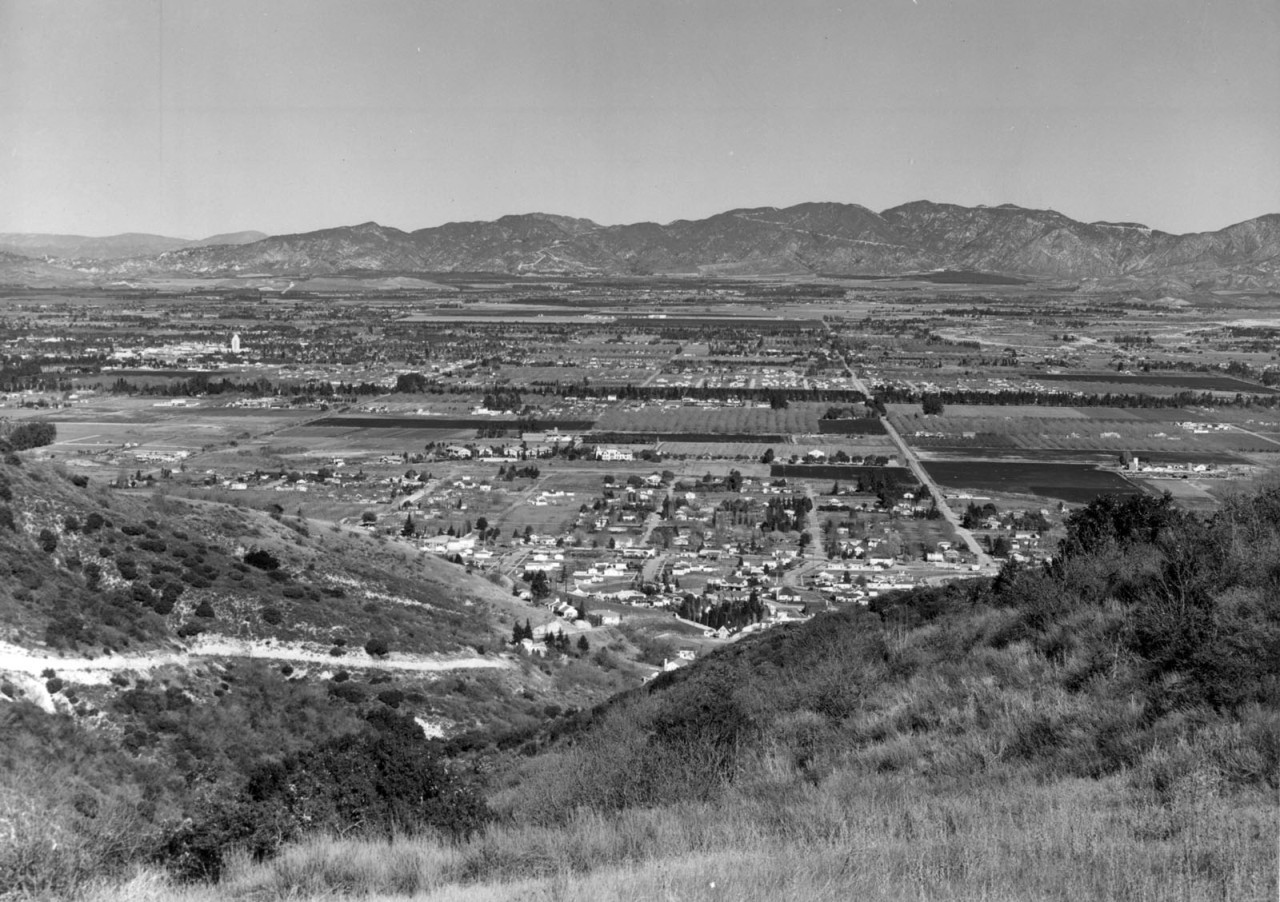 |
|
| (1939)* - Hillside view looking north showing Van Nuys and North Hollywood. Note how much land is still undeveloped. Van Nuys City Hall can be seen in the upper left of photo. Photo: USC Image Archive. |
Historical Notes In 1939, the San Fernando Valley was in a transitional phase, with areas like Van Nuys and North Hollywood leading the way in urban development. Van Nuys boasted the Valley's tallest building, its City Hall, and was developing a grid-like urban structure. |
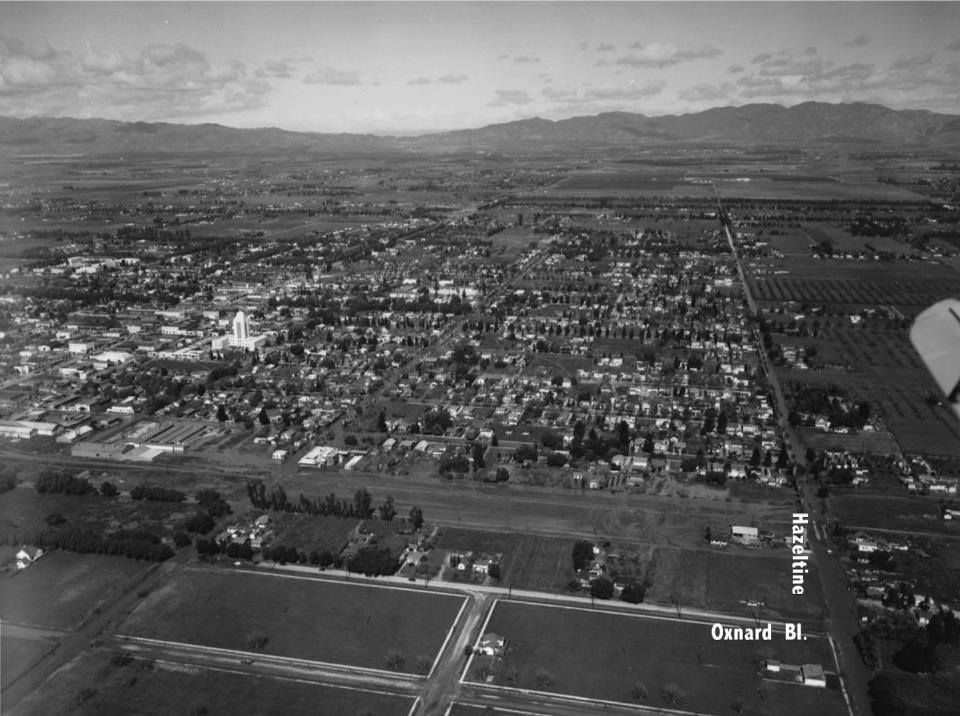 |
|
| (ca. 1940)* - Aerial view of Van Nuys looking north. The intersection of Hazeltine and Oxnard Boulevard is seen at lower right. Van Nuys City Hall, center-left, is the tallest building in the Valley. |
Historical Notes The area was becoming increasingly residential to accommodate its growing population. While much of the Valley remained agricultural, the seeds of suburban expansion were being sown, with infrastructure expanding and major boulevards being established or widened. The impending World War II would soon accelerate this development, as returning veterans would settle in the Valley in large numbers in the following years. Despite the growing urbanization, the Valley still maintained a distinct character from Los Angeles proper, with vast areas of open land and farmland coexisting with the emerging urban centers. |
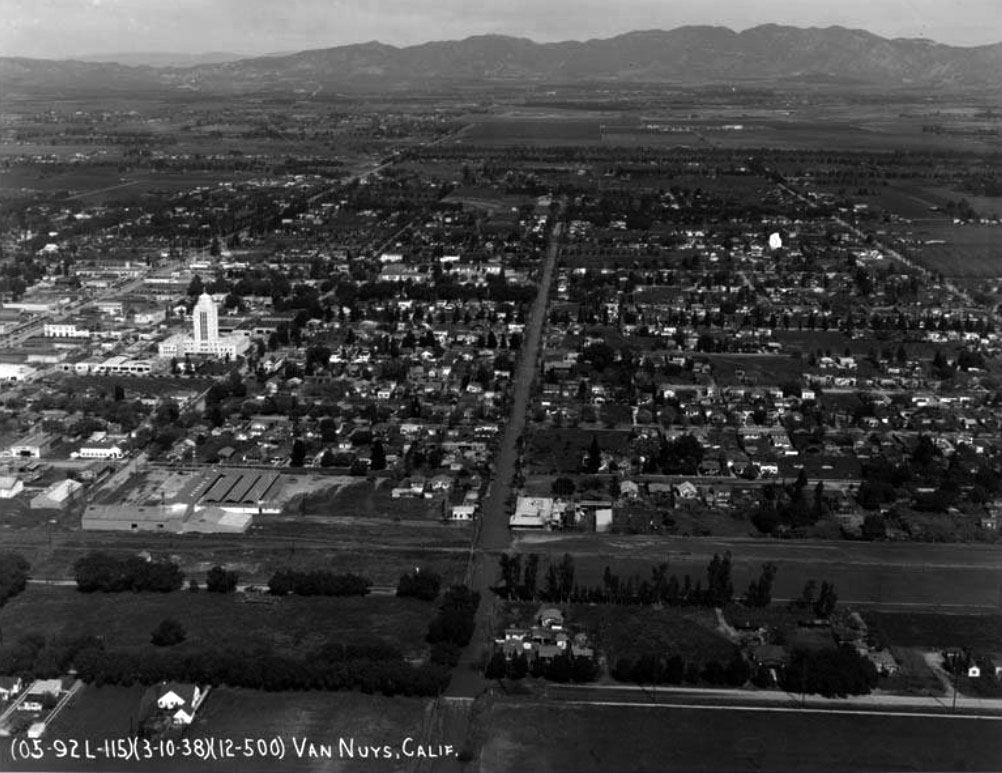 |
|
| (1938)* – Aerial view looking north on Tyrone Avenue. Van Nuys City Hall on Sylvan Street stands out at center-left of photo. |
Van Nuys City Hall
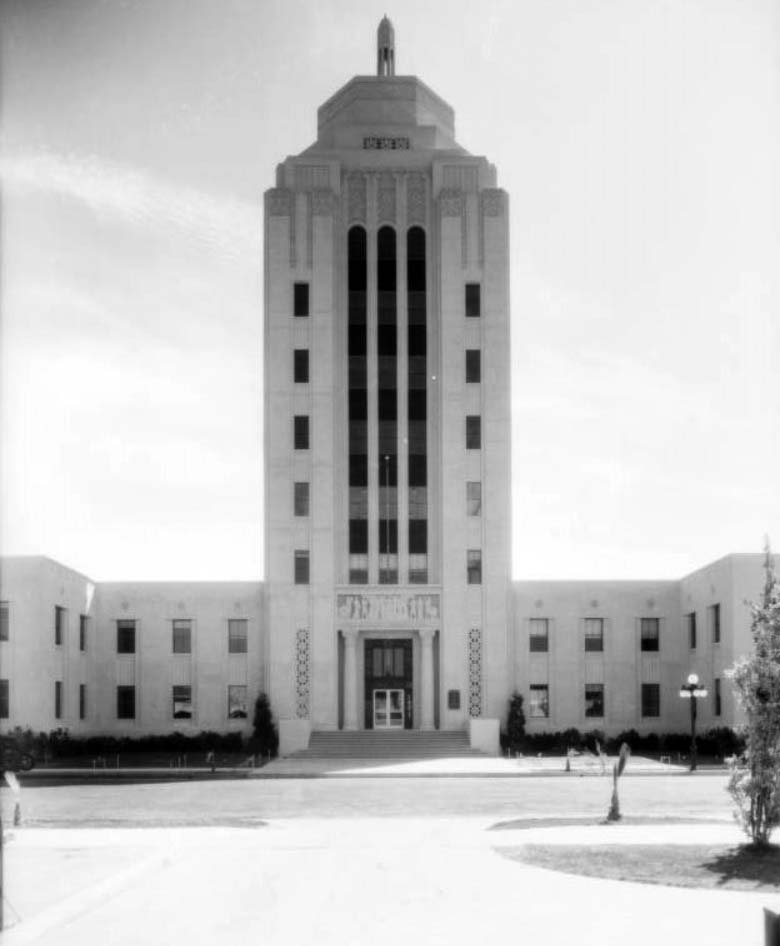 |
|
| (1933)* - Front view of Van Nuys City Hall, also known as the Valley Municipal Building, as seen from across Sylvan Street. |
Historical Notes Built in 1932 as the Valley Municipal Building and designed as a miniature of Los Angeles City Hall by architect Peter K. Schaborum, Van Nuys City Hall gained recognition as a Historic-Cultural Monument in 1978. |
.jpg) |
|
| (1933)* - View looking up toward the top of the Van Nuys City Hall. Note the bas relief details of the panel above the front entryway that appears to be supported by two Greek-style columns. |
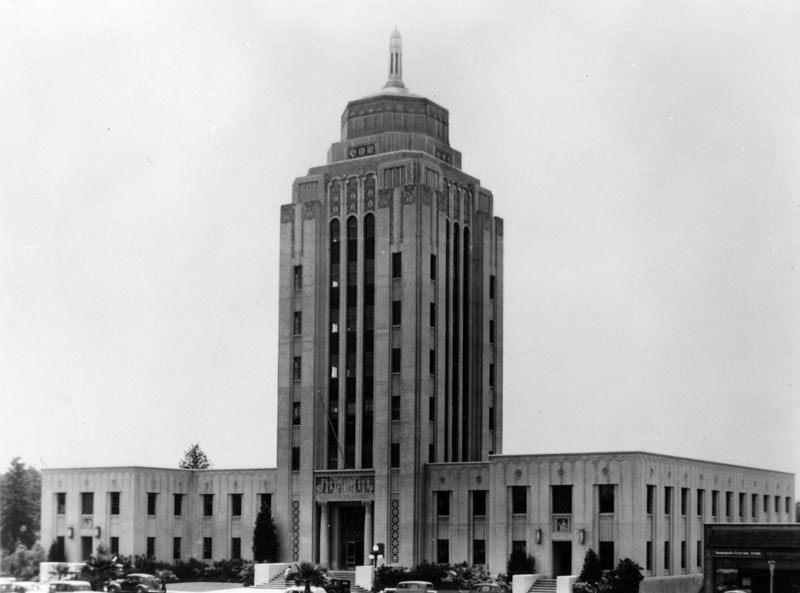 |
|
| (1939)* - Van Nuys City Hall (aka Valley Municipal Building), located at 14410 Sylvan Street, Van Nuys. |
Historical Notes Originally, the Valley Municipal Bulding housed a Hospital in one wing of the base and the Police Department and Municipal Court, complete with jail, in the other. With the population growth in the fifties and sixties, the hospital and police station were eventually relocated to roomier sites, and the building was remodeled to house other City offices. |
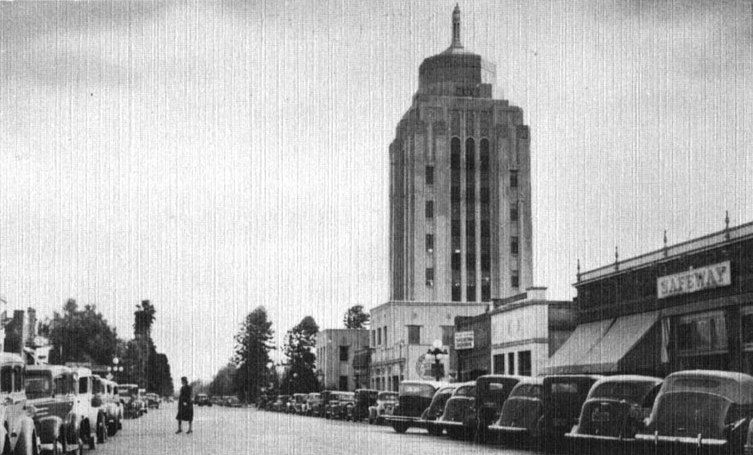 |
|
| (ca. 1940s)* - Postcard view of the Valley Municipal Building looking east on Sylvan Street. A Safeway Market can be seen in the lower right. |
 |
|
| (1947)* - Workers repairing the roof aerials on the Van Nuys City Hall, also known as the Valley Municipal Building, located at 14410 Sylvan Street, Van Nuys. |
Historical Notes On October 18, 1978, the Valley Municipal Building (Van Nuys City Hall) was declared Los Angeles Historic-Cultural Monument No. 202 (Click HERE to see complete listing). |
Victory and Whitsett
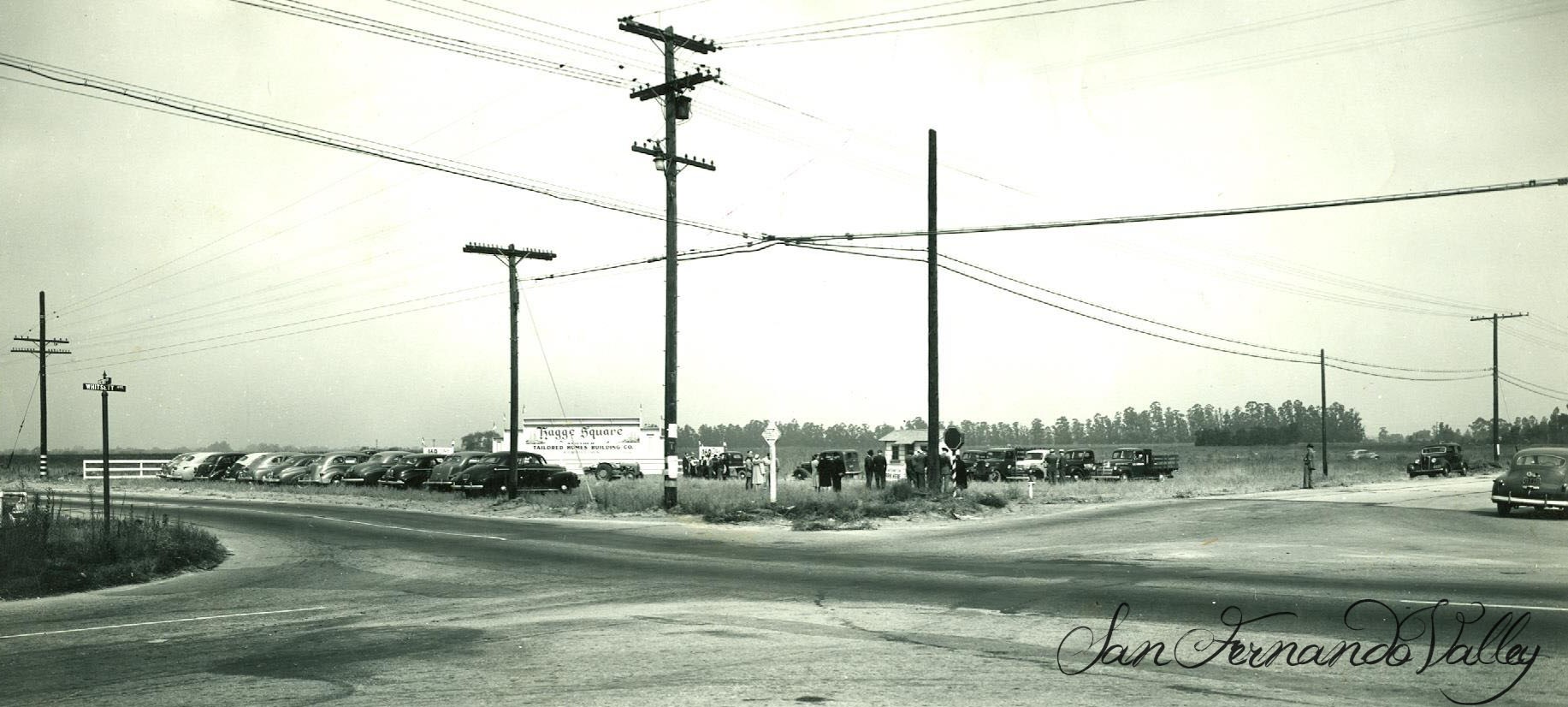 |
|
| (ca. 1944)* – View looking at the NW corner of Victory Boulevard and Whitsett Avenue. |
Historical Notes Chitsett Avenue was named after William P. Whitsett who is remembered by some as the "Father of Van Nuys." He was also a major land developer and water official in Los Angeles. The street was first known as Encino Avenue. Victory Boulevard was named in honor of the Valley's World War I veterans in 1924. The segment west of Balboa Boulevard did not open until 1955. Click HERE to see more SFV Street Name Origins. |
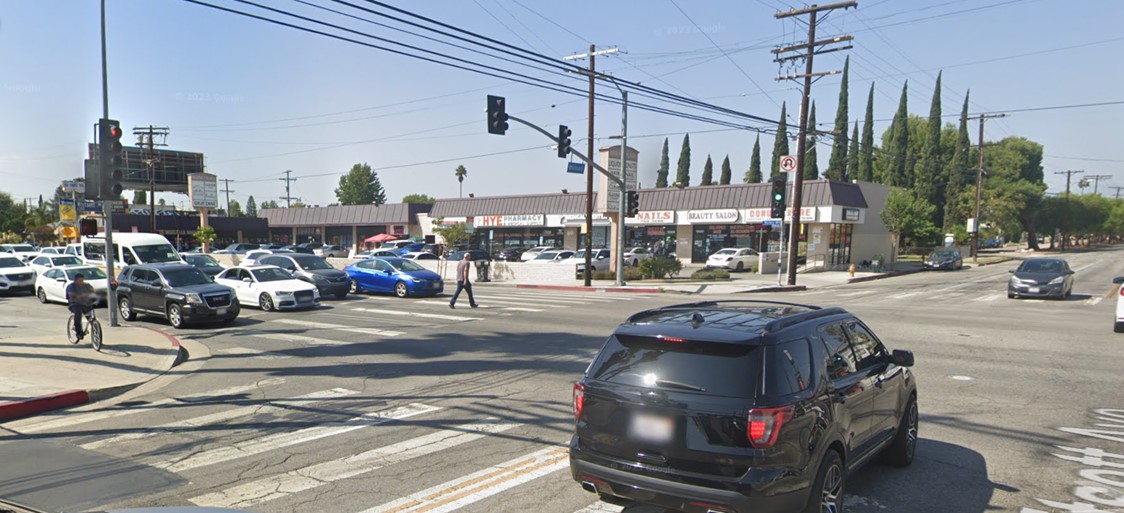 |
|
| (2022)* - Looking at the NW corner of Victory Boulevard and Whitsett Avenue. |
Then and Now
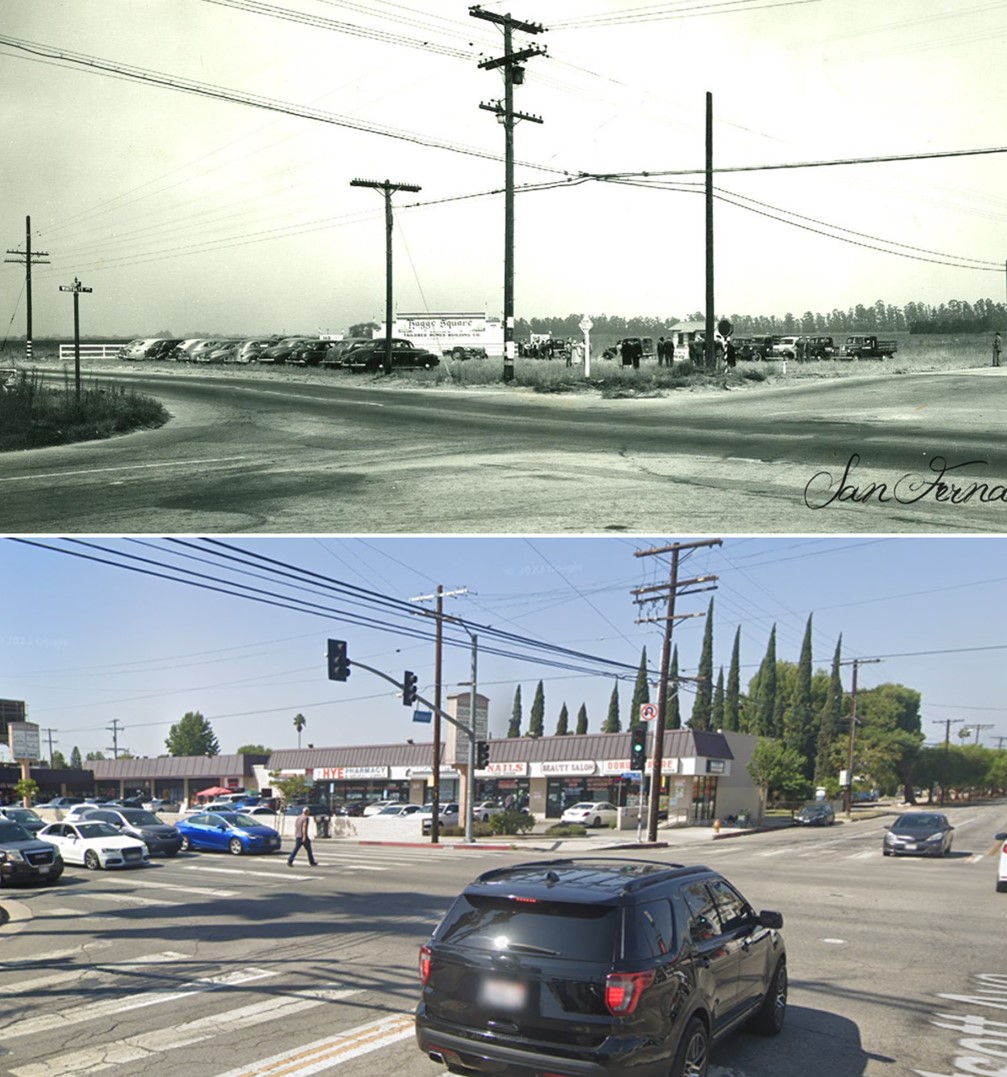 |
|
| (1944 vs 2022)* - Looking at the NW corner of Victory Boulevard and Whitsett Avenue. |
* * * * * |
 |
|
| (ca. 1940s)* - A Pacific Electric Railway car on its San Fernando Valley route circa the 1940s. |
Sepulveda and San Fernando Mission
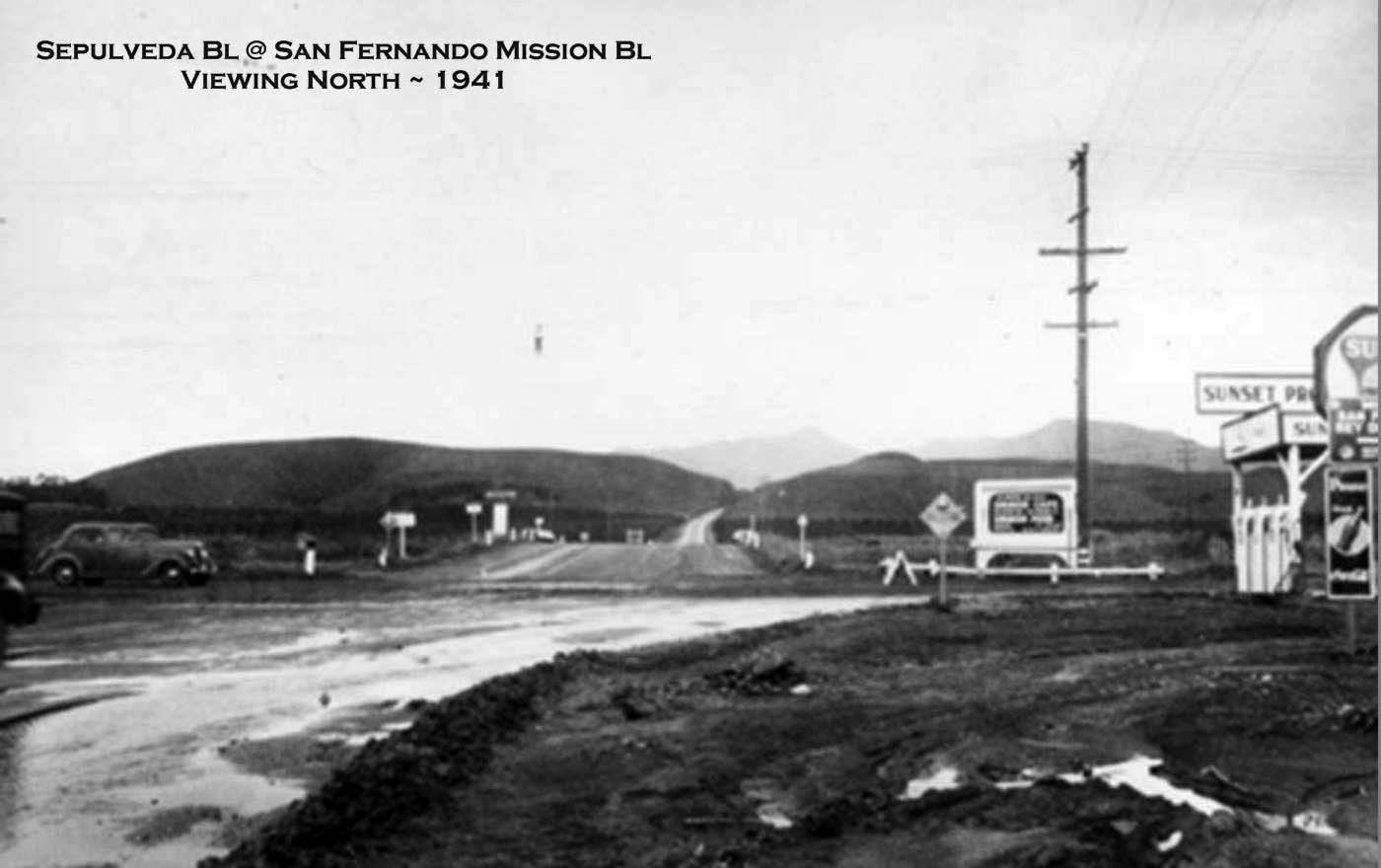 |
|
| (1941)#^*^ – View looking north on Sepulveda Boulevard at San Fernando Mission Boulevard (today Mission Hills). On the N/E corner there is a sign for the Spanish Café. It was located at 500 Mission Boulevard, San Fernando. On the S/E corner stands a gas station. Click HERE for contemporary view. |
Then and Now
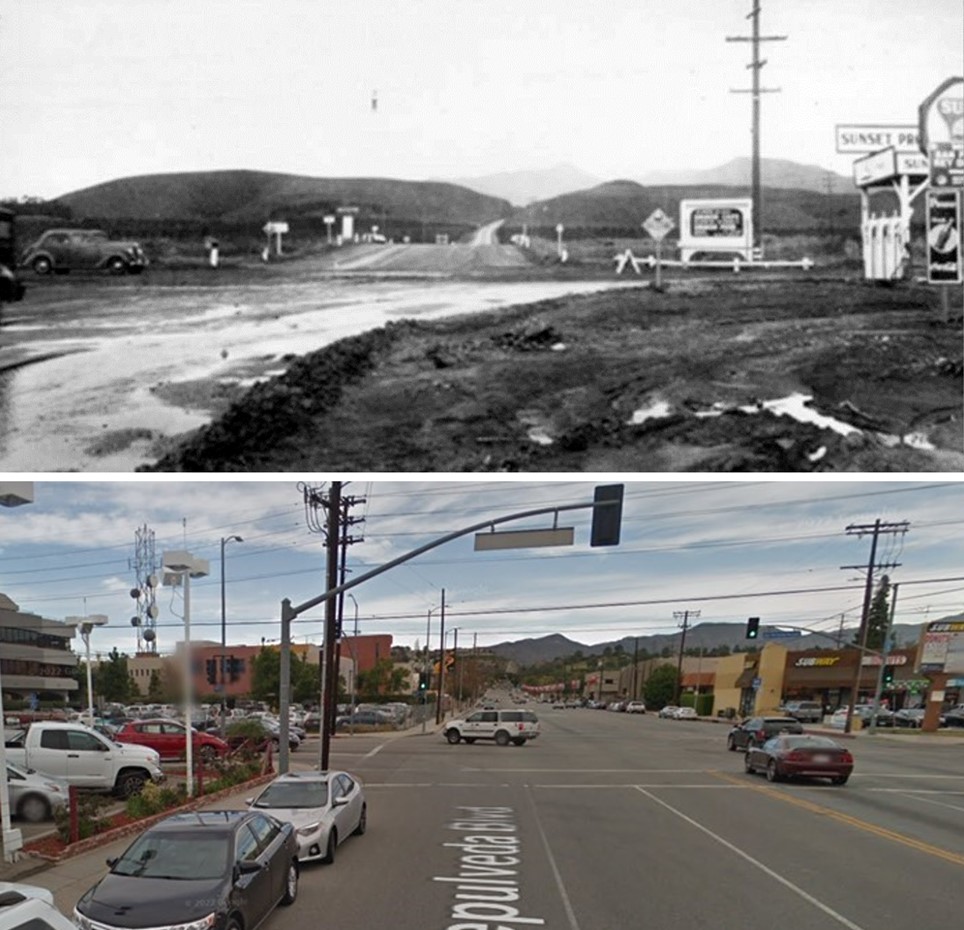 |
|
| (1941 vs 2015)* – Looking north on Sepulveda Blvd at San Fernando Mission Blvd. |
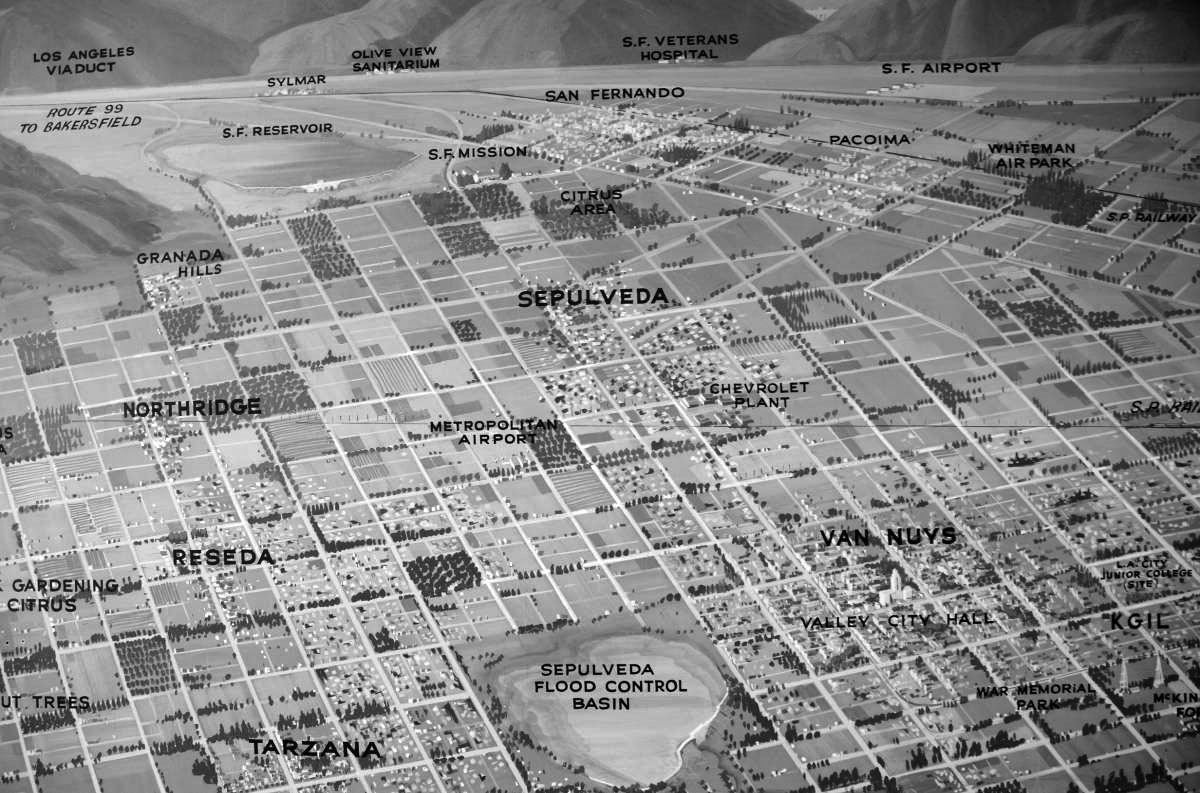 |
|
| (1940s)^^*** – Photo of a mural currently at the North Hollywood-Universal City Chamber of Commerce, 6369 Bellingham Ave. Photo by Shel Weisbach |
Historical Notes In 1944, Bing Crosby’s recording of “San Fernando Valley” reaches No. 1 on the charts, no doubt prompting plenty of GIs to move here after the war. |
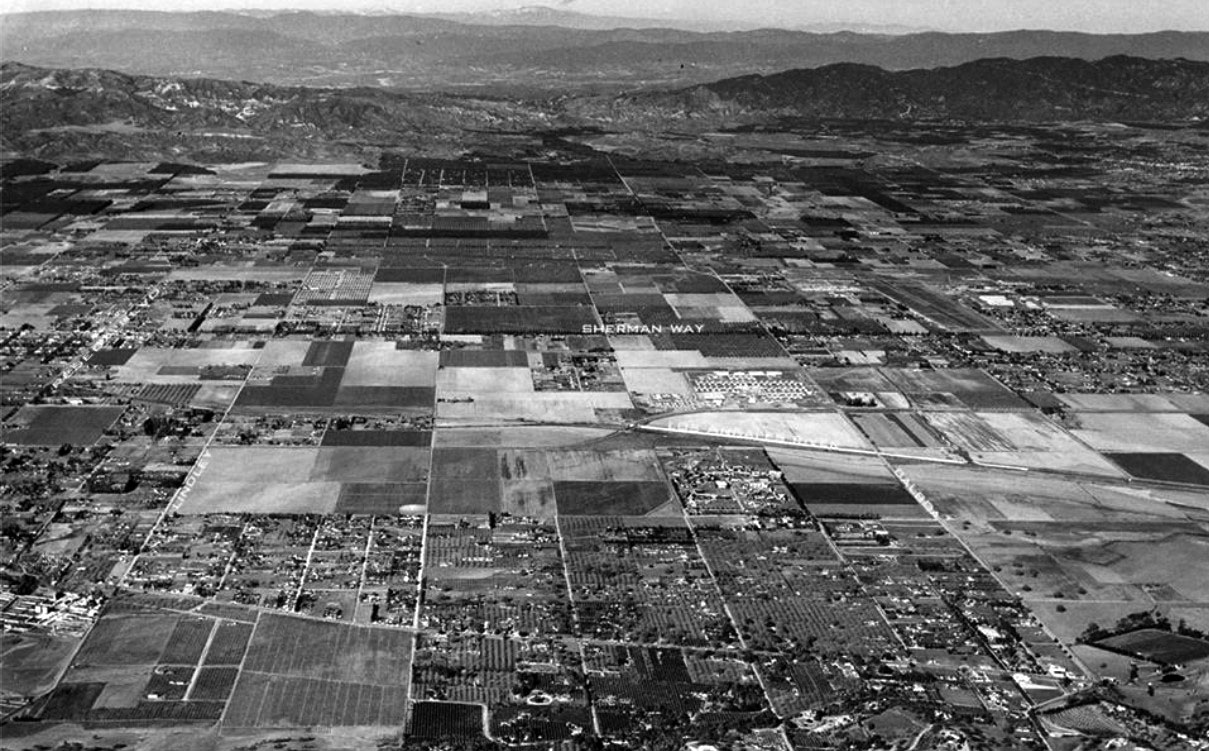 |
|
| (1946)^.^ - Aerial view, looking north, of the central part of the San Fernando Valley, including Reseda and Van Nuys. The photo has been annotated to show the major streets. Sherman Way runs horizontally across the center of the photo. |
Historical Notes When soldiers returned to California from World War II, many of them settled in the San Fernando Valley, at that time mostly farmland, where lots were affordable and pre-fab homes available. Some people literally built their own houses. |
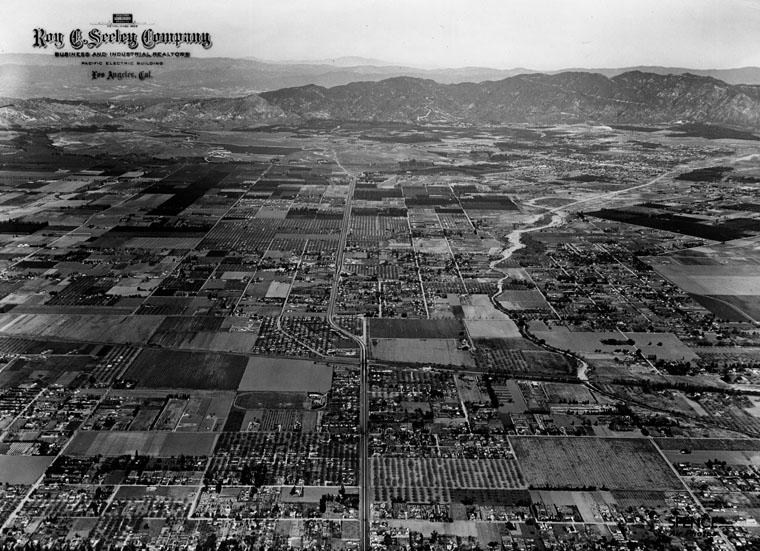 |
|
| (1946)* - Aerial view of the San Fernando Valley north on Sepulveda Boulevard from Sherman Way. Photo by Spence Air Photos. |
Birmingham Army Hospital (Site of today's Birmingham High School)
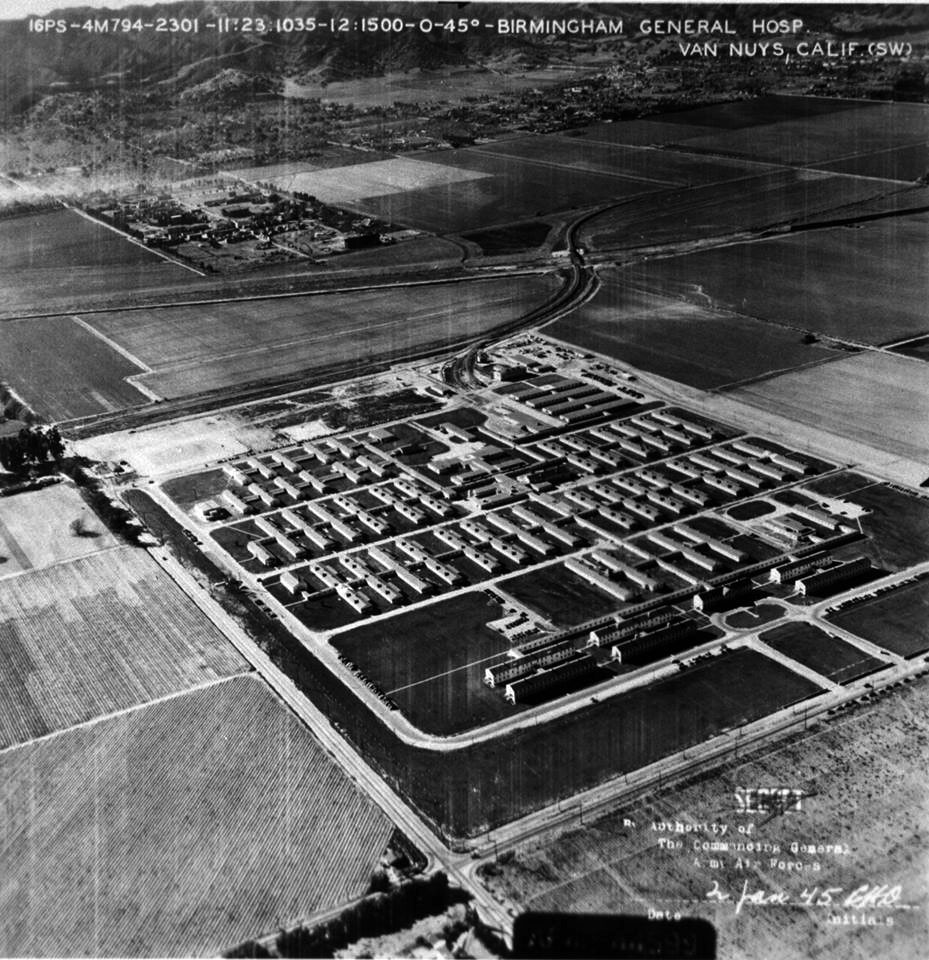 |
|
| (1945)#^*^ - Aerial view looking southwest showing the Birmingham Army Hospital. The intersection of Balboa Boulevard and Vanowen Street is in the foreground. Balboa runs diagonally from center-bottom to center-left.anowen is in the foreground. |
Historical Notes Birmingham General Hospital (later Birmingham Army Hospital) was built in Van Nuys in late 1943 and early 1944 to serve as both a general hospital and a debarkation hospital. Originally named Van Nuys General Hospital, it was soon renamed in honor of Named for Brigadier General Henry Patrick Birmingham, Medical Corps, U.S. Army. Its stucco buildings had 1777 beds, of which 800 were devoted to debarkation activities.^ |
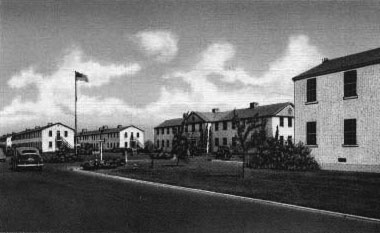 |
|
| (ca. 1945)^ – Postcard view showing the Administration Building and Nurses Quarters at the Birmingham Veterans Administration Hospital. |
Historical Notes The hospital had a small prisoner of war compound. Due to its location so close to Hollywood, many radio and movie stars visited patients at the hospital. Jack Benny even broadcasted his annual Christmas Part from the hospital in 1944. |
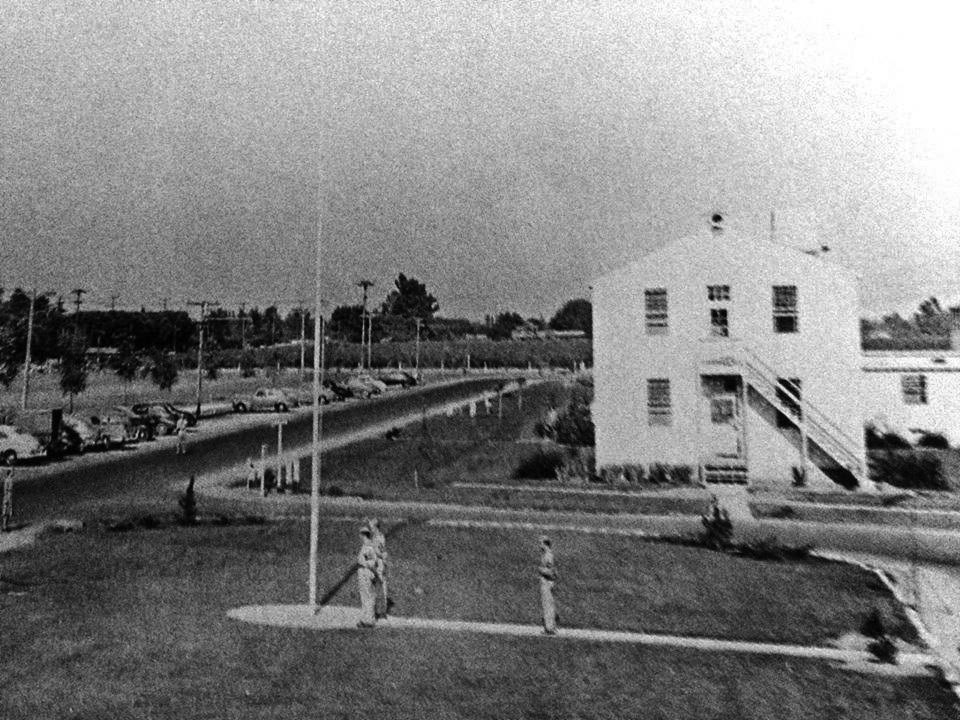 |
|
| (1945)#^*^ – View showing a Birmingham Army Hospital wartime medal ceremony. |
Historical Notes In 1946 Birmingham became a VA hospital, which closed in June, 1950, just as the Korean War was about to begin. The combination Birmingham Jr High/High School opened in 1955. |
Then and Now
 |
|
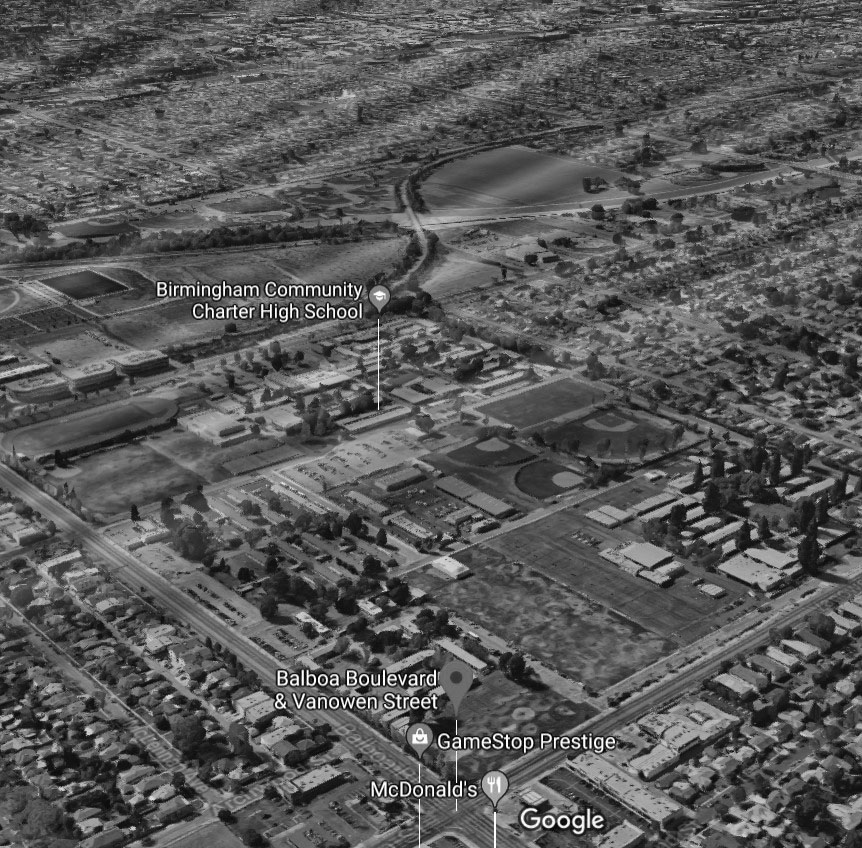 |
|
| (1945) vs. (2017)#*^# - Today, three schools sit on the former Birmingham Army Hospital site: Mulholland Middle School, Daniel Pearl Magnet High School, and Birmingham Community Charter High School. |
Historical Notes The VA closed the hospital in 1950. After 1950 the facility was converted into local use for public schools, while the army retained a piece for use in the air defense of Los Angeles. Part of the former Birmingham Army Hospital facility was used as an air defense missile battalion headquarters from 1956 to 1968.^ |
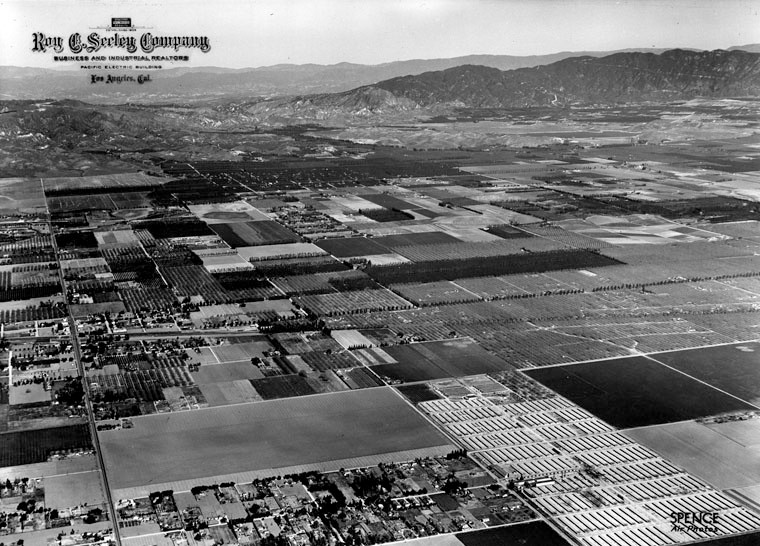 |
|
| (1946)* - Aerial view of the San Fernando Valley, north of Northridge. Photo by Spence Air Photos. |
Historical Notes Spence Air Photos was a one-man company ~ photographer, "Robert Earl Spence". He began shooting aerials in 1918. In the 1920s he had numerous clients hiring him to shoot homes and businesses. Spence would shoot images at an angle, not straight down, showing many additional building details. Spence was not a pilot, he hired an airplane pilot to fly him overhead while he leaned out from the cockpit with a bulky camera to get angled shots of the landscape. His method captured the details of the homes and their surroundings all the way to the horizon. He continued to photograph homes for 50 years. In 1971, Spence retired and donated his collection of 110,000 negatives to the University of California Geography Department. He passed away in 1974.****^ At UCLA, the Spence Collection is part of The Benjamin and Gladys Thomas Air Photo Archives. |
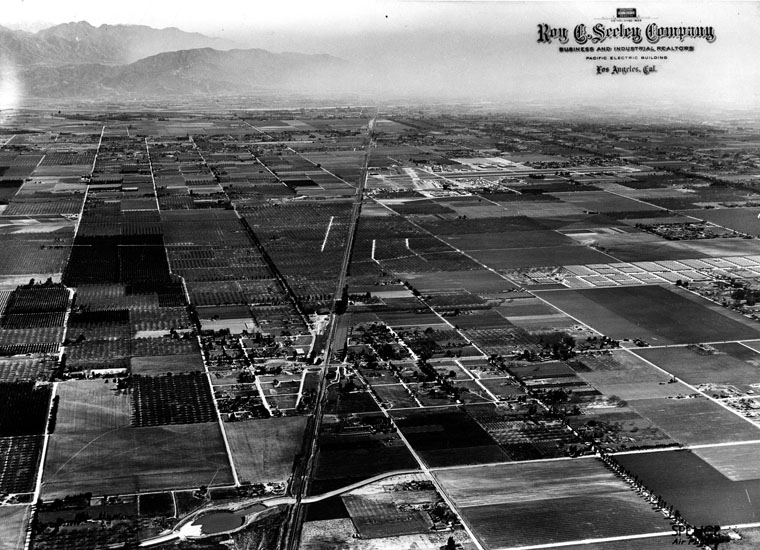 |
|
| (1946)* - Aerial view of the San Fernando Valley, east of Northridge on the S. P. coastline. Farmland predominates the horizon. |
Northridge (Originally Zelzah)
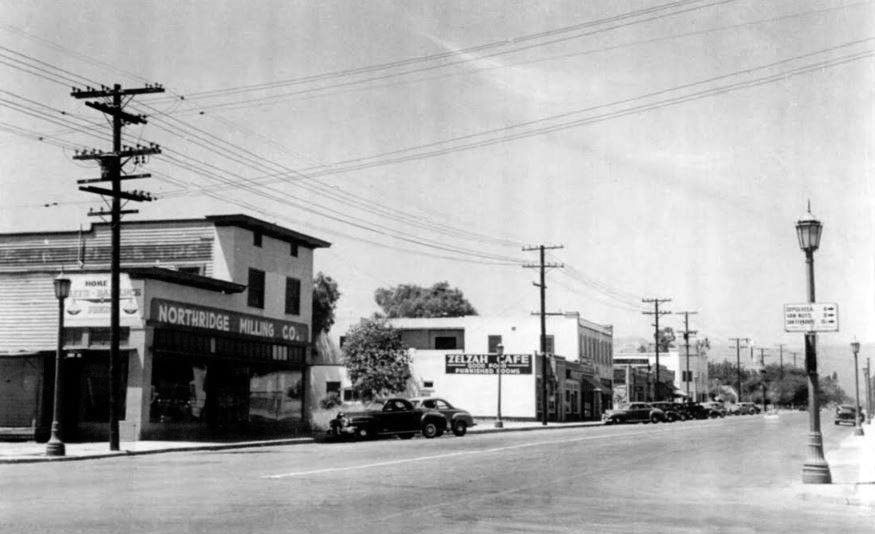 |
|
| (ca. 1940)^ – View looking north on Reseda Boulevard showing the Northridge Milling Co located at 8729 Reseda Blvd, NW Corner at Eddy St. Also seen is the Zelzah Café, which was the local hangout for many years. |
Historical Notes In the 1930’s, Northridge Milling Co was known as North Los Angeles Feed Store and located 1 block further north. It changed names alongside the name change of the town to Northridge. In early 1952, the business changed hands and was then called Brown’s. Originally called Zelzah, the town that we call Northridge today was renamed North Los Angeles on July 1, 1929. In 1938, this area of the San Fernando Valley was renamed Northridge Village. Few evidences of the "village" remain. |
.jpg) |
|
| (1940s)^ - View looking south on Reseda Boulevard from Rayen Street at Christmas time. Click HERE to see contemporary view. |
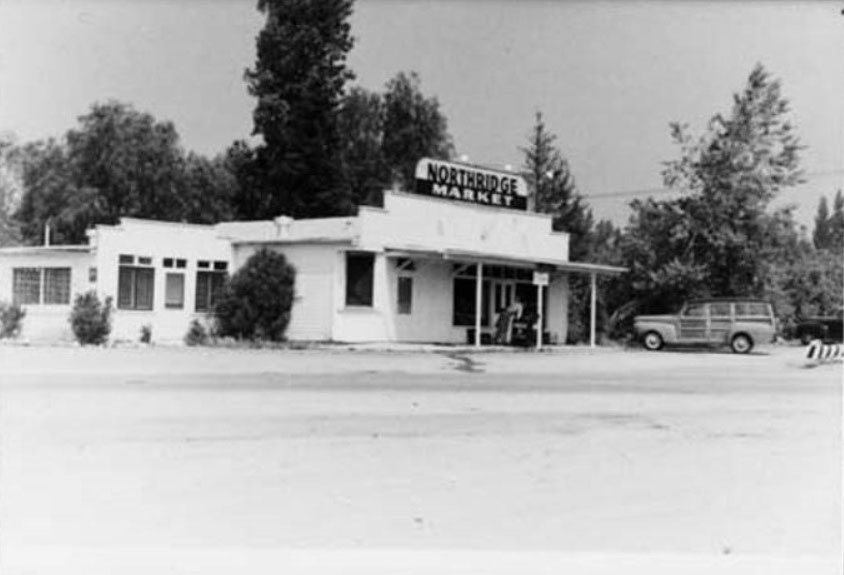 |
|
| (ca. 1940s)^ – View of Northridge Market, also known as the "Downs" market, located at Zelzah Avenue and Devonshire Street. The building was constructed in 1933. Note the "woodie" station wagon parked in front of the building. |
Historical Notes Mr. A.G. Rowlands built a market on the corner of Devonshire and Zelzah early in 1933. This grocery store has changed hands several times, but has been in continuous operation since its opening. #^#^ |
Nordhoff and Lindley
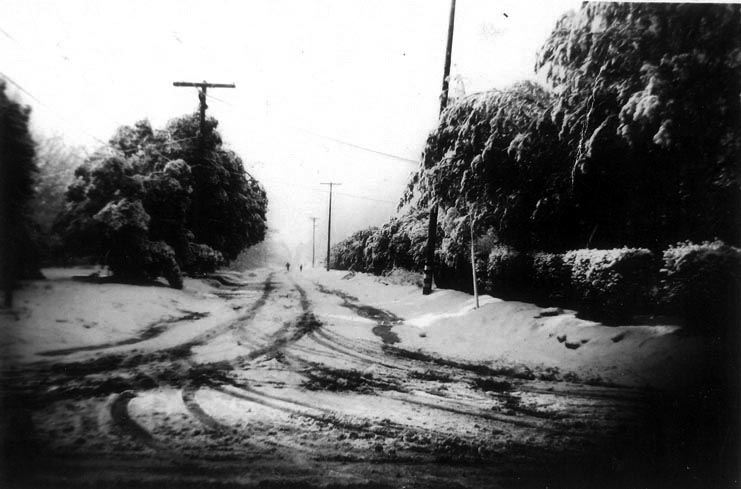 |
|
| (1949)^ - Snow blankets the San Fernando Valley in 1948. Looking south on Lindley Avenue from Nordhoff Street. |
Then and Now
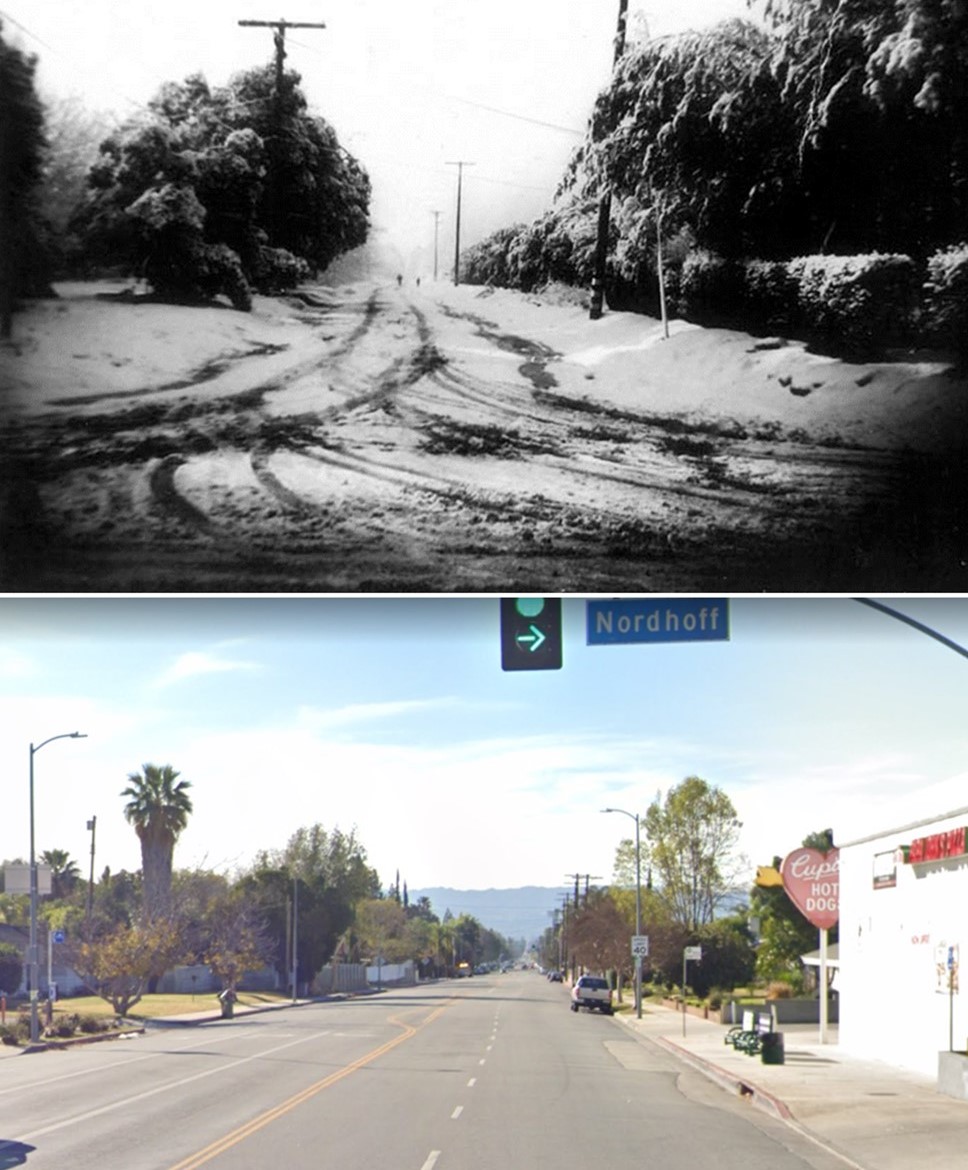 |
|
| (1949 vs. 2021)*- Looking south on Lindley Avenue at Nordhoff Street. |
Devonshire Downs
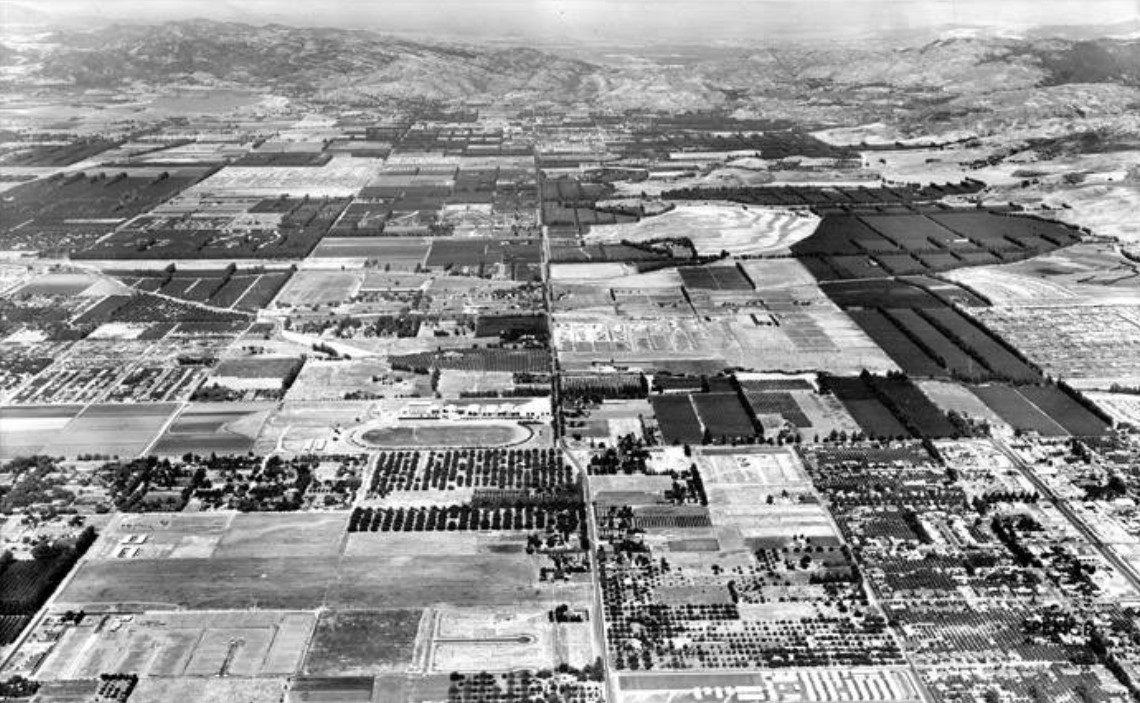 |
|
| (1950s)^ – View looking west down Devonshire Boulevard from above Balboa Boulevard. The racetrack is Devonshire Downs. |
Historical Notes Chatsworth is a more developed street than Devonshire at this time because it was the main street of Granada Hills. Lassen is the street on the extreme left. It was a dirt road between Zelzah and Lindley. Lindley didn't go through to Devonshire until the the Police station was built in 70s or 80s. The historic cedar trees on White Oak between San Jose and Chatsworth are visible. |
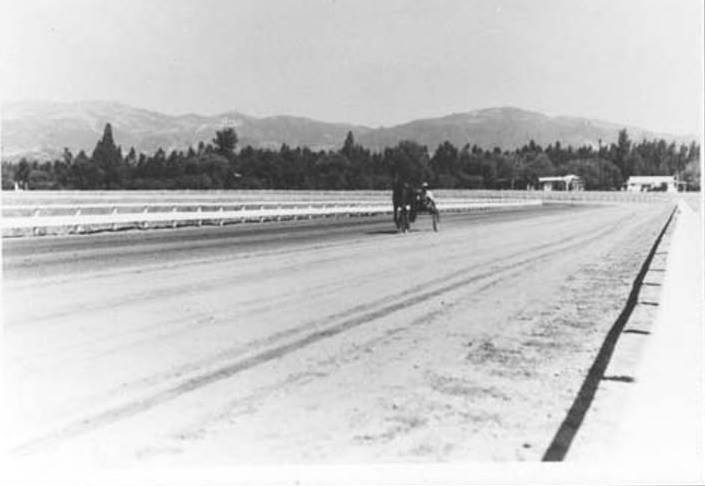 |
|
| (ca. 1946)* - View looking north showing Devonshire Downs in Northridge. The race track was located at the corner of Zelzah & Devonshire Street (now the north campus of CSUN). |
Historical Notes In 1943, Helen Dillman and Pete Spears purchased 40 acres for $80,000 with plans to construct a harness racing track, but a wartime construction moratorium temporarily put the project on hold. Weekly Sunday afternoon harness races, called matinees, began in 1946.*^ |
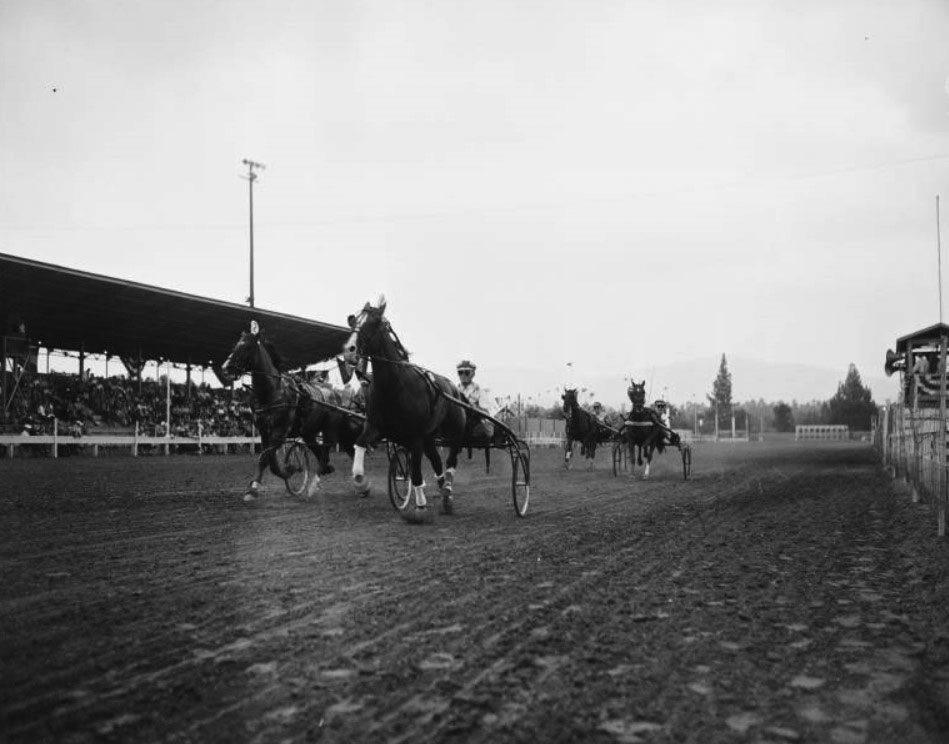 |
|
| (1951)^^ – Trotting Races at the Valley Fairgrounds, on August 30, 1951. |
Historical Notes The State of California bought the property for $140,000 in 1948, at which time it also became the home of the 51st District Agricultural Association's annual San Fernando Valley Fair. *^ |
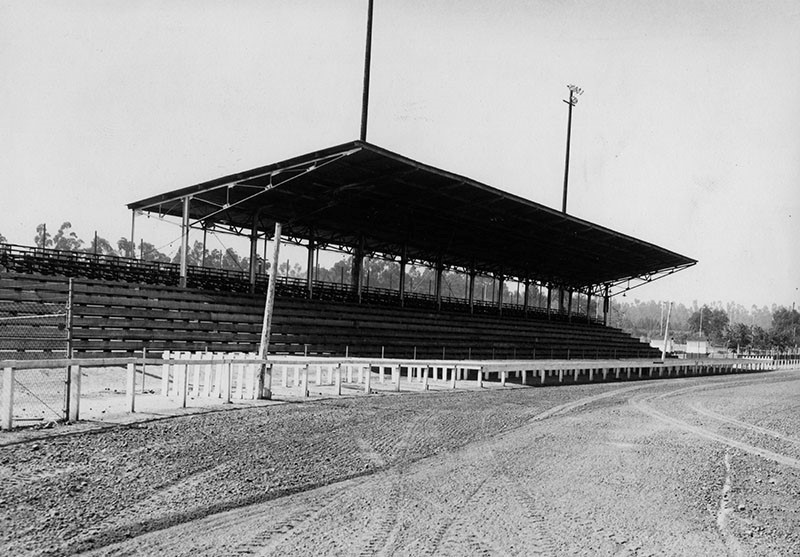 |
|
| (1950)* - Close-up view of the Devonshire Downs grandstand with racetrack on the right. |
Historical Notes Devonshire Downs later became a venue for concerts and other events, including rodeos. |
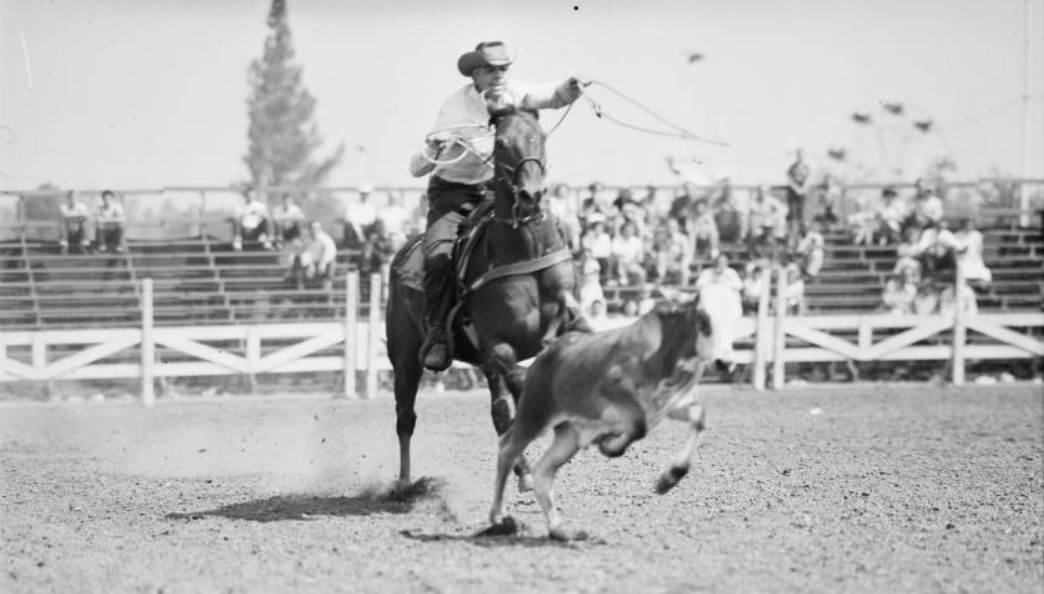 |
|
| (1951)^^ - A rodeo cowboy shows off his roping and riding talents at Devonshire Downs during the San Fernando Valley Fair. |
Historical Notes The Downs hosted annual fireworks shows and the Scoutcraft Fair, but entertained its largest crowd the weekend of June 20-22, 1969. Newport '69, which drew at least 200,000 people, was the nation's biggest outdoor rock festival until Woodstock, headlined by Jimi Hendrix, Eric Burdon, Marvin Gaye and others. In 1959 the expanding San Fernando Valley State College (now CSUN) claimed the land for expansion, but in 2001 virtually the entire site was razed for a private industrial park under lease to the school. |
Newport '69 (Devonshire Downs)
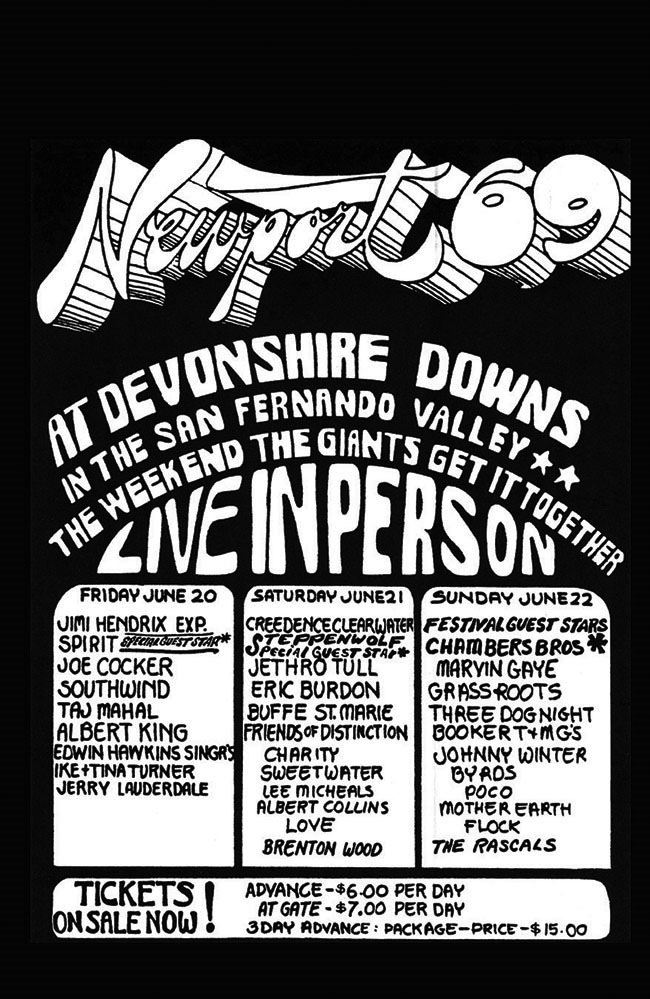 |
||
| (1969)^ - Attended by an estimated 200,000 fans on June 20–22, 1969, this festival was the largest pop concert up to that time and is considered one of the most famous Pop Festivals in Southern California, possibly because of the appearance of the top-billed Jimi Hendrix Experience. |
Historical Notes In the summer of 1969, an estimated 200,000 people—a record number at the time—dropped in to the sun-drenched Devonshire Downs racetrack in Northridge (now part of the CSUN campus) to hear a stellar list performers including Jimi Hendrix, Joe Cocker, Creedence Clearwater, The Rascals, The Byrds, Booker T. & the M.G.’s, Ike & Tina Turner, Eric Burdon, Jethro Tull, Marvin Gaye, The Grass Roots, Three Dog Night and Johnny Winter. List of Performers: Friday, June 20, 1969: Ike & Tina Turner, Albert King, Edwin Hawkins Singers, The Jimi Hendrix Experience, Joe Cocker, Southwind, Spirit and Taj Mahal. Saturday, June 21, 1969: Albert Collins, Brenton Wood, Buffy Sainte-Marie, Charity, Creedence Clearwater Revival, Eric Burdon and War, Friends of Distinction, Jethro Tull, Lee Michaels, Love, Steppenwolf and Sweetwater. Sunday, June 22, 1969: Booker T. & the M.G.'s, The Chambers Brothers, The Flock, The Grass Roots, Johnny Winter, Marvin Gaye, Mother Earth, Jimi Hendrix jam with Buddy Miles, Eric Burdon and Mother Earth, Poco, The Byrds, The Rascals and Three Dog Night.*^ |
* * * * * |
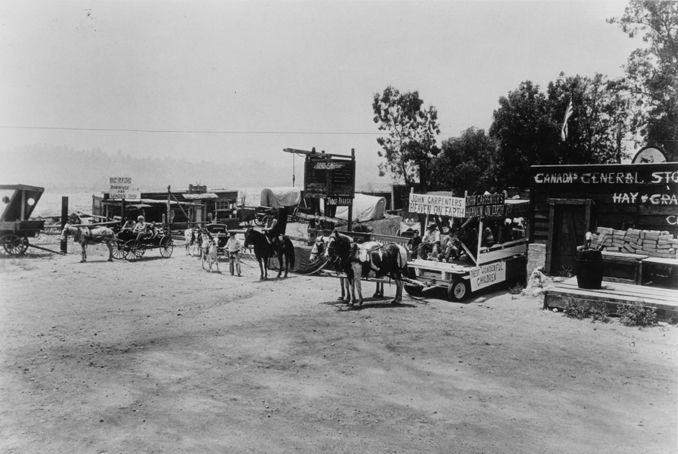 |
|
| (ca. 1940s)#^ - View of John Carpenter's Heaven on Earth Ranch. |
Historical Notes The Heaven on Earth Ranch, first located in Glendale, California (later moved to Lake View Terrace), was available for visitors to come and spend a day with the horses and enjoy the mock western town that served as the ranch's backdrop.#^ |
Van Nuys Boulevard
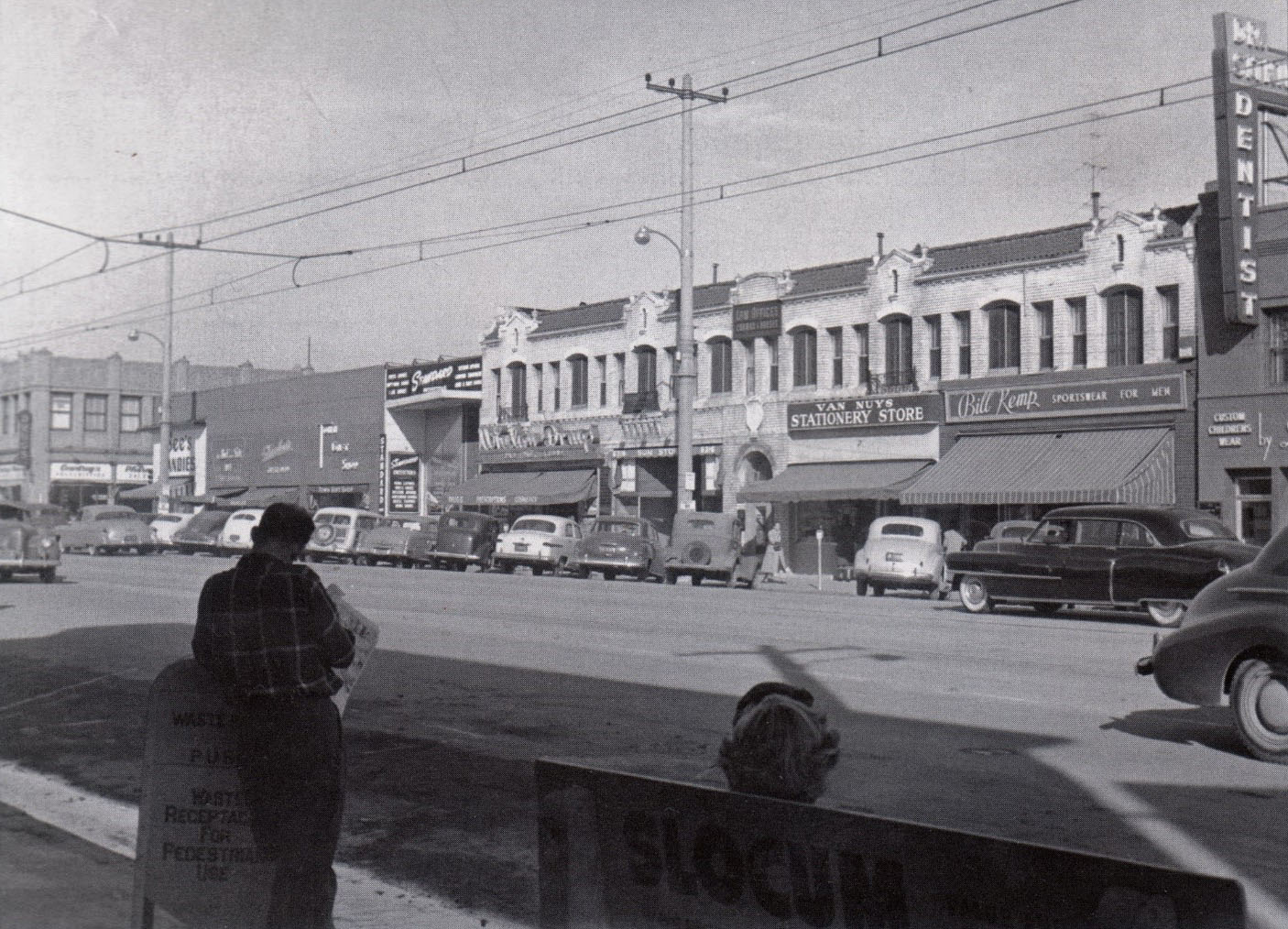 |
|
| (1952)^ – View looking toward the west side of the 6400 block of Van Nuys Blvd. Many post war (WWII) businesses opened in this section. On the two corners of Friar are Courdrey’s Drugs, & See’s Candies, then left to right – Shirlee Dress Shop, Town Gift Shop, Standard Outfitters, Whelan Drugs, Dr. R E Elliott, Sun Store, Law Offices of Corman and Hansen (upstairs), Van Nuys Stationery Store (Bush’s), Bill Kemp Sportswear, and Dentist Dr. Sitkin. Photo courtesy Keith Hart |
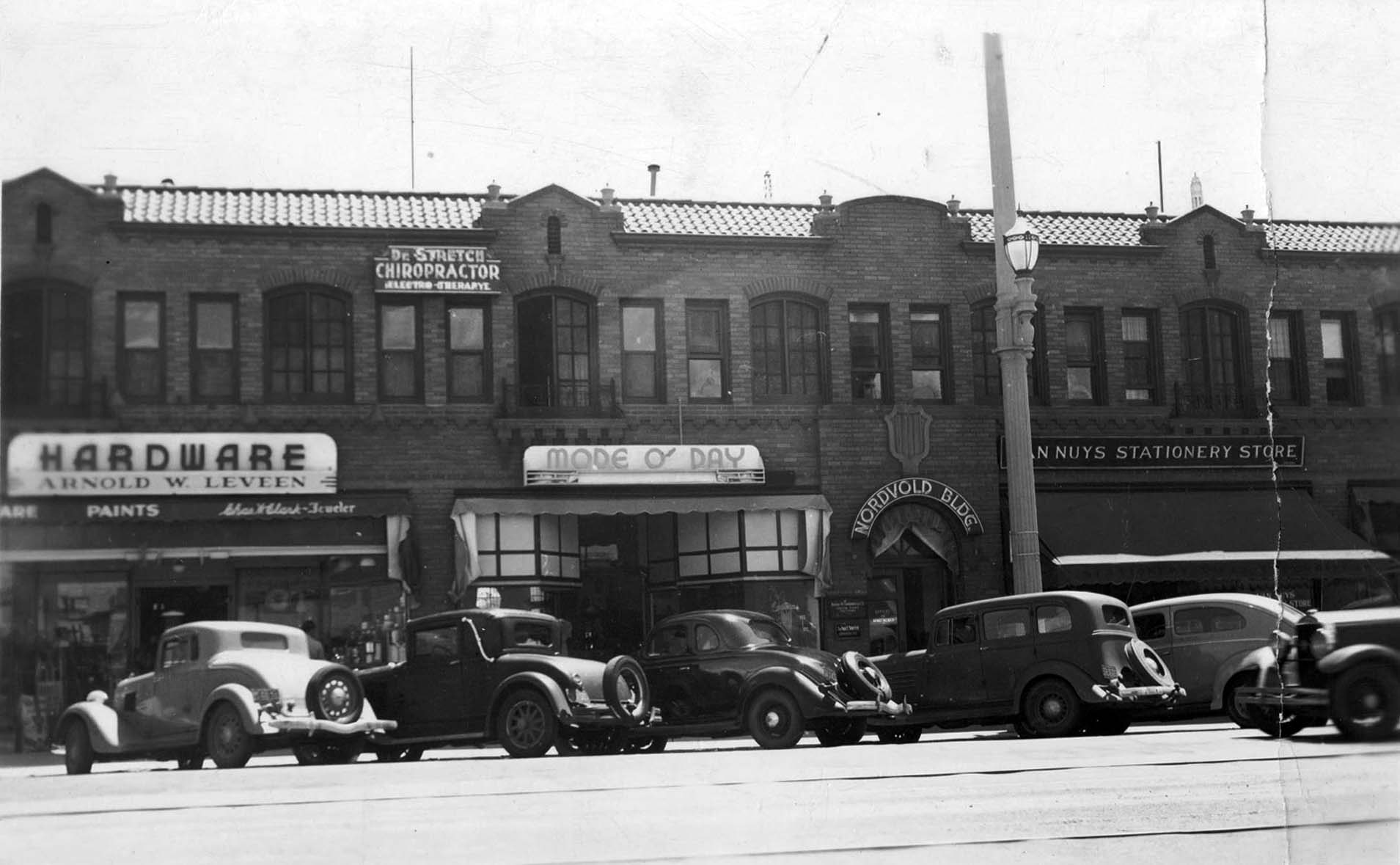 |
|
| (ca. 1940)^^^* - View of cars parked in front of the Nordvord Building located at 6420 Van Nuys Blvd., just north of Victory Blvd. Some of the stores in the building include (left to right): Arnold W. Leveen Hardware, Dr. Stretch Chiropractor, Mode O’ Day, and the Van Nuys Stationary Store. Note the ornamental streetlight in front of the building. Click HERE to see more in Early L.A. Streetlights. |
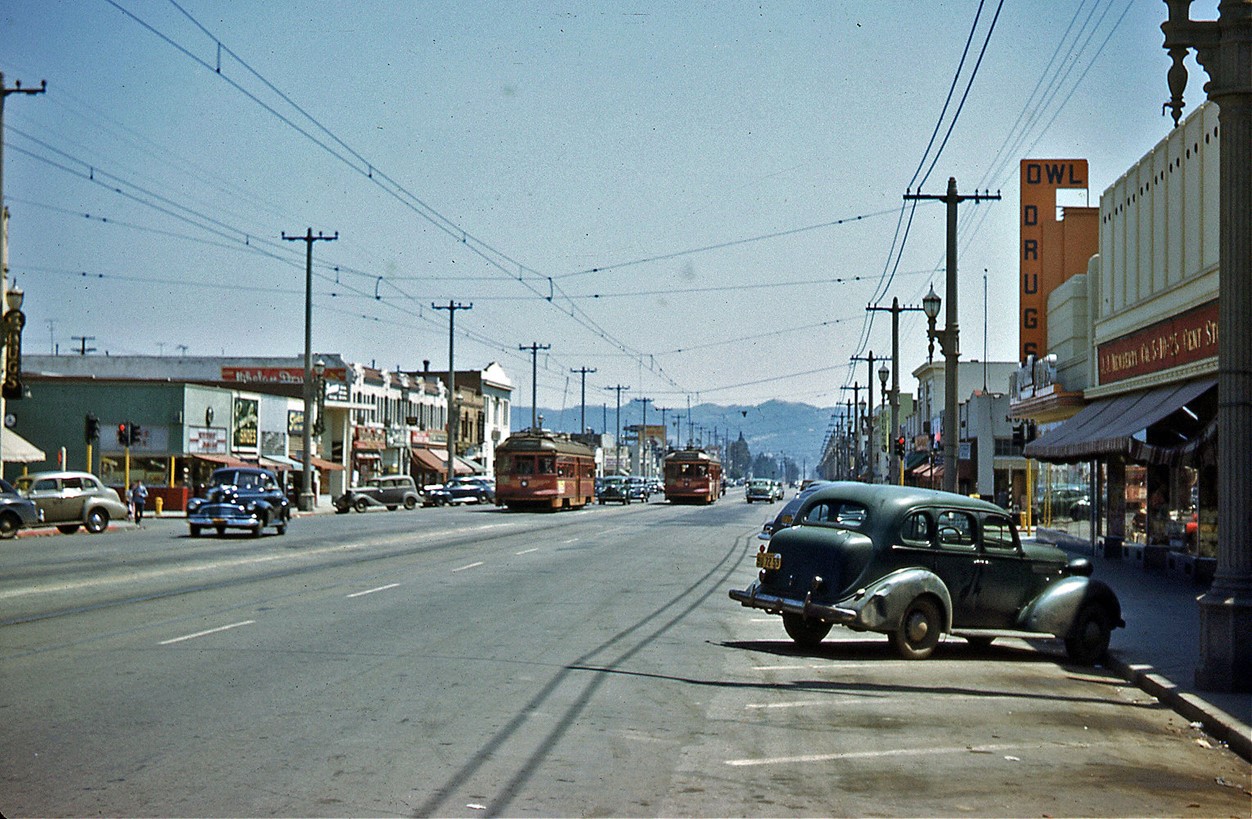 |
|
| (ca. 1945)* – Looking south on Van Nuys Blvd toward Friar Street with Pacific Electric Red Cars running down the center of the street. |
Rivoli Theatre
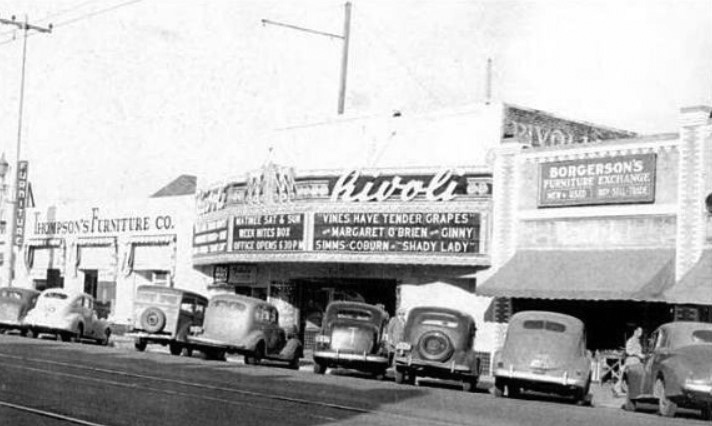 |
|
| (1945)^ – Cars parked diagonally in front of the Rivoli Theatre located at 6248 Van Nuys Bouelvard. The theater is bookended by two furniture stores. |
Historical Notes The Rivoli Theatre opened in 1921 at Sherman Way near Erwin Street. That chunk of Sherman later got renamed Van Nuys Blvd. The address is listed as 6262 Van Nuys Blvd. in the 1926 city directory, 6260 in 1928, 6258 in the 1939/40 directory with it being called the Fox Rivoli. By 1959 or 1960 the building got remodelled and emerged as the Capri Theatre. The theater closed in the early 70s and was demolished for a Federal Building parking lot. The theatre's former location is now part of the site of the Van Nuys / City of LA Braude "Constituent Service Center." The theatre was just north of Erwin which now dead ends at Van Nuys Blvd. What had been Erwin east of Van Nuys Blvd. is a pedestrian walkway between the City of LA building and the Federal Building to the south.^ |
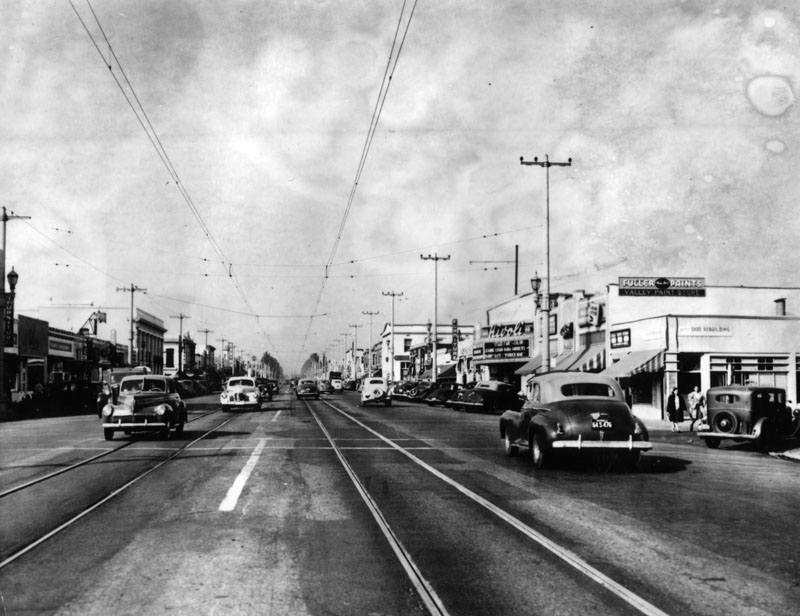 |
|
| (ca. 1946)* - View looking north on Van Nuys Boulevard at Erwin Street in the "Central Business District" of Van Nuys. The Rivoli Theatre can be seen on the east side of the Boulevard. |
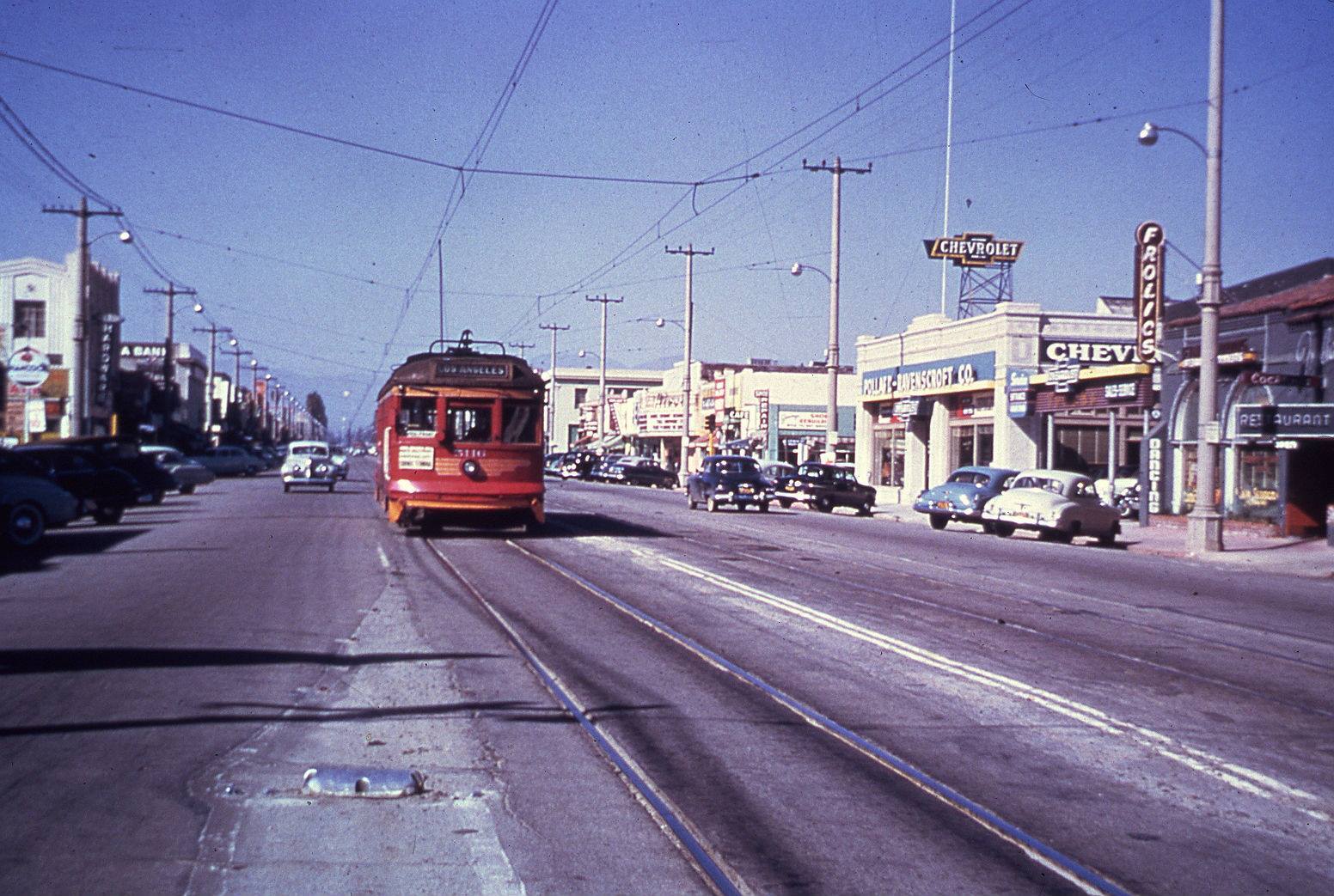 |
|
| (1950)^ – Pacific Electric car no. 5110 heads south on Van Nuys Boulevard near Erwin Street. To the right is Frolics Restaurant located at 6216 Van Nuys Boulevard. Further back is a Chevrolet Dealership and in the distance can be seen the Rivoli Theatre. |
Then and Now
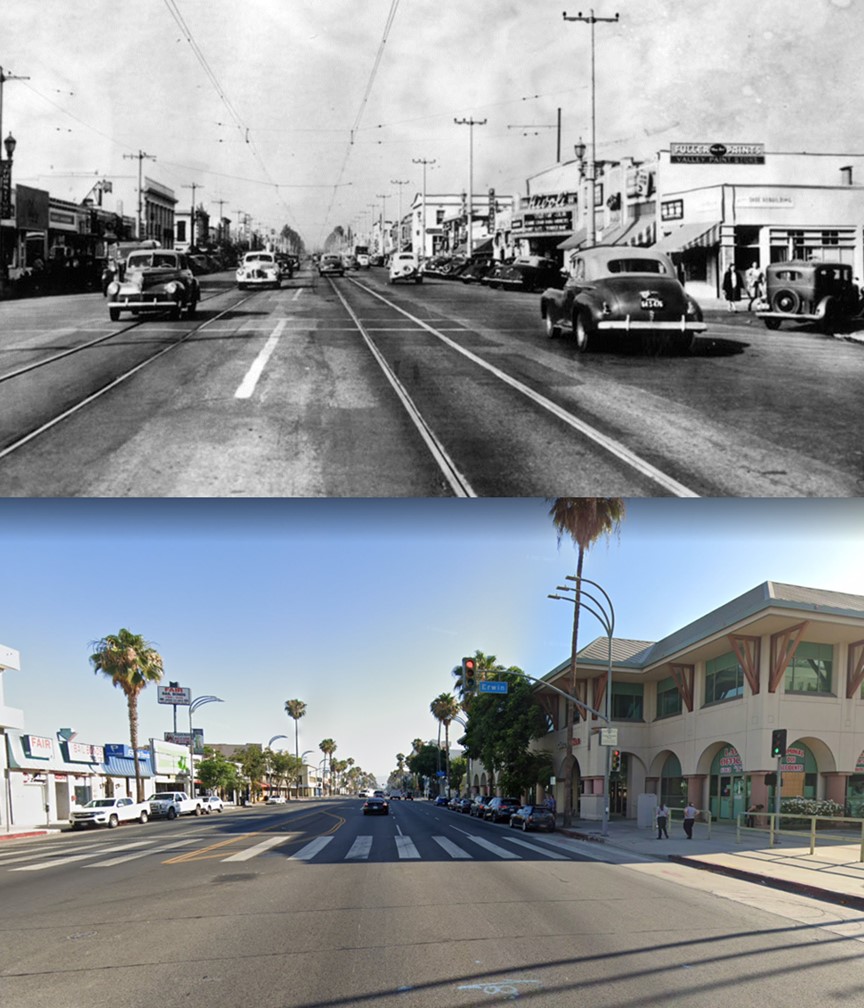 |
|
| (1946 vs 2021)* – Looking north on Van Nuys Boulevard at Erwin Street showing streetcar tracks running down the center of the street. The Rivoli Theatre can be seen in upper right, today site of the Marvin Braude San Fernando Valley Constituent Service Center. |
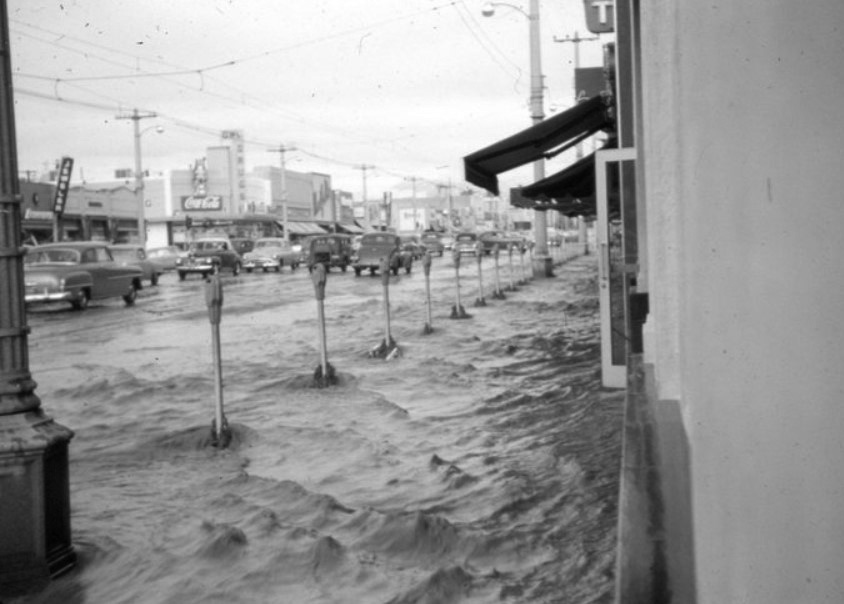 |
|
| (1952)^.^ – View looking north on Van Nuys Boulevard showing flooded street and sidewalk. |
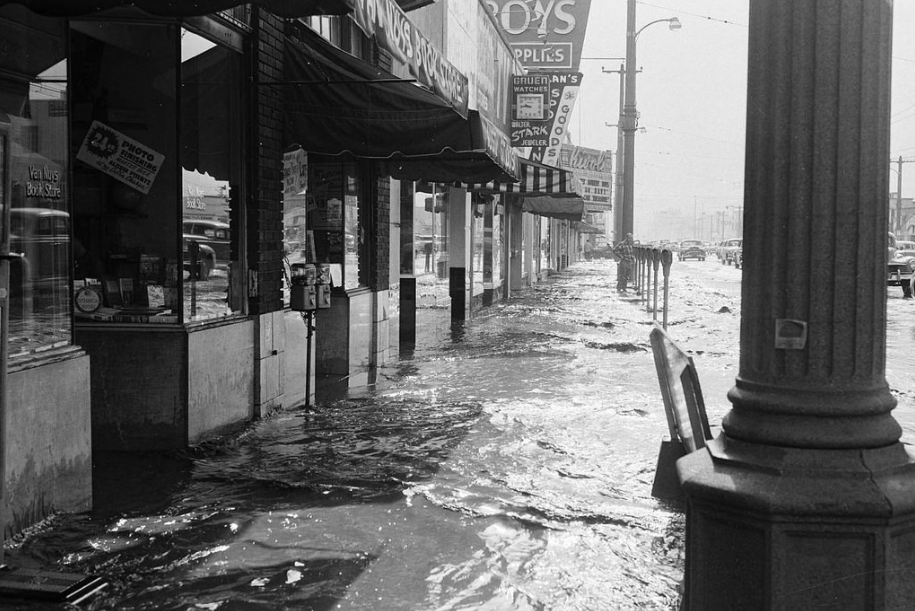 |
|
| (1952)##^ - High water, looking south on the 6200 block of Van Nuys Boulevard. Pep Boys and The Rivoli Theatre can be seen in the background. |
 |
|
| (1952)^ – View showing the 6200 block of Van Nuys Blvd, east side. From left to right are: Shoe Center, Toy Store, Stark Jewelers, Dolan’s Sporting Goods, Pep Boys, and the Rivoli Movie Theatre. |
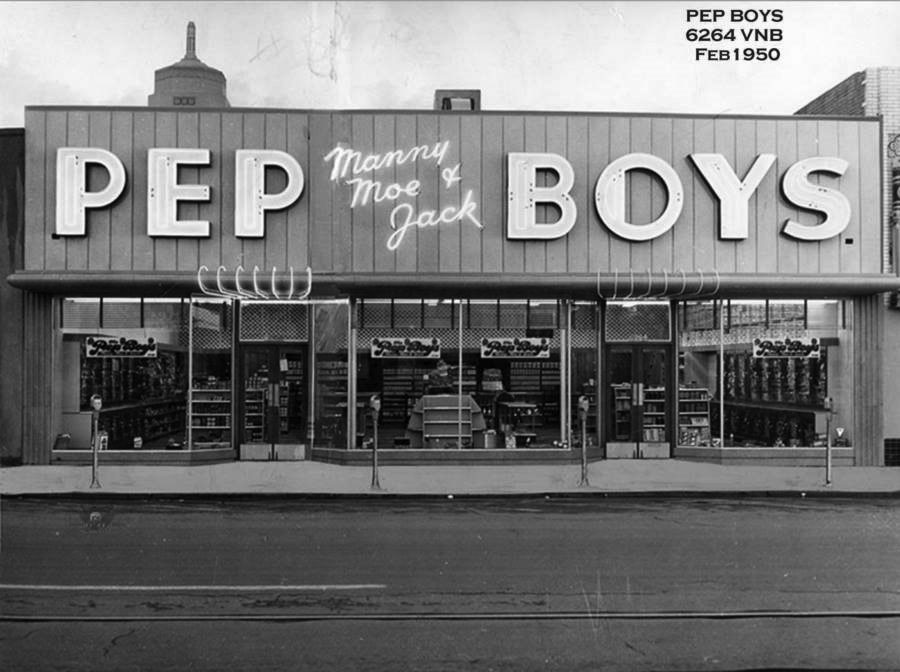 |
|
| (1950)#^*^ – View showing Pep Boys (Manny, Moe, & Jack) located at 6264 Van Nuys Boulevard. The top of Van Nuys City Hall can be seen in upper left. Photo courtesy of Rich Krugel |
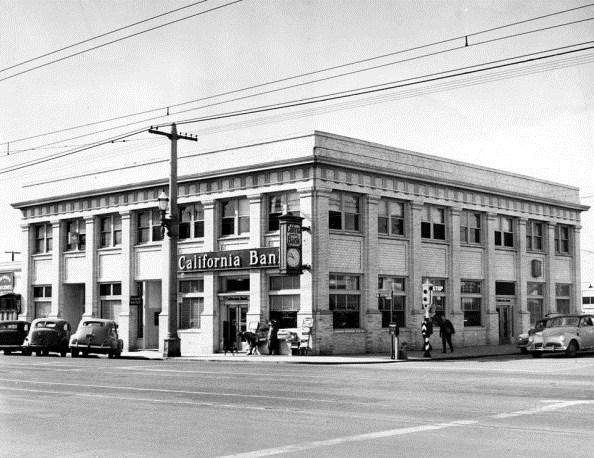 |
|
| (1949)^ - Exterior view of the California Bank on the corner of Van Nuys Boulevard and Sylvan Street, Van Nuys. |
Historical Notes The California Bank building was built in 1911 by H.J. Whitley and was originally known as the Bank of Van Nuys. The building is now the Country General Store and has been family owned since 1956.*^^^ |
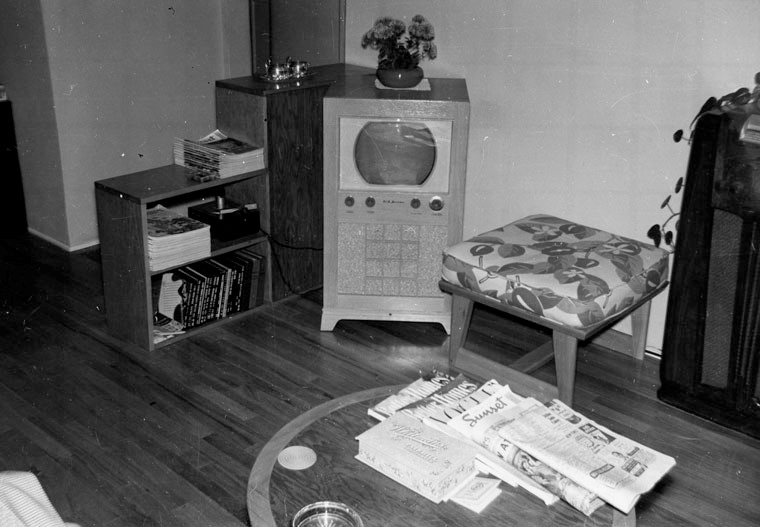 |
|
| (ca. 1947)* - Interior view of a San Fernando Valley home, showing a television set in the living room corner. Better Homes, Vogue, and Sunset magazines, along with two newspapers, are neatly stacked on the coffee table next to a box of Whitman’s Chocolates. A phonograph player is seen at left sitting on the shelf of a bookcase. |
Historical Notes Television usage in the United States skyrocketed after World War II with the lifting of the manufacturing freeze, war-related technological advances, the gradual expansion of the television networks westward, the drop in television prices caused by mass production, increased leisure time, and additional disposable income. While only 0.5% of U.S. households had a television in 1946, 55.7% had one in 1954, and 90% by 1962. By the late 1960s and early 1970s, color television had come into wide use.*^ |
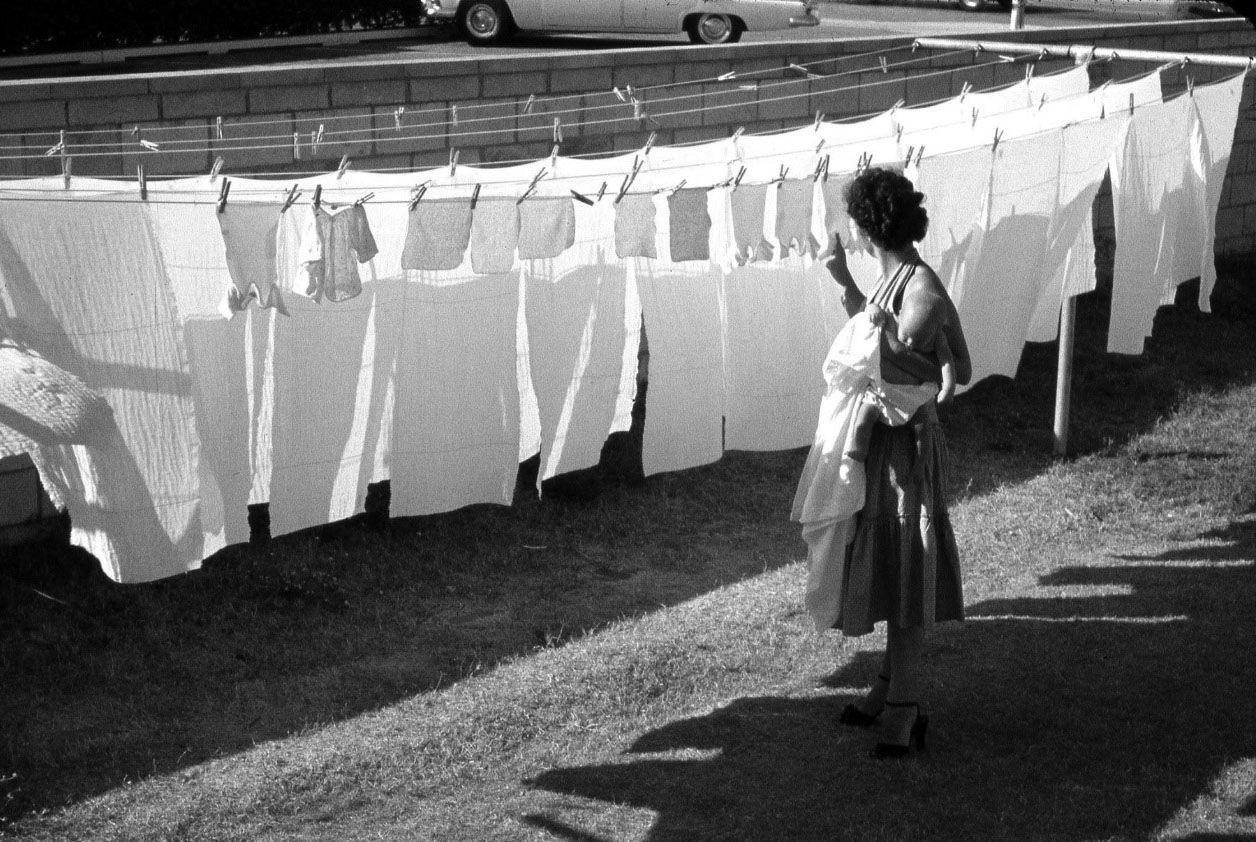 |
|
| (1956)^.^ - A woman hangs clothes on a clothesline while carrying a baby. Not often seen today. |
Historical Notes In 1955, only 10 percent of U.S. households had a clothes dryer, probably because they were expensive. Back then, the average price for a dryer was $230. Adjusted to today’s dollars, that lowly laundry appliance would have cost between $2,000 to $3,000.^ |
Van Nuys Drive-in Theatre
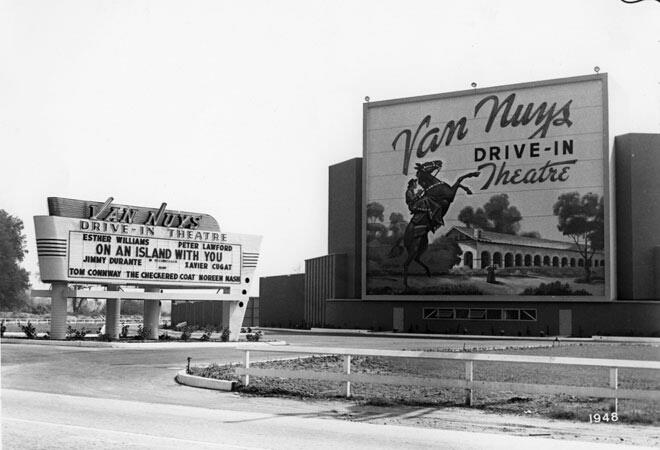 |
|
| (1948)**#^ - Outside view of the Van Nuys Drive-in Theater located at 15040 Roscoe Boulevard. The featured movie is On An Island With You, starring Esther Williams and Peter Lawford. The drive-in had swings under the screen for the children to play. |
Historical Notes The Van Nuys Drive-In was one of many Pacific drive-ins that had murals on their screen towers. The outdoor theater opened in 1948 and parked 891 cars. It lost its mural and original screen tower when it became a tri-plex drive-in.^**^ |
 |
|
| (1948)**#^ – Ground view looking southwest showing the Van Nuys Drive-in shortly after it opened. |
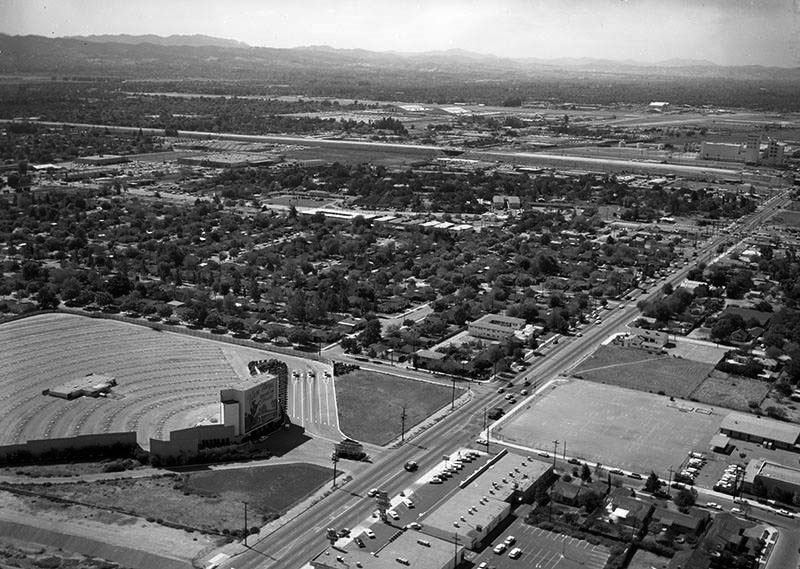 |
|
| (1964)* - View looking southwest showing the Van Nuys Drive-in Theater located at 15040 Roscoe Boulevard, Van Nuys (Roscoe & Noble, where Vista Middle School is today). |
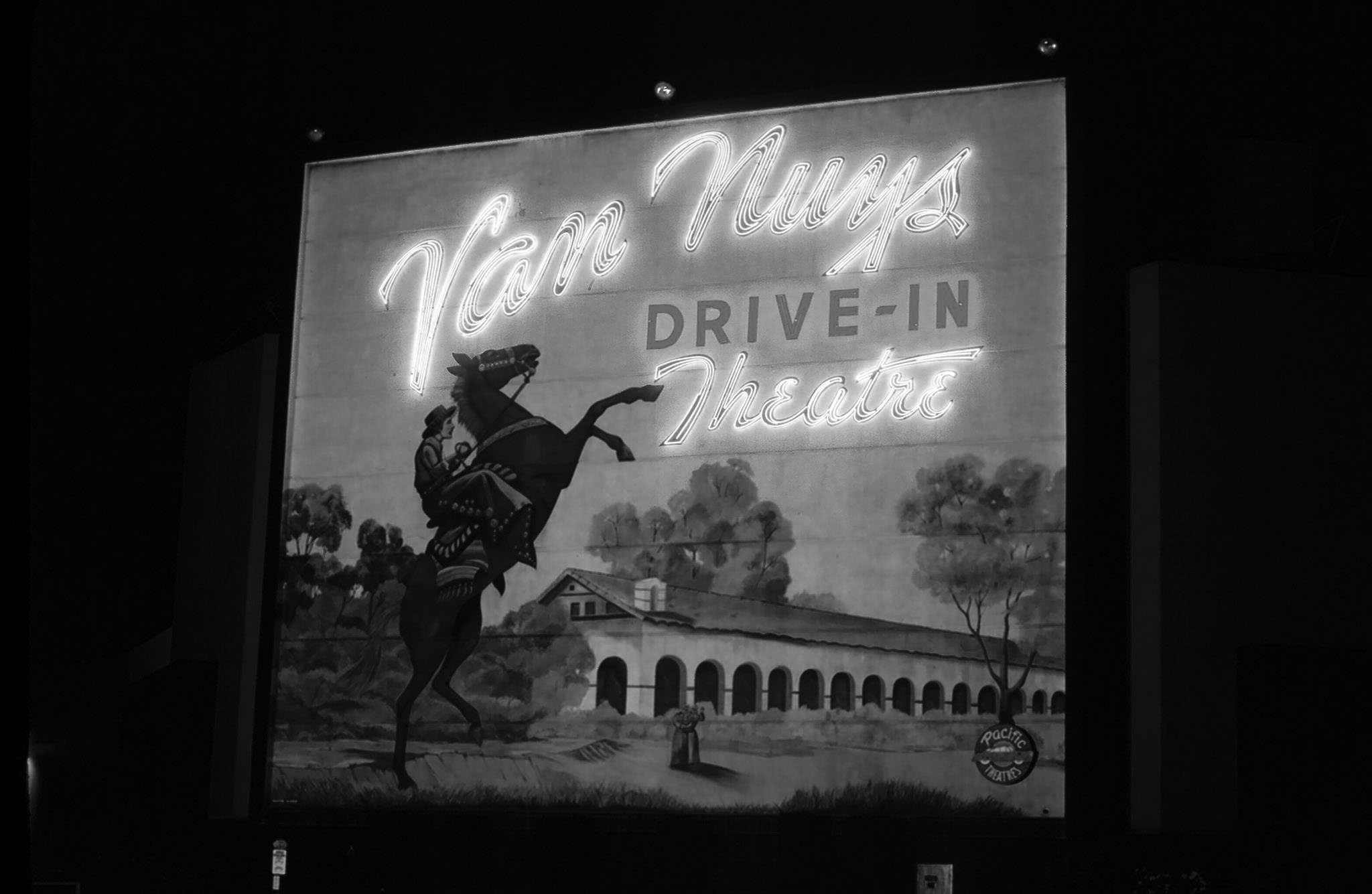 |
|
| (1979)* - Night view of the Van Nuys Drive-in mural with it's neon lights illuminating the back of the screen. |
Historical Notes During its last year, it was the last drive-in located in the San Fernando Valley. As Pacific Theatres closed the theater, its marquee said “closed for the season”. That season never came. The Van Nuys Drive-In sat empty for a few years and was being used to store cars from a nearby dealership. It was demolished in the late-1990’s. |
* * * * * |
General Motors Plant (Panorama Dairy and Sheep Ranch)
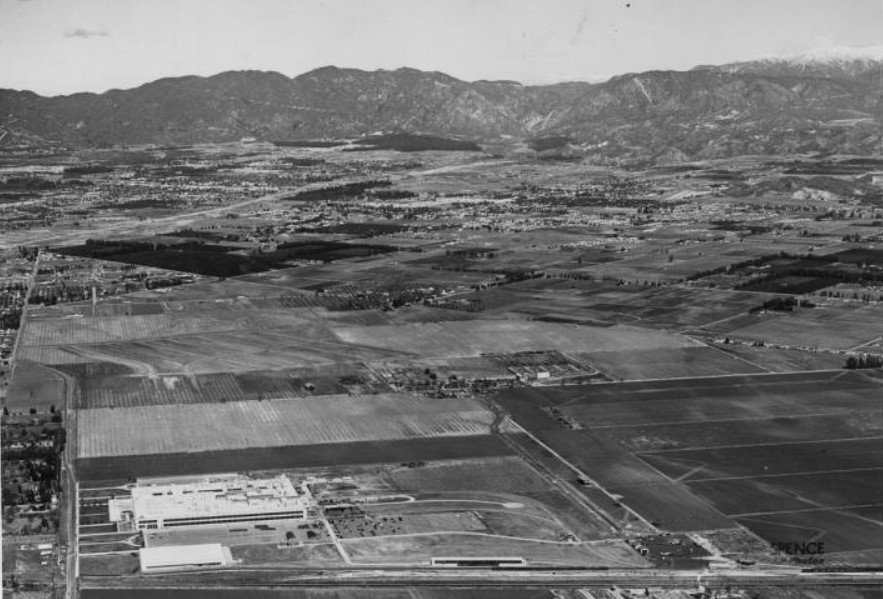 |
|
| (1949)* - Aerial view of the San Fernando Valley as it appeared in 1949. The Panorama Ranch and Chevrolet plant (foreground) can be seen before unprecedented boom which made it one of the fastest growing areas of its kind in the world at the time. |
Historical Notes Steel magnate Henry J. Kaiser had a motto: "Find a need and fill it." After World War II, Kaiser and land developer Fritz B. Burns realized returning GIs would need homes and plenty of them. Kaiser Homes bought about 400 acres of the Panorama Ranch dairy farm with plans to build 3,000 two- and three-bedroom homes. With $500 down, a veteran could purchase a two-bedroom home for $10,000. For Kaiser, whose father went blind and daughter died due to improper medical care, healthcare was a priority. Central to the plan for Panorama City was the Permanente Hospital. It was renamed Kaiser Permanente in 1953. |
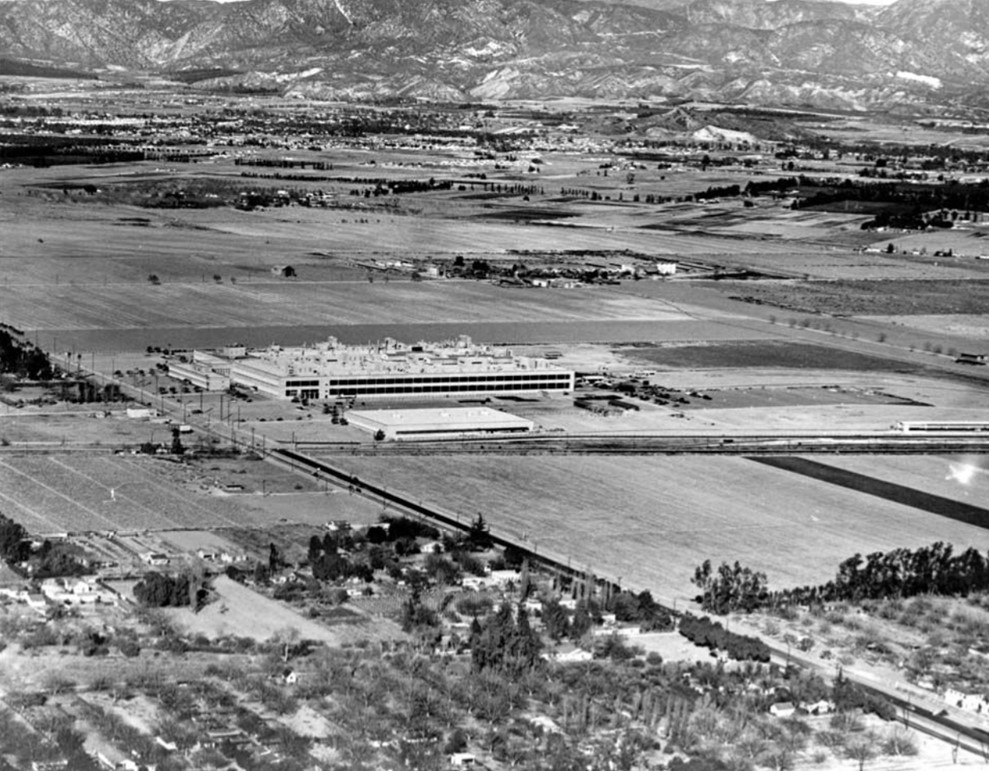 |
|
| (1948)* - Closer view of the General Motors plant in early suburban Van Nuys. Note the vast open space surrounding the assembly plant. |
Historical Notes The General Motors Assembly plant started production in 1947. It was one of the first major industrial companies to come to the San Fernando Valley and aided in its transformation from an agricultural to a suburban/industrial area. |
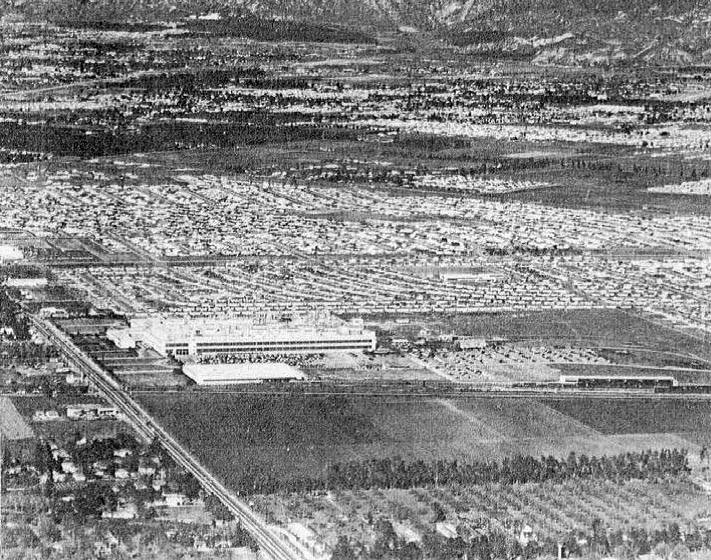 |
|
| (1953)* - Aerial view of the GM Plant and surrounding area showing the explosion of growth in only 5 years (see previous photo). |
Historical Notes The importance of industry to the Valley’s development is vividly illustrated in the last two views of the GM Assembly Division plant at Van Nuys. The top picture was taken in early 1948, less than a year after the plant began operations. Five years later, about the same time of year in 1953, as shown in the lower photo, thousands of homes had been built on acreage that was undeveloped real estate when the plant was built. |
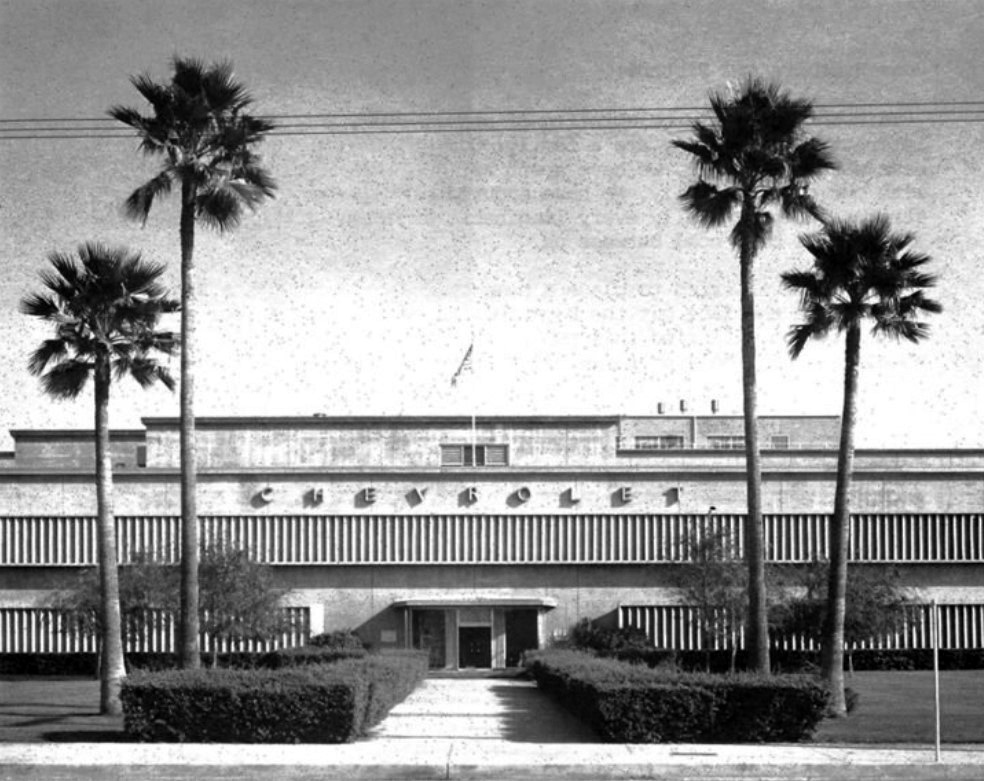 |
|
| (1947)* - Front entrance to the GM/Chevrolet Manufacturing Plant located on Van Nuys Blvd. |
Historical Notes The GM/Chevrolet Manufacturing Plant on Van Nuys Boulevard opened its doors in 1947, marking the beginning of a significant era for automotive manufacturing in the San Fernando Valley area of Los Angeles. This facility was established during the post-World War II industrial boom, reflecting the growing demand for vehicles in the rapidly expanding Southern California region. Initially, the plant's primary focus was on producing Chevrolet Advance Design trucks, which were popular in the post-war period. The opening of this facility was a major economic development for the area, creating numerous job opportunities and contributing to the local economy. The plant's establishment was part of General Motors' strategy to expand its manufacturing capabilities and meet the increasing demand for automobiles in the western United States. Its location on Van Nuys Boulevard was strategic, providing good access to transportation networks and a growing workforce in the San Fernando Valley. |
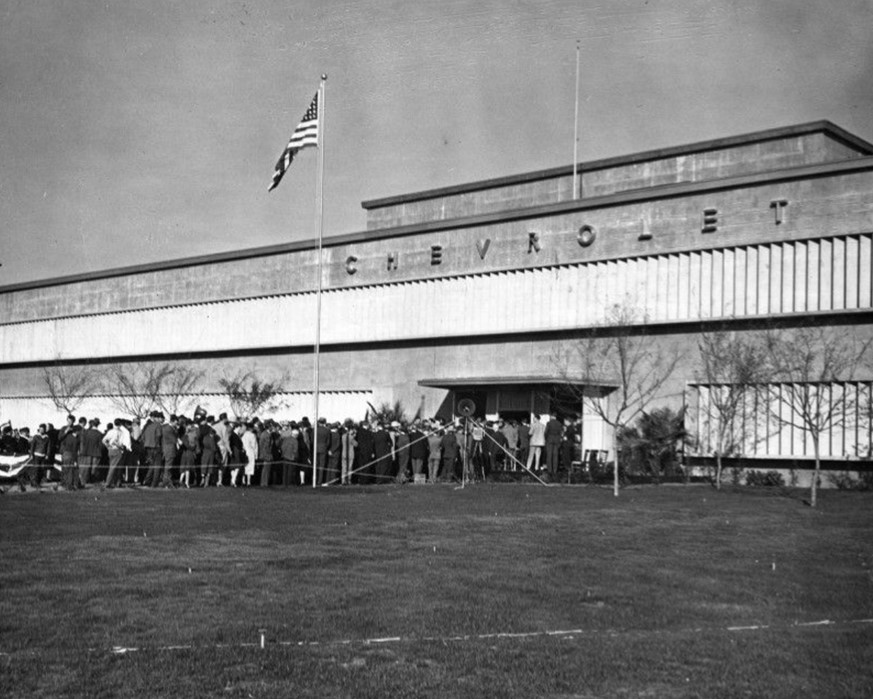 |
|
| (1948)* - Crowd in line for the public opening of General Motors' Chevrolet Motor Division assembly plant at 8000 Van Nuys Blvd. Photograph dated February 23, 1948. |
Historical Notes Over time, the plant would evolve to produce a wide range of GM vehicles, including popular models like the Chevrolet Impala, Corvair, and later the Camaro and Pontiac Firebird. The opening of this plant in 1947 set the stage for decades of automotive production that would significantly impact the local community and economy until its eventual closure in 1992. |
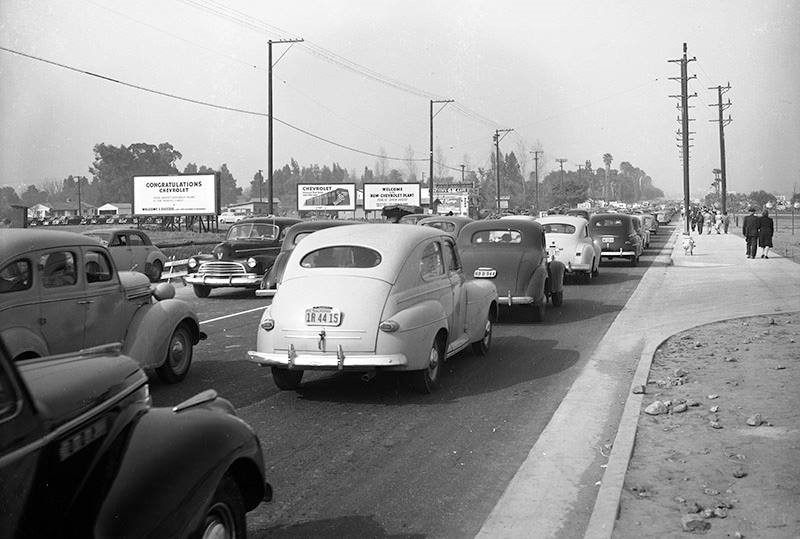 |
|
| (1948)* - View looking north on Van Nuys Boulevard near Arminta Street showing traffic at a standstill during an open house for the newly constructed GM/Chevrolet assembly plant. |
Historical Notes "The Plant" officially opened in 1947 and produced GM models such as the Chevrolet Corvair, Nova, Camaro and the Pontiac Firebird. When in full production, the plant employed 3,500 workers and helped to expand industrial, commerce and residential development. |
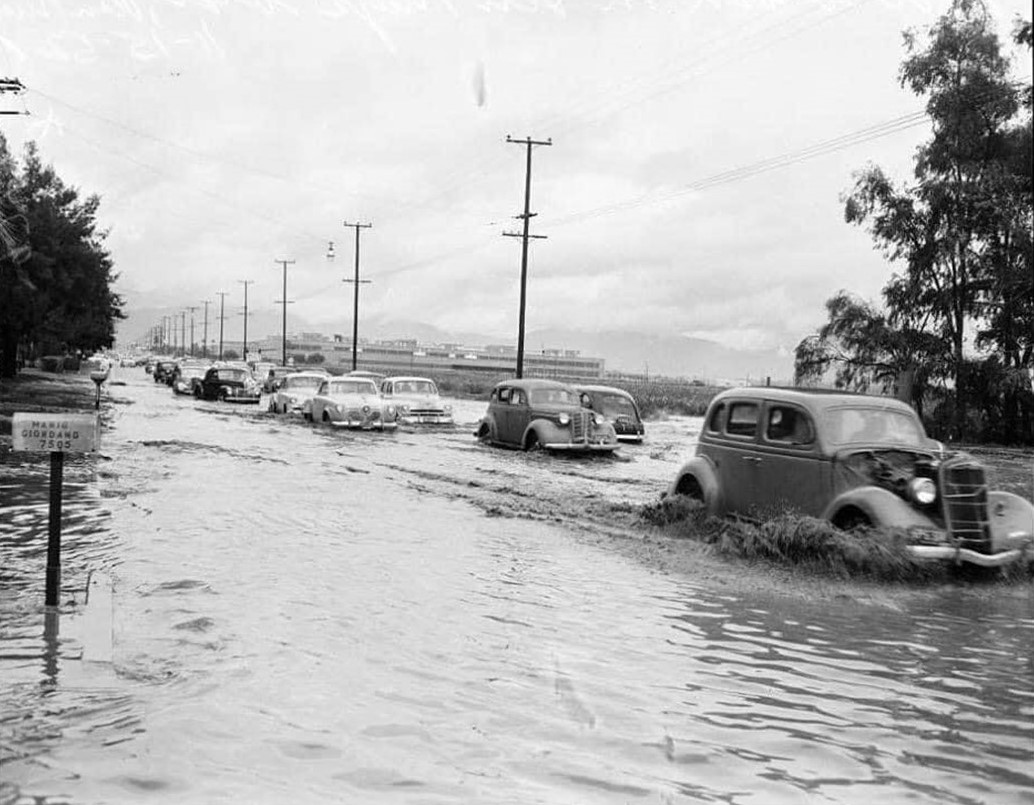 |
|
| (ca. 1949)* - Cars on a flooded Van Nuys Boulevard with the General Motors Plant seen in the background. The address on the mailbox on the left is 7505 Van Nuys Blvd. |
Historical Notes Flooding on Van Nuys Boulevard was a significant issue in the San Fernando Valley during the late 1940s and 1950s, primarily due to rapid urban development and inadequate flood control infrastructure. Click HERE to see more on Flooding in the San Fernando Valley. |
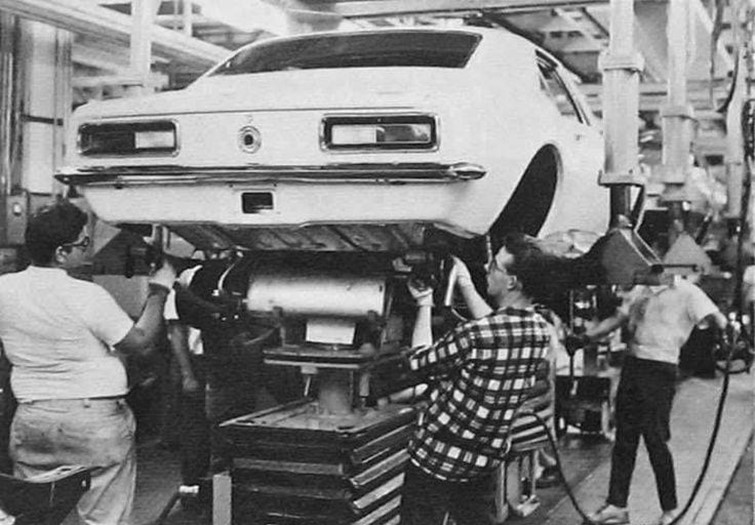 |
|
| (1960s)* – Workers at the GM plant in Van Nuys assembling what appears to be a Camaro. |
Historical Notes The GM Plant assembled Camaros and Firebirds on the same line. |
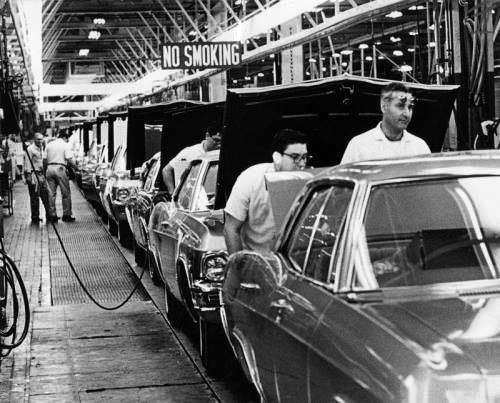 |
|
| (ca. 1966)* - View showing the assembly line at the General Motors Plant in Van Nuys. |
Historical Notes The GM assembly plant in Van Nuys, California, which opened in 1947 and operated until 1992, was a significant automobile manufacturing facility during the 1960s. It produced several popular Chevrolet models, including the Impala, Biscayne, Corvair, Chevelle, and Nova. Known for its versatility, the plant often built multiple models on the same assembly line and was recognized for producing unique and high-performance vehicles, such as special order cars with powerful engines and limited production performance models. At its peak, the Van Nuys plant employed nearly 3,000 workers and played a vital role in the post-World War II industrial boom in Southern California. With its 68-acre facility and flexible manufacturing capabilities, the plant contributed significantly to General Motors' production network and the American automotive landscape during this iconic decade. |
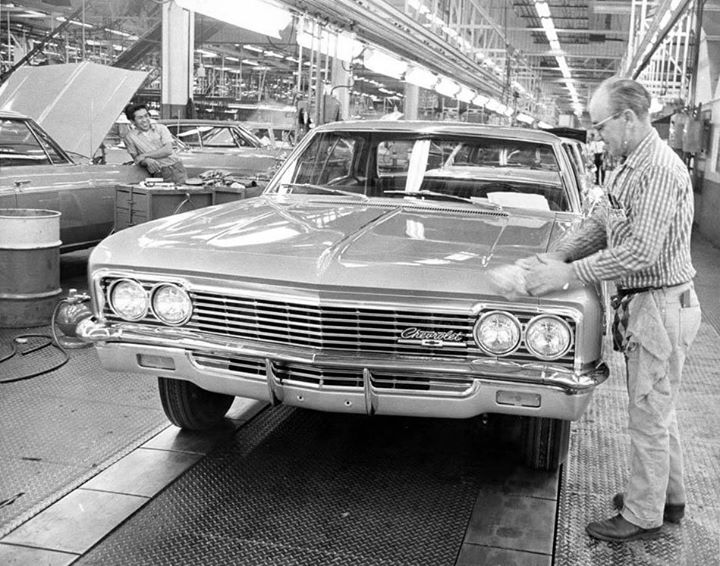 |
|
| (ca. 1960s)^ - View showing an assembly worker putting the final touches on a Chevrolet Impala at the General Motors Assembly Plant in Van Nuys. |
Historical Notes The GM Assembly Plant was closed in 1992 when Camaro/Firebird production was moved to Sainte-Thérèse Assembly in Quebec. The site was razed in 1998. A retail and industrial complex, known as The Plant, was built on the 68-acre site, as well as Station 81 of the Los Angeles Fire Department. The retail portion totals 365,000 square feet and is home to 35 retail stores and restaurants. A 16-screen movie theater honors the site history with an automotive theme décor. GM continues to operate a car-testing facility on 27 acres next to The Plant. |
* * * * * |
Panorama City
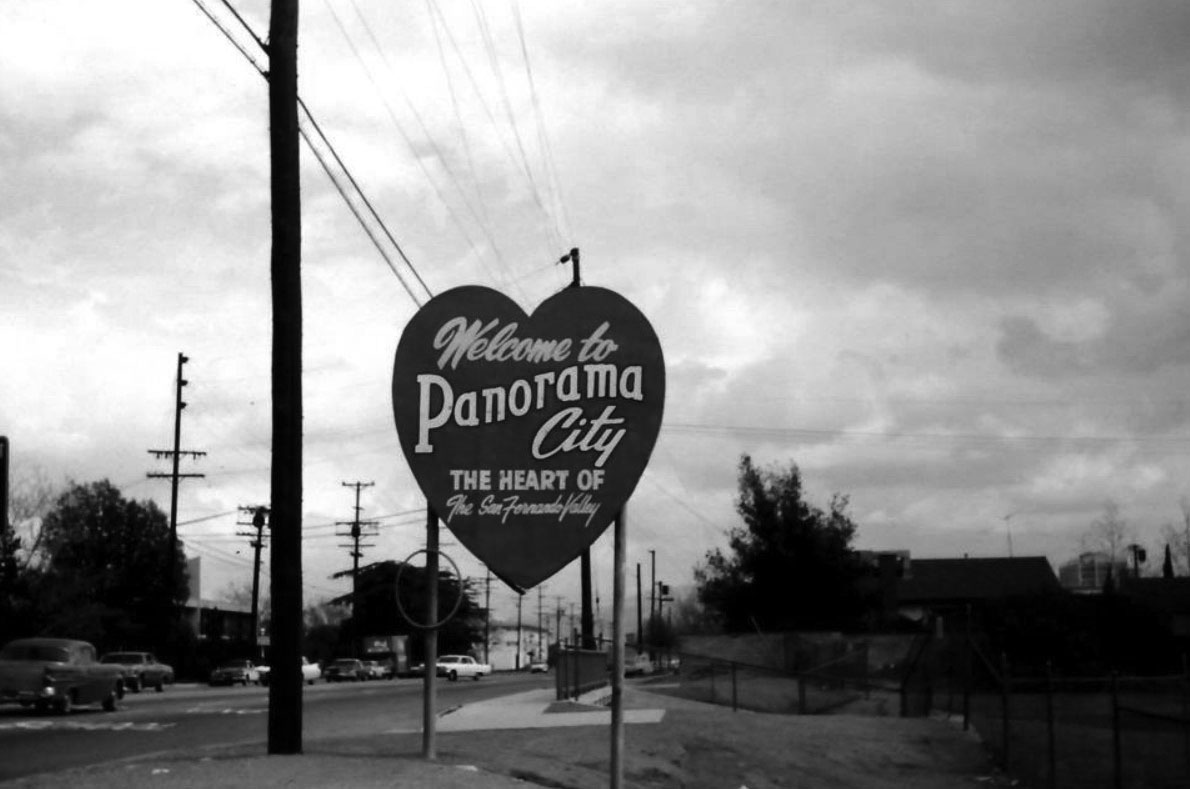 |
|
| (1960s)^.^ – Welcome to Panorama City – The Heart of the San Fernando Valley. Photo courtesy of George McGraw |
Historical Notes Panorama City is known as the San Fernando Valley's first planned community. In 1948, it was developed as such by residential developer Fritz B. Burns and industrialist Henry J. Kaiser. The master plan was created by architectural firm Wurdeman & Becket. Burns, seeing the tremendous potential fortune that could be made as large numbers of World War II veterans came home and started families, teamed up with Kaiser in 1945 to form Kaiser Community Homes. The vast majority of the houses were bought with loans issued by the FHA or the Servicemen's Readjustment Act of 1944, better known as the G.I. Bill. Homes in the area were sold with racially discriminatory covenants. A "Conditions, Covenants, Restrictions" document filed with the county recorder declared that no Panorama City lot could be "used or occupied by any person whose blood is not entirely that of the white or Caucasian race." Such restrictive covenants, which sometimes also limited ownership to people "of the Christian faith", were common in many communities at the time, and although rendered legally unenforceable by the Civil Rights Act of 1968 they may still be found on some older property deeds. De facto integration was accelerated by the Community Reinvestment Act of 1977. The CRA-insured credit was provided to the entire community without regard to race or income, causing white flight as with many other areas of the San Fernando Valley. During the period of desegregation busing, Panorama City was exempted due to its diversity. In its history, Panorama City was once adjacent to General Motors' largest assembly plant to date. Today, the Van Nuys Assembly plant has been replaced with a large shopping center named The Plant, which includes stores and restaurants such as Regency Theatres, Ross, Babies "R" Us, The Home Depot, Hometown Buffet, Blaze Pizza, In-N-Out Burger, Starbucks Coffee and others. Panorama City touches Mission Hills on the north, Arleta on the northeast, Sun Valley on the east, Valley Glen on the southeast, Van Nuys on the south and North Hills on the west. For the most part, the community is a mixture of small single-family homes and low-rise apartment buildings.*^ |
Panorama City Shopping Mall
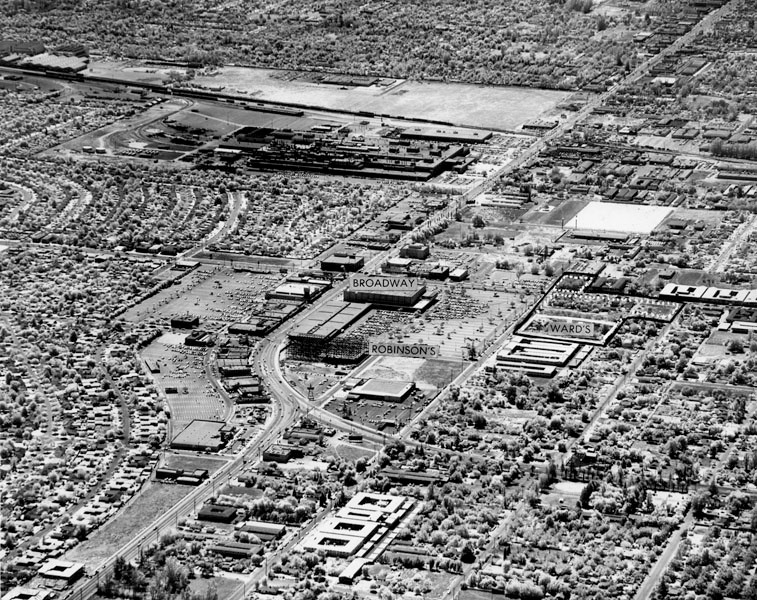 |
|
| (1960)* - Aerial view looking southeast showing the new Panorama City shopping district located near the intersection of Van Nuys and Roscoe Boulevards (center of photo). Broadway department store, framework on new Robinson's and site of new Montgomery Ward store and additional parking are indicated. The large plant in the background is the General Motors plant. |
Historical Notes During 1955-1964, the Panorama Mall featured over 100 stores including the department stores Broadway, Robinson’s, Montgomery Ward, and Orbach’s. The center was enclosed in 1980 under ownership of The Macerich Company. Broadway closed its doors in 1996 and the first Walmart Super Center opened in May 1998. This was the first Walmart in the City of Los Angeles and first multi-level Walmart in the United States. La Curacao opened in 1995 focusing on hard goods and changed their name to Curacao in 2012. The mall was purchased by Primestor Development in November 2015.^ |
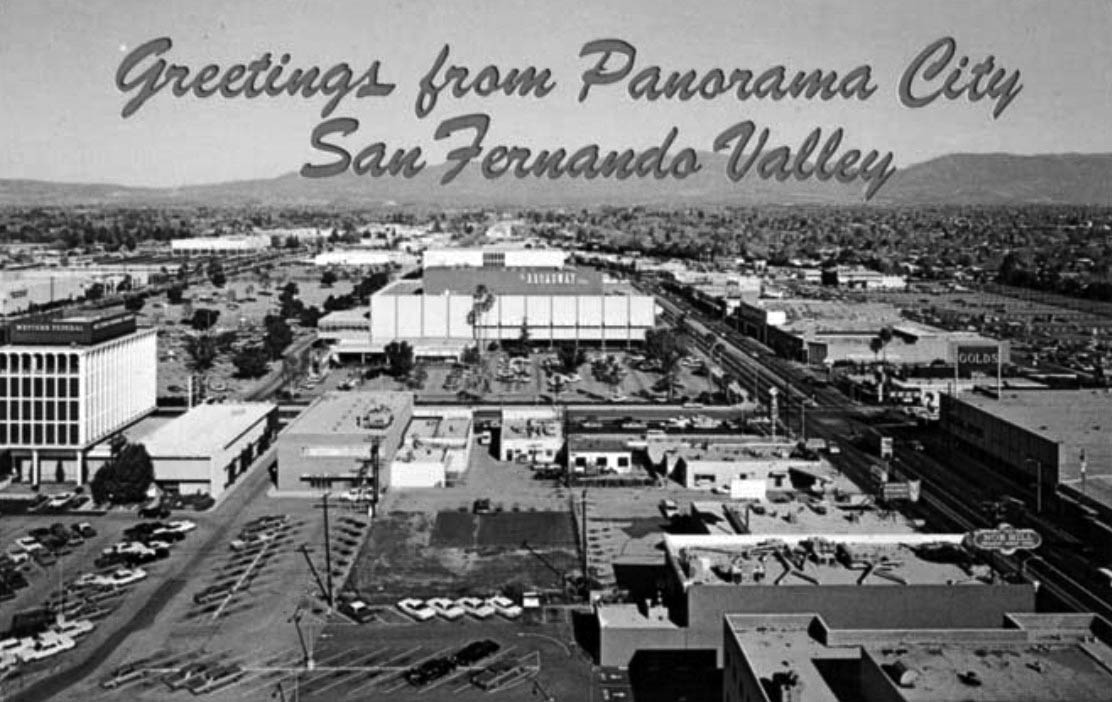 |
|
| (1960s)+## - Postcard view looking north showing the new Panorama City Shopping Mall. The intersection of Roscoe and Van Nuys bouelvards is at center-right. |
.jpg) |
|
| (1960s)* – Street view looking south on Van Nuys Boulevard toward the Broadway Department Store. Other stores seen here are: F. W. Woolworth, Kinney Shoes, and Thrifty Drug Store. |
Historical Notes The Broadway–Valley shopping center, as it was then known, opened on October 10, 1955, as a single strip of stores along Van Nuys Blvd. north of Roscoe Blvd, with 89,000 square feet of retail space adjacent to and sharing a parking lot with a 226,000-square-foot Broadway department store designed by architect Welton Becket. Silverwoods, Mandel's, Kinney Shoes, Lerner's and Woolworth were the other stores in the complex.^ |
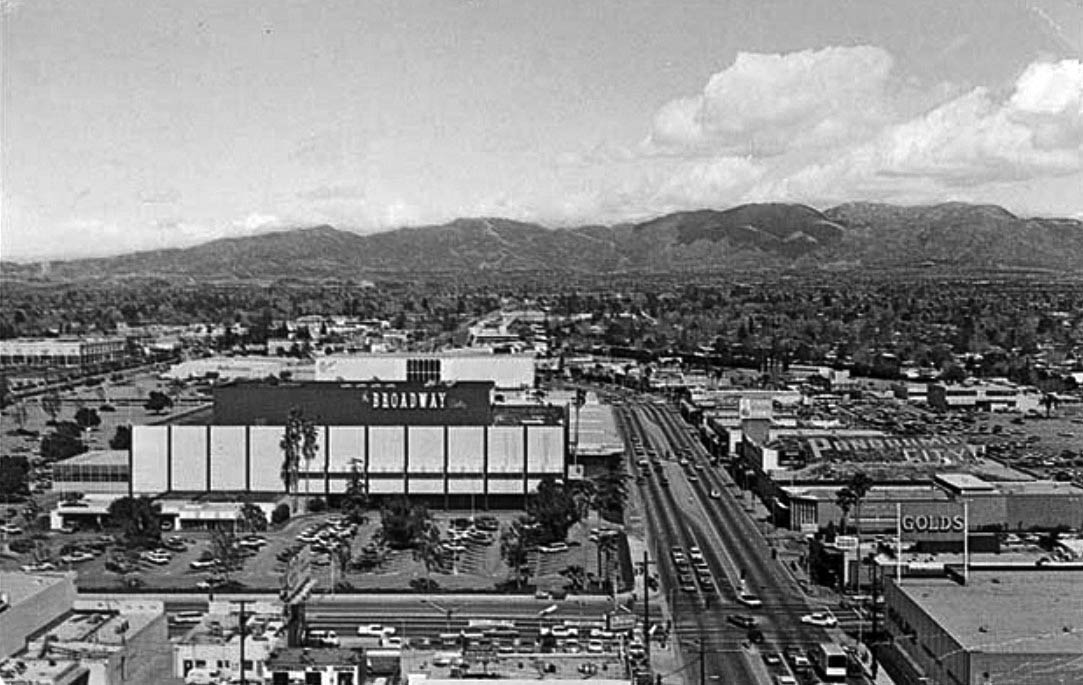 |
|
| (1970s)+## – Closer view of the Panorama Mall showing The Broadway Department Store at the northwest corner of Roscoe and Van Nuys. Gold's Furniture is on the southeast corner. |
Historical Notes The shopping center’s anchor department stores opened as follows: The Broadway, opened October 10, 1955, 226,000 square feet, 3 stories, currently Walmart Montgomery Ward, opened September 13, 1961, 154,537 square feet, 2 stories, closed in 2001, building currently empty J. W. Robinson's, opened on June 27, 1961 Ohrbach's, opened October 7, 1964, 115,000 square feet, 7.5-acre site, cost $5 million to build, currently the Valley Indoor Swap Meet. ^ |
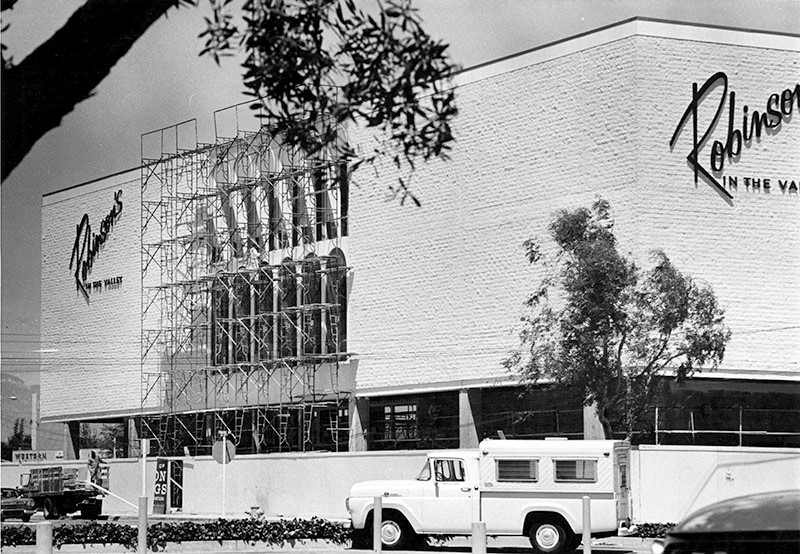 |
|
| (1961)* - View showing the nearly completed Robinson's department store in Panorama City. |
Historical Notes The new Valley Robinson’s was the fifth outlet for the company, which was founded in Los Angeles in 1883 by Joseph Winchester Robinson.* |
.jpg) |
|
| (1964)* - Photograph caption dated October 6, 1964 reads, "New store - Sculptured three-dimensional panels of concrete emphasize the structural frame of the new Ohrbach's department store, Panorama City, which will open tomorrow." The structure is located at 14650 Parthenia Street. Photo from the Valley Times. |
Historical Notes With the opening of Orbach's department store in 1964. . . Panorama Mall was the ONLY shopping center in the Valley that had 4 major department stores: Broadway, Robinson’s, Montgomery Ward, and Orbach’s. |
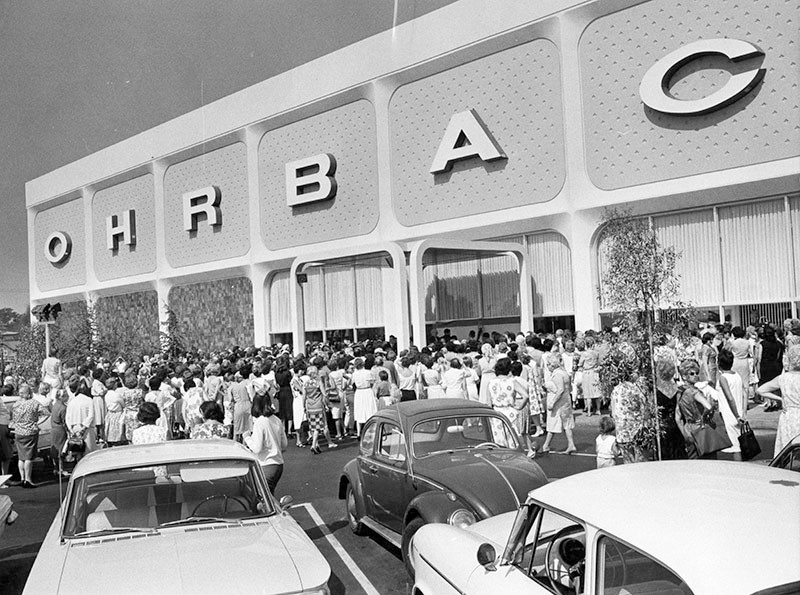 |
|
| (1964)* - Photograph caption dated October 12, 1964 reads, "Part of the large crowd that attended the opening of Ohrbach's new $5-million store in Panorama City last week. The new building on Parthenia Street between Cedros and Tobias Avenues contains 115,000 square feet and is the third Ohrbach's store in California." Photo from the Valley Times. |
Then and Now
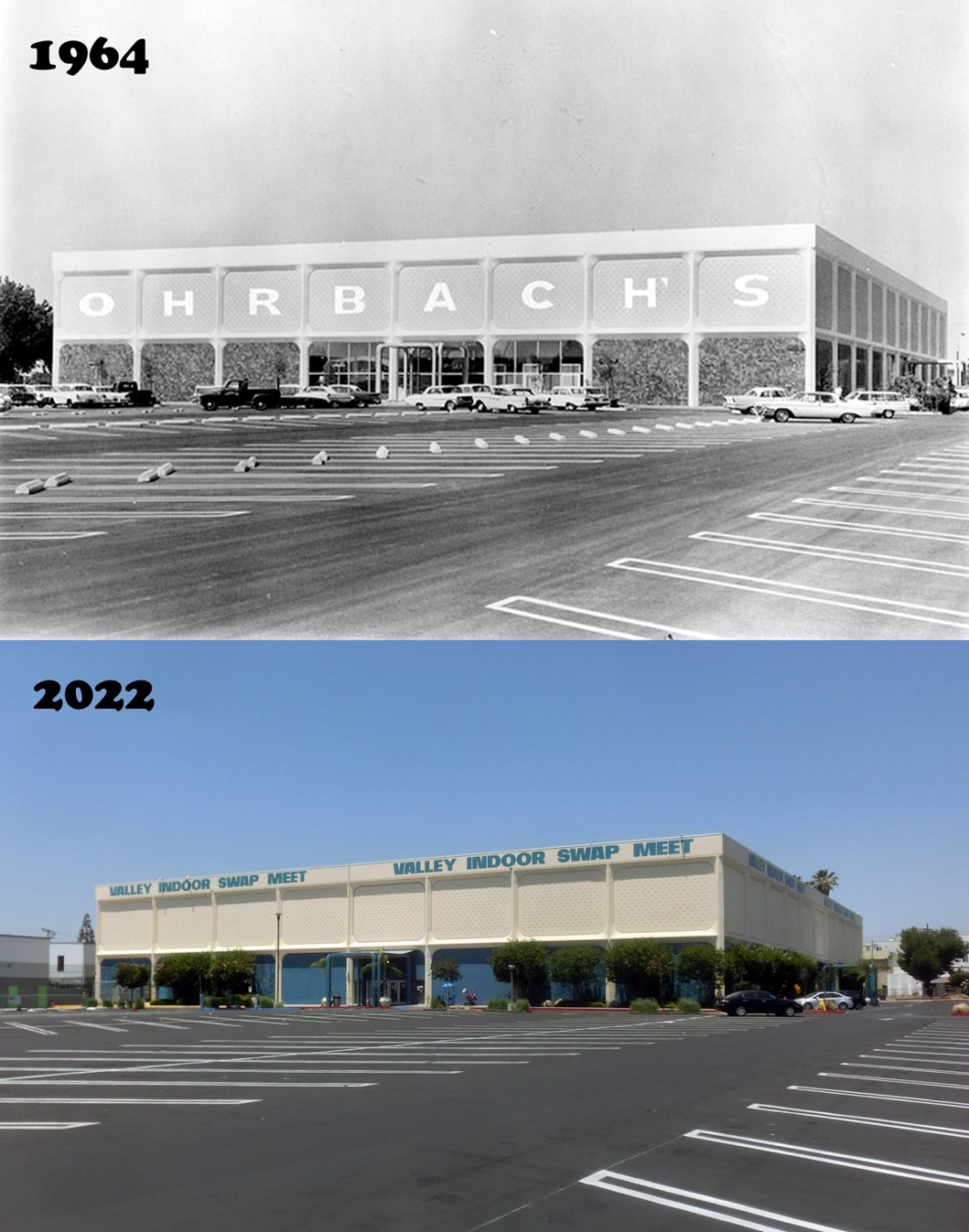 |
|
| (1964 vs. 2022)* - The Ohrbach’s Panorama City store closed in 1986, and the building has since served as the Valley Indoor Swap Meet. |
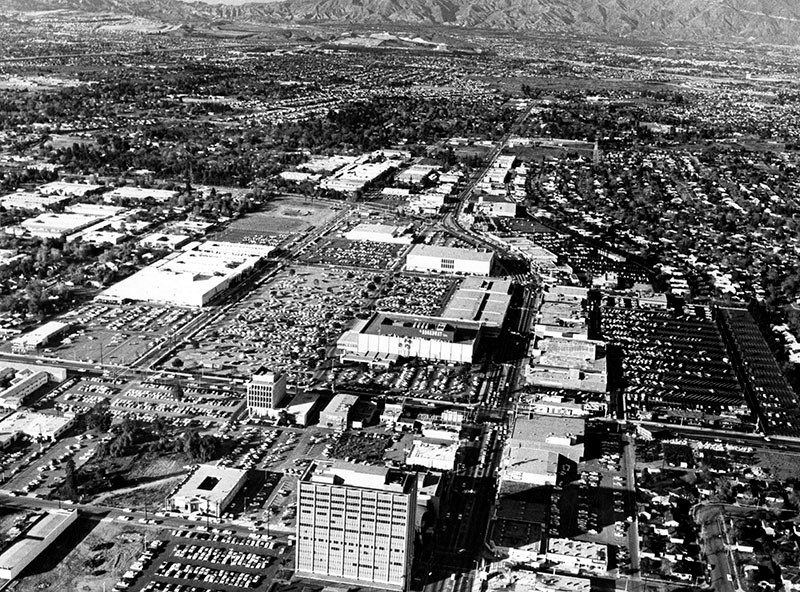 |
|
| (1965)* - Aerial view looking north down Van Nuys Boulevard showing the Panorama City shopping district. Note the number of parking lots, all mostly filled. |
Historical Notes People would come from across the Valley to do their shopping here. The Panorama shopping district had a hundred-plus shops including several major department stores such as Broadway, Robinson’s, Montgomery Ward, and Orbach’s. Perhaps not the most attractive feature of Panorama City, a testimony to the lively retail economy of the time, was 18 acres of parking lots. |
Panorama Market
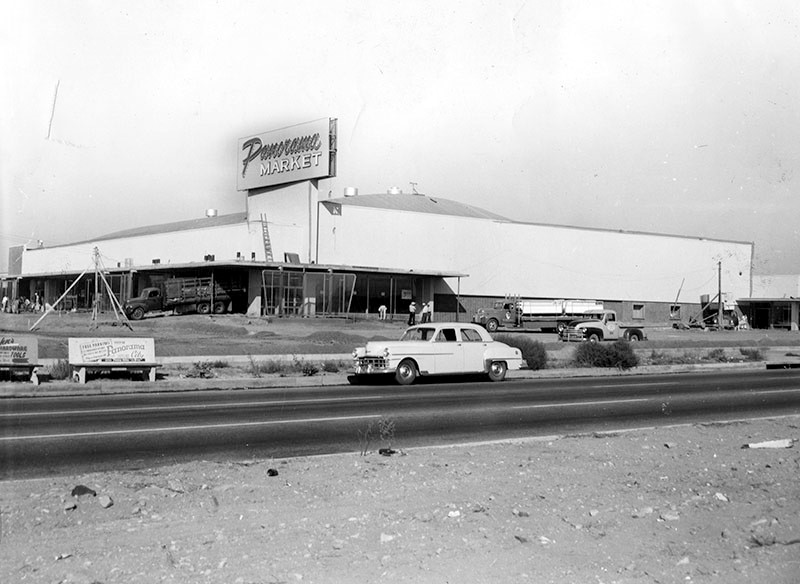 |
|
| (1954)* - View showing the construction of Panorama Market on the northwest corner of Sepulveda Boulevard and Devonshire Street. Architect: Arthur Froehlich |
Historical Notes Photo caption dated October 27, 1954 reads "Contractors are rushing to complete work on the new Panorama Market located at 10321 Sepulveda Blvd. at Devonshire Street. Company officials revealed today it will open during November. This new layout pictured above embraces 55,000 square feet of floor space and among its many features will be a free check cashing booth, free parking for hundreds of cars and unlimited one-stop shopping facilities at one of the most modern shopping centers with the latest innovations in the Southland. Ground for the project was broken last Spring. Arthur Froehlich is architect." |
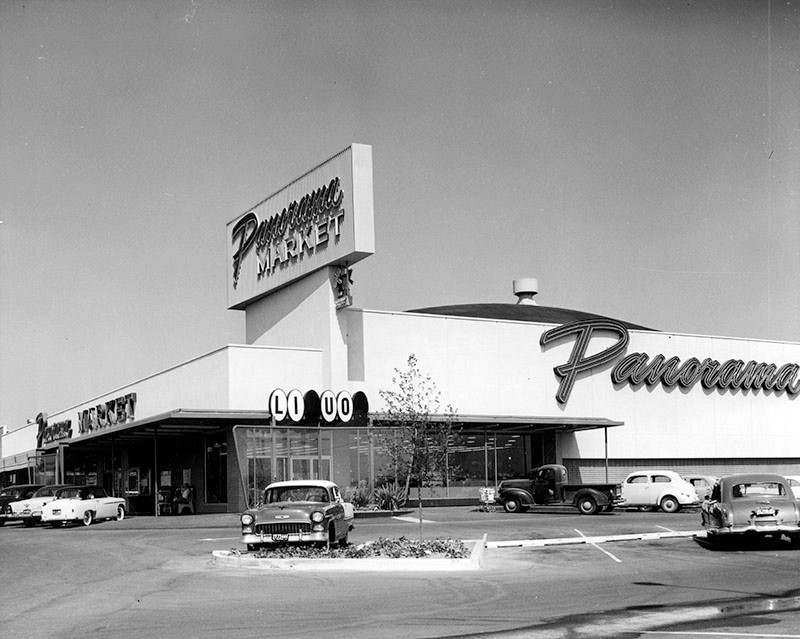 |
|
| (1957)* – View showing Panorama Market, 10321 Sepulveda Boulevard at Devonshire Street, Mission Hills. Today this is a Vons Market. Click HERE for contemporary view. |
Orcutt Ranch
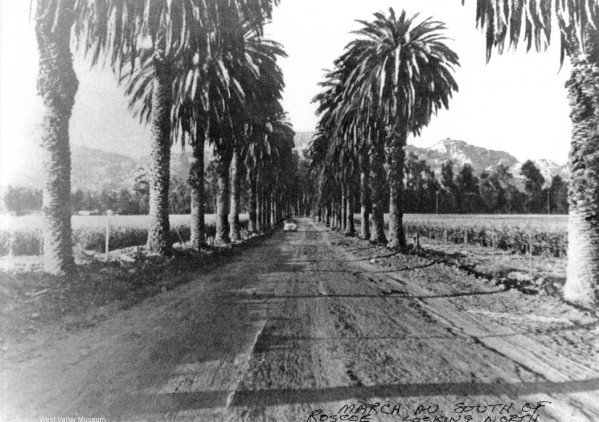 |
|
| (ca. 1948)^ - March Avenue, south of Roscoe Boulevard looking north. Orcutt Ranch is in the background. |
Historical Notes The Orcutt Ranch, formally called Rancho Sombra del Roble, was the vacation and retirement estate of William Warren Orcutt and his wife Mary Logan Orcutt. The adobe residence, as well as the estate’s garden, ranch structures, oak trees, and citrus orchard have historic significance because of the distinction of its owner W.W. Orcutt, pioneer of the oil production industry in California and discoverer of the prehistoric fossils at the La Brea Tar Pits. In January 22, 1965, the City of Los Angeles designated a 24-acre portion of the estate as Los Angeles Historic-Cultural Monument No. 31 (Click HERE to see complete listing), which included the residence, ranch structures, garden, oaks, and citrus orchard. At that time, Mrs. Orcutt was still residing within the adobe residence. One year later, the City of Los Angeles, Department of Recreation and Parks, acquired the property, preserving the site.*^^* |
Castle Peak
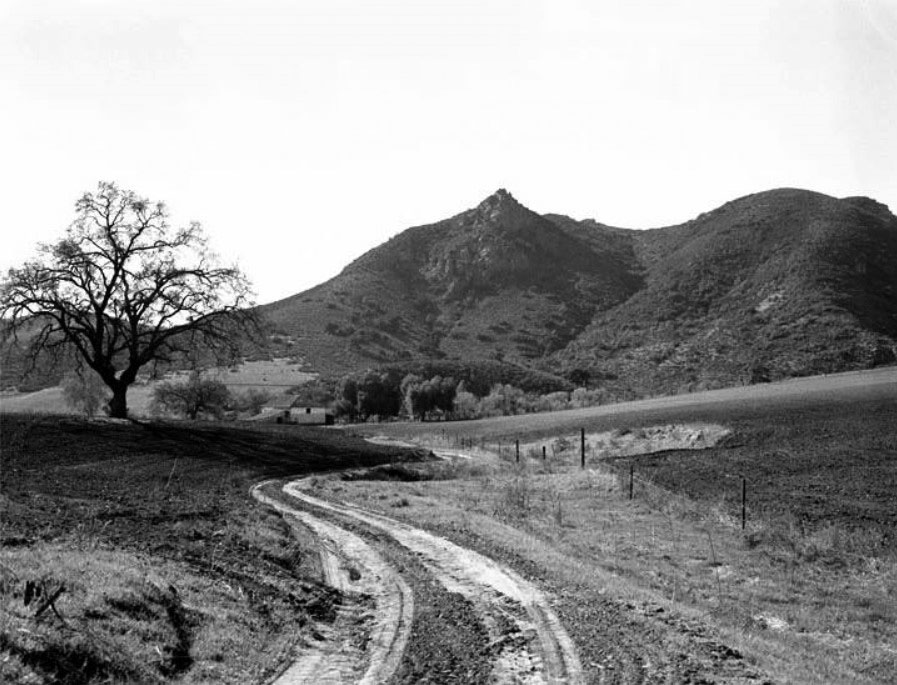 |
|
| (ca. 1940s)#^*^ - View of a dirt road winding its way toward a house or barn at the base of Castle Peak near Valley Circle. |
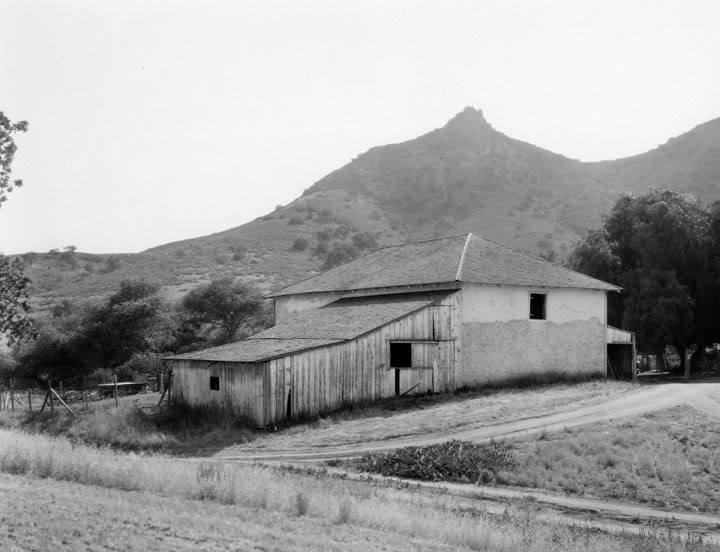 |
|
| (ca. 1947)* - View of the Leonis barn in Rancho El Escorpión as seen from Valley Circle Boulevard. Castle Peak is seen in the background. |
Historical Notes Rancho El Escorpión was a 1,110-acre Mexican land grant given in 1845 by Governor Pío Pico to three Chumash Native Americans - Odón Eusebia, Urbano, and Mañuel. In 1871, Miguel Leonis, of the historic Leonis Adobe in Calabasas, acquired Rancho El Escorpión. He used the land for cattle and sheep herds. Leonis took control of the rancho and added land by bullying, litigating, or buying up homesteaders. Though illiterate and only speaking Basque, he was often in court, with over thirty property disputes recorded. He hired Mexican and Malibu Chumash gunmen to expand his lands by threatening homesteaders and squatters. In 1850 Miguel Leonis, took Espiritu, the daughter of a Chumash chief Odón Eusebia , as his wife and moved to the base of Castle Peak. When Leonis died, he left only a small portion of his estate to Espiritu, who retained lawyer Horace Bell to acquire the whole of the estate. As payment for legal services rendered, Espiritu gave Bell some of the land. Bell's son Charles, also a lawyer and Calabasas Justice of the Peace in 1906, later built his home there. The community of Bell Canyon derives its name from Charles. |
Then and Now
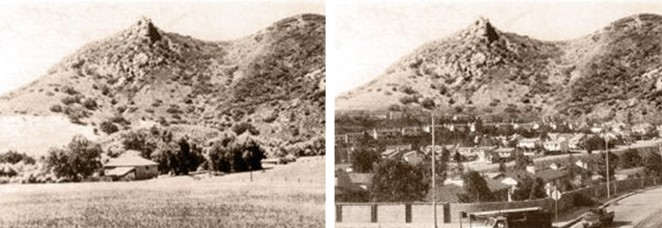 |
|
| (1947 vs 1992)* |
Historical Notes The Leonis barn was demolished by developers in the 1960's and the entire little valley filled in. In the late 1960s, the land, then a 1,700-acre cattle ranch, was purchased by Spruce Land and Boise Cascade, subdivided and named Woodland Hills Country Estates. One year later, the new subdivision of Bell Canyon went on the market and almost all of the 700 lots sold during the first weekend.*##* The remaining land, encompassing parts of present day West Hills and Woodland HIlls, was also quickly developed. |
Woodland Hills
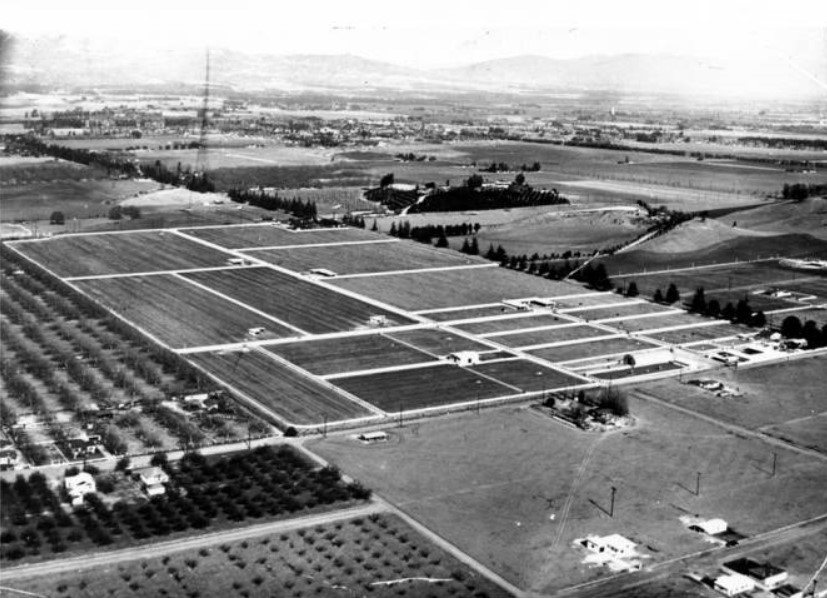 |
|
| (1949)#^ - Aerial view of Woodland Hills in 1949. The main street running perpendicular across the center is Shoup Avenue. In the center of the hills, covered with orange groves, is Mrs. Beachy's house. The bare trees to the right of her house is Topanga Canyon Boulevard. Beyond that are pepper trees along Canoga Avenue. |
 |
|
| (1949)* - Aerial view of Woodland Hills. Same as previous photo but annotated to show street names and landmarks. The upper center of the picture is the intersection of Oxnard and Shoup. Note the pepper trees along Canoga and the pine trees along Shoup. Mrs Beachy's (of Calabasas fame) house on the hill covered witih citrus, now The Summit; and the barren hill now Shoup Park. Annotated by Dean Fields |
Los Angeles River
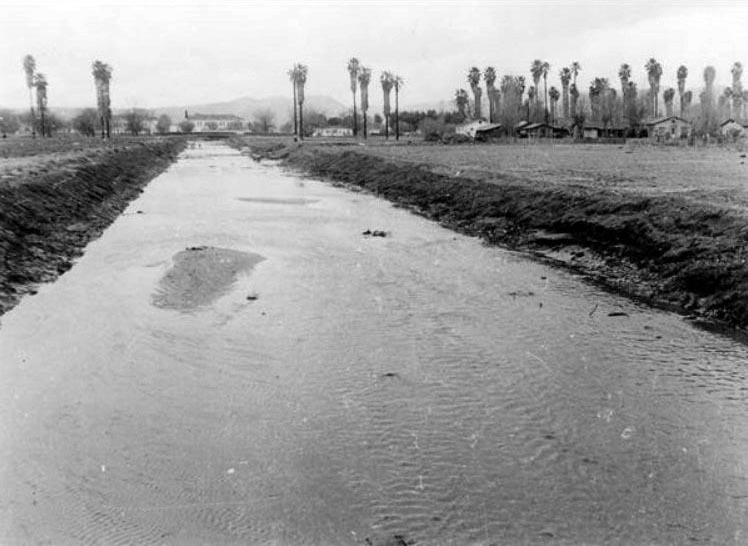 |
|
| (1943)#^ - L.A. River looking west from Canoga Ave. Bridge, January 24, 1943. There is a car barely visible upstream that had fallen in the river. |
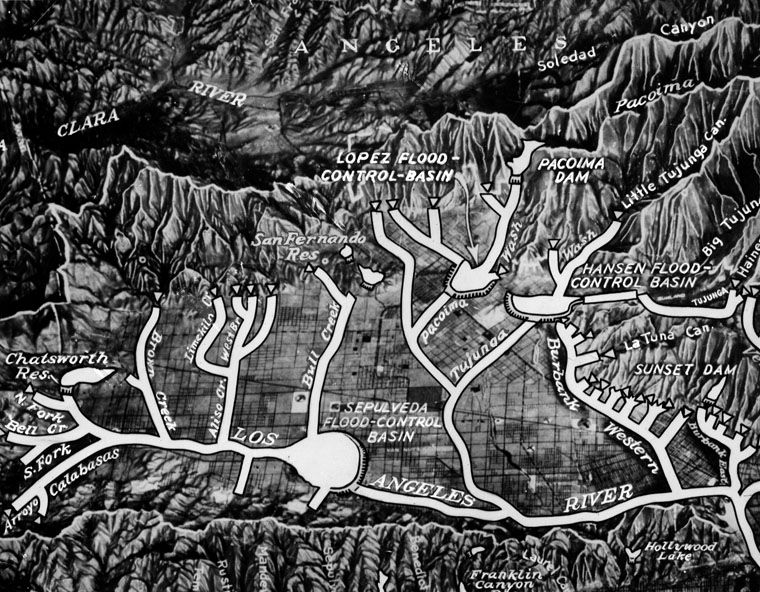 |
|
| (1949)* - Caption Reads: Compiled by the Corps of Engineers, U.S. Army, this map shows the network of channels and flood basins which will eventually control the rampages of Valley waterways. Many of the projects have already been completed or are now underway. |
Historical Notes Between February 27th and March 3rd, 1938 Los Angeles was inundated with two storm systems delivering record breaking rainfalls. By March 3rd, the San Gabriel Mountains received 32 inches of rain, more than their average yearly total, and Los Angeles received over 10 inches of rainfall over the 5-day storm. 115 people lost their lives, thousands more were evacuated, over 6000 homes were damaged or destroyed, and 108,000 acres - one third of Los Angeles - was flooded. The San Fernando Valley, Venice, Compton, and Long Beach were the worst hit. The Los Angeles River was completely warped - new inlets were carved by the rushing water and the channels in areas shifted, nearly as much as a mile. Total channelization of the river began a few months later. With funding from the Works Progress Administration and the federal government as a result of the Flood Control Act, contractors and construction crews worked around the clock under the supervision of the U.S. Army Corps of Engineers, lowering and widening the channel and cementing the banks and river bottom. By the end, 20 years later, contractors had moved "twenty million cubic yards of earth (roughly 800,000 dump truck loads worth).* |
Sepulveda Dam
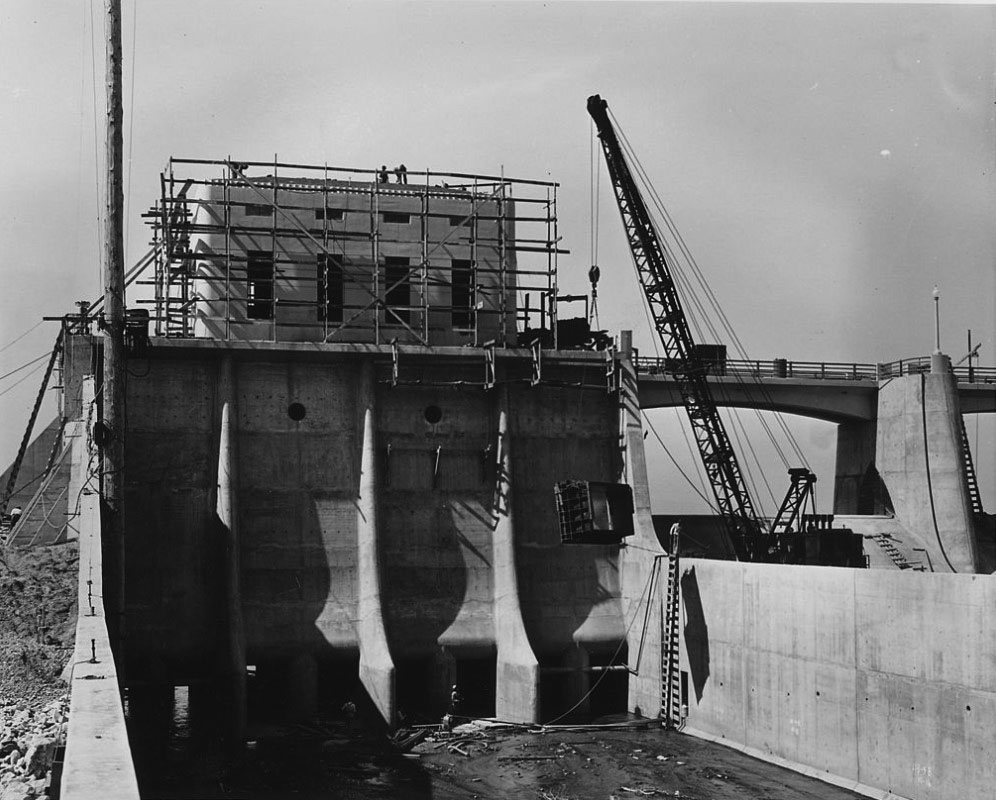 |
|
| (1941)*^ – Sepulveda Dam in the latter stages of construction, showing the outlet channel, control tower, and service bridge. |
Historical Notes After the great flood of 1938, the Army Corps of Engineers took the lead role in channelizing the river and constructing several dams which would create flood control basins behind them. Channelization began in 1938, and by 1960, the project was completed to form the present fifty-one mile engineered waterway. Included in this work were Hansen Dam, completed in 1940 and followed by Sepulveda Dam in 1941.*^ |
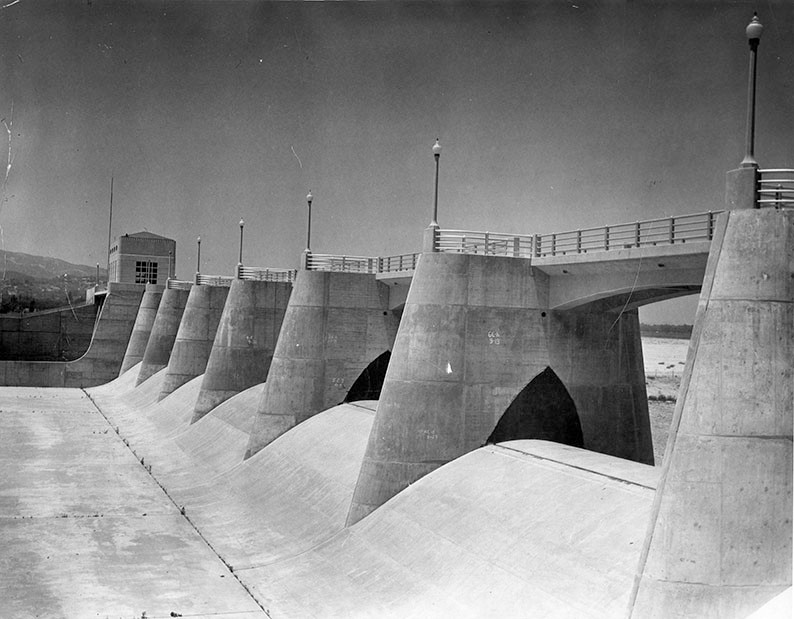 |
|
| (1948)* – View of the Sepulveda Dam located in the south-central part of the San Fernando Valley. The control tower can be seen in the background. |
Historical Notes For 28 years the Sepulveda Dam did its job without incident until 1969 when the Los Angeles River overflowed its banks causing millions of dollars in damage. In 1988 the Los Angeles River's banks were raised to avoid another incident. In 1994 a hundred-year flood occurred in the Los Angeles River. The dam was restored and went without incident for another 11 years until the Los Angeles River again overflowed its banks in 2005.*^ |
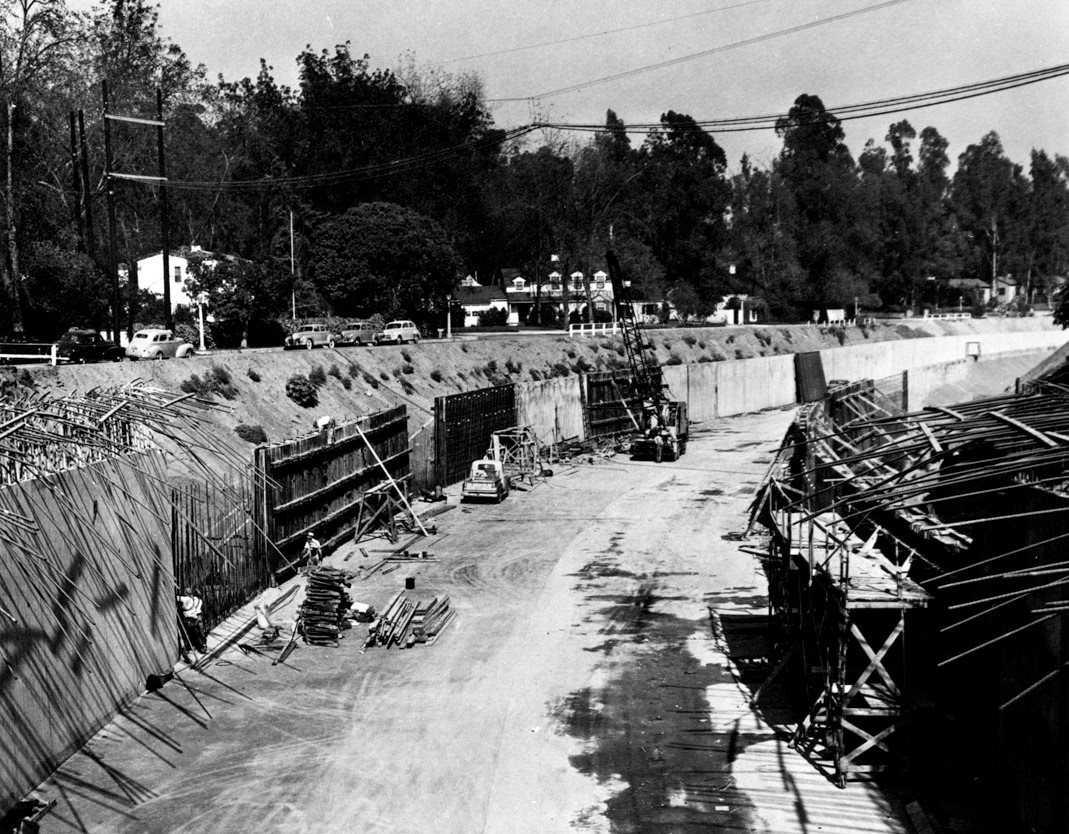 |
|
| (1949)* - View showing the construction of the channel walls in the Los Angeles River at Laurel Canyon. |
Historical Notes Since 1938, 278 miles of river and tributaries were retrofitted and more than 300 bridges were built. With the river encased in cement, the natural sharp turns were now straightened. Any evidence of vegetation was completely removed, allowing runoff from the San Gabriel Mountains to escape through the river and out of Long Beach at up to 45 miles-per-hour. Streets and sewers were connected to drains along the river, designed to quickly capture and move rainfall away from the surrounding streets.**^^ |
Ventura Boulevard (Sherman Oaks)
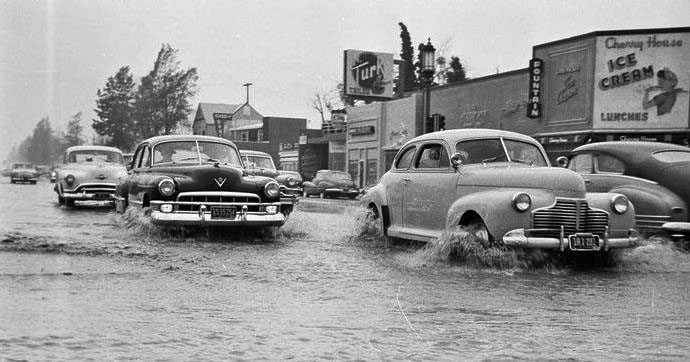 |
|
| (ca. 1952)^^^* - View of a flooded Ventura Boulevard at Woodman Avenue. The Cherry House Restaurant is seen on the southeast corner. |
Historical Notes To this day, despite the flood control channels, flooding still occurs in certain intersections of the San Fernando Valley especially after heavy rains. |
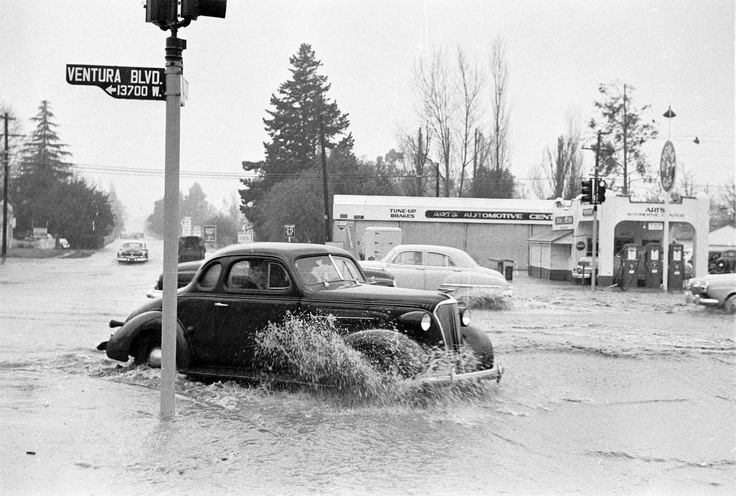 |
|
| (1952)*^^^^ - Heavy rain caused flooding at the intersection of Ventura Boulevard and Woodman Avenue. A Signal Gas Station is on the northeast corner. |
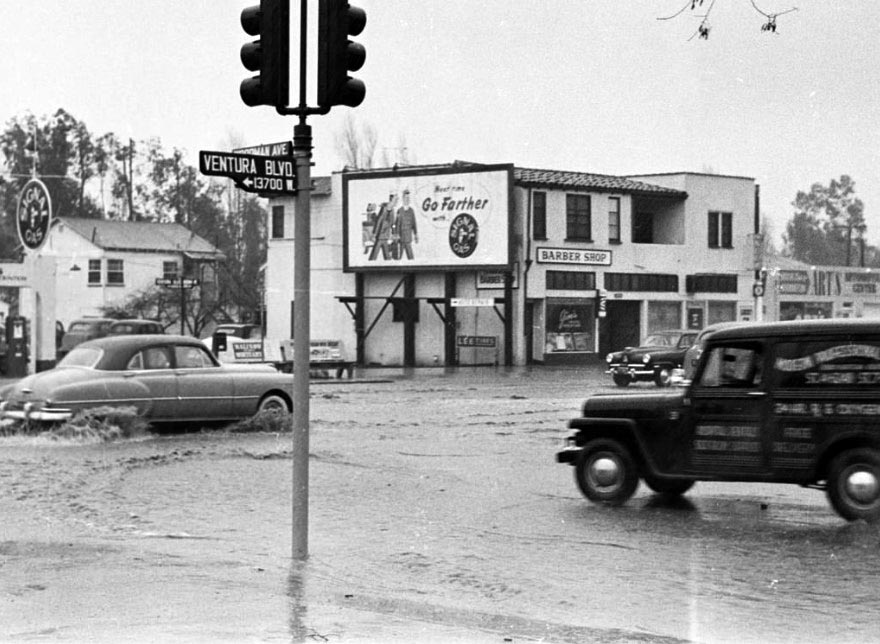 |
|
| (1952^– View looking northeast showing a flooded intersection at Ventura Boulevard and Woodman Avenue in Sherman Oaks. A Signal Gas Station is on the left (N/E corner) and a barber shop is seen on the right. |
Viking Ski Shop
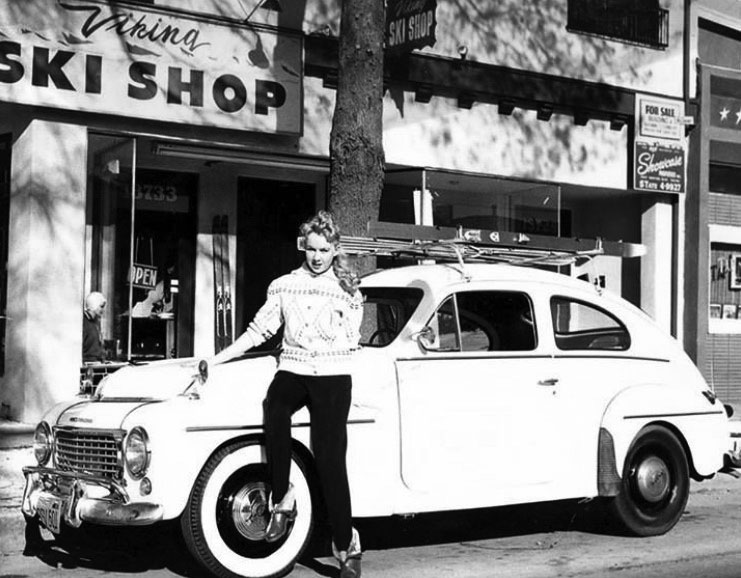 |
|
| (ca. 1950s)^ - Harold Larson's Viking Ski Shop at 13733 Ventura Boulevard in Sherman Oaks complete with a vintage Volvo (B 544). The shop had a large wooden ski ramp on the corner of Ventura Boulevard and Mammoth Avenue. Photo courtesy of Priscilla Shipstad |
Historical Notes In the 1950s, Valley residents who wanted to learn to ski might have considered Harold Larson's Viking Ski Center at 13733 Ventura Boulevard in Sherman Oaks. |
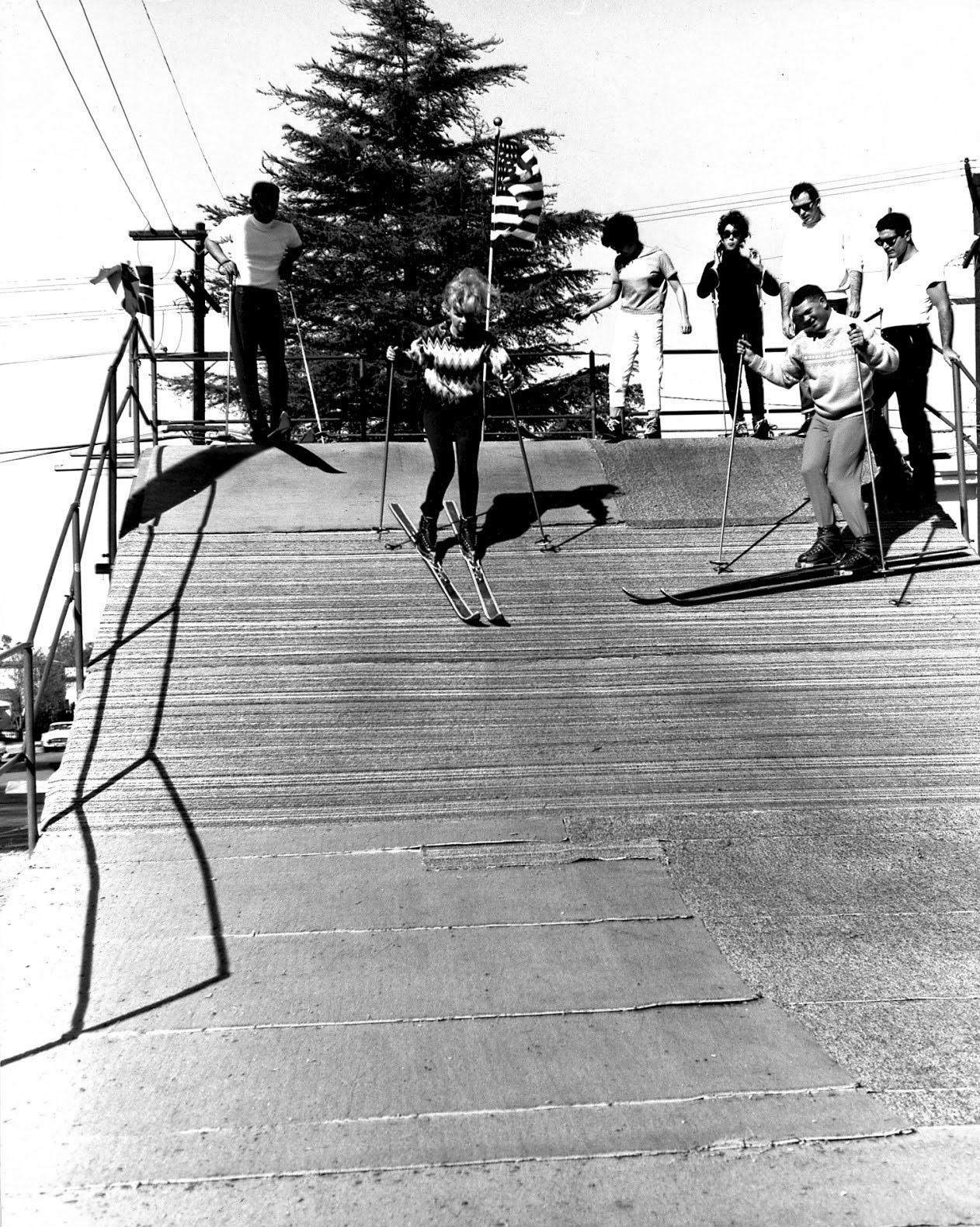 |
|
| (ca. 1950s)^ – View showing the large wooden ski ramp at the Viking Ski Shop on the NE corner of Ventura Boulevard and Mammoth Avenue in Sherman Oaks. Photo courtesy of Priscilla Shipstad |
* * * * * |
Ventura Boulevard (Studio City)
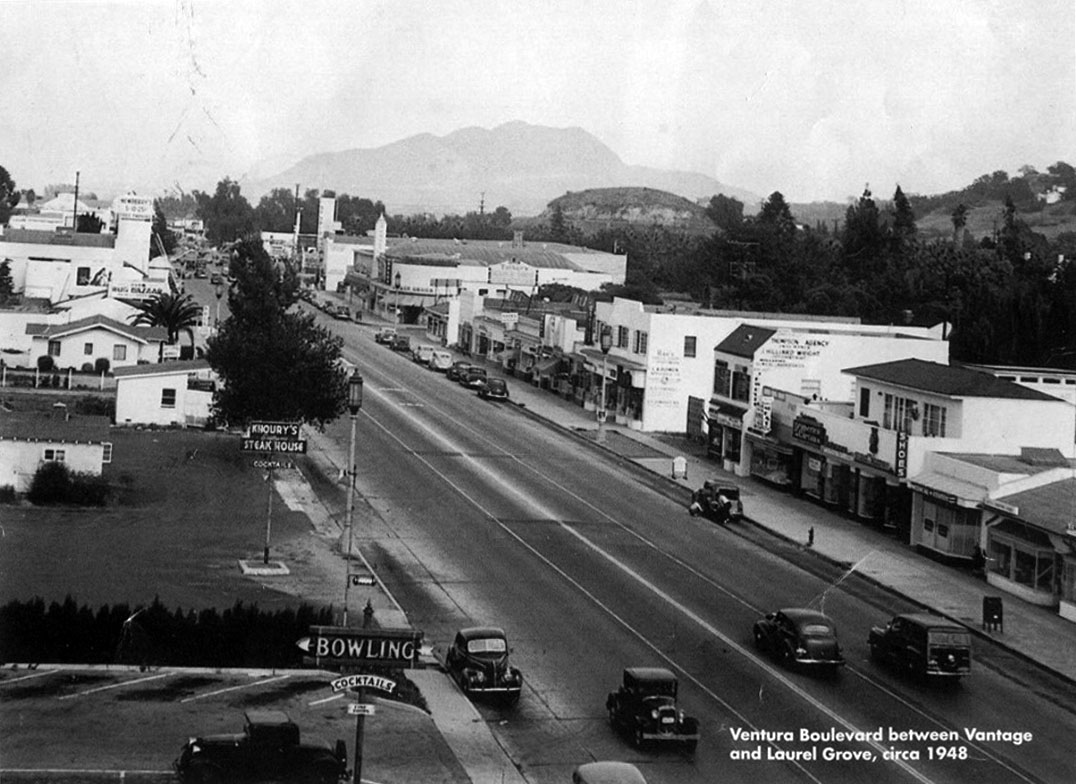 |
|
| (ca. 1948)* – View looking east on Ventura Boulevard from near Laurelgrove Avenue toward Vantage Avenue (12200 blk of Ventura). The Hollywood Hills behind Universal City can be seen in the background. At lower-left is the Panorama Bowl (out of view). |
Historical Notes The above photo was taken from atop the next-door ferris wheel at Kiddyland. |
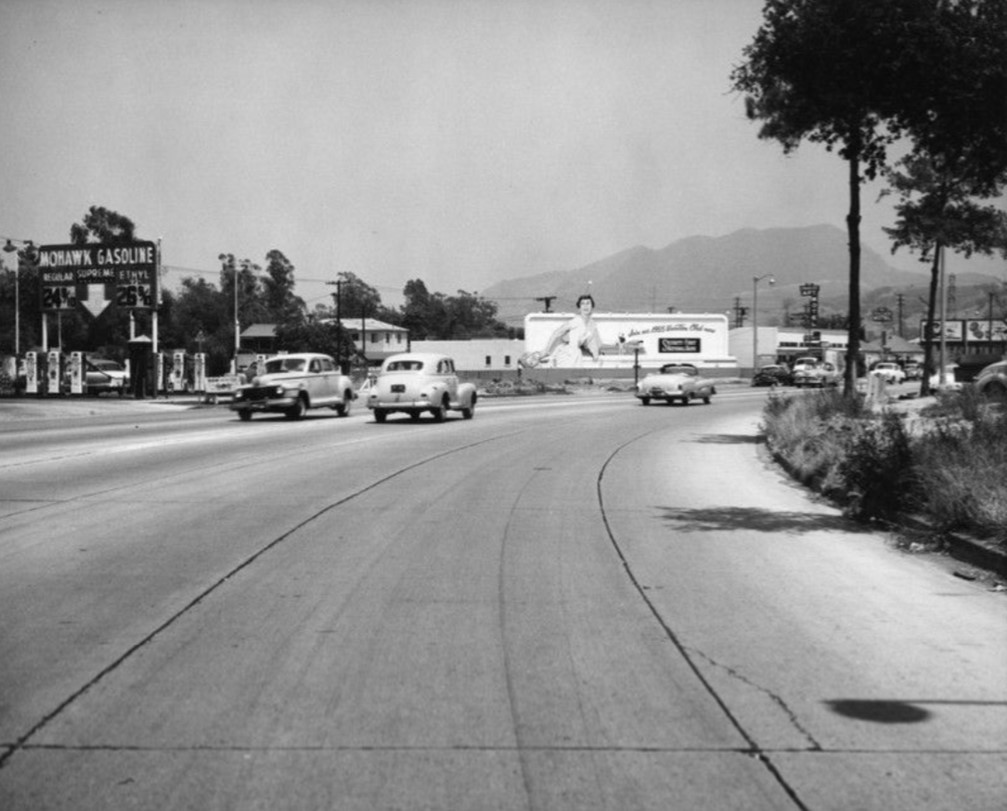 |
|
| (1954)* - Looking NE on Ventura Boulevard at Arch Drive in Studio City with the Hollywood Hills behind Universal Studios in the distance. A Mohawk Gasoline station is seen at left. Note the gas prices: 24¢ and 26¢ per gallon! |
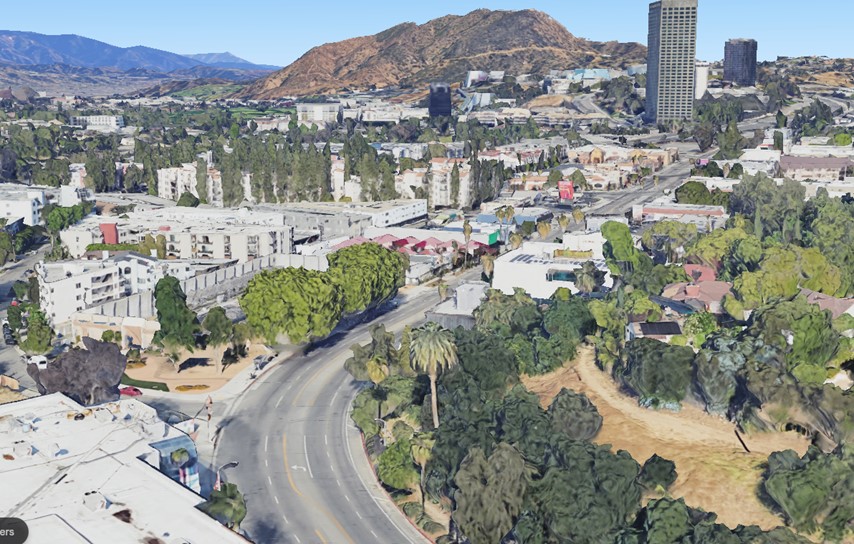 |
|
| (2022)* - Aerial view above Ventura Boulevard and Arch Drive with Universal Studios and the Hollywood Hills in the background. |
Then and Now
.jpg) |
|
| (1954 vs 2022)* - Aerial view above Ventura Boulevard and Arch Drive with Universal Studios and the Hollywood Hills in the background. |
Then and Now
.jpg) |
|
| Then and Now * - Looking NE on Ventura Boulevard at Arch Drive in Studio City with the Hollywood Hills behind Universal Studios in the distance. Photo comparison by Trey Callaway |
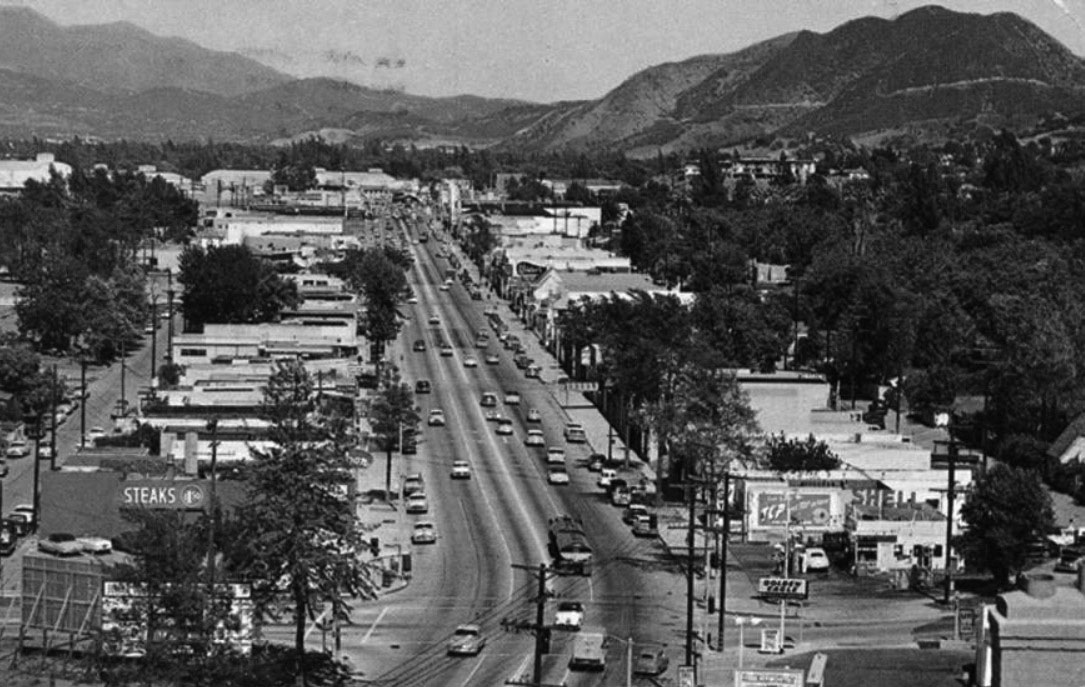 |
|
| (1950s)^ – Postcard view showing Ventura Boulevard as it runs through Studio City in the San Fernando Valley. |
Historical Notes Thanks to its geographic location and its proximity to entertainment industry businesses, Studio City has served as the home for eclectic restaurants and nightclubs providing a variety of amusement and atmosphere. Several film industry professionals operated their own niteries, such as screen villain Jack La Rue and Academy Award winning cinematographer James Wong Howe. Others featured eclectic decoration or strong celebrity clientele. Some venues hosted variety performers entertaining guests, such as clubs at 11502 Ventura Blvd. and 12449 Ventura Blvd.* |
Ventura and Laurel Canyon
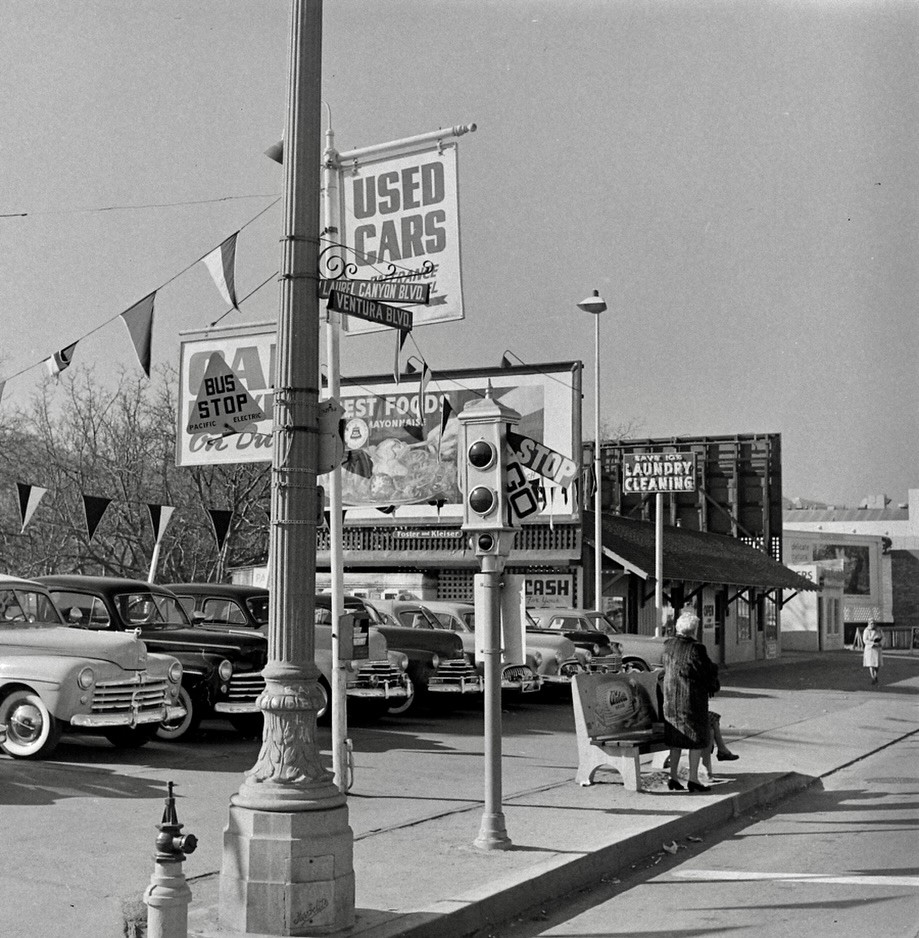 |
|
| (1948)* - Looking at the southwest corner of Ventura and Laurel Canyon boulevards in Studio City showing a semaphore traffic signal next to a bus stop. Today a CVS Pharmacy stands at the corner. In the distance on the right can be seen the roofline of the Studio City Theatre. |
Historical Notes The semaphore traffic signals used in Los Angeles in the 1920s - 1940s were manufactured by the Acme Traffic Signal Company. These signals had "Stop" and "Go" semaphore arms that would pop up, along with small red and green lights and bells that would ring to indicate the change in signal. The semaphore signals had a third, smaller yellow light at the bottom that would flash to indicate caution. Acme semaphores were used in Valley until the mid-1950s, when they were replaced by the standard three-light traffic signals we see today. Click HERE to see more Early Los Angeles Semaphores. |
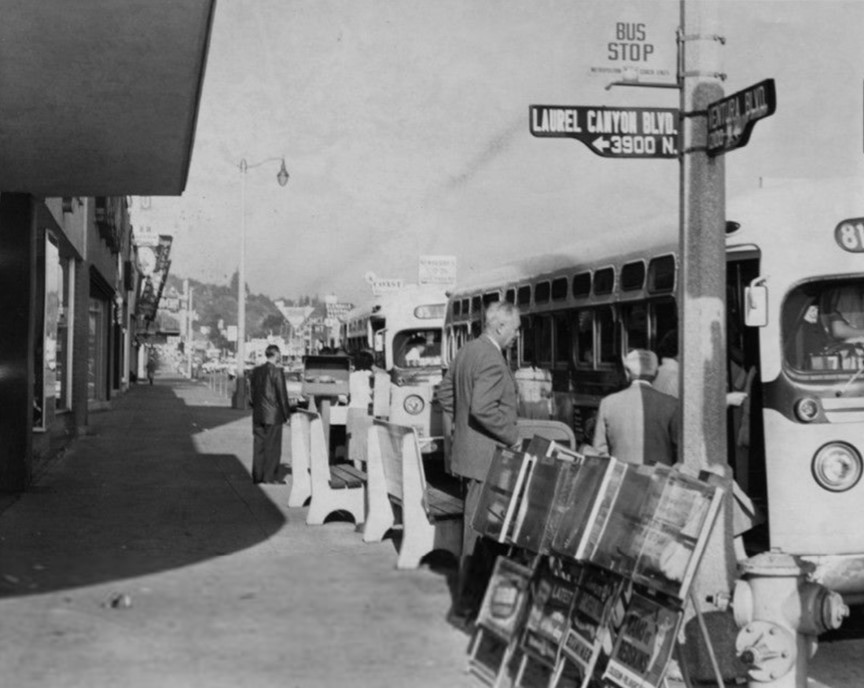 |
|
| (1959)* - Photograph caption dated August 26, 1959 reads, "Anniversary of Freeway Flyer. West Valley Freeway Flyer, which whisks commuters from Reseda to Los Angeles in 45 minutes in morning, depending on traffic, and back again in afternoon, celebrates first anniversary of service tomorrow. At left, Flyer picks up passengers at Ventura Boulevard and Laurel Canyon in Studio City before speeding non-stop to Los Angeles where it drops riders at Temple and Hope streets. In year, MTA has tripled services on route." |
Historical Notes The West Valley Freeway Flyer service began in 1959 as part of efforts by the Los Angeles Metropolitan Transit Authority (MTA) to provide faster and more efficient commuter bus service. The Freeway Flyer service promised to "melt miles and minutes off the map" by using the newly constructed freeways to bypass traffic congestion on surface streets. In the early years, the Freeway Flyer service started with just 4 buses per day from the San Fernando Valley, but quickly grew to 15 buses per day as ridership increased. The MTA found that wherever they established Freeway Flyer express and limited-stop service, ridership increased significantly, with one line seeing a 39% increase and another 32%. This early success with the Freeway Flyer concept encouraged the MTA that a modern, fast mass transit system could attract many drivers to leave their cars at home and ride the buses instead.* |
 |
|
| (1954)* – Looking east on Ventura Boulevard and Laurel Canyon Boulevard. Du-par's Restaurant is visible in the distance. |
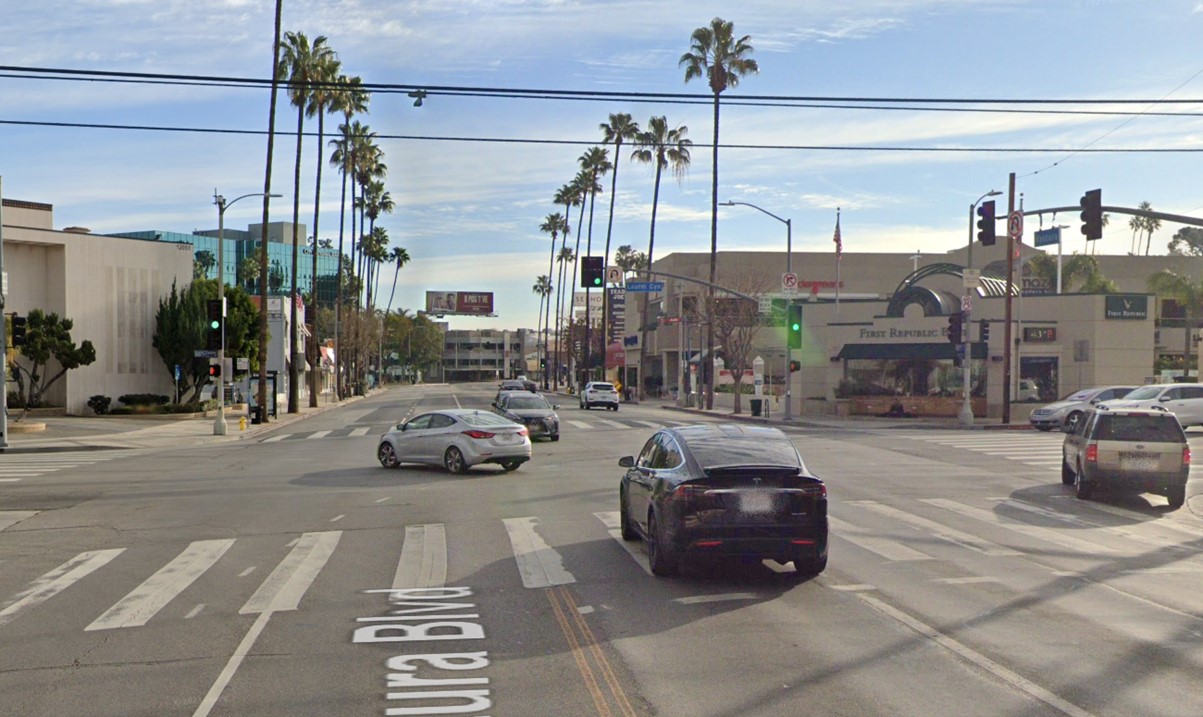 |
|
| (2021)* - Looking east on Ventura Boulevard and Laurel Canyon Boulevard. |
Then and Now
.jpg) |
|
| Then and Now - Looking east on Ventura Boulevard and Laurel Canyon Boulevard. Photo comparison by Trey Callaway |
Tower Motor Hotel
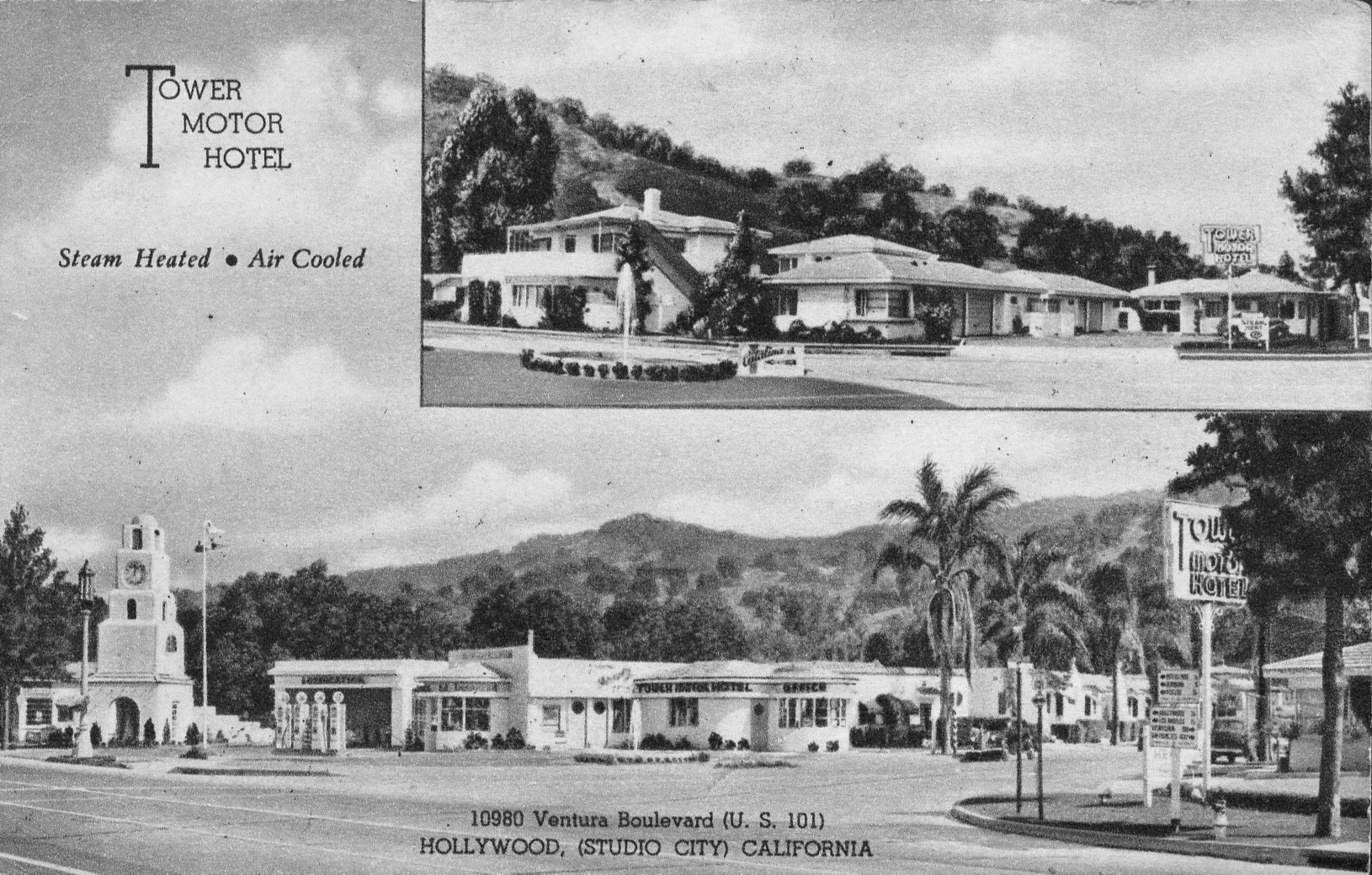 |
|
| (ca. 1948)* - Postcard view showing the Tower Motor Hotel at 10980 Ventura Boulevard in Studio City - Steam Heater & Air Colled. |
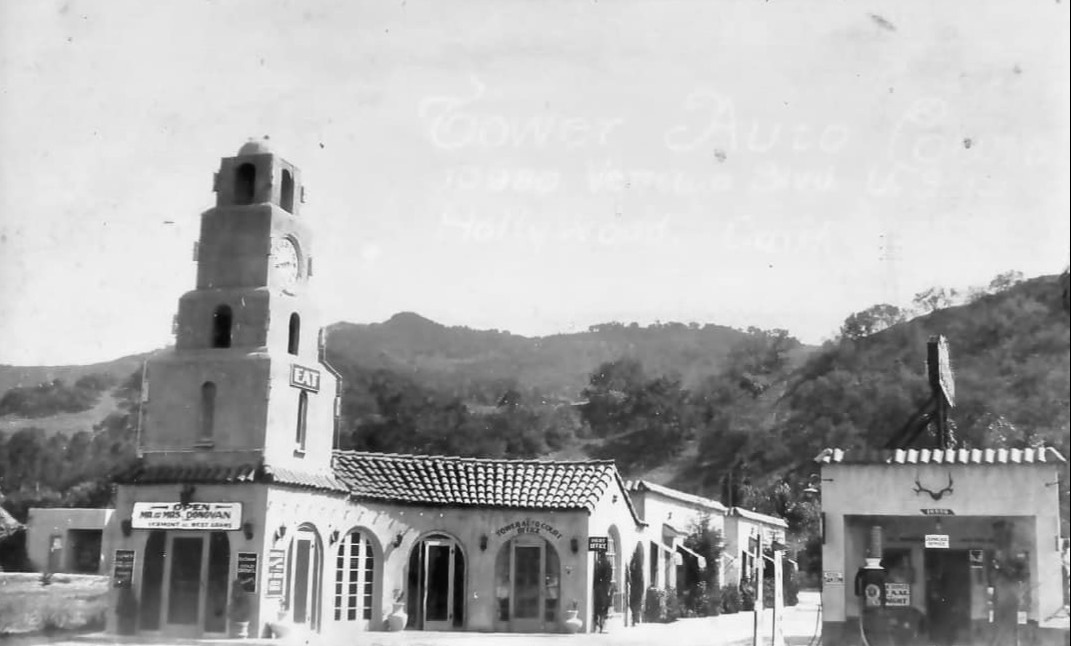 |
|
| (]1940s)* - Close-up view of the Tower Motor Hotel and adjacent gas station near the SE corner of Ventura and Vinaland, Studio City |
Topper Motel
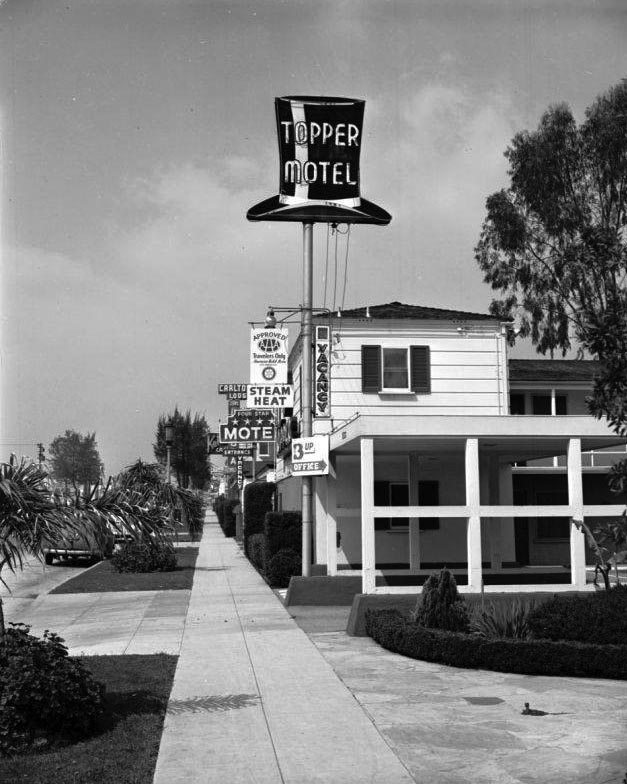 |
|
| (1950)^^- View showing the Topper Motel on the north side of Ventura Boulevard, west of Colfax Avenue. Part of the Carlton Motor Lodge, 11811 Ventura Blvd, can be seen behind the Topper. Click HERE for contemporary view. |
Du-par's Restaurant (Studio City)
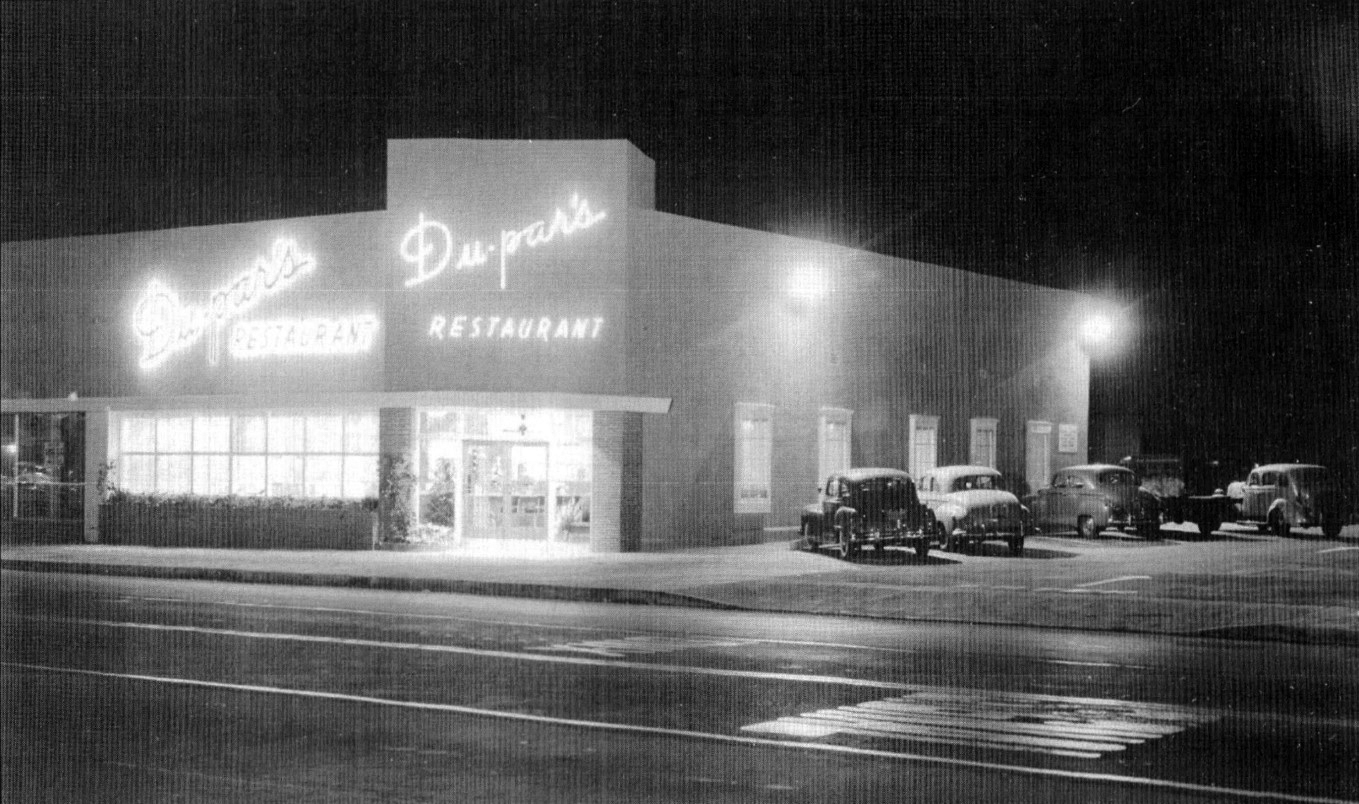 |
|
| (ca. 1948)* – View showing Du-par’s Restaurant located at 12036 Ventura Boulevard, Studio City. |
Historical Notes The longtime diner opened the Studio City location in 1948. This expansion was the first after Du-par's debuted at the Original Farmer's market in 1938. |
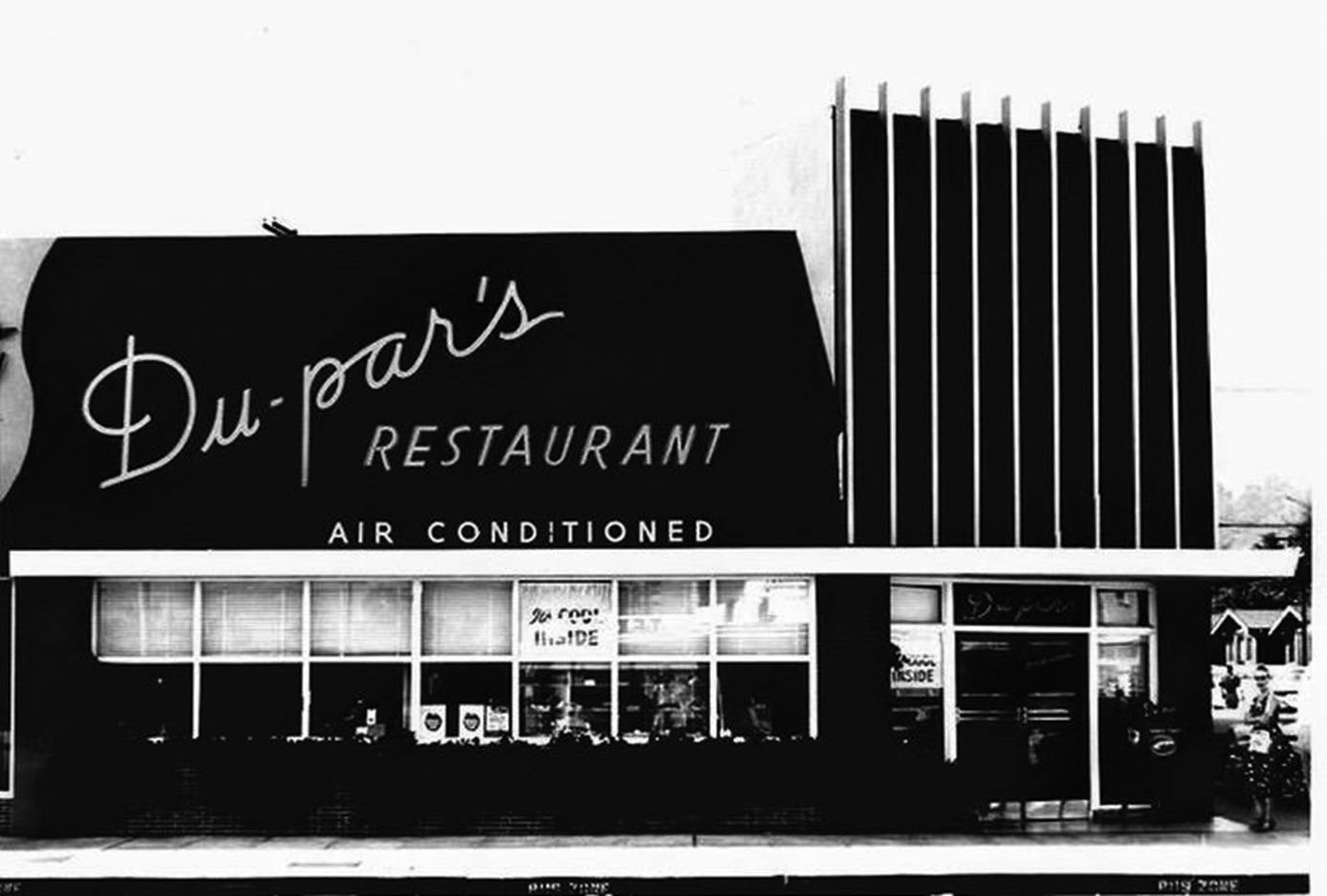 |
|
| (1950s)* – A woman stands by the entrance to to Du-Pars Restaurant in Studio City. Photo courtesy of Richard Levenson |
Historical Notes The first Du-par's was founded in 1938 at the Los Angeles Farmers Market by James Dunn and Edward Parsons, who combined their surnames to create the restaurant's name. The chain was purchased in 2004 by an investor group led by W.W. "Biff" Naylor, the son of noted California restaurateur Tiny Naylor. Du-par's expanded in 2009 to include several locations from the bankrupt Bakers Square chain.^ |
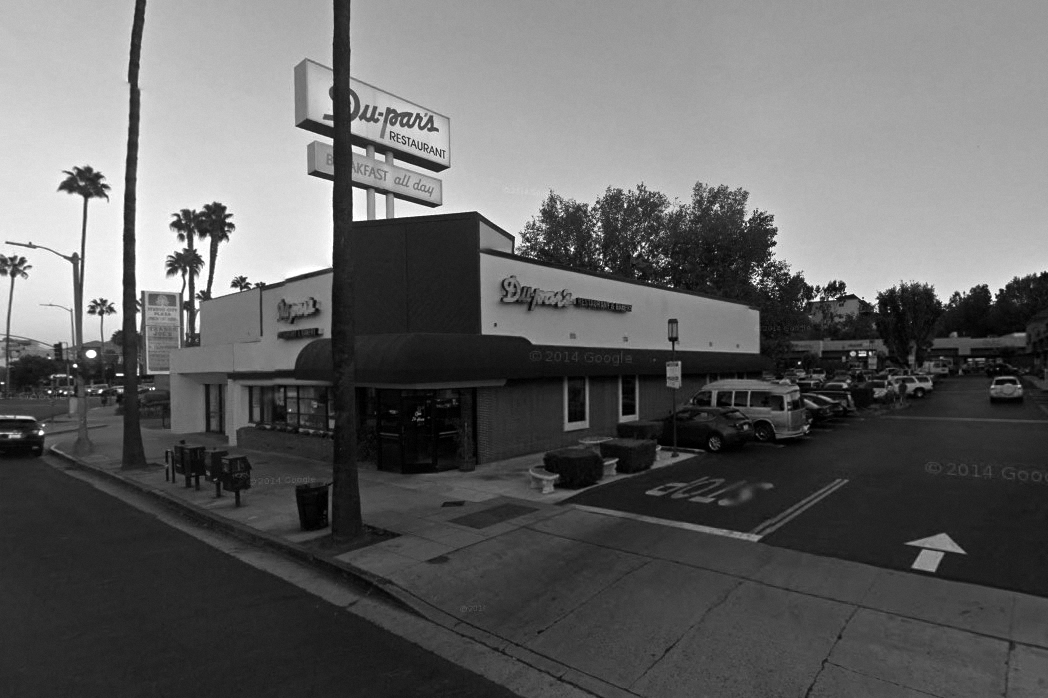 |
|
| (2014) - Google street view showing Du-par's Restaurant in Studio City, "Breakfast all day". |
Historical Notes The Studio City location closed its doors for good on December 31, 2017. The building is currently (2019) occupied by Sephora. Click HERE for contemporary view. |
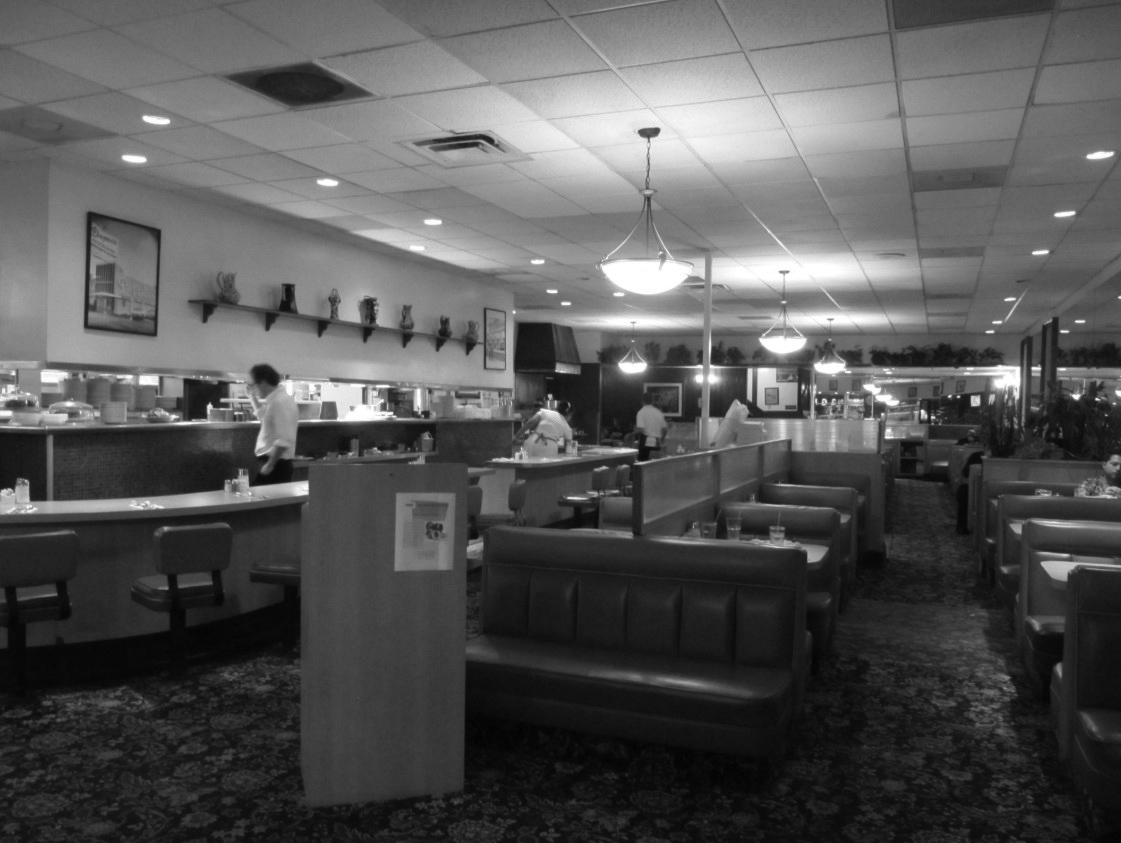 |
|
| (2011)^ - Interior view of Du-par’s Restaurant in Studio City. |
Then and Now (Closed 12-31-17)
 |
.jpg) |
|
| (ca. 1948) - Du-par's Restaurant at 12036 Ventura Boulevard, Studio City. | (2014) - Du-par's Restaurant at 12036 Ventura Boulevard, Studio City. |
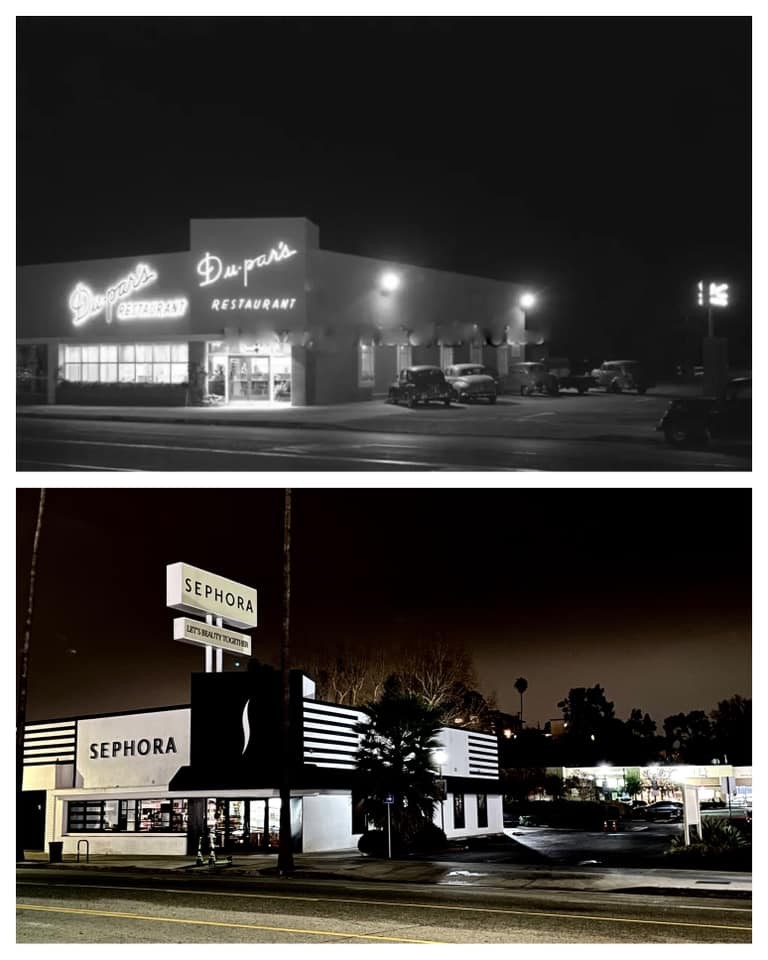 |
|
| Then and Now: Du-par's / Sephora. Photo comparison by Trey Callaway |
Zomba Café (later Oil Can Harry's)
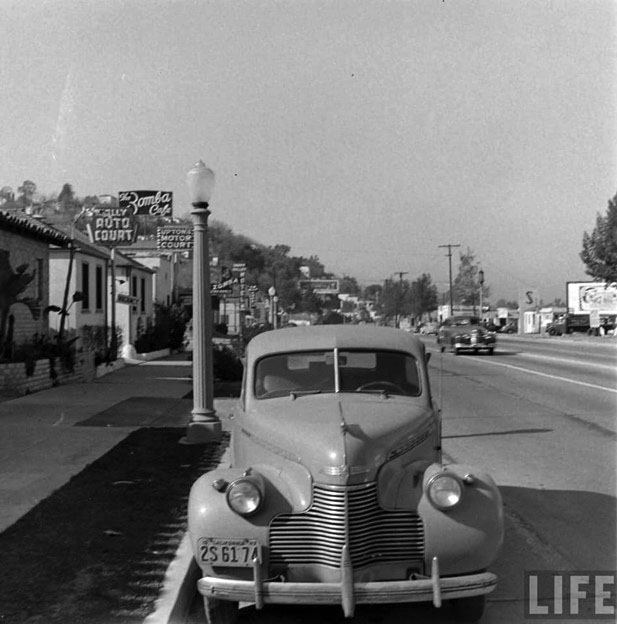 |
|
| (1940s)* – View looking west on the 11400 block of Ventura Boulevard in Studio City. On the left can be seen an Auto Court, Uptown Motor Court and the Zomba Café (11502 Ventura Blvd) on the SW corner of Ventura Blvd and Berry Drive. |
Historical Notes 11502 Ventura Blvd. has hosted a revolving clientele of clubs since at least 1936, when Rex’s White Cabin operated at the location. The Everglades premiered at the location in December 1939, featuring singing star Beth Williams, accompanied by Harry Powell and his Gladesmen, per the December 7, 1939 Van Nuys Valley News. The club offered dinner and dancing, and such special cuisine as Chicken a la Maryland. The Zomba Café proffered colorful entertainment to men looking for a little excitement, opening in 1941. A blurb in the September 5, 1942 issue of Variety stated, “Unusual atmosphere at the Zomba Cafe, 11502 Ventura Blvd. Radio’s Jimmy Jackson greets you with song. Also orchestra leader Eugene Jackson (formerly of Our Gang Comedies) gives you “a bit of Africa.” (Jackson played Farina’s older brother, “Pineapple,” in Our Gang Comedies).* |
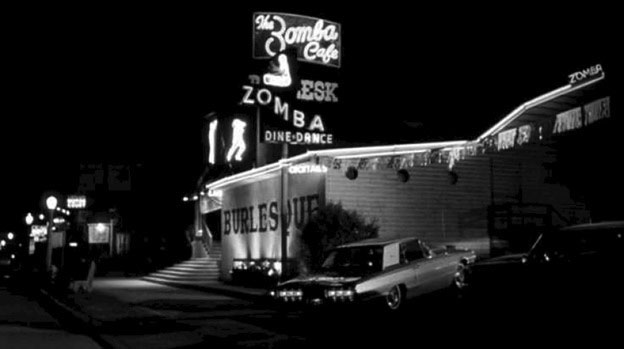 |
|
| (1950s)* – Zomba Café located at 11502 Ventura Boulevard in Studio City. This would become Oil Can Harry’s in the 1960s. |
Historical Notes Zomba operated mostly as an upscale burlesque club for men looking for an “afternoon delight,” with B-girls performing on raised and separate platforms as well as in choreographed numbers, per the American Guild of Variety Artists yearbook. Comedians acted as emcees, trying to inject some humor and energy into proceedings, especially between acts. Atmosphere and decorations carried an African and safari theme, suggesting exotic pleasures.* |
Oil Can Harry's (Originall Zomba Café - Studio City)
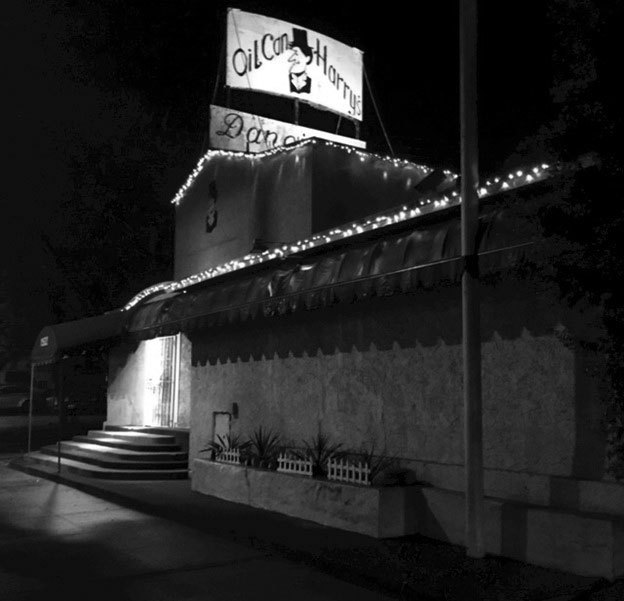 |
|
| (n.d.)* - Oil Can Harry's on the SW corner of Ventura and Berry Drive, 11502 Ventura Boulevard in Studio City. The building was occupied by the Zomba Café between 1941 and 1968. |
Historical Notes Sometime in 1968 the Zomba Café closed, replaced by current tenant, the gay cowboy bar, Oil Can Harry’s (closed in 2021). |
* * * * * |
Bob's Good Earth Real Estate (Encino)
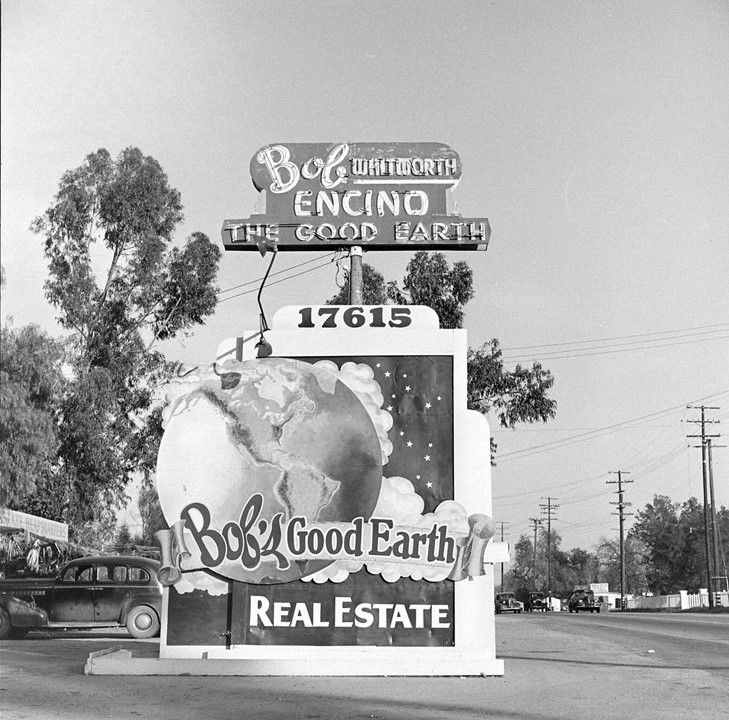 |
|
| (1940s)* – Bob’s Good Earth Real Estate located at 17615 Ventura Boulevard in Encino. |
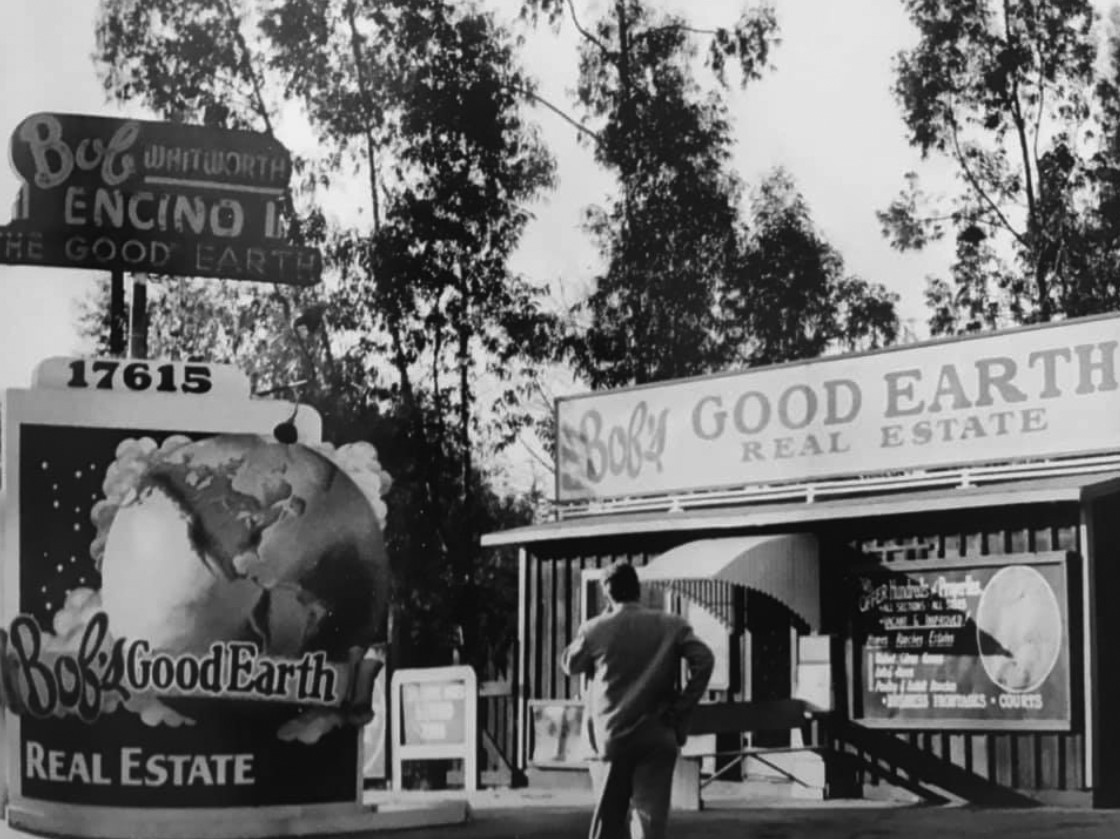 |
|
| (1946)^ – A man is seen standing in front of Bob’s Good Earth Real Estate Office located at 17615 Ventura Boulevard in Encino. Today, a strip mall is located at this site. Click HERE for contemporary view. |
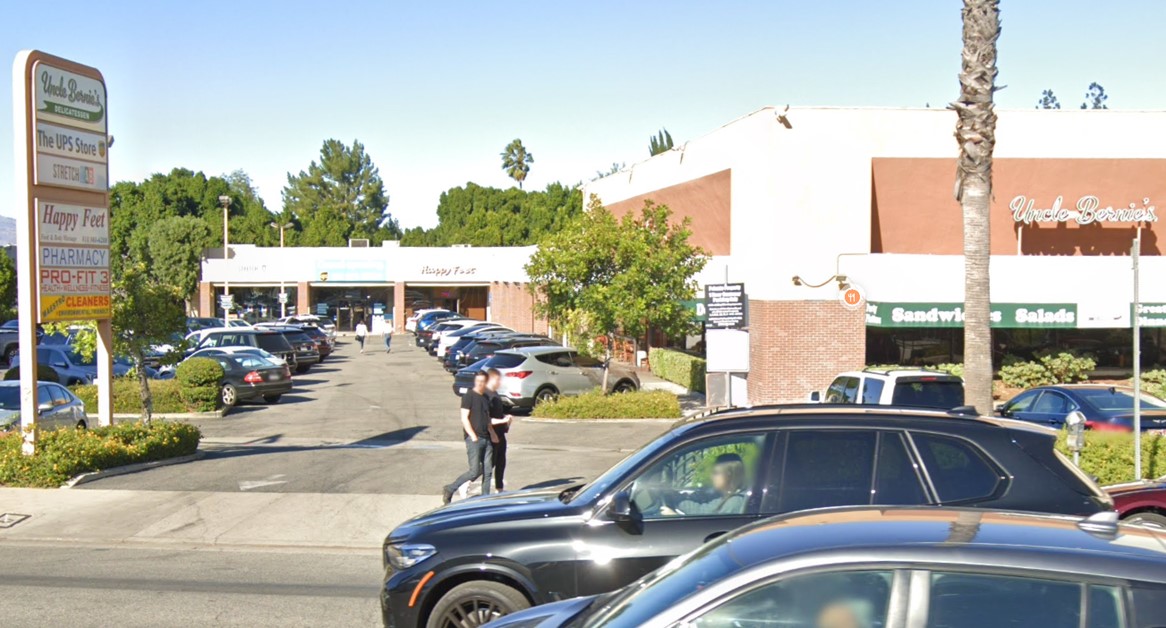 |
|
| (2023)* - Looking north into a strip mall where Bob's Good Earth Real Estate office once stood. |
Then and Now
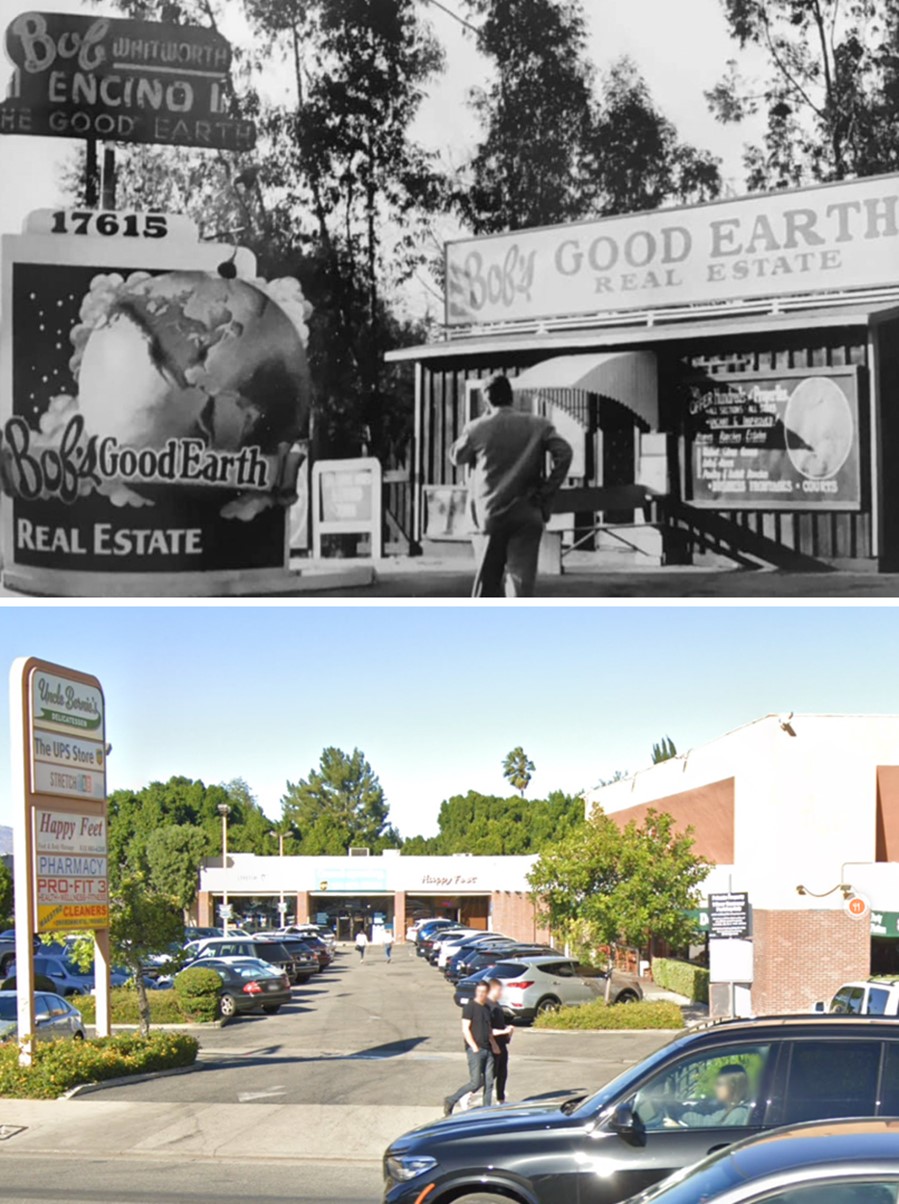 |
|
| (1946 vs 2023)* - Looking the office of Bob's Good Earth Real Estate, current location of a strip mall. |
* * * * * |
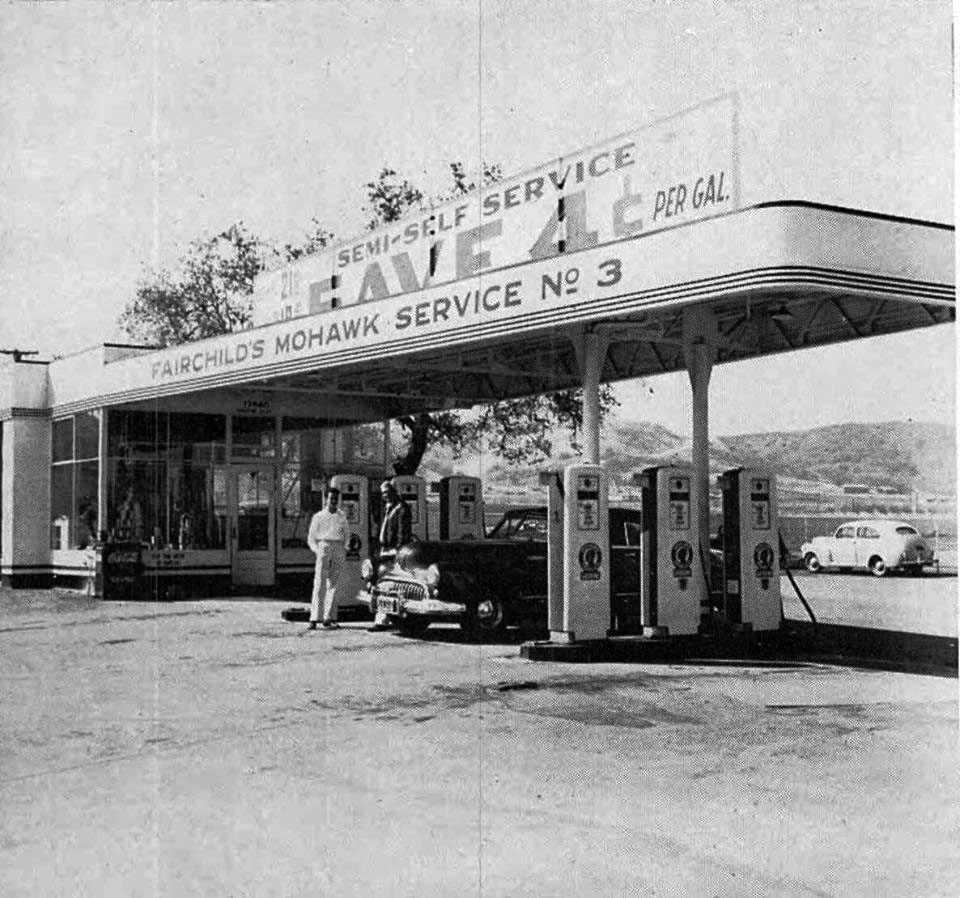 |
|
| (1948)* - View showing Fairchild’s Mohawk service station located at 17660 Ventura Blvd (at White Oak) in Encino. Actually, it is a "semi-self service" station, where you save 4 cents per gallon by pumping your own gas. Here we see customer Stanley Kalmonivitz with Mr. Fairchild. Click HERE to see more Early Views of LA Gas Stations. |
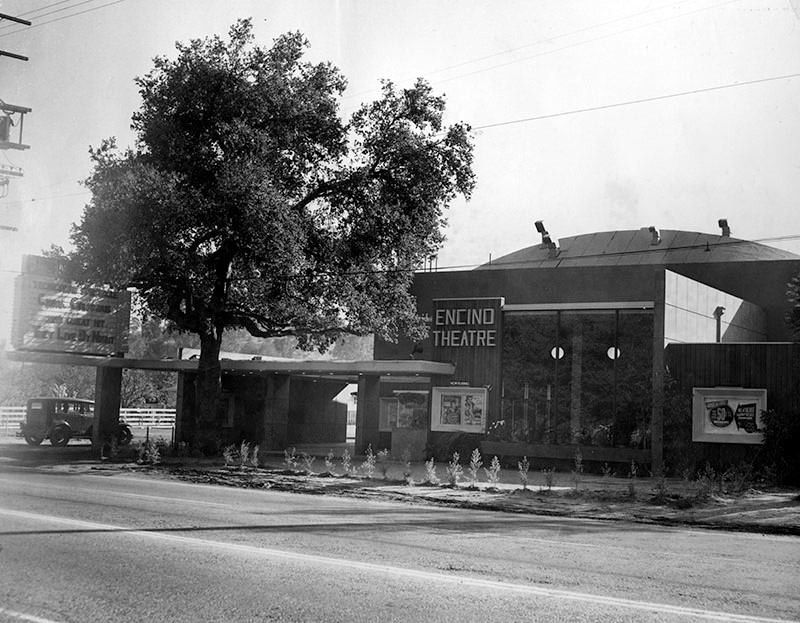 |
|
| (1949)* – View showing the newly built Encino Theatre with large oak tree by the front entrance, located on the south side of Ventura Boulevard east of Leoline Avenue. |
Historical Notes The Encino film Theatre opened in August 10, 1949 and was located at 16342 Ventura Blvd. The theater featured two hours of entertainment nightly; a feature, a short and a newsreel at one admission price. The theater held 1,000 seats which were staggered to provide clear views from every chair. The bottom half of the marquee is advertising the 1948 film noir, "They Live by Night." *^^^ |
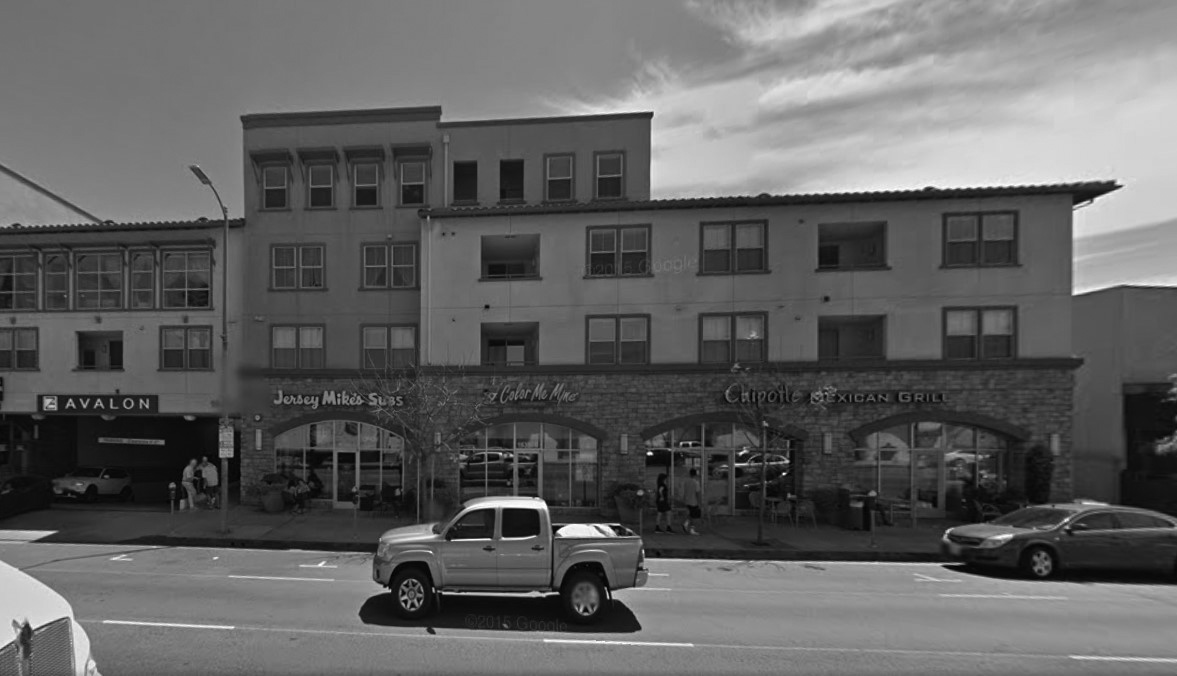 |
|
| (2015)#*^# - Google street view showing the mixed-use housing complex located at the site of the old Encino Theatre, 16340 Ventura Boulevard. |
Love's Wood Pit Barbecue
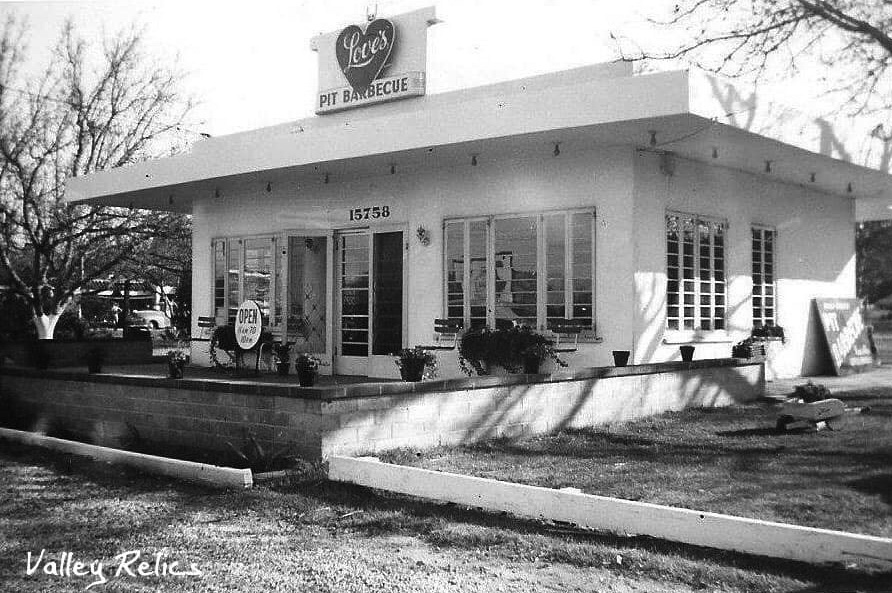 |
|
| (ca. 1950)^.^ – View showing the original Love’s Wood Pit Barbecue located at 15758 Ventura Boulevard, Encino. Their jingle was “When You’re in Loves...The Whole World's Delicious. |
Historical Notes Love's Wood Pit BBQs were a chain of barbeque restaurants, known for their delicious BBQ sauce, tender meat and smokey wood pit flavour that were located primarily on the West Coast of the US in the late '60s and early '70s. |
Ventura Boulevard (Woodland Hills)
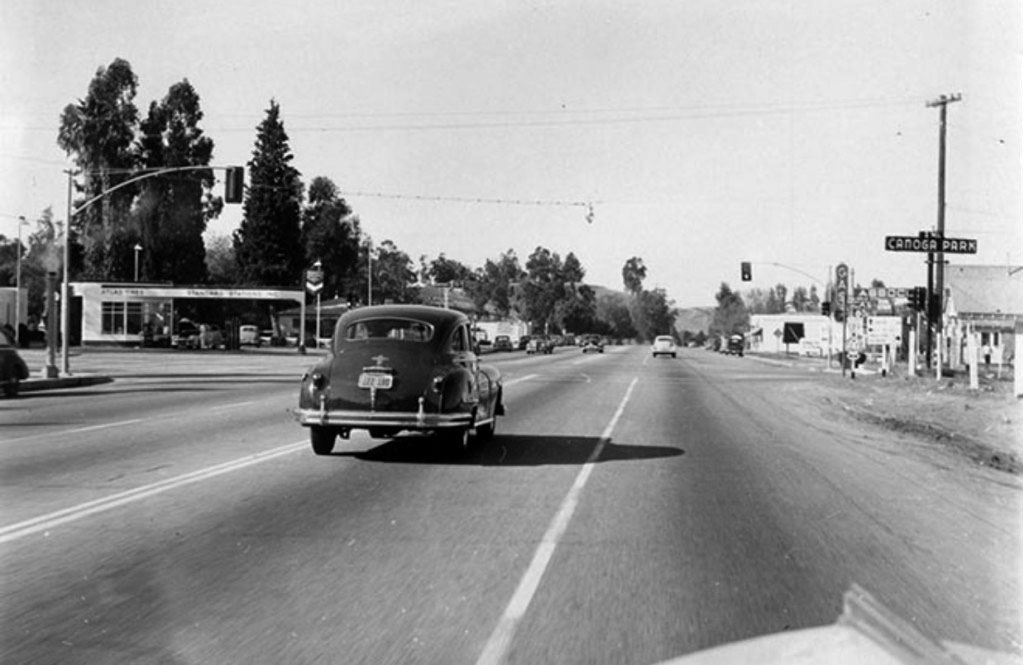 |
|
| (1949)^ – View looking west on Ventura Boulevard toward Topanga Canyon Boulevard in Woodland Hills. Sign on the northeast corner (at right) reads 2 miles to Canoga Park (if you turn right on Topanga Cyn). On the southwest corner can be seen a Standard Gas Station and on northwest corner an Associated Gas Station. Click HERE to see contemporary view. |
Historical Notes This photo was originally identified as being in Canoga Park because of the large sign seen on the corner. But if you look underneath the "Canoga Park" sign there is an arrow pointing right (north) on Topanga Cyn. Blvd. |
Then and Now
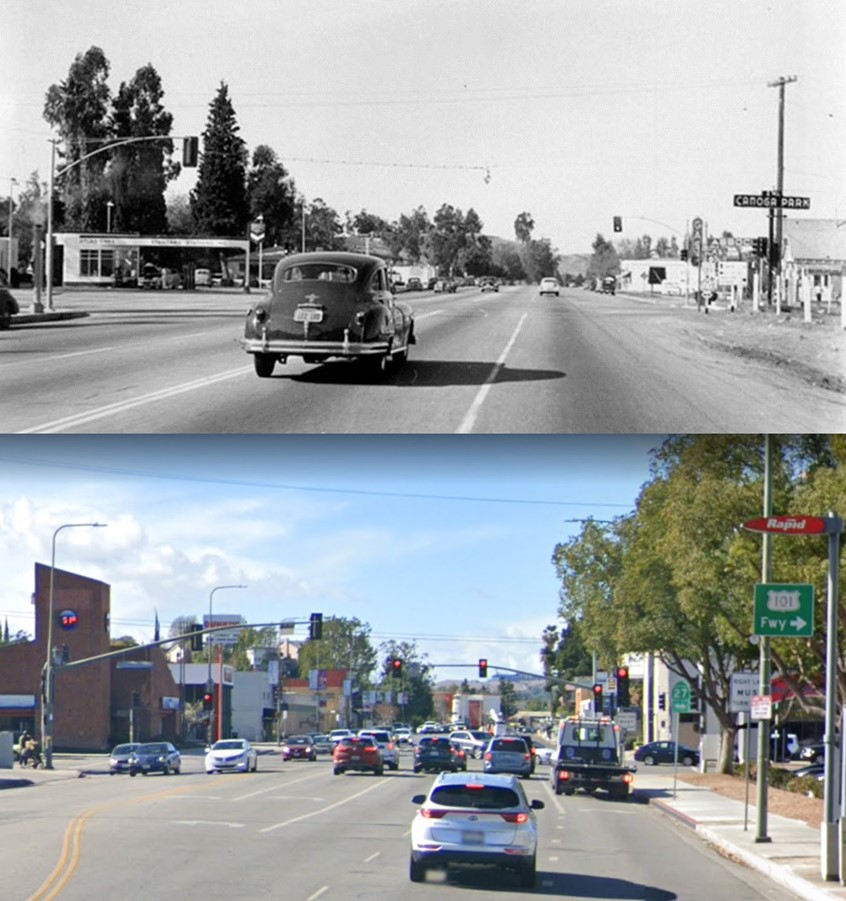 |
|
| (1949 vs. 2021)* – View looking west on Ventura Boulevard toward Topanga Canyon Boulevard in Woodland Hills. |
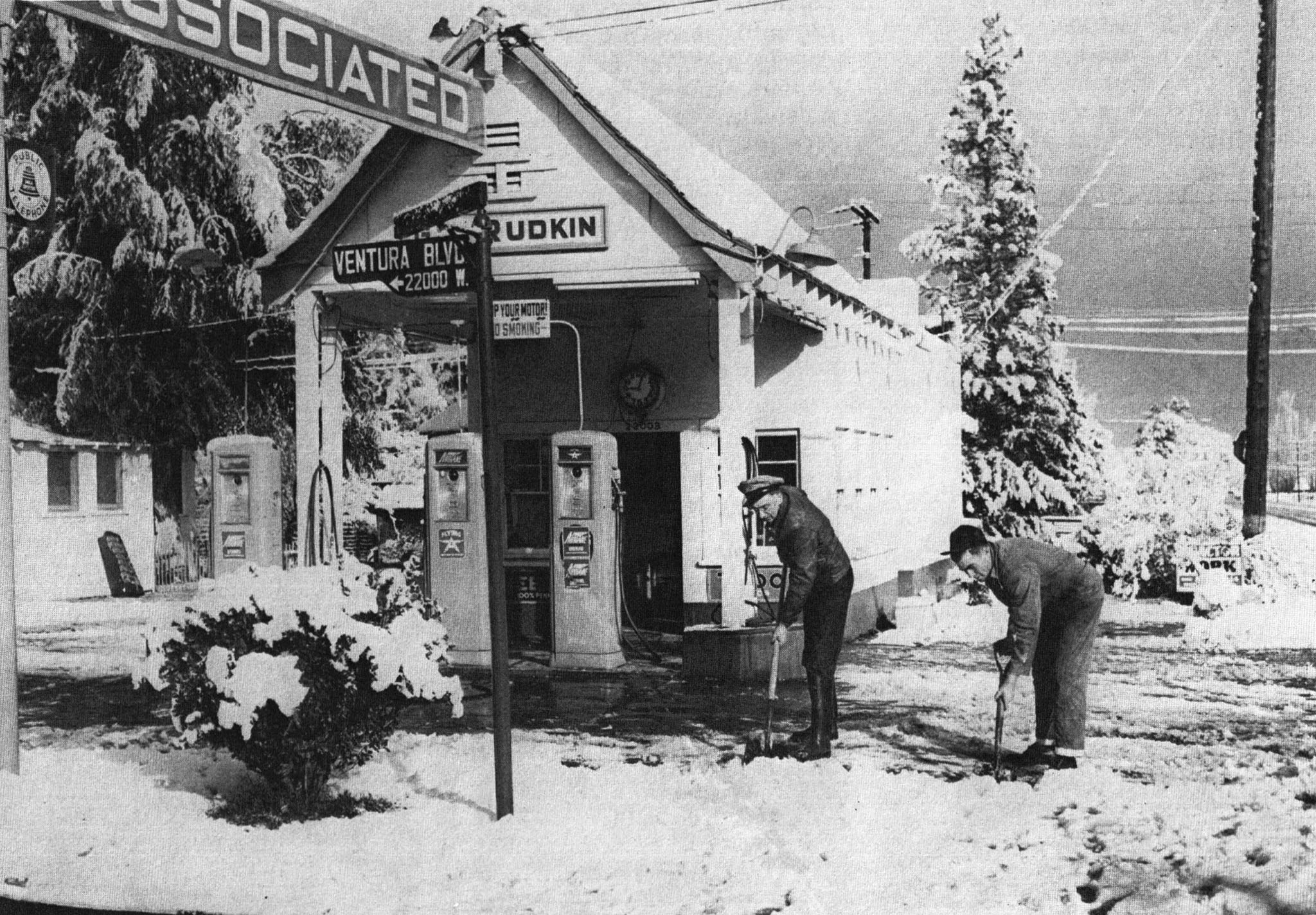 |
|
| (1949)#^*^ – View showing two men shoveling snow in front of an Associated Gas Station located on the NW corner of Topanga & Ventura boulevards. Photo date: Jan 12, 1949. Today, a Chase Bank stands at this corner. Click HERE to see more Early LA Gas Stations. |
Ventura Boulevard (Woodland Hills)
 |
|
| (1949)^ – View looking west on Ventura Boulevard toward Topanga Canyon Boulevard in Woodland Hills. Sign on the northeast corner (at right) reads 2 miles to Canoga Park (if you turn right on Topanga Cyn). On the southwest corner can be seen a Standard Gas Station and on northwest corner an Associated Gas Station. Click HERE to see contemporary view. |
Historical Notes This photo was originally identified as being in Canoga Park because of the large sign seen on the corner. But if you look underneath the "Canoga Park" sign there is an arrow pointing right (north) on Topanga Cyn. Blvd. |
Then and Now
 |
|
| (1949 vs. 2021)* – View looking west on Ventura Boulevard toward Topanga Canyon Boulevard in Woodland Hills. |
 |
|
| (1949)#^*^ – View showing two men shoveling snow in front of an Associated Gas Station located on the NW corner of Topanga & Ventura boulevards. Photo date: Jan 12, 1949. Today, a Chase Bank stands at this corner. Click HERE to see more Early LA Gas Stations. |
Snow in the San Fernando Valley (Storm of 1949)
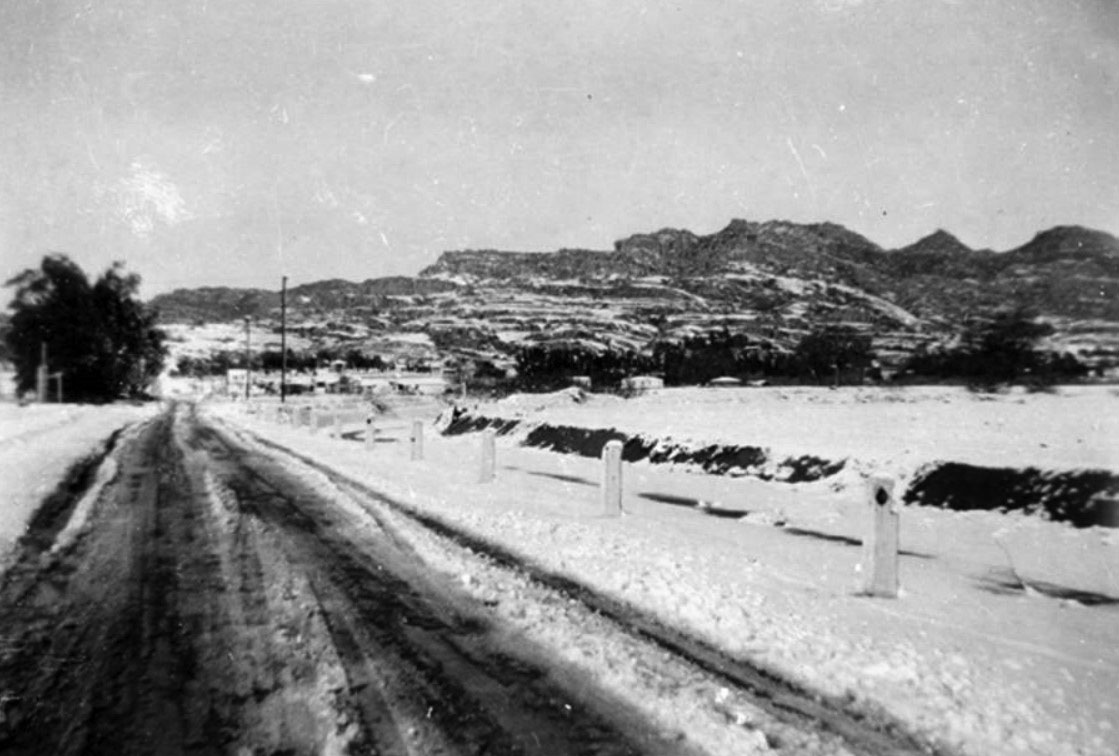 |
|
| (1949)^ – View looking west on Plummer Street in Chatsworth after snowfall, January 11, 1949. The hills in the background are part of the Santa Susana Mountains that surround Box Canyon. |
Historical Notes Snow fell in the San Fernando Valley and in most of Southern California during a 3-day storm from Jan 9 through Jan 12, 1949. |
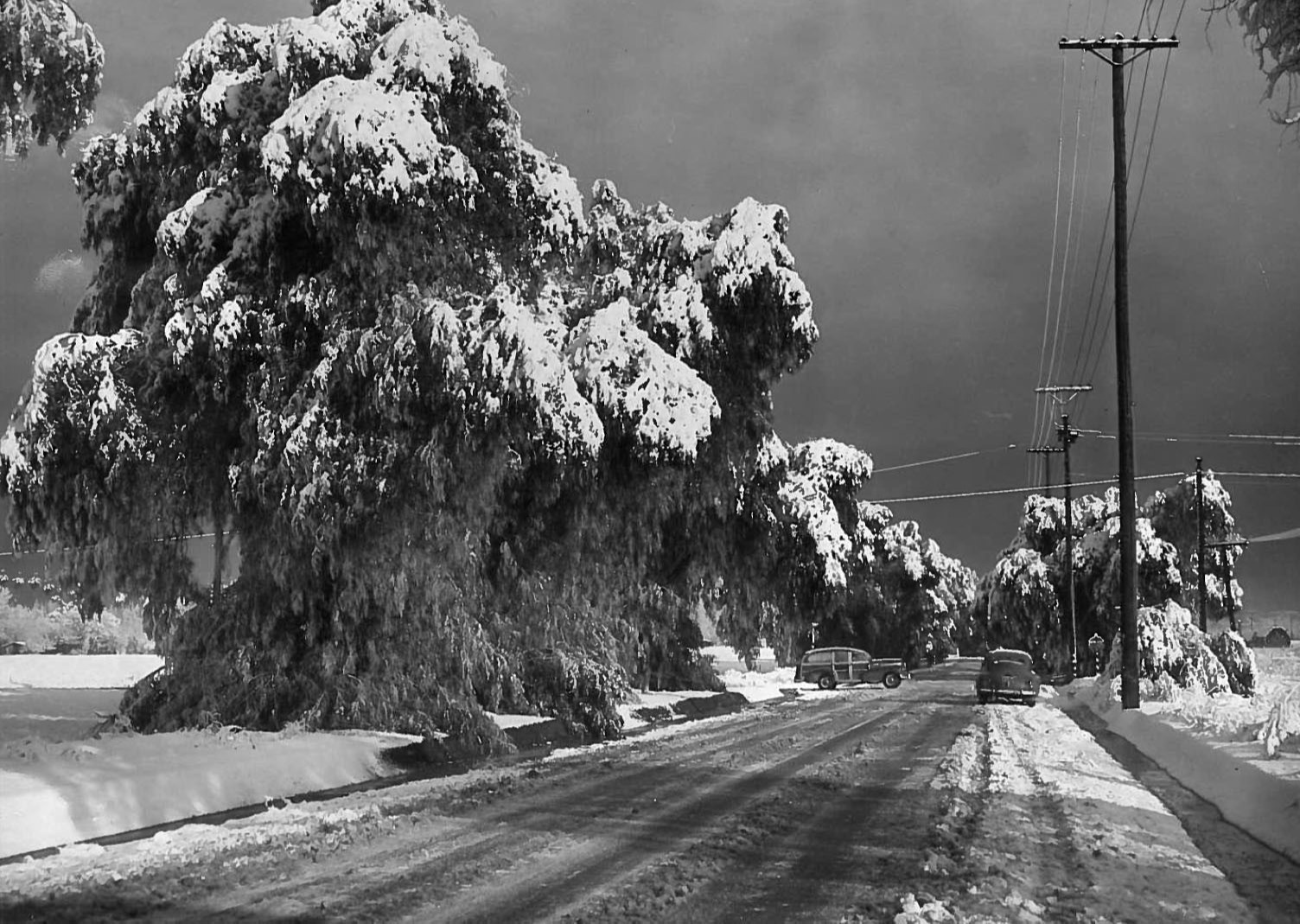 |
|
| (1949)* - The snow storm transformed the San Fernando Valley community of Canoga Park into a winter wonderland. Los Angeles Examiner Collection. |
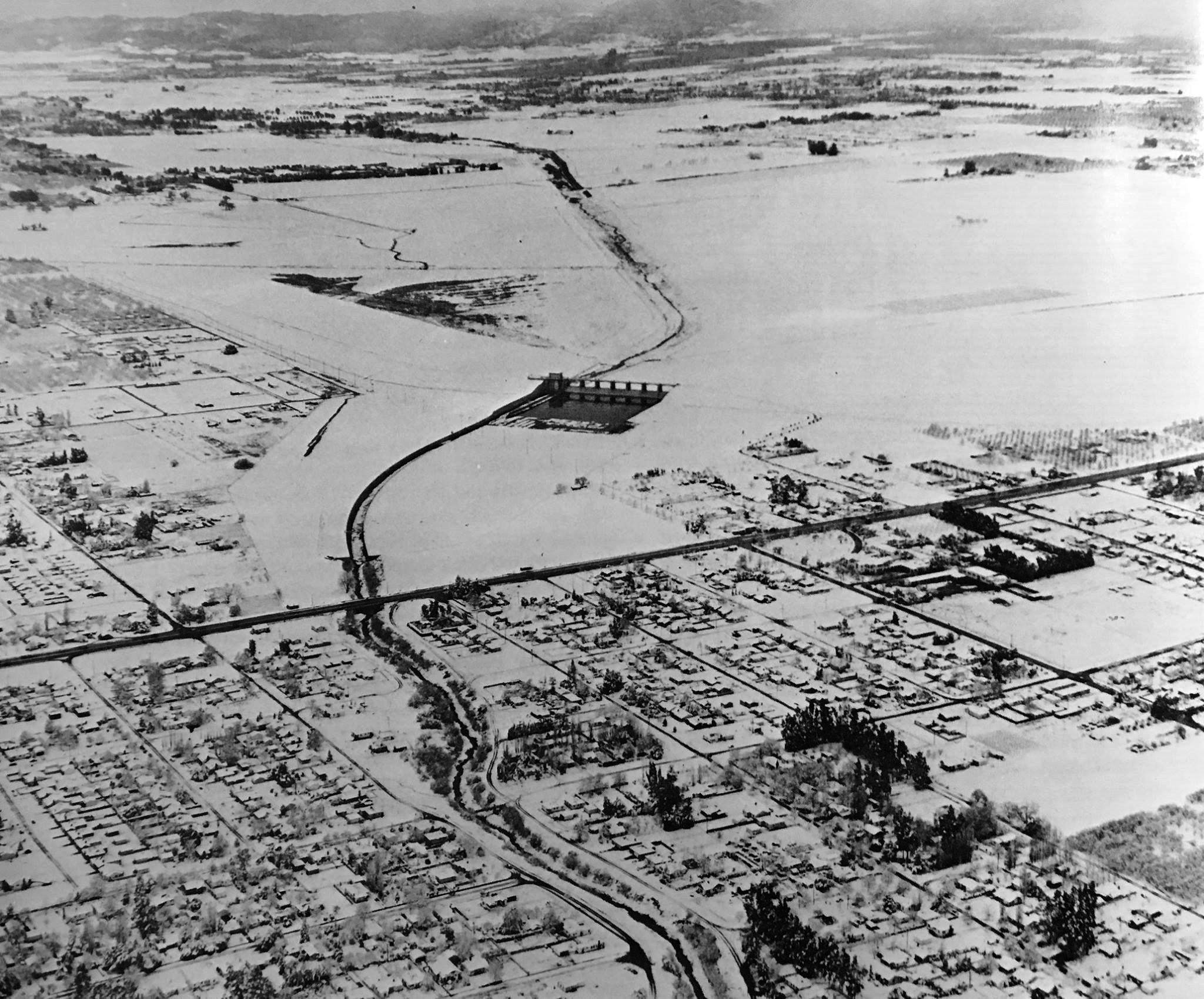 |
|
| (1949)#^*^ - Aerial view looking northwest showing the effect of a three day snow storm (Janurary 9th through January 11th). Sepulveda Boulevard is seen crossing at center left to right with the Sepulveda Dam and Basin just behind it. |
Historical Notes In a Jan. 10, 1999, Los Angeles Times article, columnist Cecilia Rasmussen wrote: On Jan. 10, 1949, in the middle of the worst housing shortage in Los Angeles history, more than half an inch of snow covered the Civic Center. The San Fernando Valley was pelted with the unfamiliar white stuff for three days, accumulating almost a foot. The rare snowfall produced wondrous vistas and unexpected difficulties, as some motorists besieged with frozen radiators were trapped in their cars in Laurel Canyon for several hours. |
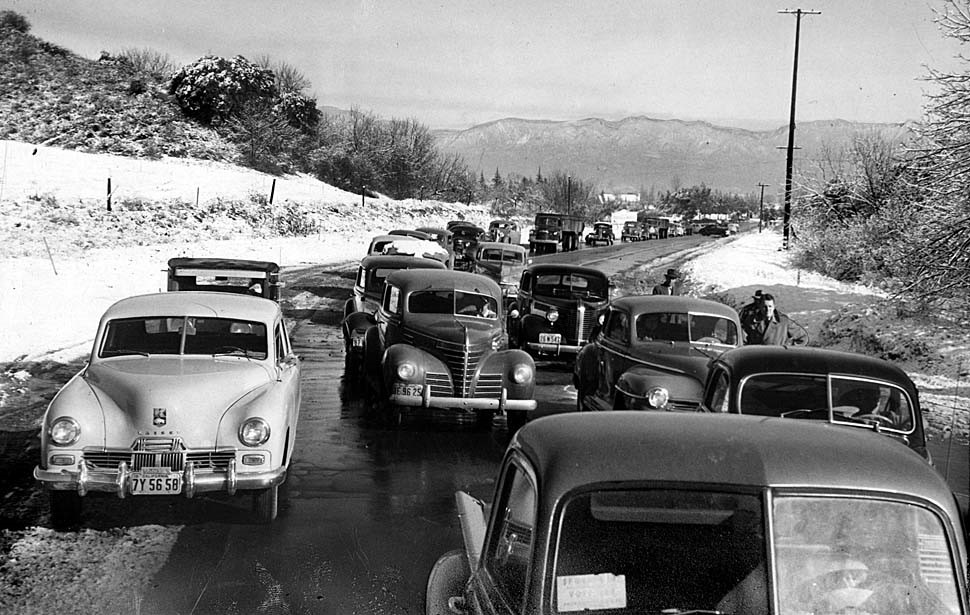 |
|
| (1949)^^^ – View showing cars lined up on Sepulveda Boulevard in Sherman Oaks waiting for ice to melt before driving over the hill to West Los Angeles. Cars with chains were allowed through. At noon the road was opened. Photo published in the Los Angeles Times, Jan. 13, 1949. |
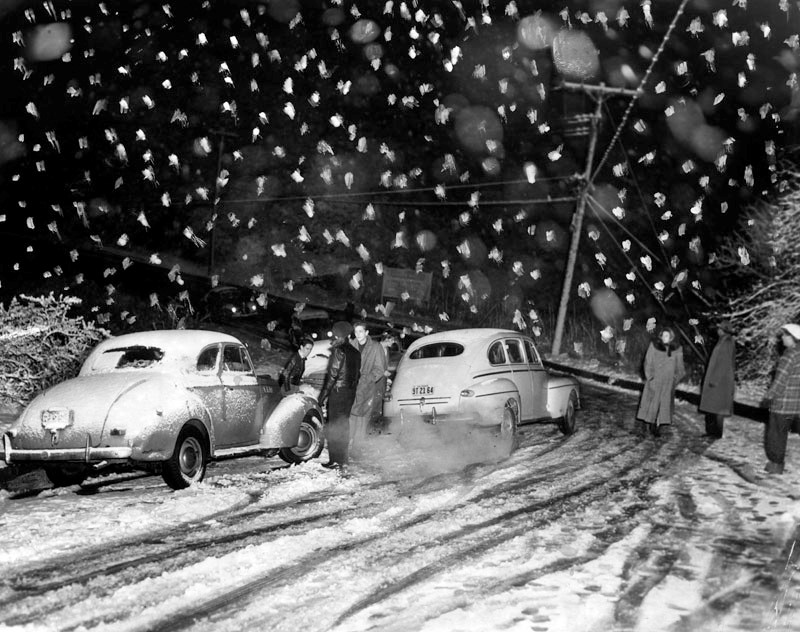 |
|
| (1949)* - Heavy flakes of snow fell in the darkness of the early dawn on January 11, 1949, and stalled traffic on this road in Coldwater Canyon, as a record-breaking snowfall hit Southern California. Many motorists were turned back on this road. Herald-Examiner Collection |
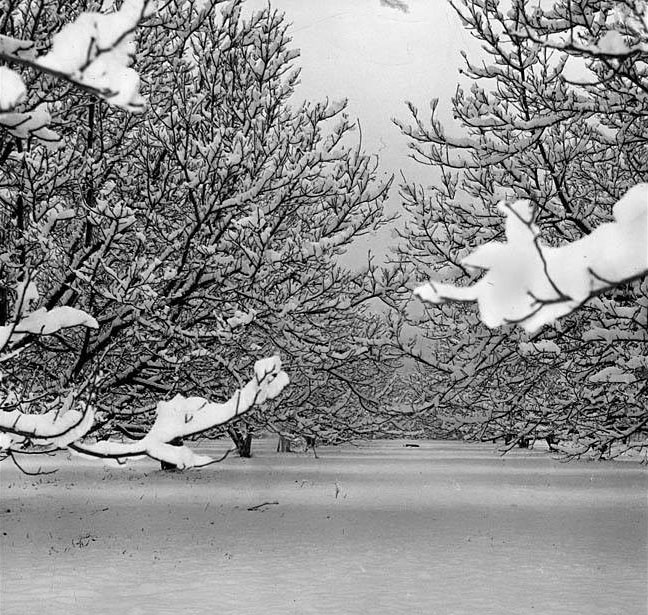 |
|
| (1949)++## – View showing a walnut orchard on Hazeltine Avenue in Van Nuys after three days of snow (Jan 9th thru Jan 12th). |
Then and Now
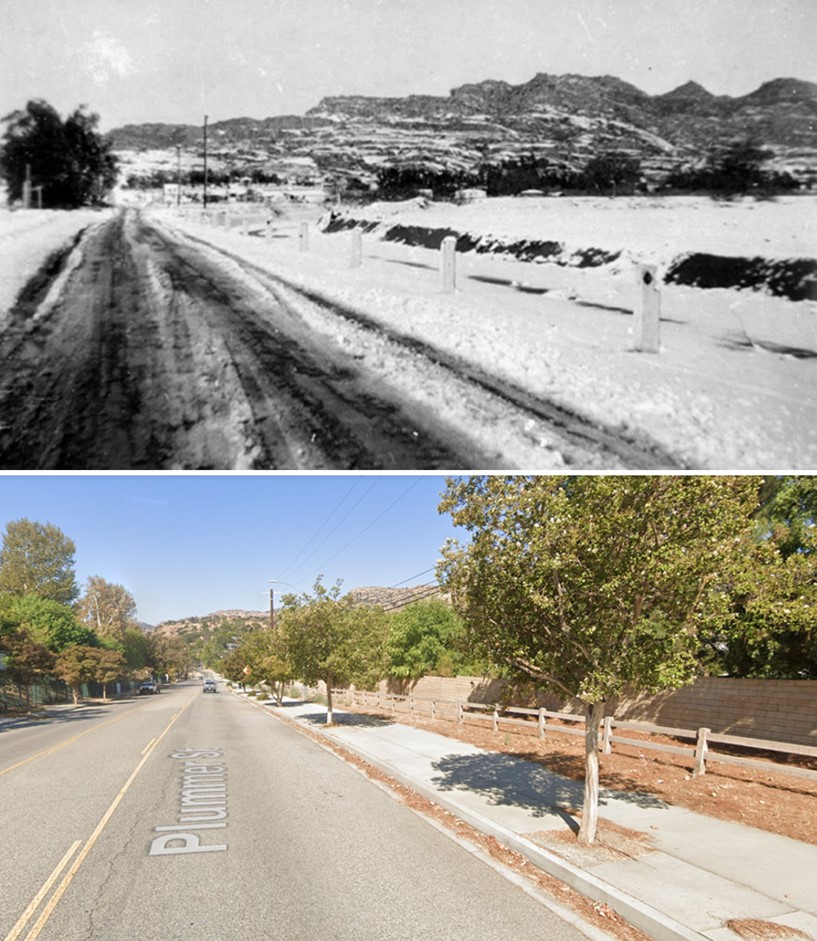 |
|
| (1949 vs 2022)* - Looking west on Plummer Street in Chatsworth toward the Santa Susan Mountains. Top photo was taken after snowfall on January 11, 1949. |
* * * * * |
Chatsworth - Southern Pacific R.R.
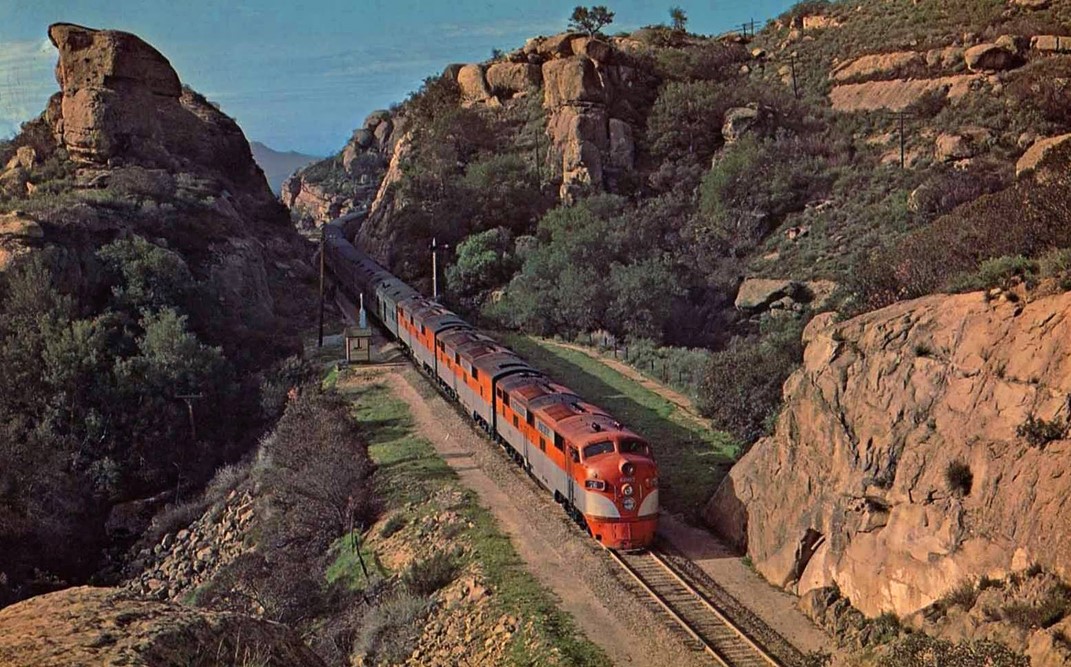 |
|
| (1950s)^ – Postcard view showing the Southern Pacific overnight “Lark” as it makes its way through the Chatsworth Mountains toward downtown L.A. |
Historical Notes The Lark was an overnight passenger train of the Southern Pacific Company on the 470-mile run between San Francisco and Los Angeles. It became a streamliner in 1941 and was discontinued on April 8, 1968. The Lark ran along the same route as the Coast Daylight and was often pulled by a locomotive wearing the famous Daylight paint scheme of orange, red, and black. |
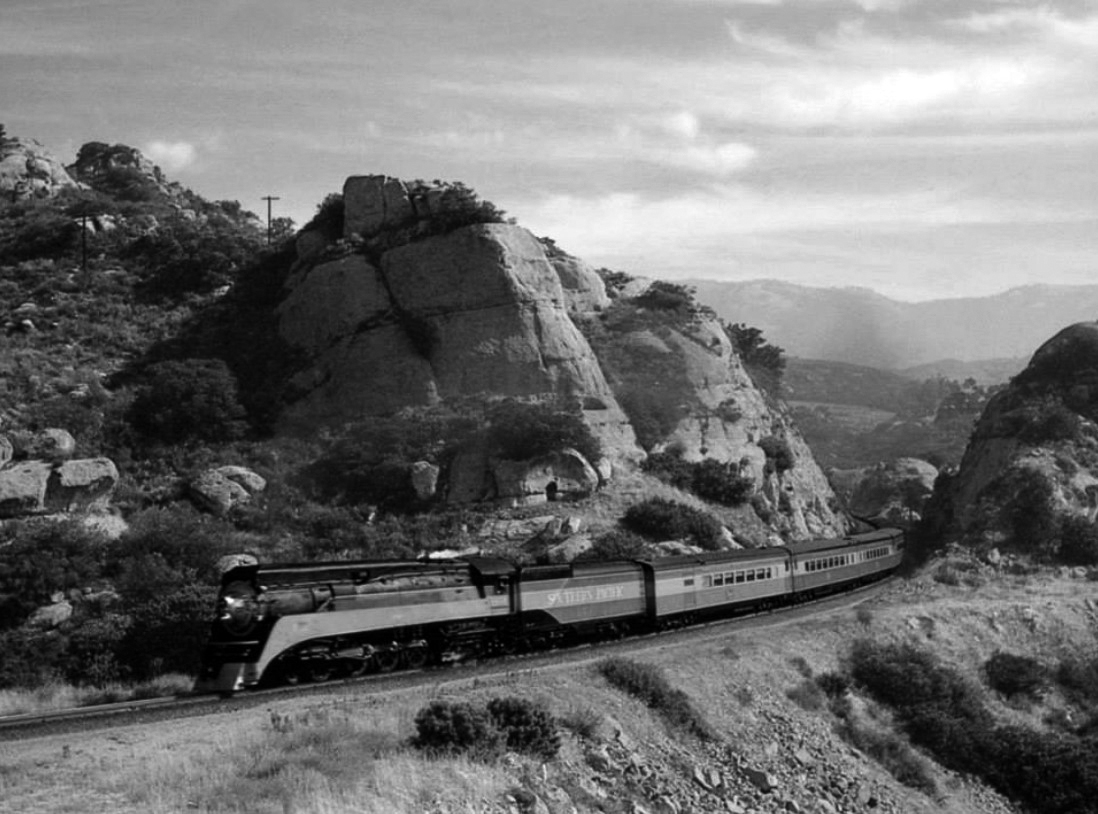 |
|
| (n.d.)*- View showing the Southern Pacific Coast Daylight heading northbound towards the second tunnel in Chatsworth. Photo courtesy of California State Railroad Museum |
Historical Notes The Coast Daylight, originally known as the Daylight Limited, was a passenger train on the Southern Pacific Railroad (SP) between Los Angeles and San Francisco, California, via SP's Coast Line. In the eyes of many the "most beautiful passenger train in the world," it carried a stunning red, orange, and black color scheme. |
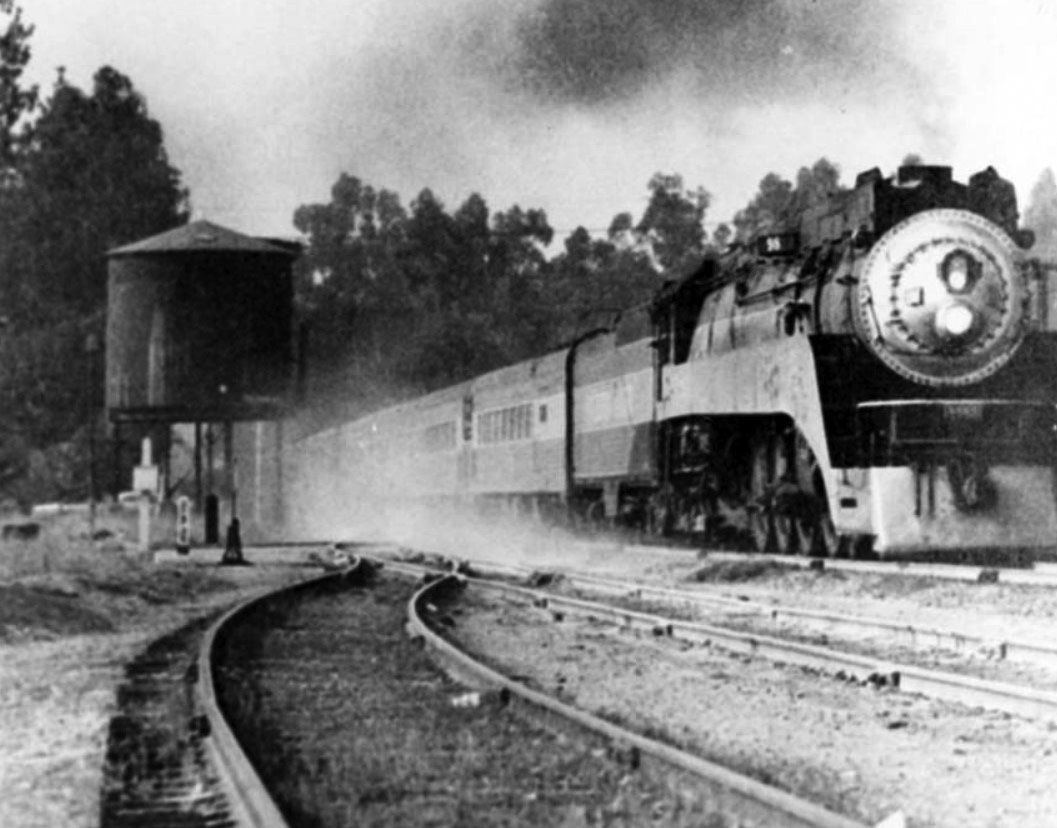 |
|
| (ca. 1946)^ - Southern Pacific's "Daylight Limited" train 98 crossing Devonshire Street in Chatsworth on its way from San Francisco to Los Angeles. |
Historical Notes The Coast Daylight operated from 1937 until 1974, one of the few passenger trains retained by Amtrak in 1971. Amtrak merged it with the Coast Starlight in 1974. |
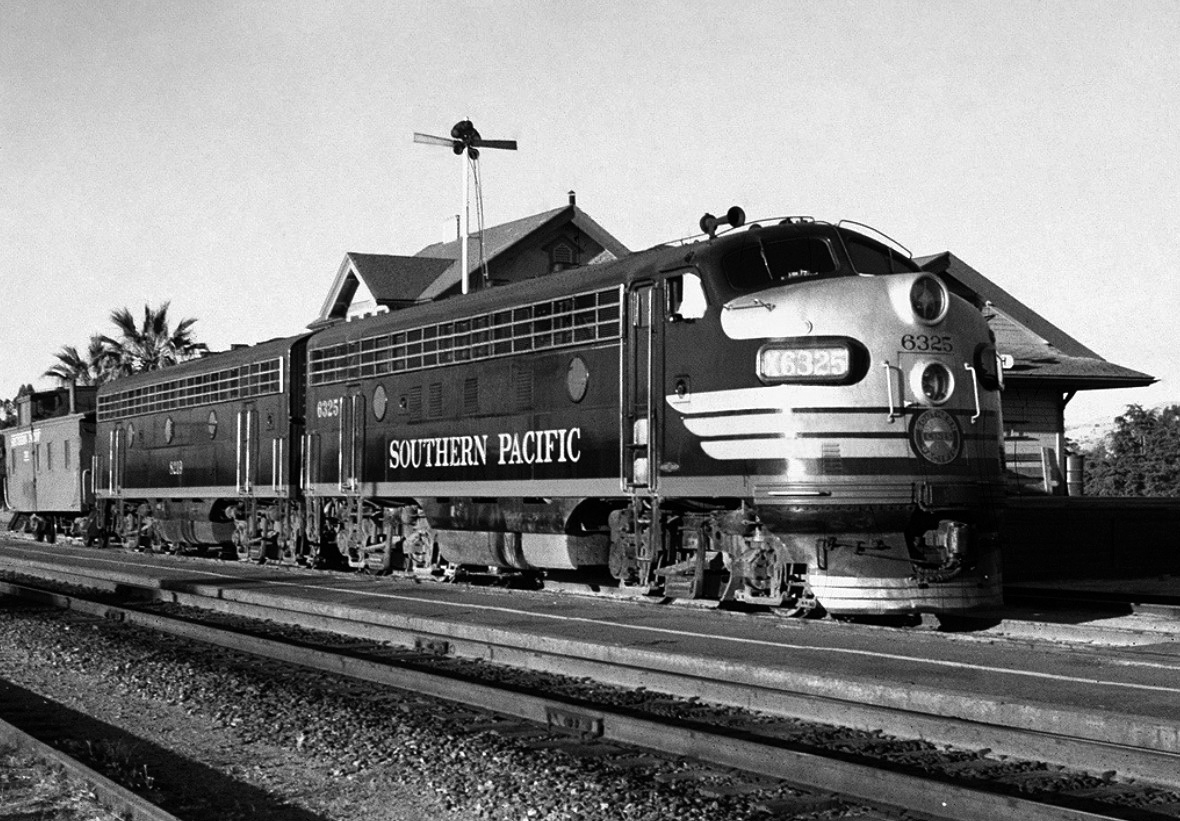 |
|
| (1952)^.^ - Classic Southern Pacific: SP F7A 6325 and F7B 8219 (both November 1950 graduates of the EMD La Grange, IL, factory) sit with a caboose at the station in Chatsworth, California, on the SP's Coast Line. The 6325 was retired in March 1969, and the 8219 was retired in December 1965. Photo credit: John J. Munson |
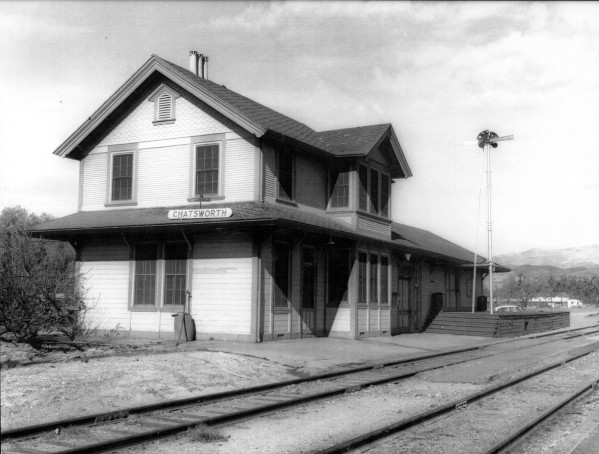 |
|
| (1950s)^ - View of Chatsworth's railroad station (its 2nd) located at Devonshire Street. The view is looking northwest toward Devonshire. This station coexisted with the first station until the latter was destroyed by fire in 1917. |
Historical Notes The Original Chatsworth Depot was built in 1893 near the intersection of Marilla and Topanga. Chatsworth's second depot (seen above) was built around 1910, located south of Devonshire Street on the west side of the tracks. |
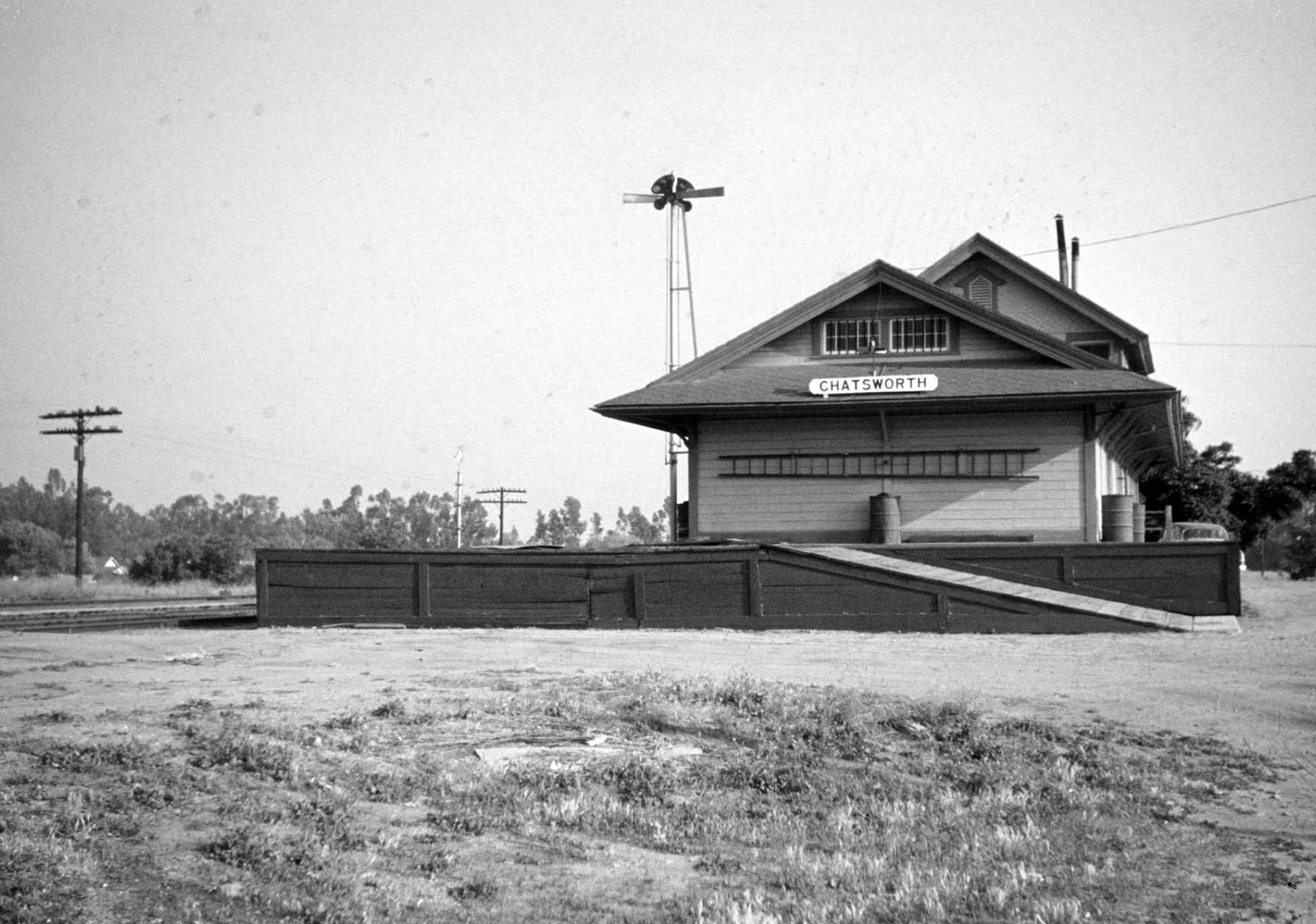 |
|
| (1956)* – View is looking south from Devonshire showing the Southern Pacific Chatsworth Depot on the west side of the tracks. |
Historical Notes By the early 1960s the above Chatsworth Depot fell into disuse and was razed by Southern Pacific (December, 1962). In 1997 a new depot and town center was erected between Devonshire and Lassen streets. |
Los Angeles River (near Reseda Park)
 |
|
| (1955)^ – View showing two boys playing at the edge of the Los Angeles River between Lindley Avenue and Reseda Boulevard with what appears to be Reseda Park at upper-right. |
Reseda Park (Then and Now)
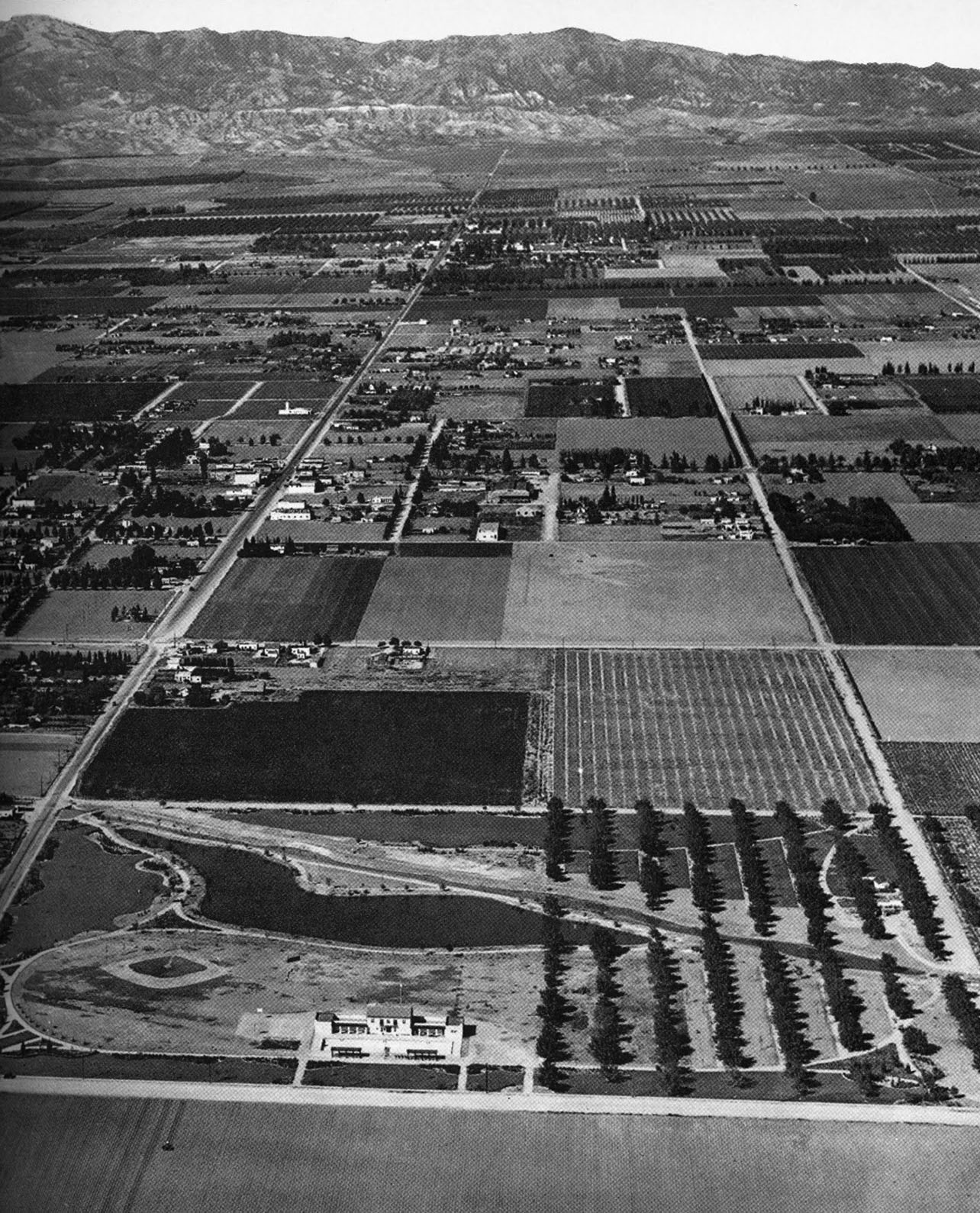 |
|
| (1932)^^# - Aerial view looking north over Reseda Park showing the LA River running diagonally across the park. Below the park, in the foreground, is Victory Boulevard running left to right (west to east). The two major streets runing north-south are Reseda Boulevard (left) and Etiwanda Avenue (right). |
Historical Notes Completed in 1933, Reseda Park was made possible through federal funding by the New Deal Agency: Reconstruction Finance Corporation (RFC). The Annual Report from 1932-33 of the Los Angeles Board of Park Commissioners reads: “Reseda Park is one of the city parks located in San Fernando Valley at Reseda and Etiwanda Avenues, Kittridge Street, and Victory Boulevard. Being forty acres in area it provides a delightful recreational spot for the residents of San Fernando Valley. A great deal of improvement was accomplished during 1932-1933 with the help of the RFC and County Welfare workmen. Fifteen hundred lineal feet of walks were built, involving the grading of 600 cubic yards of dirt, and lining the walks with 2,100 lineal feet of 1×4 redwood curbing. The flood channel for 1,450 feet was improved necessitating the removal of 2,250 cubic yards of dirt. Three acres of park land were cleared and eight acres graded, removing 2,400 cubic yards of dirt. New picnic grounds were also built, totaling two acres. A new sprinkling system was installed necessitating the laying of 10,880 lineal feet of pipe. Improving the park from a landscape standpoint, 520 trees were trimmed, 350 trees moved, 1,280 new trees planted, 7,520 new shrubs planted, and 24,700 flowering plants were placed in the shrub beds and around the banks of the lagoon. About five acres of ground were planted in new grass. One pergola was also built and a new comfort station constructed in the picnic grove. This park is becoming very popular with residents of the San Fernando Valley for picnic suppers during the extreme warm weather.” ** |
Now
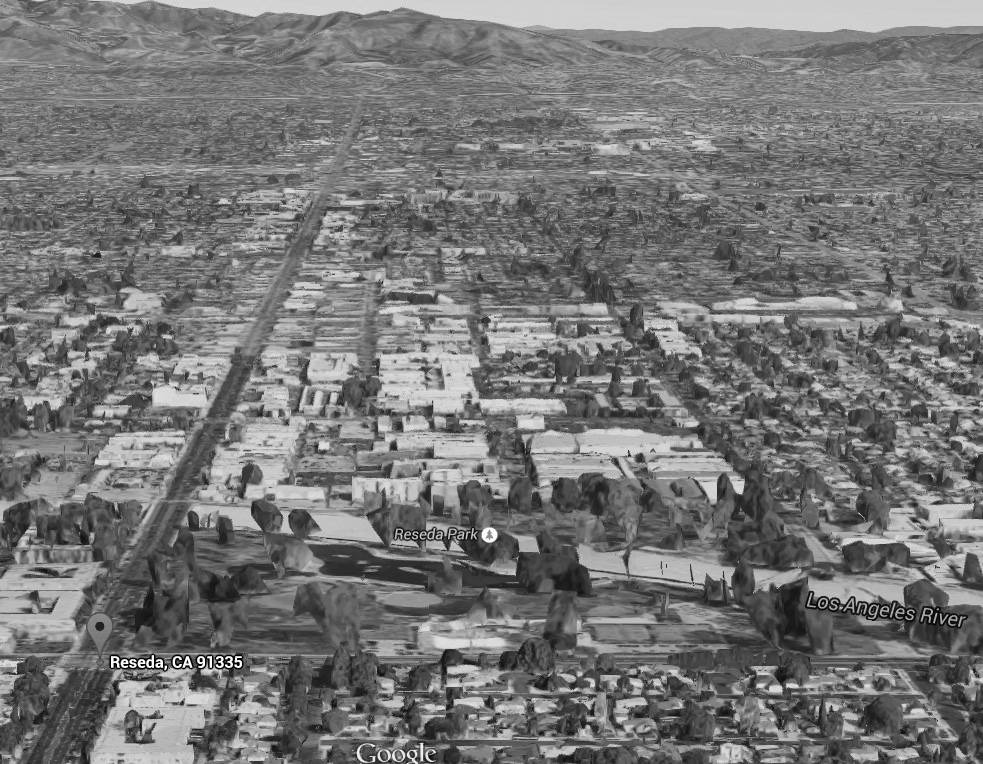 |
|
| (2015)#*^# - Google aerial view looking north over Reseda Park. The intersection of Victory and Reseda boulevards is at lower-left. |
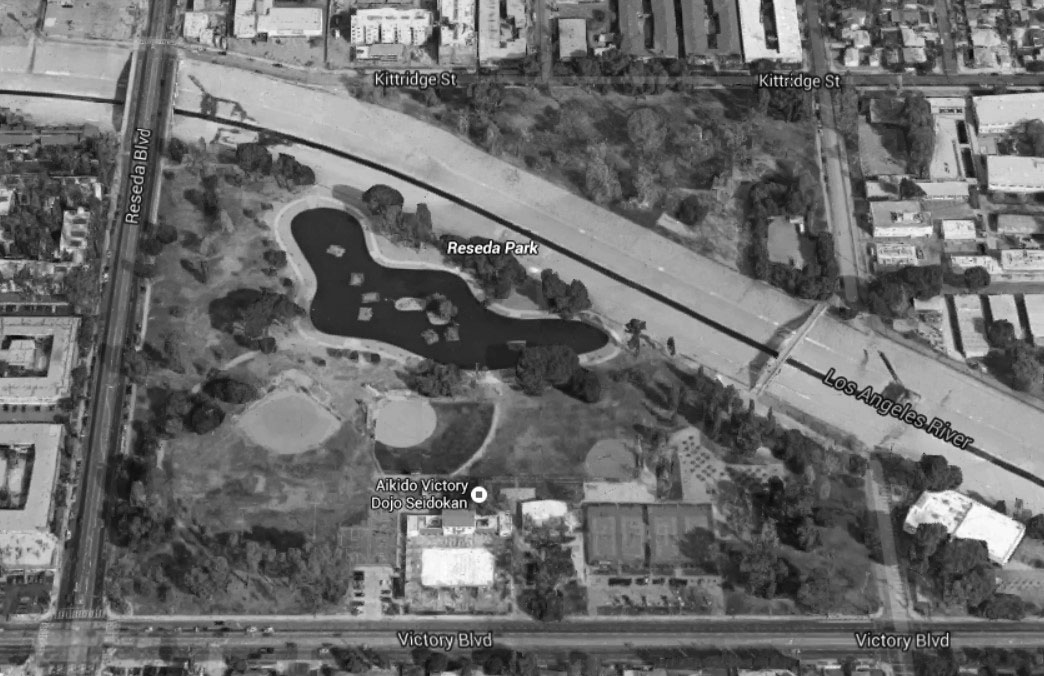 |
|
| (2015)#*^# – Aerial view of Reseda Park showing a cement-lined Los Angeles River. |
* * * * * |
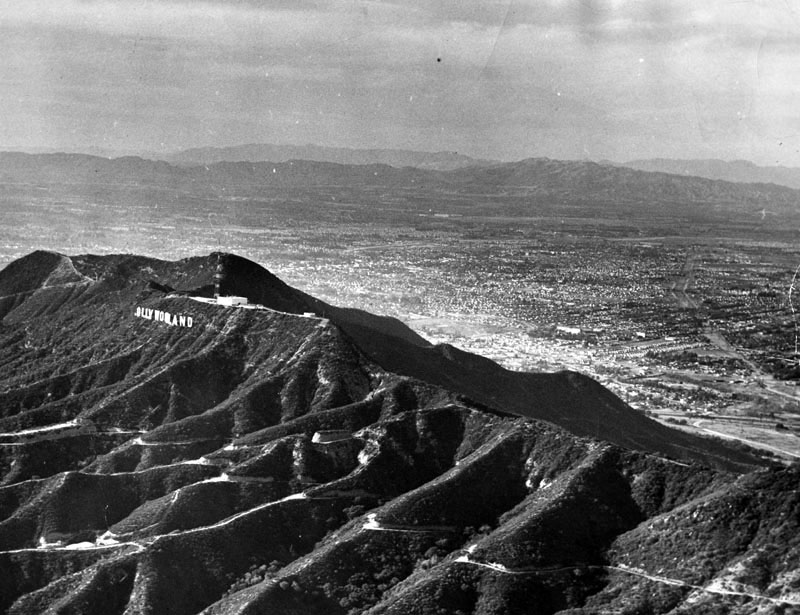 |
|
| (1948)* - Aerial view of the San Fernando Valley. View shows the "HOLLYWOODLAND" sign on the mountain. The letter "H" is missing. Within months of the time this photo was taken the sign would be shortened to read "HOLLYWOOD". Photo dated: December 13, 1948. |
Historical Notes The HOLLYWOODLAND sign was erected in 1923 to advertise a new housing development in the hills above the Hollywood district of Los Angeles. In 1949 the Hollywood Chamber of Commerce contracted to repair and rebuild the sign. The contract stipulated that “LAND” be removed to reflect the district, not the housing development.* (Click HERE to see more in Early Views of Hollywood). |
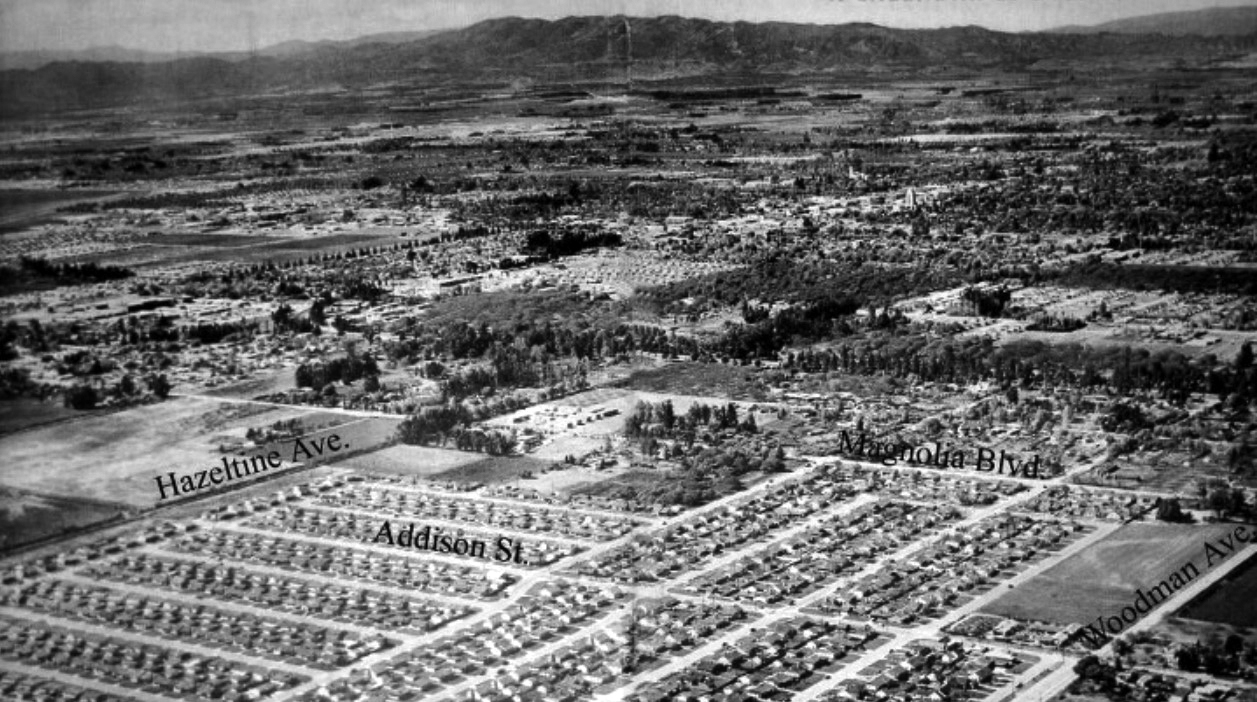 |
|
| (1950)+#+ – View looking northwest showing the community of Van Nuys in the foreground with a wide open San Fernando Valley in the distance. |
jpg.jpg) |
|
| (1950s)^^ - View of the San Fernando Valley looking northwest from above Sherman Oaks. The Santa Monica Mountains are on the left with Ventura Boulevard running from lower right-center to upper-left of photo. The concrete-lined LA River serpentines its way down from the Sepulveda Basin (top-center) to Sherman Oak (lower-right). |
Historical Notes The Ventura Freeway wasn’t built until the late 1950s and opened on April 5, 1960.*^ |
Oxnard and Fulton
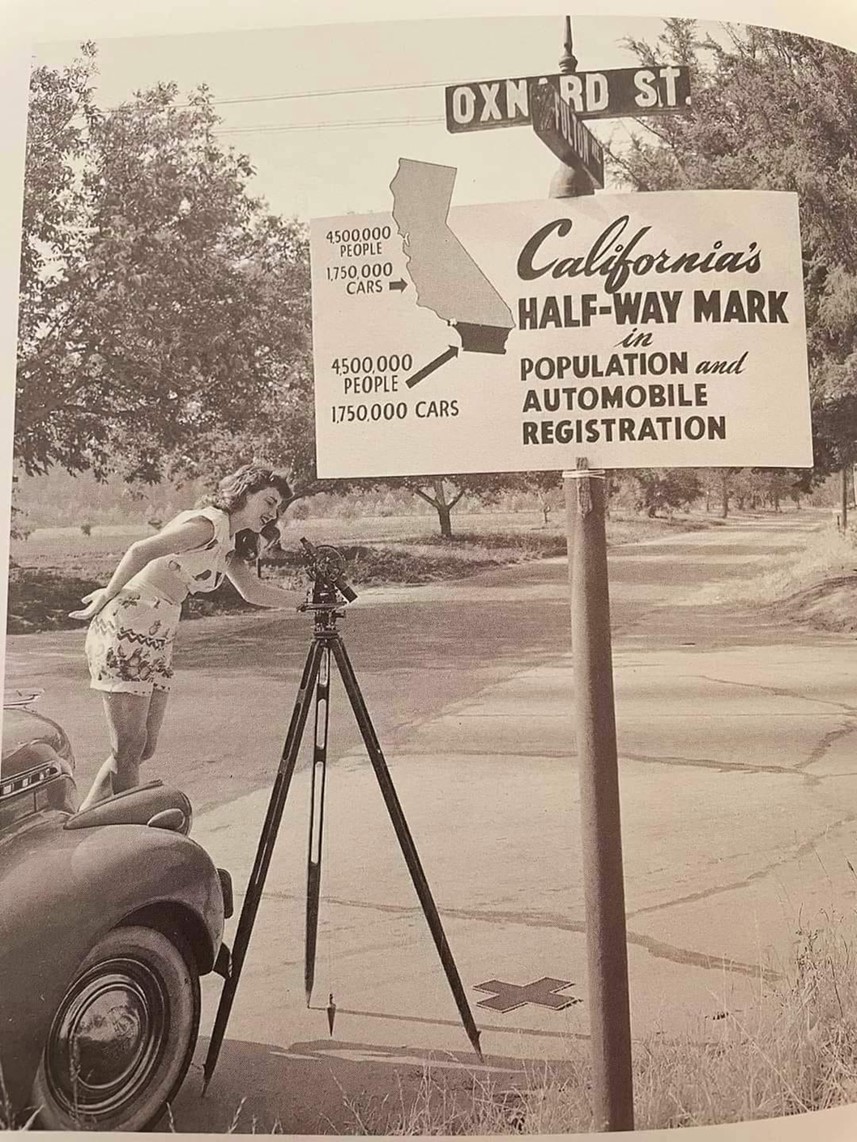 |
|
| (1948)* – Intersection of Oxnard Street and Fulton Avenue. Sign reads: 'California's Half-Way Mark in Population and Automobile Registration. |
Then and Now
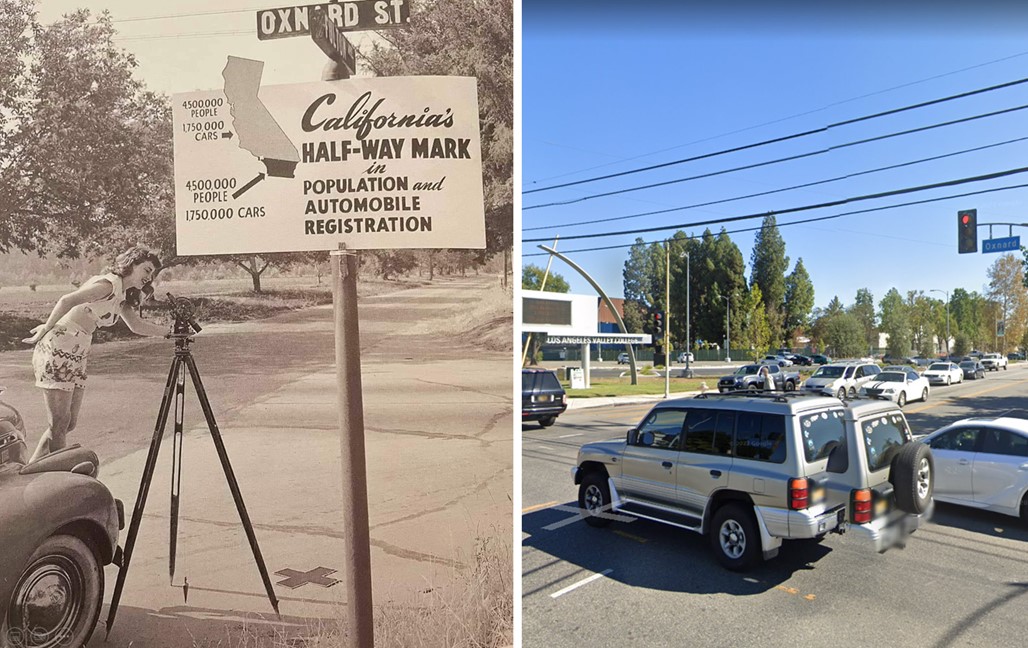 |
|
| (1948 vs 2022)* – Intersection of Oxnard and Fulton where today Valley College can be seen on the SE corner. |
Valley Plaza Mall
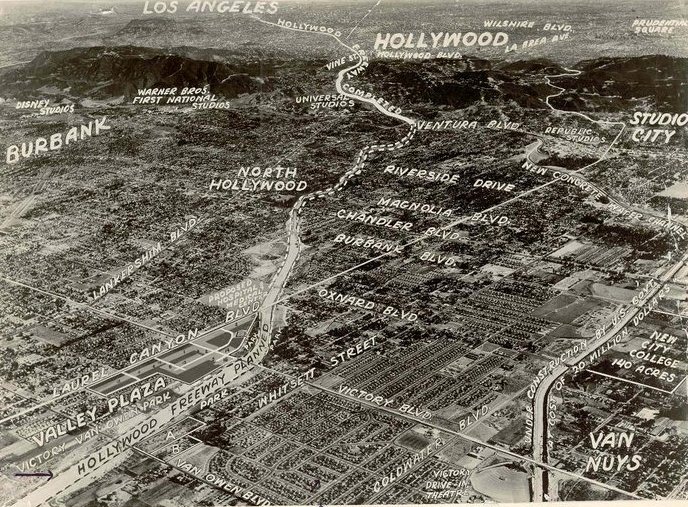 |
|
| (ca. 1950)^#* - This photo was a 'give-away' from the new Valley Plaza Shopping Center. View is looking southeast toward Cahuenga Pass. Neither the Ventura Freeway nor the Hollywood Freeway were completed at the time of this photo. The future home of Valley City College is indicated in the lower right. |
Historical Notes The Valley Plaza Mall was built in 1951 and, at the time, was the largest mall west of the Mississippi River. It was the first mall in the U.S. geared toward the automobile and was built in anticipation of the yet to be completed Ventura and Hollywood Freeways.^*# The 101 Freeway from Ventura to its intersection with the Hollywood Freeway in the southeastern San Fernando Valley in Los Angeles (the Hollywood Split) was built in the late 1950s and opened on April 5, 1960. East of the Hollywood Freeway intersection, it is signed as State Route 134 which was built by 1971.*^ The Hollywood Freeway (Route 170) between the Ventura Freeway and the Golden State Freeway (Interstate 5) was completed in 1958.*^ Los Angeles Valley College was founded on September 12, 1949 to meet the tremendous growth of the San Fernando Valley during the 1940s and early 1950s. The college was officially chartered by the Los Angeles Board of Education in June 1949, and was located on the campus of Van Nuys High School. In 1951 Valley College moved to its permanent 105-acre site on Fulton Avenue in Valley Glen.*^ |
Sears (Valley Plaza Mall - North Hollywood)
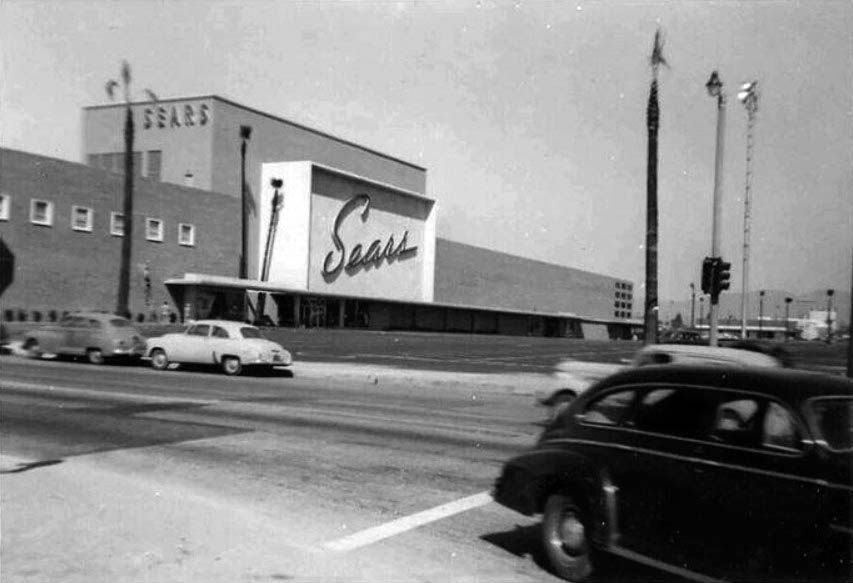 |
|
| (1950)*^*# - View showing the yet to be completed Sears Roebuck & Co. located at 12121 Victory Boulevard at the new Valley Plaza Mall. |
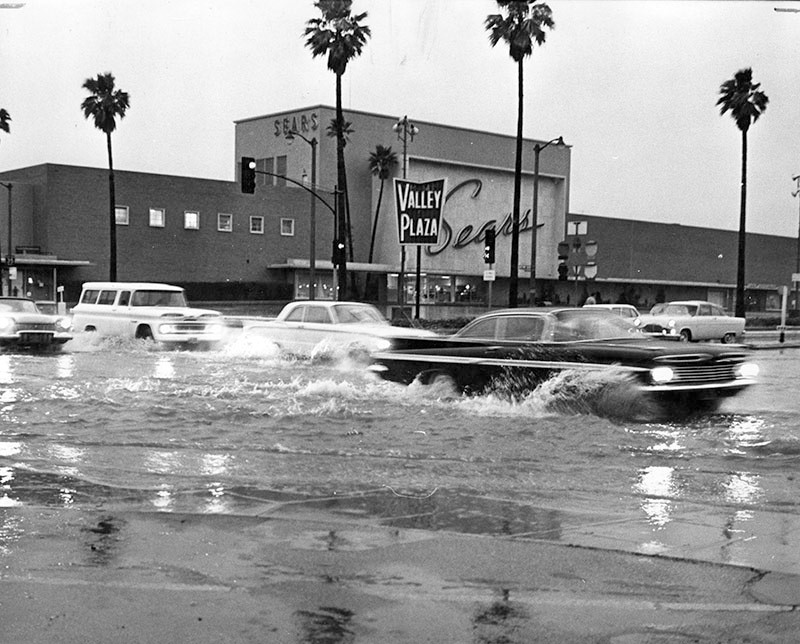 |
|
| (1962)* - Photograph caption dated February 19, 1962 reads, "Motorists splash through flooded North Hollywood intersection - Corner of Victory and Laurel Canyon boulevards was awash." - Valley Times |
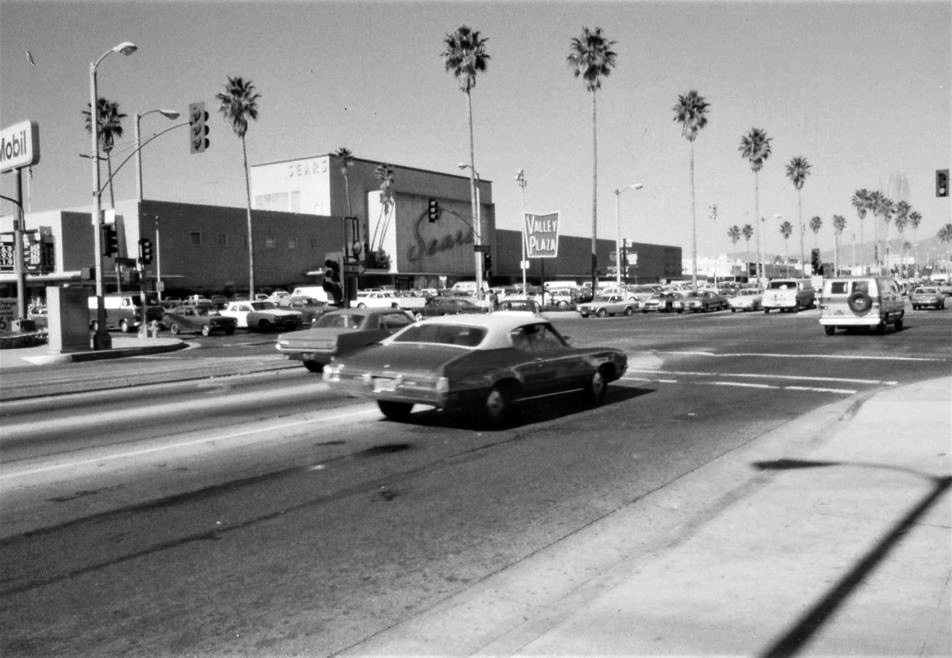 |
|
| (1970s)^.^ – Looking north on Laurel Canyon at Victory, showing the Sears at the the Valley Plaza Shopping Center with a Mobil Station at left, on the SW corner. Click HERE for contemporary view. |
McDaniel’s Market (Valley Plaza Mall - North Hollywood)
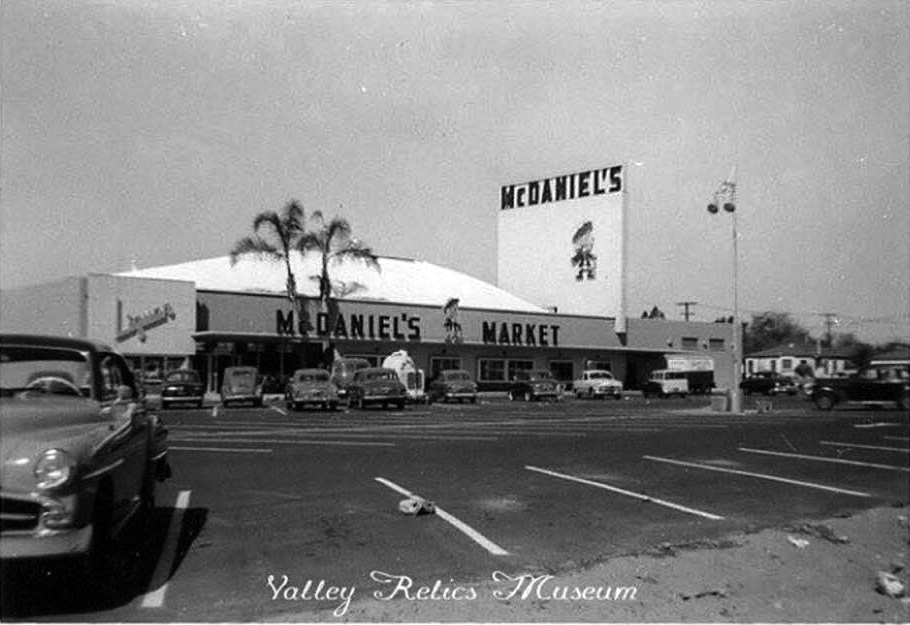 |
|
| (ca. 1950)^.^ - View showing McDaniel’s Market located at the north end of Valley Plaza near Vanowen. |
Historical Notes McDaniel’s Markets was an independent supermarket chain which featured a jaunty Scotsman as their mascot and a tartan pattern as a key design element in their ads and on stores. By mid-1957, McDaniel’s had six stores, located in North Hollywood, Beverly Hills, East L.A., Maywood and Baldwin Park, according to the Los Angeles Times. That year, McDaniel’s bought out the six-store Walker’s Market chain, and between those stores and additional units built over the years, the company eventually grew to almost 25 stores. In the early 60’s McDaniel’s went bankrupt, selling their choicest locations to Food Giant Markets.* |
Longs Drugs
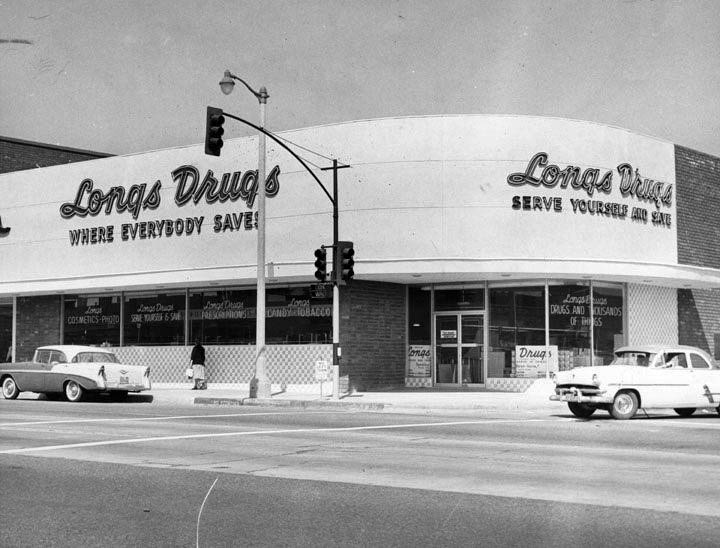 |
|
| (1959)* - View showing a Longs Drugs at 12201 Victory Blvd, which opened in 1959. The Longs chain is but a recent memory and this building now houses an Anna's Linens (Fallas). Click HERE for contemporary view. |
Historical Notes Before being acquired by CVS Health in 2008, Longs Drugs was a chain of over 500 stores, located primarily on the West Coast of the United States. They had stores located in California, Hawaii, Nevada, Arizona, Alaska, Colorado, Oregon, and Washington, and was headquartered in Walnut Creek, California.*^ |
LA Federal Savings and Loan
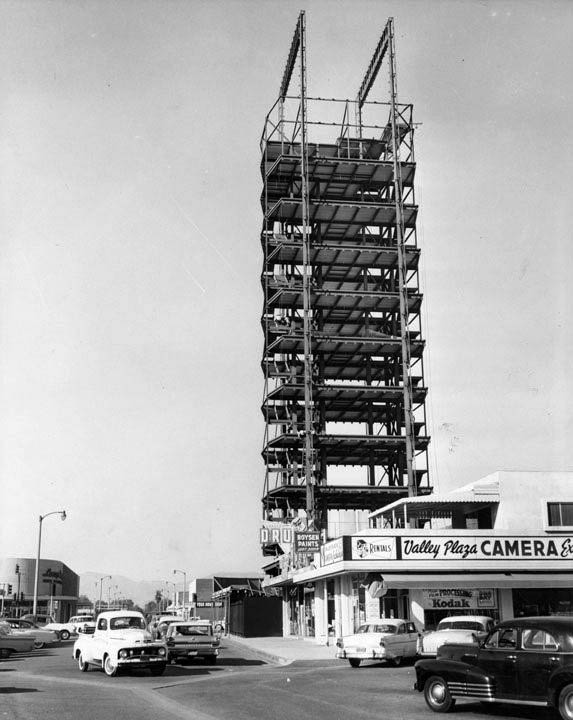 |
|
| (1960)* - View of the LA Federal Savings and Loan Building under construction located near the Hollywood Freeway at Victory Boulevard adjacent to the Valley Plaza. Longs Drug Store can be seen in the lower left. |
Historical Notes At 165-feet tall and 35-feet wide, it was the tallest building in the San Fernando Valley when its steel frame and precast wall sections rose out of the Valley Plaza Shopping Center in 1960. In those days its 100 thriving stores and shops made up what was believed to be the largest retail complex west of Chicago.^^^ |
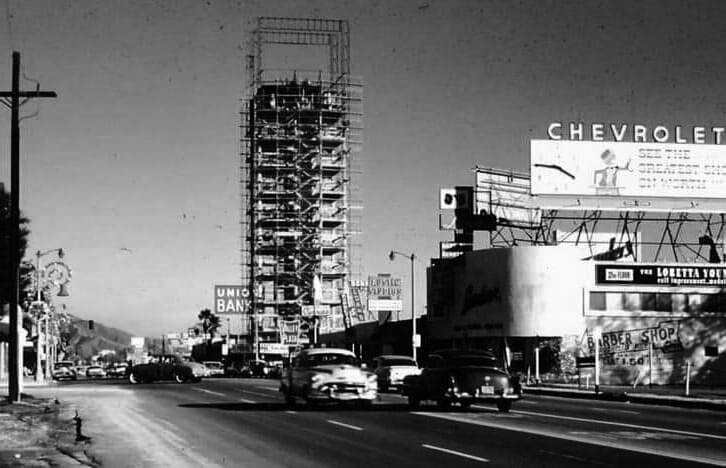 |
|
| (1960)^.^ - LA Federal Savings and Loan still under construction with the Union Bank seen behind it, 12160 Victory Boulevard. View is looking east on Victory Boulevard from near the Hollywood Freeway. Click HERE to see contemporary view. |
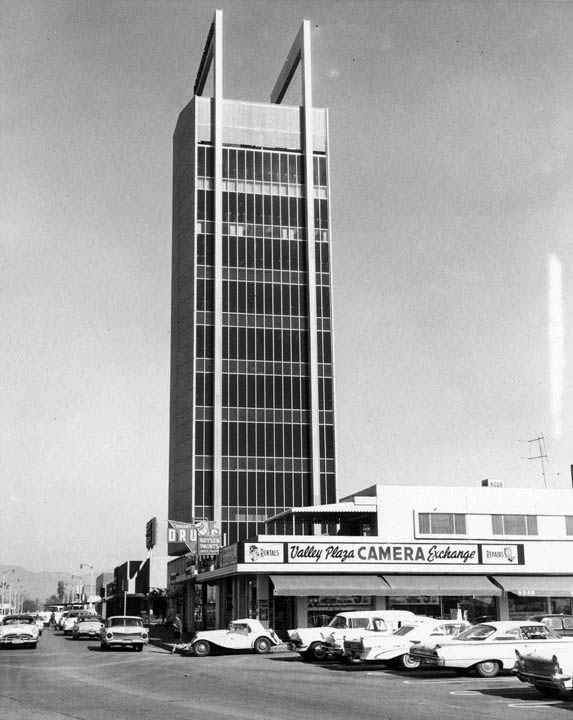 |
|
| (1961)* - View showing the completed Federal Savings Building with Valley Plaza Camera Exchange in the foreground. |
Historical Notes The Los Angeles Federal Savings and Loan Assn. spent $1 million on the building, including land and construction costs. Modernist architects Douglas Honnold and John Rex were hired to give the project the maximum bang for its buck.^^^ |
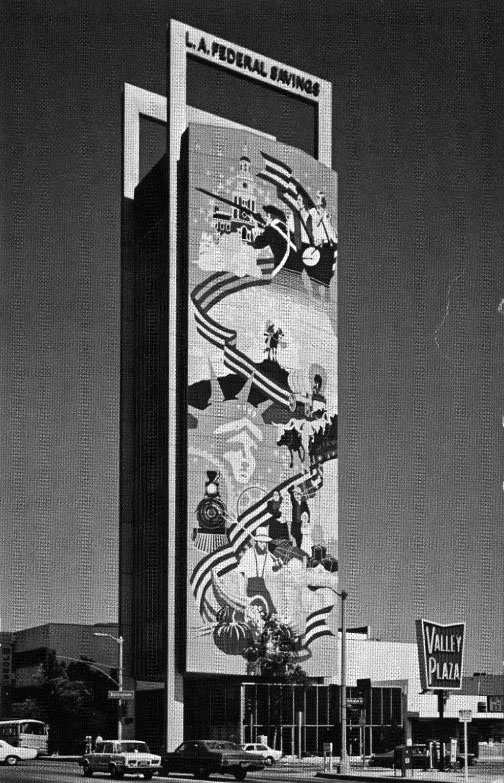 |
(1976)#^# – Postcard view of the Los Angeles Federal Savings Building, located at 12160 Victory Boulevard, North Hollywood. The Valley Plaza sign is seen across the street.
|
Historical Notes In 1976, a Bicentennial mural was commissioned by LA Federal Savings. Several financial institutions have operated the Victory Boulevard building over the years. Its current owner is Wells Fargo Bank.^^^ |
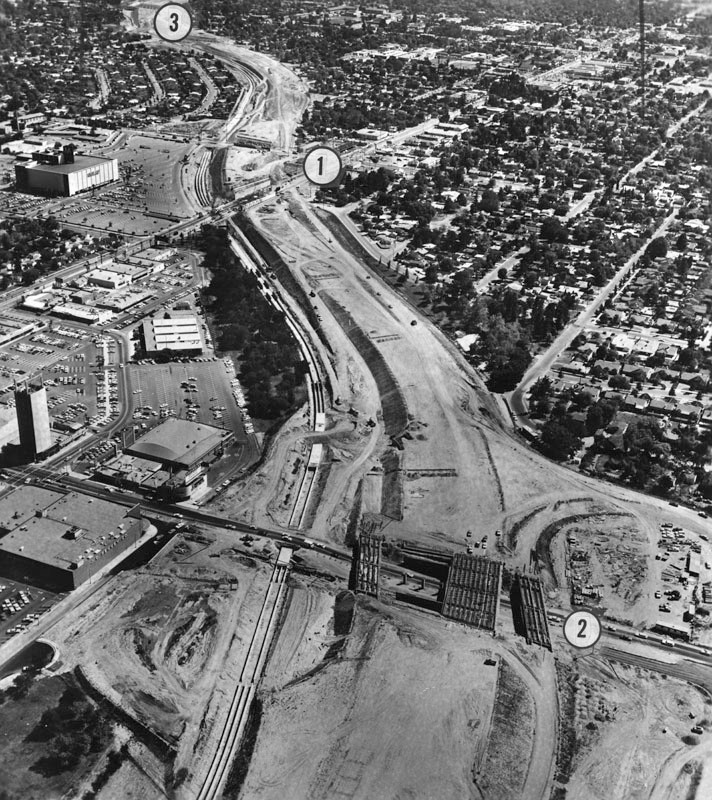 |
|
| (1965)* - Aerial view, looking south, of the Hollywood Freeway extension under construction. Near the top of the photo is Laurel Canyon Boulevard (1). In the foreground is Victory Boulevard (2). At the top of the photo is the freeway going to Los Angeles (3). At left-center can be seen the Los Angeles Federal Savings Building and the Valley Plaza. |
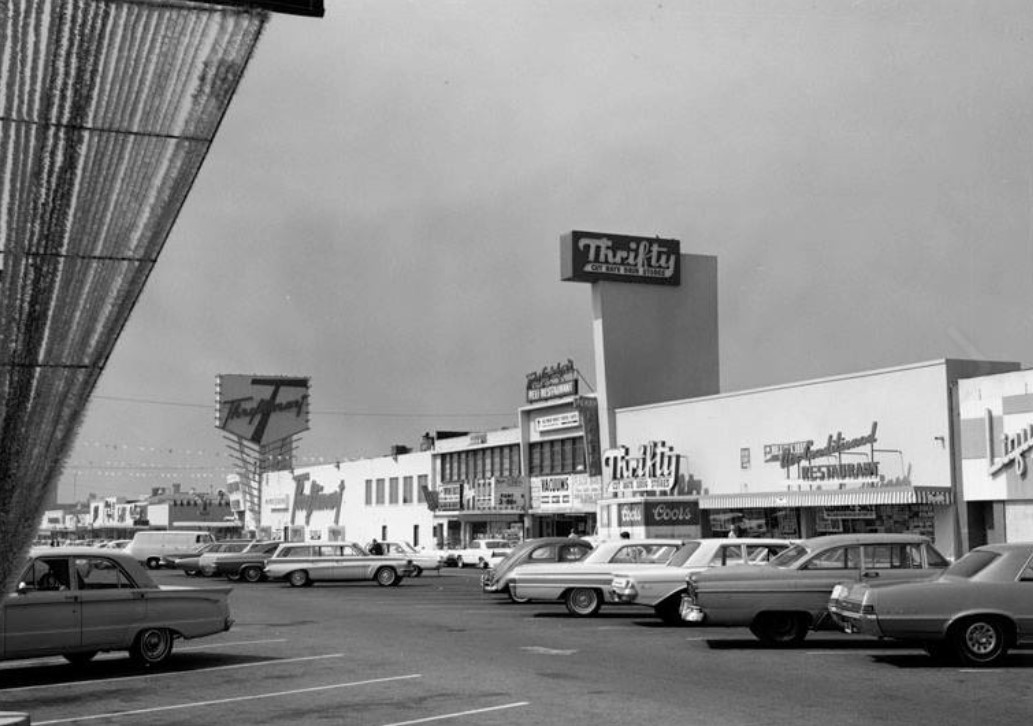 |
|
| (1960s)* - View of the shopping center across the street from Valley Plaza at Victory and Laurel Canyon Blvd. Thriftmart is seen on the left and Thrifty Drugs at center. This is when an ice cream cone at Thrifty was only 5 cents. |
Historical Notes Until the early 1980s, every Thrifty store featured a tube tester, usually located near the cosmetics display case. Vacuum tubes were still used in a wide variety of consumer electronics such as TVs and radios, and the local Thrifty store was a convenient place to test them and purchase replacements. Thrifty published a brochure helping customers diagnose which tubes might be responsible for various TV malfunctions. The brochure also provided numbered stickers to aid consumers in reinstalling working tubes in their correct sockets. Thrifty PayLess Holdings, Inc. was a pharmacy holding company that owned the Thrifty Drugs and PayLess Drug Stores chains in the western United States. In 1996, Rite Aid acquired 1,000 West Coast stores from Thrifty PayLess Holdings, creating a chain with over 3,500 drug stores. Rite Aid preserved the Thrifty Ice Cream brand because it won numerous awards in its history, and remained well-known for its affordable prices, quirky flavors, and iconic cylinder-shaped scoops.*^ |
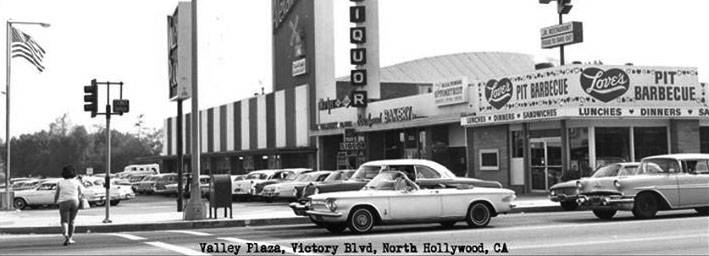 |
|
| (ca. 1961)^^^* - Panoramic view of the Valley Plaza on Victory Blvd. in North Hollwyood. Love's Pit Barbecue Restaurant is seen on the right. A Van De Kamp's bakery sign appears on the facing of a market. |
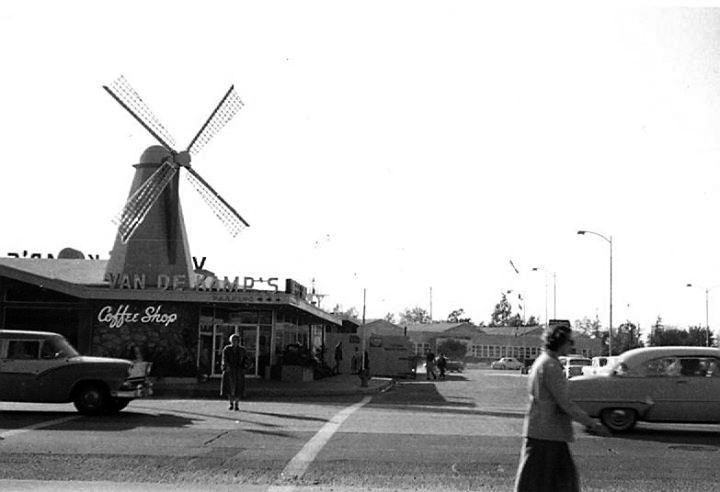 |
|
| (ca. 1950s)^^^* - View of Van De Kamp’s located on Laurel Canyon Blvd between Victory & Oxnard in North Hollywood. |
Historical Notes There were at least two other Van De Kamp’s coffee shops in the San Fernando Valley. One was at San Fernando Road and Fletcher Drive. The other, was on the southeast corner of Roscoe Blvd and Reseda Blvd, where the Facey Medical Building is located today. |
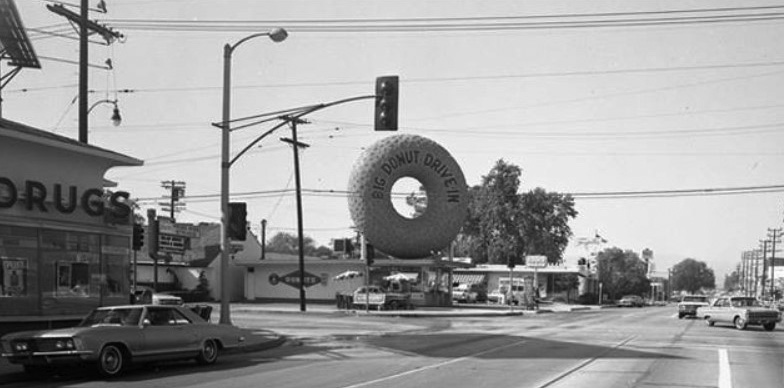 |
|
| (1960s)^^^* - View looking north on Laurel Canyon toward Magnolia Boulevard where the Big Donut Drive-in stands on the northwest corner. |
Historical Notes Russell C. Wendell, a doughnut machine salesman, created the Big Donut Drive-in. There were 10 locations, built over the course of the 1950s. At least five Big Donuts survive: they are Kindle's Donuts in unincorporated Westmont (this is the original location, built in 1950), (2) Randy's Donuts in Inglewood near LAX, the Donut King II in Gardena (3), Dale's Donuts in Compton (5), and Bellflower Bagels in Bellflower (8). Each features the distinctive giant doughnut constructed of rolled steel bars covered with gunite, a material used in swimming pools. Five Big Donuts have been demolished. They were located in Culver City (4), North Hollywood (6), Inglewood (on Imperial Hwy, 7), Van Nuys (9) and Reseda (10). The building style dates to a period in the early 20th century that saw a proliferation of Programmatic Architecture throughout Southern California. This style had its heyday from the mid-1920s to the mid-1930s. By the 1950s however, the trend of designing structures in the shape of the product sold there had changed to focus on signs rather than architecture itself.*^ Click HERE to see more examples of Programmatic Architecture. |
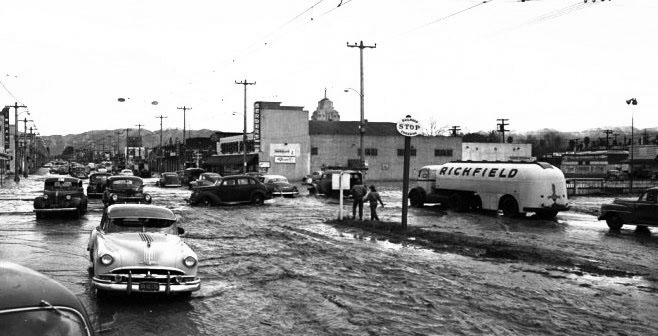 |
|
| (ca. 1951)^^^* - View looking north of a flooded intersection at Van Nuys Blvd and Oxnard Street where the tracks are. A stop sign sits in the center median of Van Nuys. Serbers Market is at the northeast corner in the center of the photo. The spire of Van Nuys City Hall can be seen in the background just behind the market. |
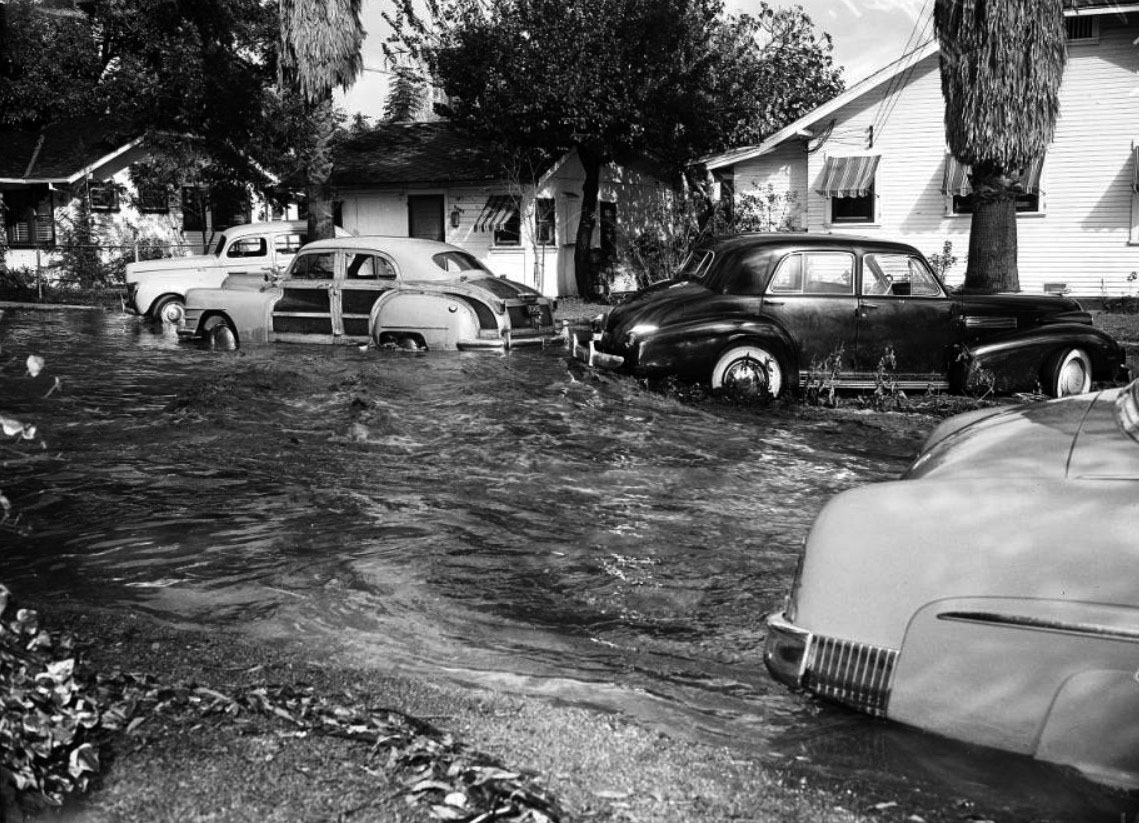 |
|
| (1952)^^ – View showing stuck cars as water rages down Tyrone Avenue near Sylvan Street. |
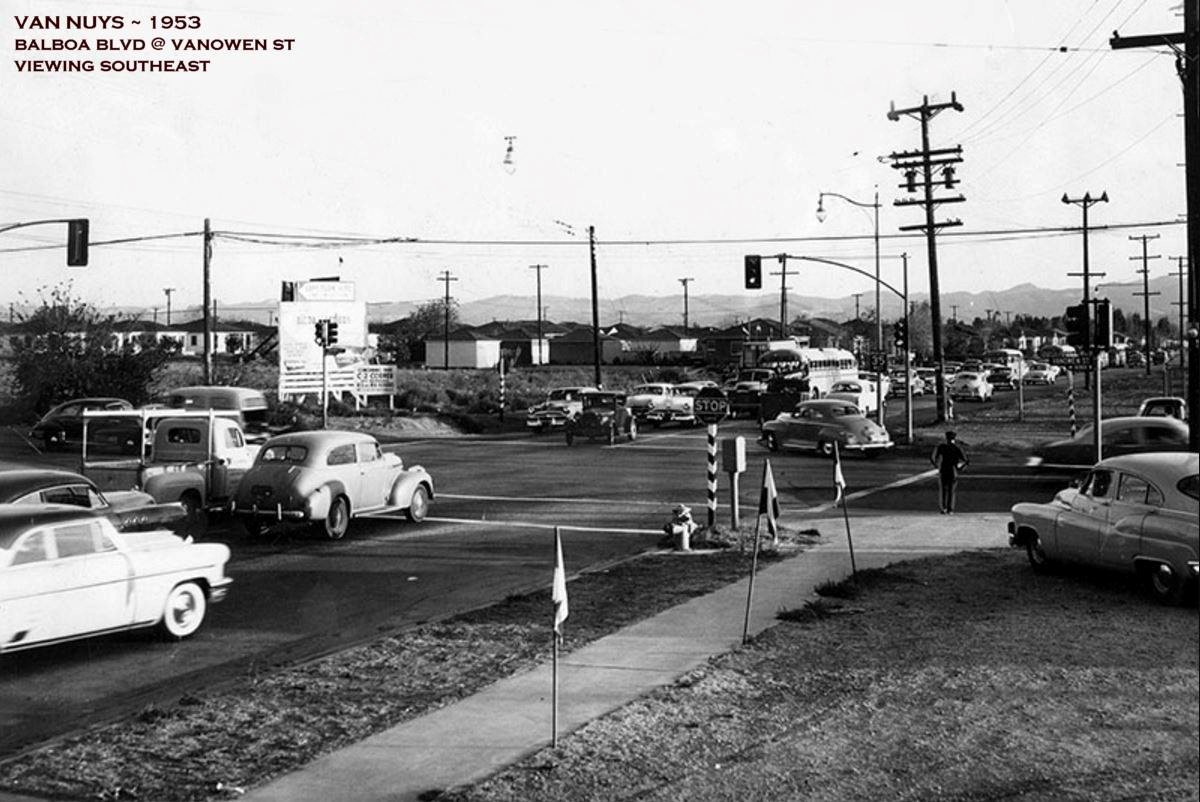 |
|
| (1953)#^*^ – View looking southeast showing the intersection of Balboa Blvd and Vanowen St in Van Nuys (Today - Lake Balboa). Caption reads: "Not too long ago - It seems like only months ago when corner of Vanowen street and Balboa boulevard was 'way out in the country.' This scene is another example of Five o'Clock Frustration that faces commuters daily Just try to make a left turn here!" |
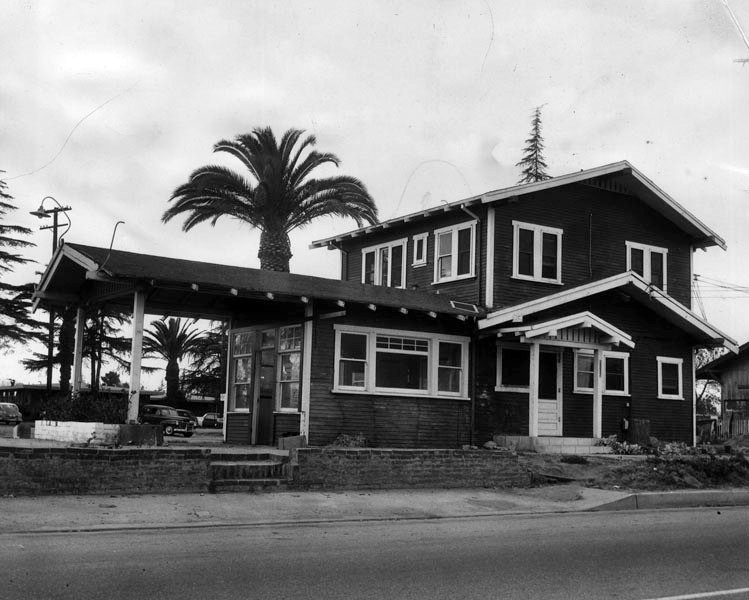 |
|
| (1954)* - Camera gets a last look at the old Van Nuys home built by Valley pioneer, George Beals, in 1909 at Sherman Circle and Van Nuys Boulevard. Site will soon be that of a new drive-in sandwich shop. Photo dated: December 2, 1954. – Valley Times |
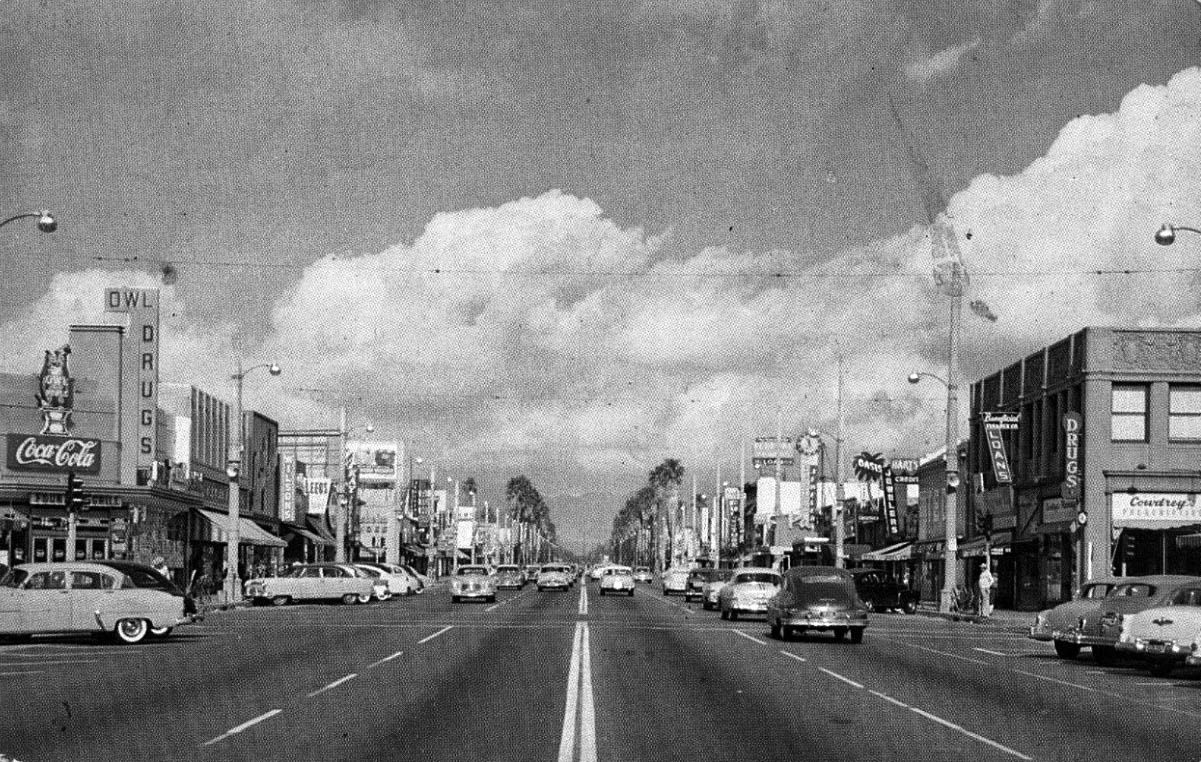 |
|
| (1950s)#^# – Postcard view looking north on Van Nuys Boulevard toward Friar Street with Owl Drug Store at the N/W corner. Across the street, on the N/E corner, stands Cowdrey's Pharmacy and the Beneficial Finance Company office. Behind that can be seen the signs for Hart’s Jewelers and the Oasis Club (see next photo). |
Van Nuys and Victory
 |
|
| (1954)* – View looking northwest over the intersection of Van Nuys and Victory on a very clear day. |
Historical Notes Valley Times photo captions reads: “Clear skies in Van Nuys - November, 1954. A 15-mile visibility could be seen with no smog in sight. The City had recently changed the home incinerator burning hours from morning to evening. Landmarks noted include Van Nuys High School, Saint Elisabeth Catholic Church, and the former VA hospital in Sepulveda.” |
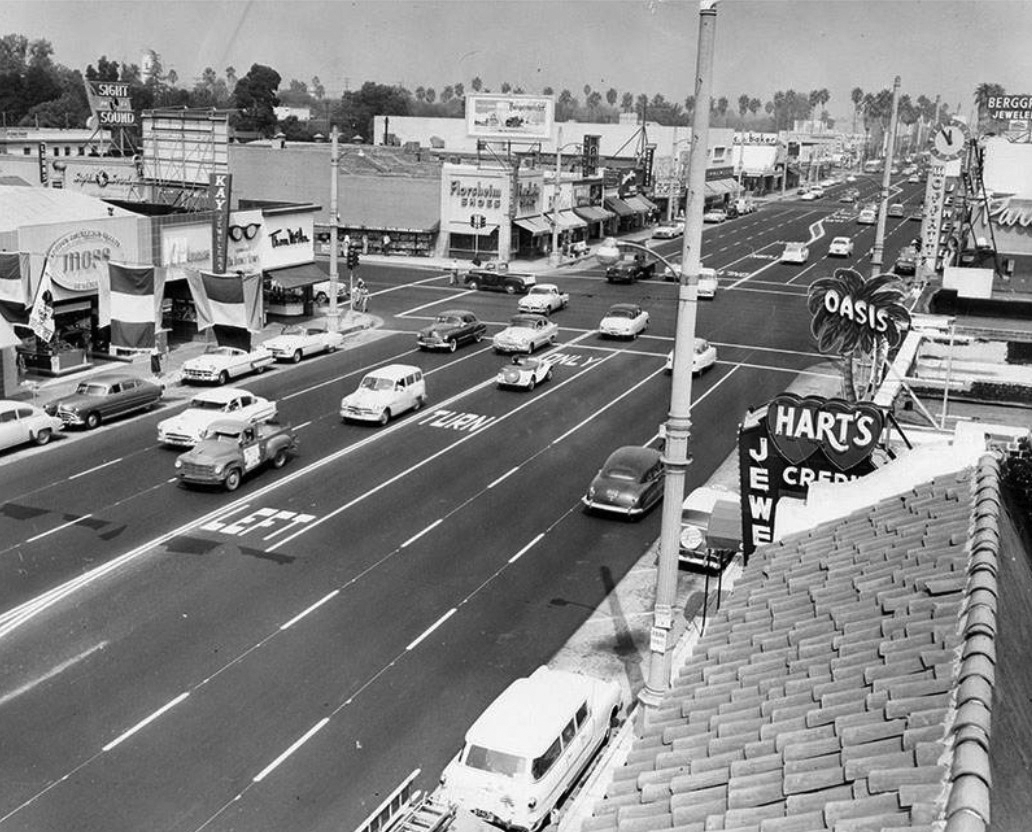 |
|
| (1955)++# – View looking north on Van Nuys at Victory Boulevard. Legible store signs include (R to L): Moss, Kay Jewelers, Tom McAn Shoes, Sight and Sound, Florsheim Shoes, Oasis, and Hart’s Jewelers. |
Historical Notes Photograph caption dated September 23, 1955 reads, "Special left turn only lanes, known as shadow lanes, are being used in Van Nuys on Van Nuys boulevard from Oxnard to Vanowen streets. This view is looking north on Van Nuys at Victory boulevard. Left turn lane is immediately to the left of normal center line. This is first time in Los Angeles such lanes have been painted on rather than constructed of raised concrete or bars." ++# |
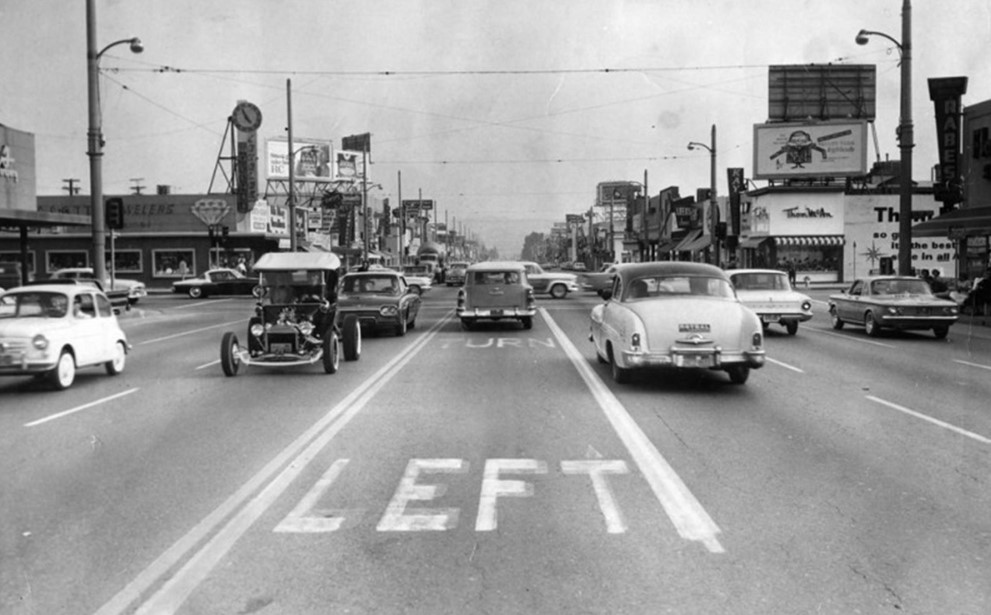 |
|
| (1962)* - Looking south on Van Nuys Boulevard at Victory Boulevard. |
Historical Notes Herald Examiner photo caption reads: ‘Said to be the busiest intersection in Los Angeles, it is a far cry from former years when traffic in Van Nuys was light’. |
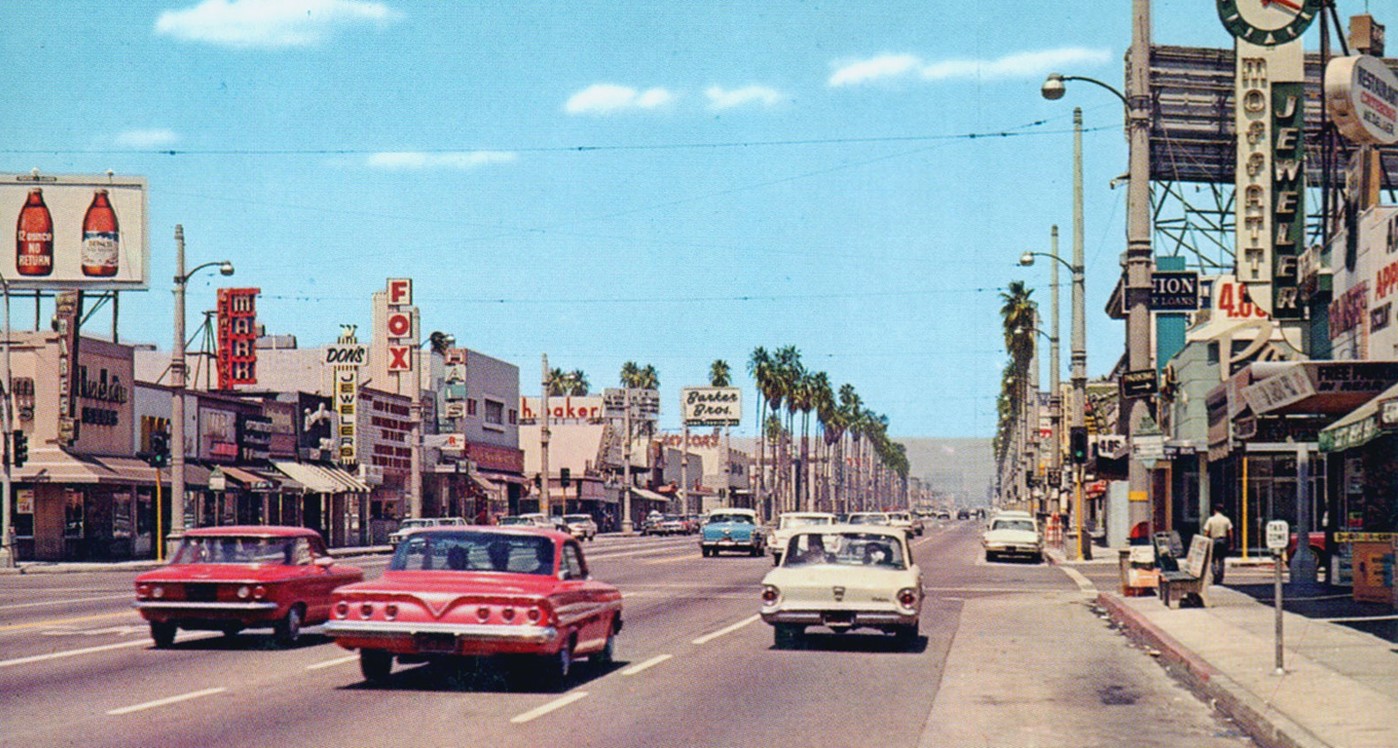 |
|
| (1960s)* - Looking north on Van Nuys Boulevard at Victory Boulevard with the Fox Van Nuys Theatre seen on the left (6417 Van Nuys Blvd). Photo courtesy of Valley Relics Museum |
Historical Notes During the 1960s, the commercial district along Van Nuys Boulevard continued to thrive. The boulevard was bustling with activity, with a wide range of shops, restaurants, and entertainment venues. Shopping centers, such as the Van Nuys Fashion Square, provided residents with convenient access to various retail options. |
Cupid's Hot Dogs (Van Nuys)
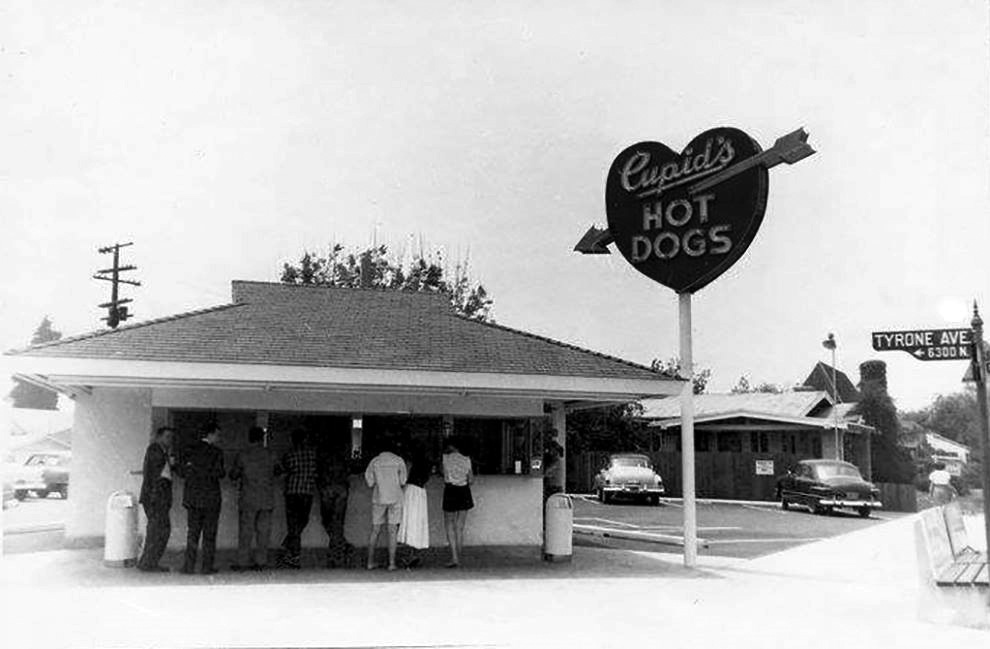 |
|
| (1950s)++^^ – View showing Cupid’s Hot Dogs on the southwest corner of Victory Boulevard and Tyrone Avenue in Van Nuys. |
Historical Notes Cupid's was originally established in 1946 as Walsh's Hot Dogs by Richard and Bernice Walsh. Shortly thereafter Richard changed the name to Cupid's; which was Bernice's nickname. For nearly 40 years Richard and Bernice ran the North Hollywood, Van Nuys and Canoga Park locations. In the early 80's their long haired surfer son Rick took over. 2009 brought on the 3rd generation of Walsh's to continue the Cupid's tradition. Sisters, Kelly and Morgan Walsh, have now taken the reigns.++^^ |
 |
|
| (1950s)+++ – View looking east showing two men in suits posing for the camera in front of Cupid’s located on the southwest corner of Victory Blvd and Tyrone Ave in Van Nuys. |
Historical Notes Today, there are the 3 locations still owned and operated by the original founding family: Canoga Park, Simi Valley, and Northridge. The Victory and Tyrone Cupid's seen above no longer exists. It’s now just a parking lot. |
Cupid's Hot Dogs (North Hollywood)
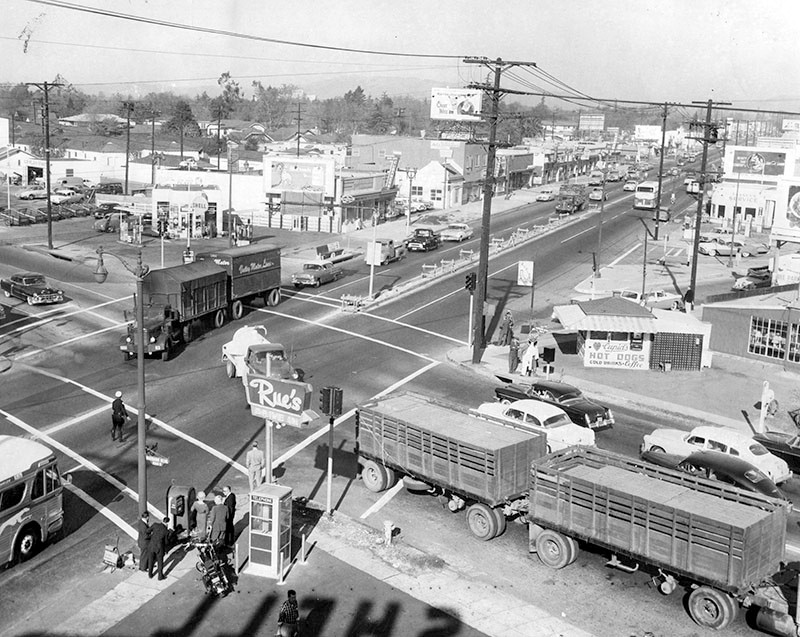 |
|
| (1956)* – View looking northwest showing the intersection of Lankershim and Burbank boulevards in North Hollywood. Cupid’s Hot Dogs stand is seen on the NE corner (center-right). Lankershim Blvd runs from lower-left to upper-right. |
Historical Notes Today, a Denny's Restaurant is located on the site where the Lankershim and Burbank Cupid's once stood. Click HERE for contemporary view. |
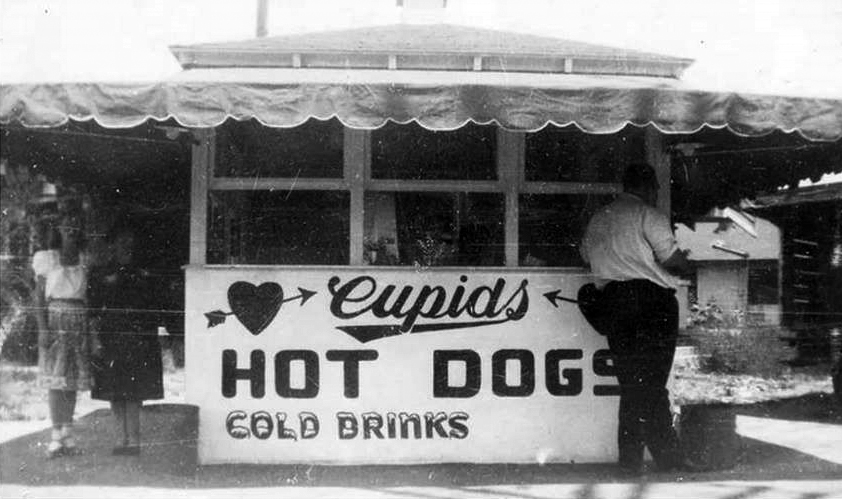 |
|
| (ca. 1950s)#^*^ - Close-up front view of the North Hollywood Cupid's Hot Dog stand located on the NE corner of Lankershim and Burbank blvds. Today, a Denny's stands at this location. |
* * * * * |
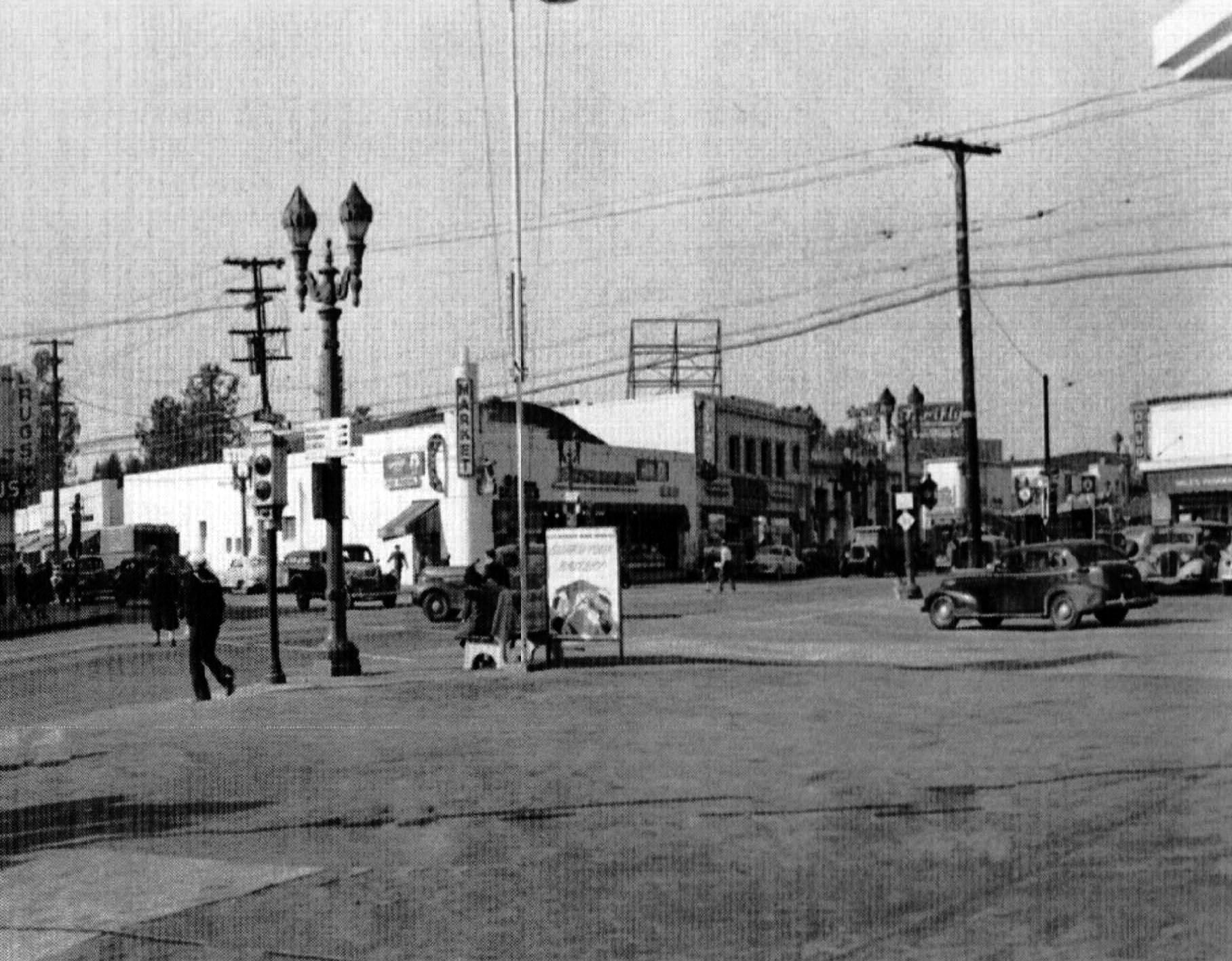 |
|
| (ca. 1945)^.^ – View looking northwest toward the intersection of Lankershim and Magnolia with Fitzsimmons Market on the NW corner. The 'Drugs' sign on the SW corner is for Merchants Pharmacy. There is also a Thrifty Drug Store north of the corner. Note the two-lamp streetlights have been darkened on top (WWII) |
Historical Notes During the War many streetlights throughout the City were blacked-out on top as a preventative measure. Click HERE to see more in Early Views of Los Angeles Streetlights. |
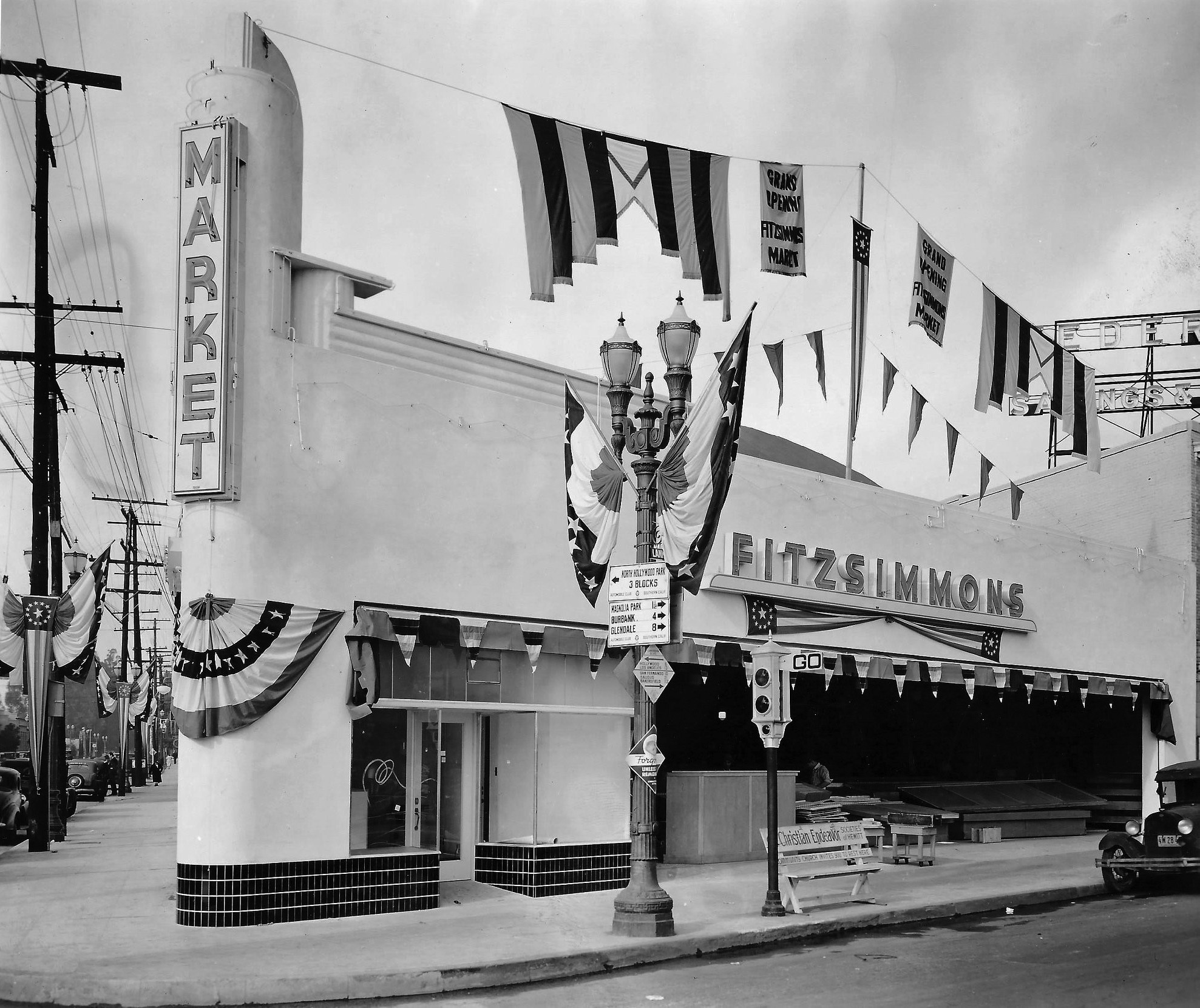 |
|
| (ca. 1940)^.^ - View looking at the NW corner of Lankershim and Magnolia showing Fitzsimmons Market being prepared for its Grand Opening. Note the semaphore traffic signal* standing by the beautiful dual-lamp streetlight (without black-out tops; pre-WWII)). Sign on streetlight reads: North Hollywood Park – 3 blocks with arrow pointing to the West. Lower part of sign points to the East and reads: Magnolia Park – 1½ Miles; Burbank – 4 Miles; Glendale – 8 Miles |
Historical Notes *These early signals, manufactured by the Acme Traffic Signal Co., paired “Stop” and “Go” semaphore arms with small red and green lights. Bells played the role of today’s amber or yellow lights, ringing when the flags changed—a process that took five seconds. |
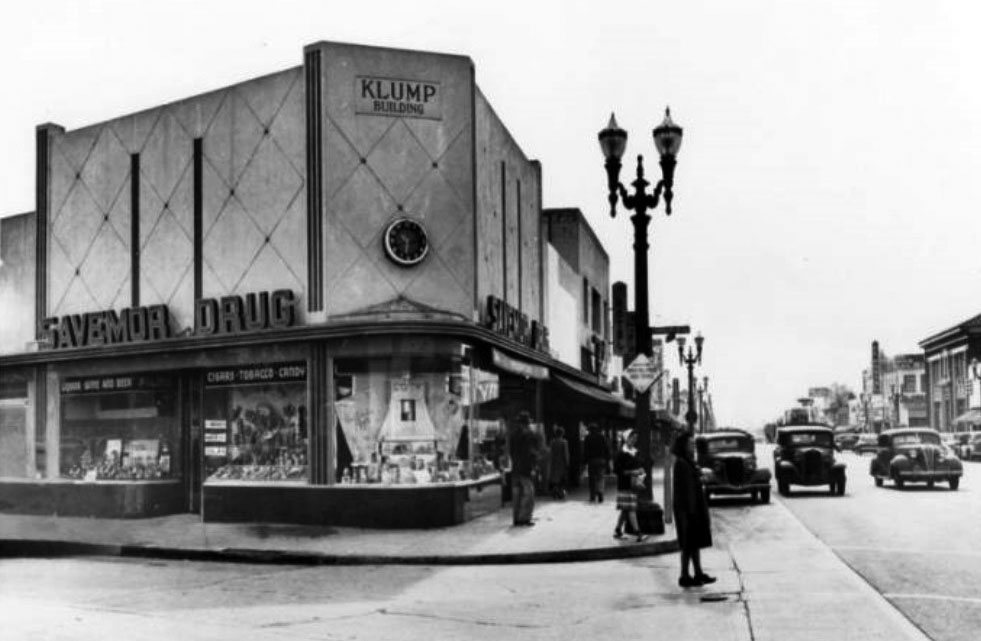 |
|
| (ca. 1946)* - View looking south on Lankershim Boulevard at Chandler Boulevard. Ornate two-lamp electroliers (without the black-out tops) line both sides of Lankershim. Pictured is the Klump Building on the southeast corner. Occupying the retail space is Savemor Drug which contains a window display for Coty cosmetics. Visible signage along Lankershim includes the El Portal Theatre and Thrifty Drugs. |
Historical Notes The Klump Building was demolished after sustaining damage in the 1994 Northridge Earthquake. See the intersection of Lankershim and Chandler in: 1891 / 1924 / 2018 |
.jpg) |
|
| (1942)* – Front view of the El Portal Theatre. Now playing: Take a Letter, Darling with Rosalind Russell and They All Kissed the Bride with Joan Crawford. To the right is the El Portal Pahrmacy with the Dr. Beauchamp Dentist Office on the second floor. |
Historical Notes The El Portal has a great history. It was the final theatre to be designed by prolific theatre architect Lewis Arthur Smith. Seating was provided for 1,346 on a single floor and the decorative style was Spanish Renaissance Revival. Movies, supported by a vaudeville show ran here for several years, until the arrival of talkies. Vaudeville played an important part in the first decades of El Portal, as live acts were used as added incentive to bring people in to see the newfangled silent pictures, starring the first stars of Hollywood, such as Charlie Chaplin, Buster Keaton and Laurel and Hardy. In fact, to measure an audience's response to their films, both Laurel and Hardy were known to frequent El Portal, slipping in after the audience was seated for showings of their own films. Oliver Hardy lived for many years nearby in Van Nuys, golfed at the in Toluca Lake, died in North Hollywood and is buried there. Harold Lloyd also used to listen to the laughter of audiences watching his films at El Portal. He and his brother were silent partners in the Shreves Filling Station, which was then on Lankershim across from the theater.* Click HERE to see more Early Views of the Portal Theatre. |
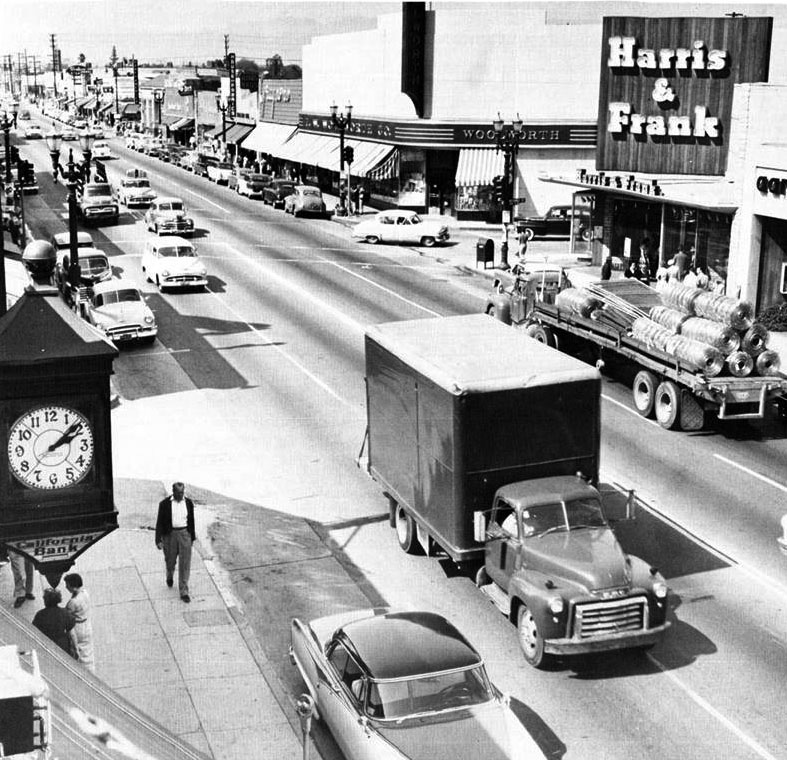 |
|
| (1950s)^.^ – View looking north on Lankershim Blvd from near Magnolia Blvd. Things got busy, where there were formerly orchards and a simpler life. Harris & Frank and Woolworth's can be seen at the intersection. |
Valley Times
 |
|
| (1947)* - Seen here is the main office for the Valley Times, which was located at 11109 Magnolia Blvd. in North Hollywood. Photograph caption reads, "Representing advancement in speeding up distribution of the Valley Times to the doorsteps of Valley readers, here is one of a new fleet of four 1948 Chevrolet pickup trucks to be used in faster delivery of America's fastest growing daily to all points in the Valley." |
Historical Notes Even before large daily newspapers were widely circulated in the San Fernando Valley, residents had many places to turn for news. In the 1880s, it was The San Fernando Comet and the Burbank News. In the 20th Century, they could catch up on local happenings with such community newspapers as San Fernando Valley Press, San Fernando Valley Reporter, San Fernando Valley Journal, Sylmar Breeze, Sherman Oaks Sun, Studio City Graphic, Encinian and Woodland Hills Reporter.^^^ While the newspaper building seen above was later demolished and replaced with a large apartment complex, many of the commercial buildings seen across Magnolia Blvd. (left of center) remain standing.* |
Mosher Tire Service
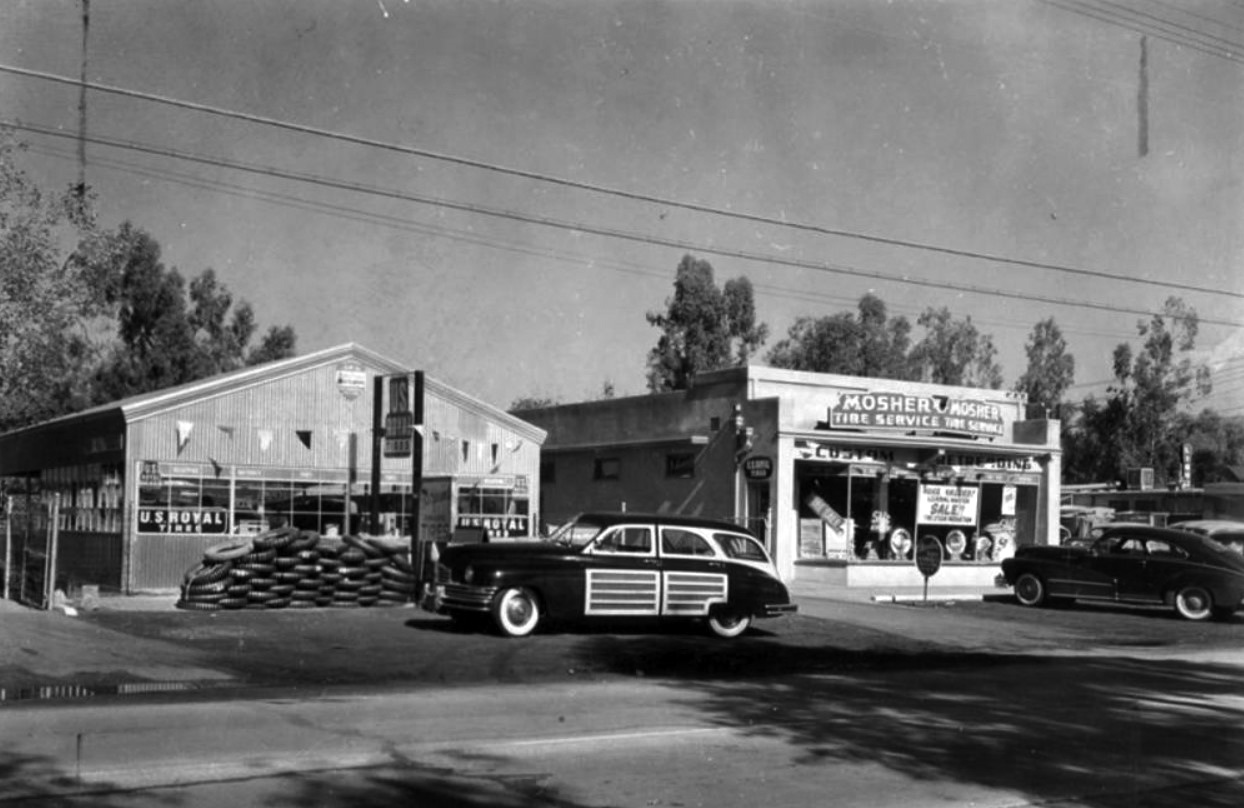 |
|
| (1950)* – Mosher Tire Service located 12117 Burbank Boulevard in North Hollywood. Photograph caption dated February 2, 1950 reads "U. S. Royal North Hollywood distributor announces the 'Mid-Century' featuring greater traction and 'scuff-proof' white sidewalls." |
Historical Notes Originally located at 1534 N. Cahuenga Boulevard in Hollywood, Lewis Dean Mosher moved his business to this location in 1942. After retiring his son, Merill, operated the business until he also retired. The original structure on Burbank Blvd is no longer there, but the house next door, where Lewis Dean and his wife lived starting in 1927, is still there. Click HERE for Contemporary View. Click HERE to see original Hollywood location. |
Foodtime Market
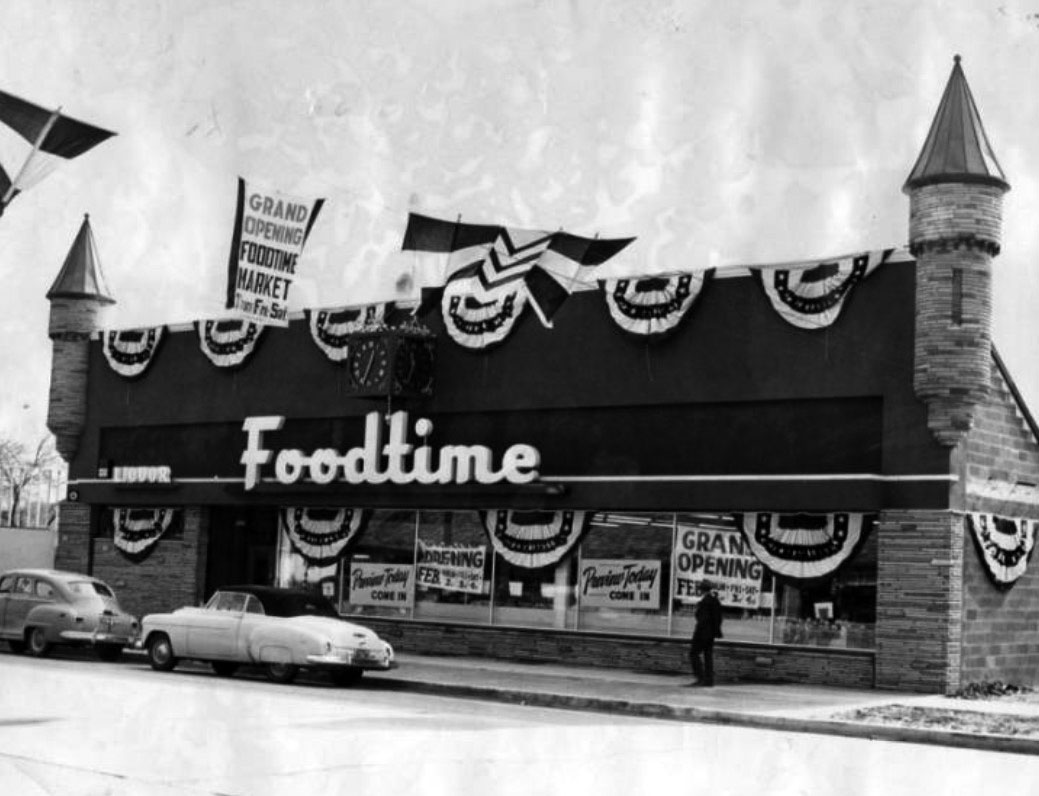 |
|
| (1950)* - Grand Opening of Foodtime Market located at 12450 Magnolia Boulevard in North Hollywood. |
Historical Notes The Foodtime Market grocery store, located in the turreted building now occupied by the Valley Village post office, was the largest business in the historic district and operated from 1950 until sometime in the late 1960s.^ |
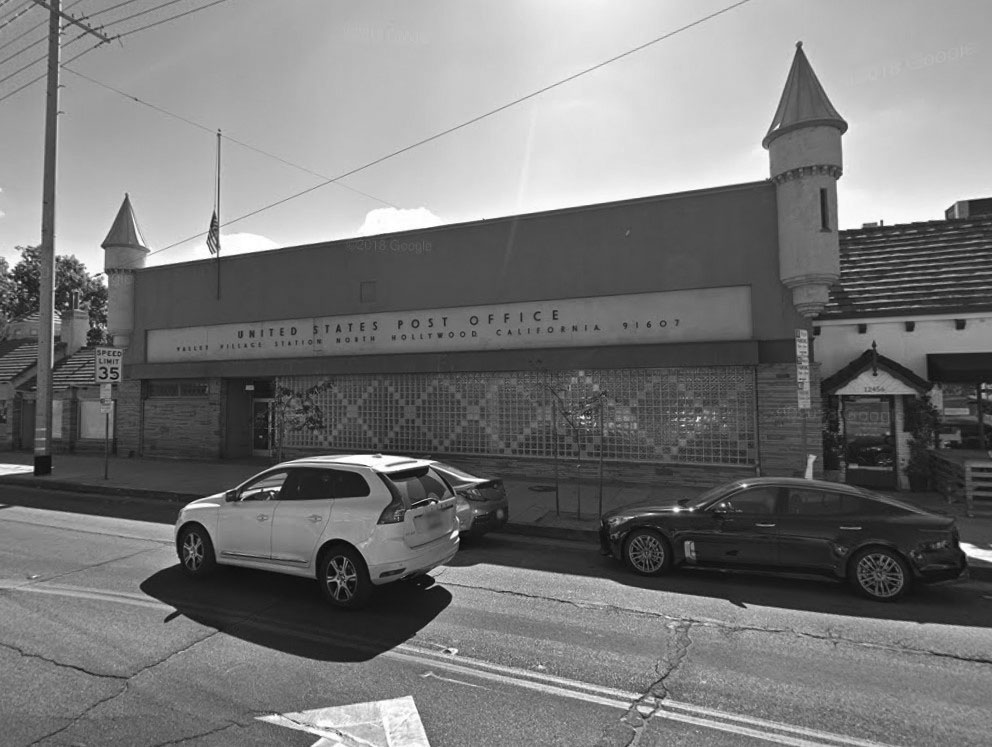 |
|
| (2018)** - Formerly the location of Foodtime Market, 12450 Magnolia Blvd, Valley Village, is now home to the Valley Village* Post Office. |
Historical Notes VALLEY VILLAGE – The history of Valley Village went back to the 1930s, when workers at nearby motion picture studios built houses there. The local post office on Magnolia Boulevard canceled all mail with a "Valley Village" postmark. It was, however, officially a section of North Hollywood. The idea of separating Valley Village from North Hollywood was brought into public light with a meeting of about 300 homeowners at Colfax Avenue Elementary School in December 1985, yet it wasn't until 1991 that Valley Village got seven new blue reflective markers from the city of Los Angeles to mark its borders. |
Bay's Market
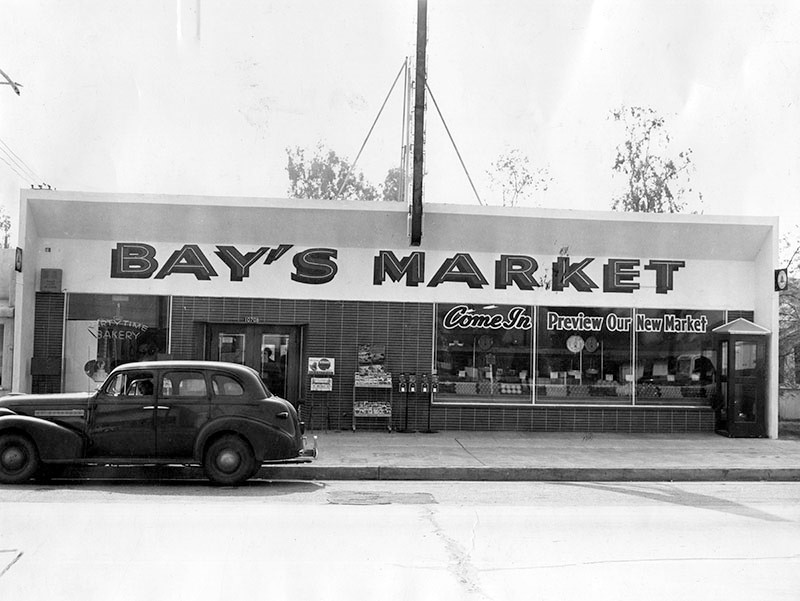 |
|
| (1950)* - Photograph caption dated February 24, 1950 reads "Three day celebration of opening of Bay's new supermarket, 10708 Magnolia Blvd., North Hollywood, will be climaxed at 2 p.m. tomorrow by trick riding of Janice Hays on the pinto pony Dixie." |
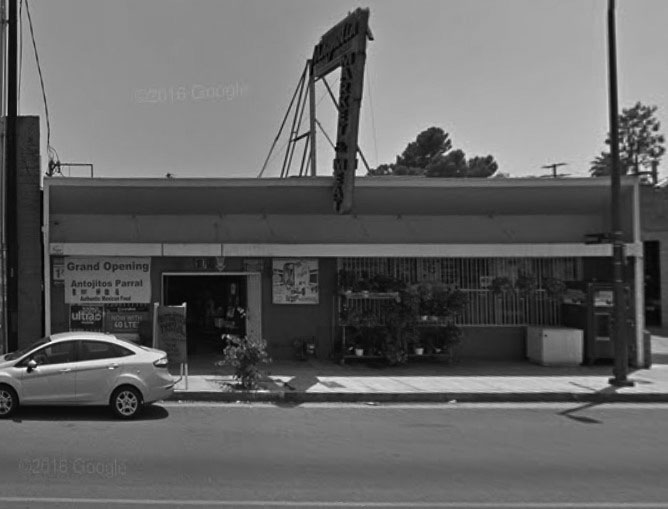 |
|
| (2016)#*^# – Google street view showing the Magnolia Market (formerly Bay's Market) at 10708 Magnolia Boulevard featuring Antojitos Parral, a small Mexican food eatery. |
Rathbuns Department Store
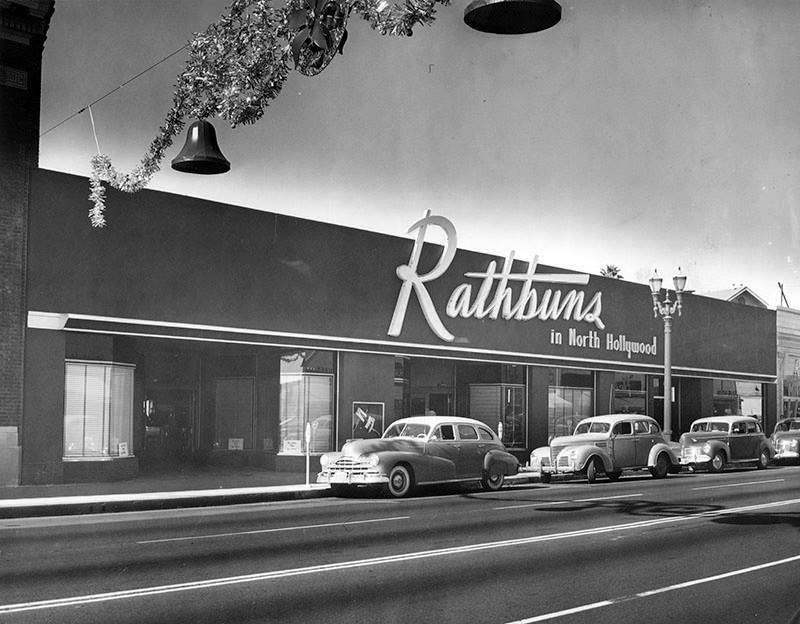 |
|
| (1940s)^.^ - View showing the Rathbuns Department Store, 5311 Lankershim Boulevard, North Hollywood. |
Historical Notes For more than 50 years Rathbun's Department Store was key shopping location in the San Fernando Valley. Established before malls, Rathbun's was one of the few high style stores in the Valley. Shopping downtown Los Angeles was an occasion for holidays. Hall Rathbun started the store on Pico Boulevard (near where the Staples Center is today) in the early 20th century and moved it to North Hollywood around 1914. In 1972, Rathbuns was sold to Nahas Department Stores, which didn’t last too many years after that.^ |
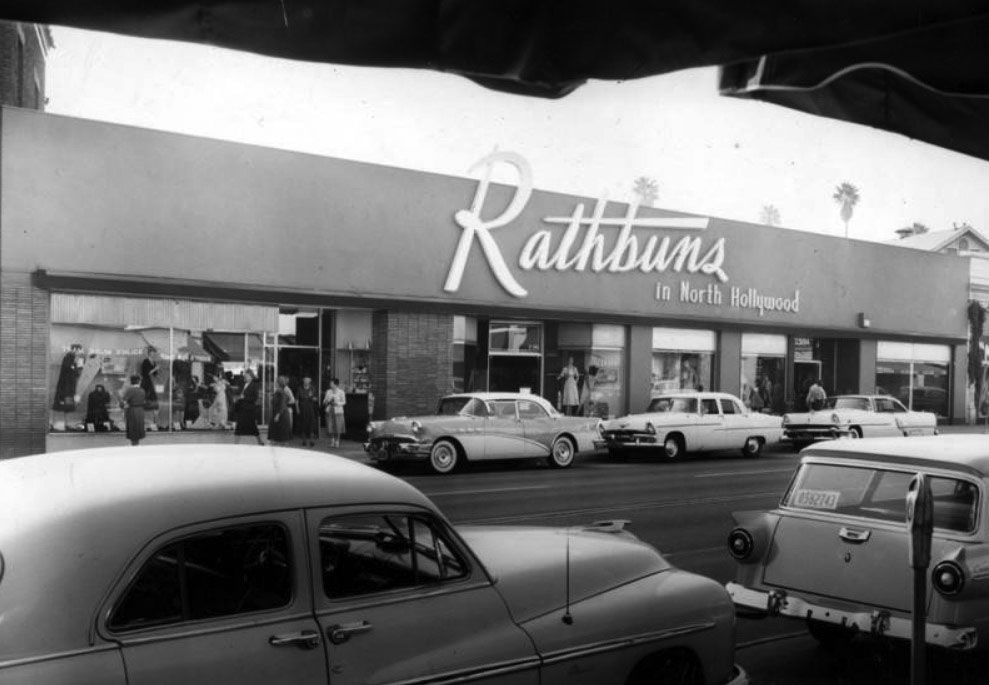 |
|
| (1957)* - View showing the newly remodeled Rathbuns Department Store located at 5311 Lankershim Boulevard. |
Historical Notes Interesting facts: Amelia Earhart bought her clothes and shoes there. Raquel Welch worked with her mom on the switchboard for a while.^ |
* * * * * |
North Hollywood Pacific Electric Station
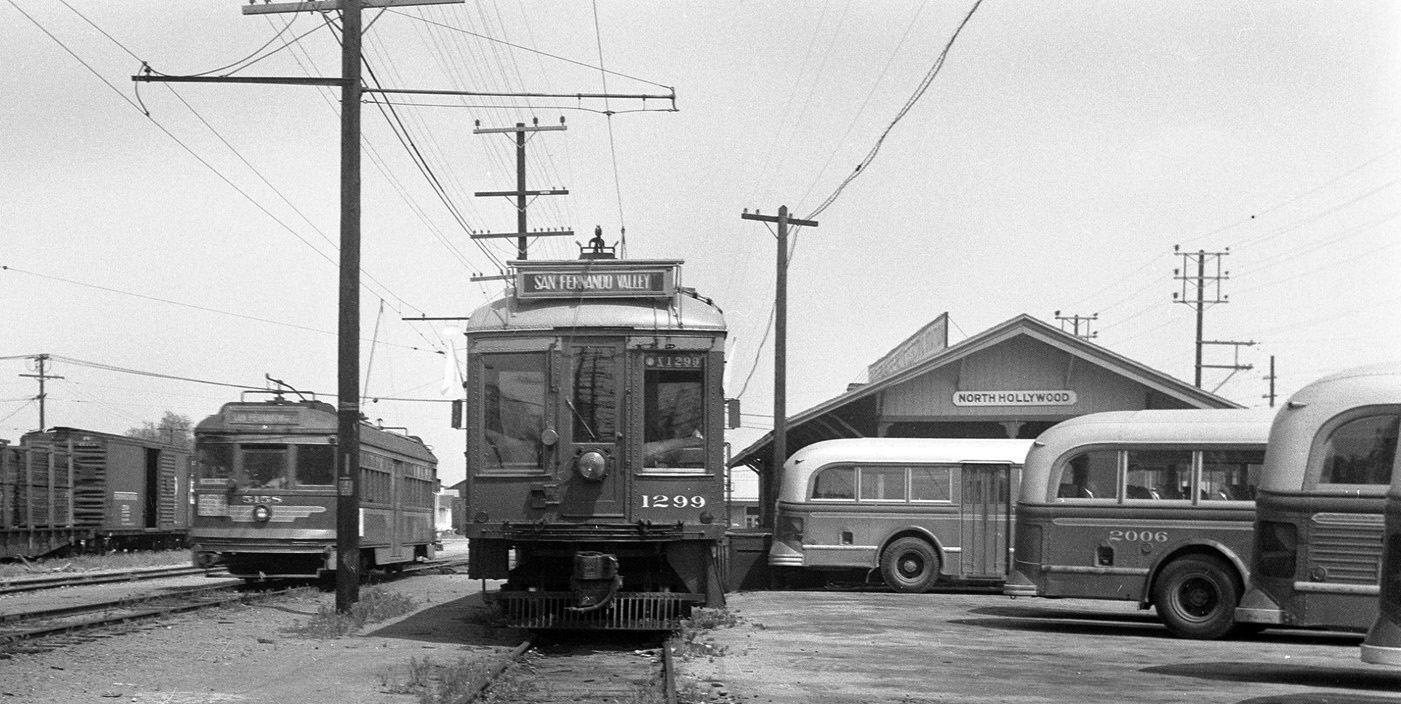 |
|
| (ca. 1950)* - North Hollywood Pacific Electric Station with a Van Nuys bound Red Car on the far left, executive car 1299 center, a gaggle of white buses on the right and the station in the background. |
Historical Notes The station still stands and is in use as a coffee house. It is located at Lankershim and Chandler Boulevards. The former Southern Pacific Railroad right-of-way along Chandler has been converted into a bus rapid transit line. |
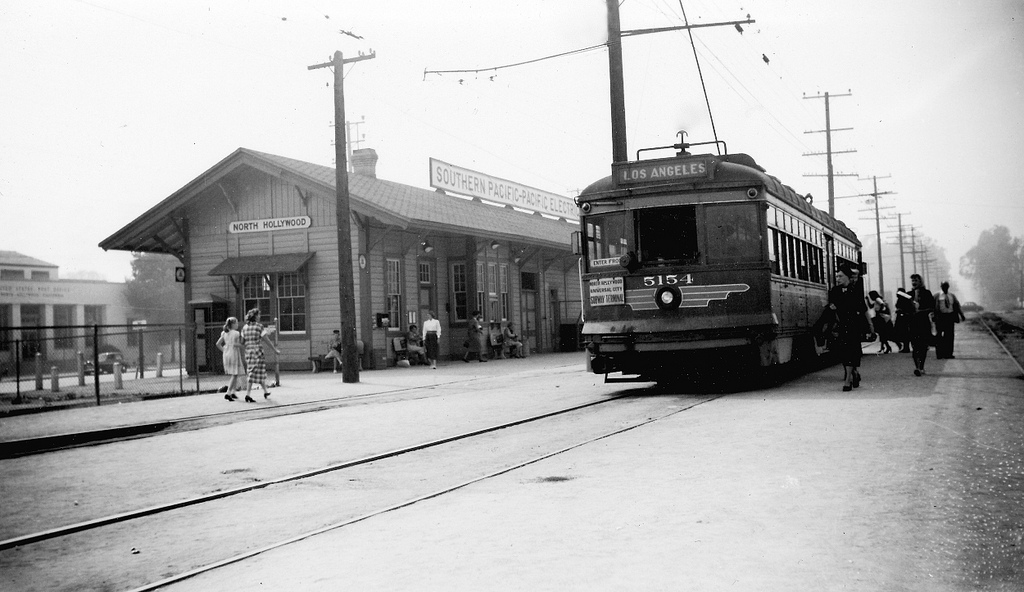 |
|
| (1952)*^^ - Riders queue for the Van Nuys line Red Car at the North Hollywood Pacific Electric Railway station. |
Historical Notes When it first opened in 1895, the train depot at the corner of Lankershim Boulevard and Chandler Boulevard was crucial to the rapid growth of the town that was first called Toluca, then Lankershim, and finally, North Hollywood. The depot still stands today, is one of the oldest existing structures in the San Fernando Valley. It has been named a cultural and historic monument by the city of Los Angeles and is slated to be restored.^*# Click HERE to see earlier views of the above station, when it was called Lankershim Station. |
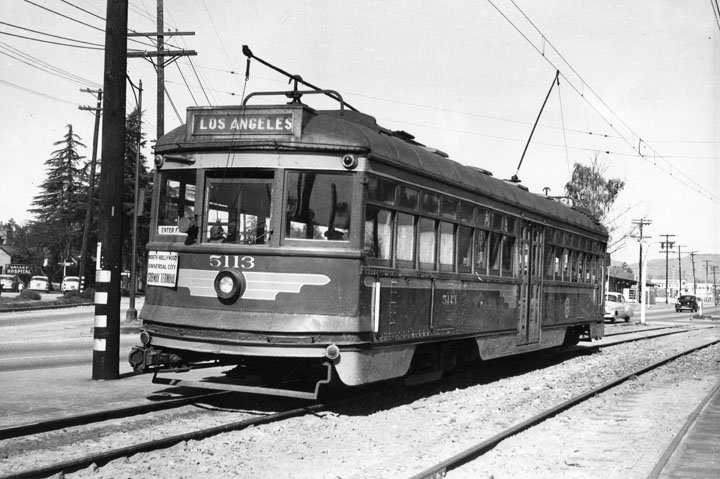 |
|
| (ca. 1952)* - A Los Angeles-bound Pacific Electric Railway car on Sherman Way. |
Historical Notes The line ran from North Hollywood through Universal City to the Subway Terminal Building in downtown Los Angeles.* |
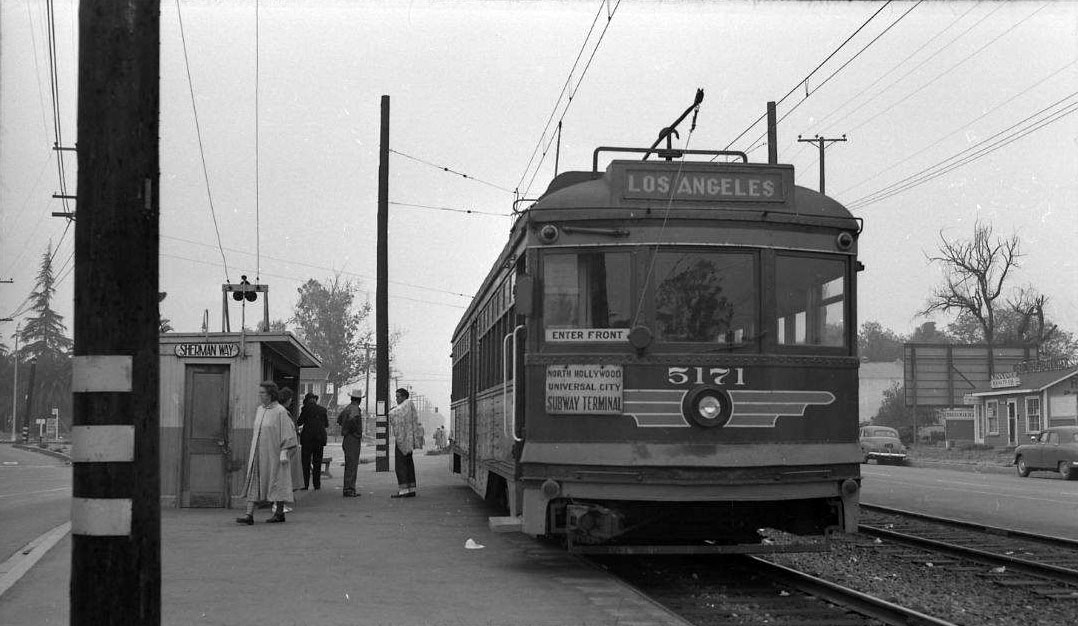 |
|
| (1951)#^*^ - Pacific Electric Red Car No. 5171 stopped on Van Nuys Boulevard near Sherman Way. View is looking north with the Sherman Way curve seen on the left. Sighn on front reads: NORTH HOLLYWOOD - UNIVERSAL CITY - SUBWAY TERMINAL |
Historical Notes Operation of the Pacific Electric Red Car through to Owensmouth and San Fernando began in 1911 and was terminated in 1938; thereafter the terminus was at Van Nuys Boulevard and North Sherman Way. On December 28, 1952, busses over the Hollywood Freeway replaced all rail service to the San Fernando Valley on this line.^***^ |
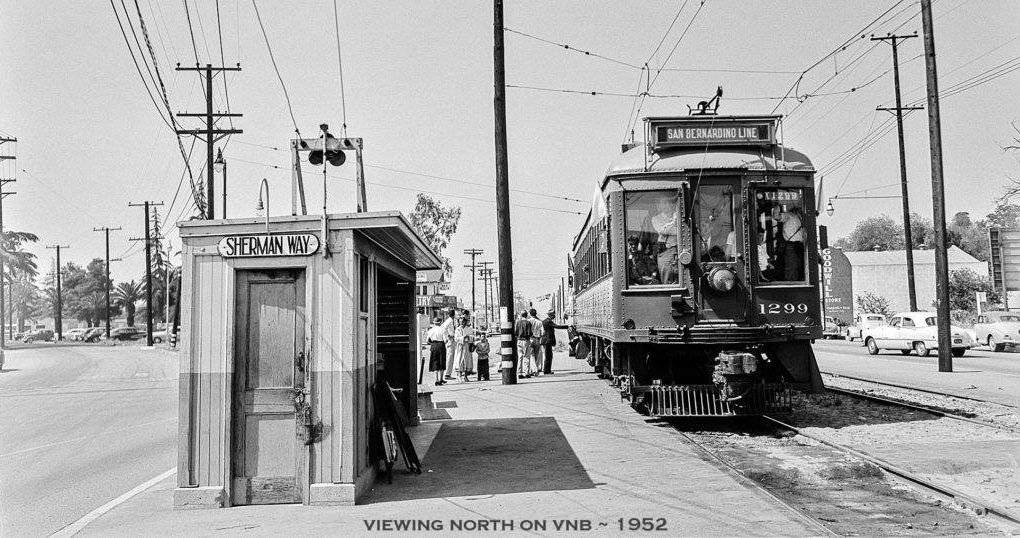 |
|
| (1952)#^*^ - Viewing looking north on Van Nuys Boulevard from Vose Street showing Pacific Electric No. 1299. The Sherman Way curve can be seen on the left. Appears as though some Fun is being played on the photographer ... with the roller sign displaying San Bernardino!! Credits: Fred V. DuBritz Photo, Michael Patris Collection ~ "Pacificelectric.org" |
.jpg) |
|
| (1952)**^^^ – View looking north on Van Nuys Boulevard showing a Pacific Electric Red Car bound for Los Angeles. The Rivoli Theatre is seen to the right of the streetcar. The Rivoli was later renamed the Capri and got demolished (for a parking lot) in the early 70s. Photo courtesy of Sean Ault Archives by Osiris Press. |
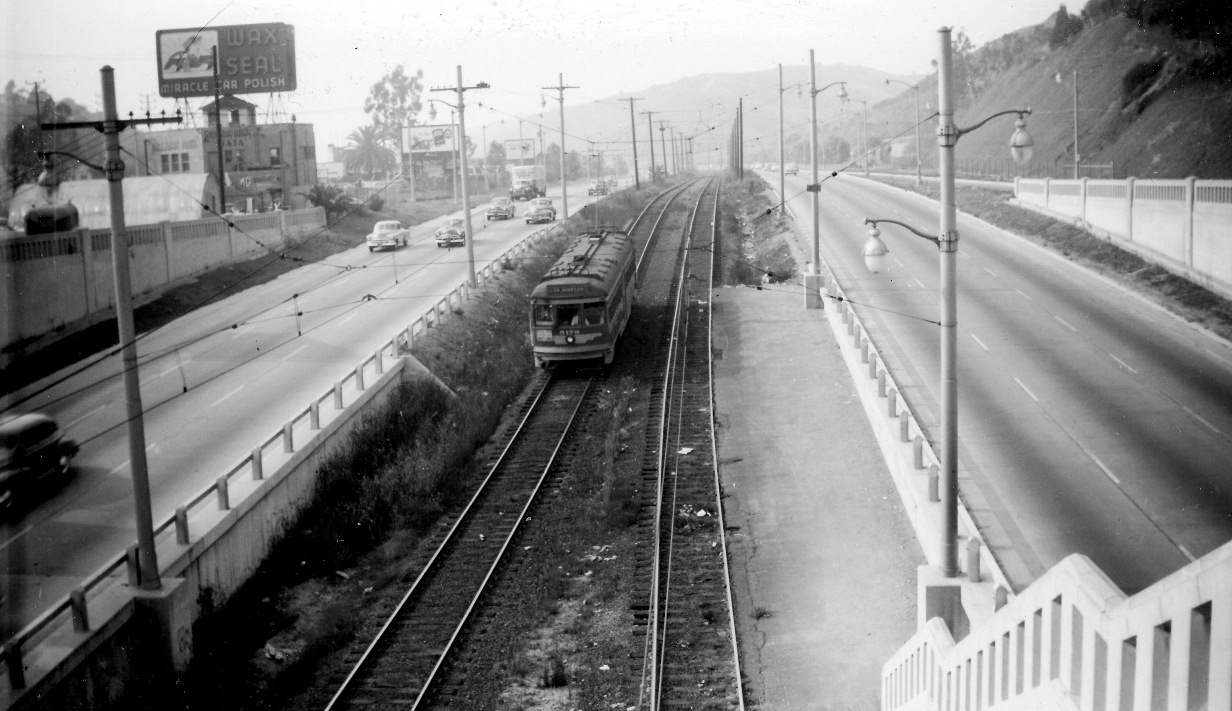 |
|
| (1952)^*** - A Pacific Electric Red Car headed south in the median of the Hollywood Freeway near Barham. |
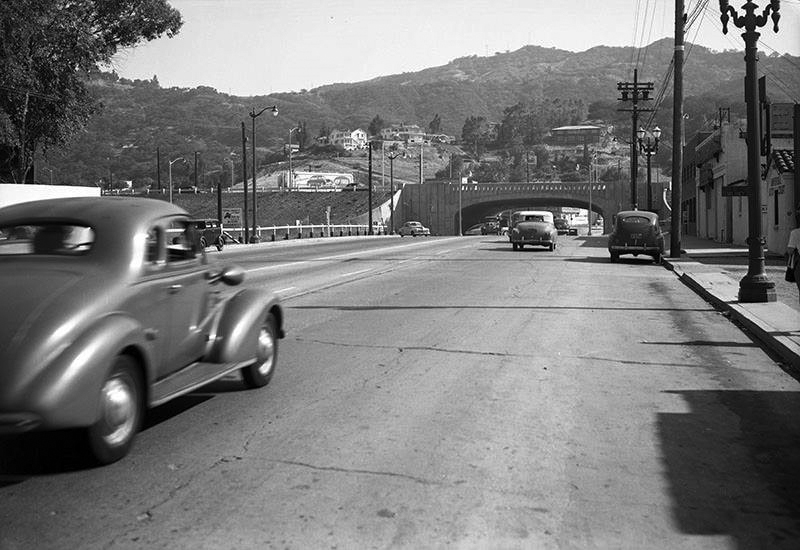 |
|
| (1949)* – View looking south on Lankershim Boulevard towards what is now called the Lankershim/101 Freeway Bridge and Tunnel. |
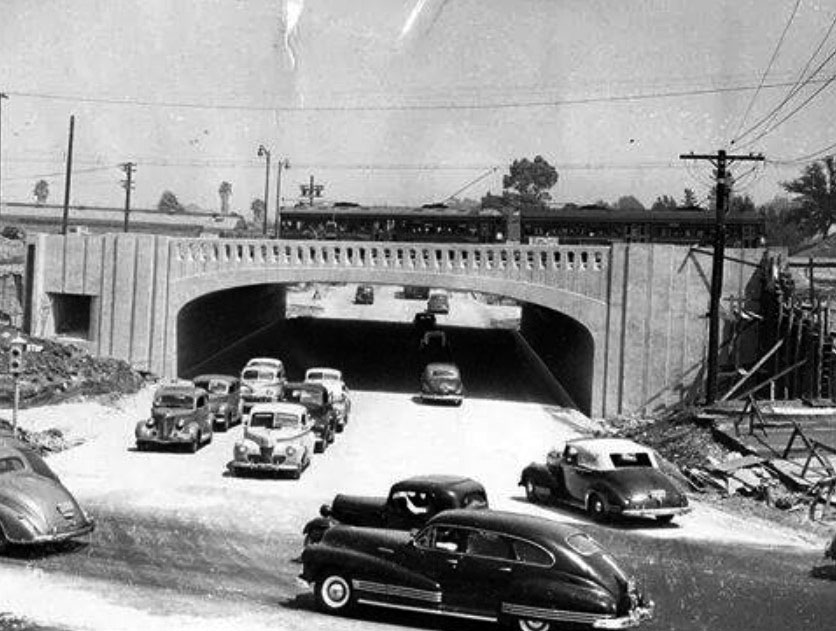 |
|
| (ca. 1949)*^*# – View of the Lankershim Boulevard underpass at the Hollywood Freeway, showing two Pacific Electric Red Cars passing each other above. |
Then and Now
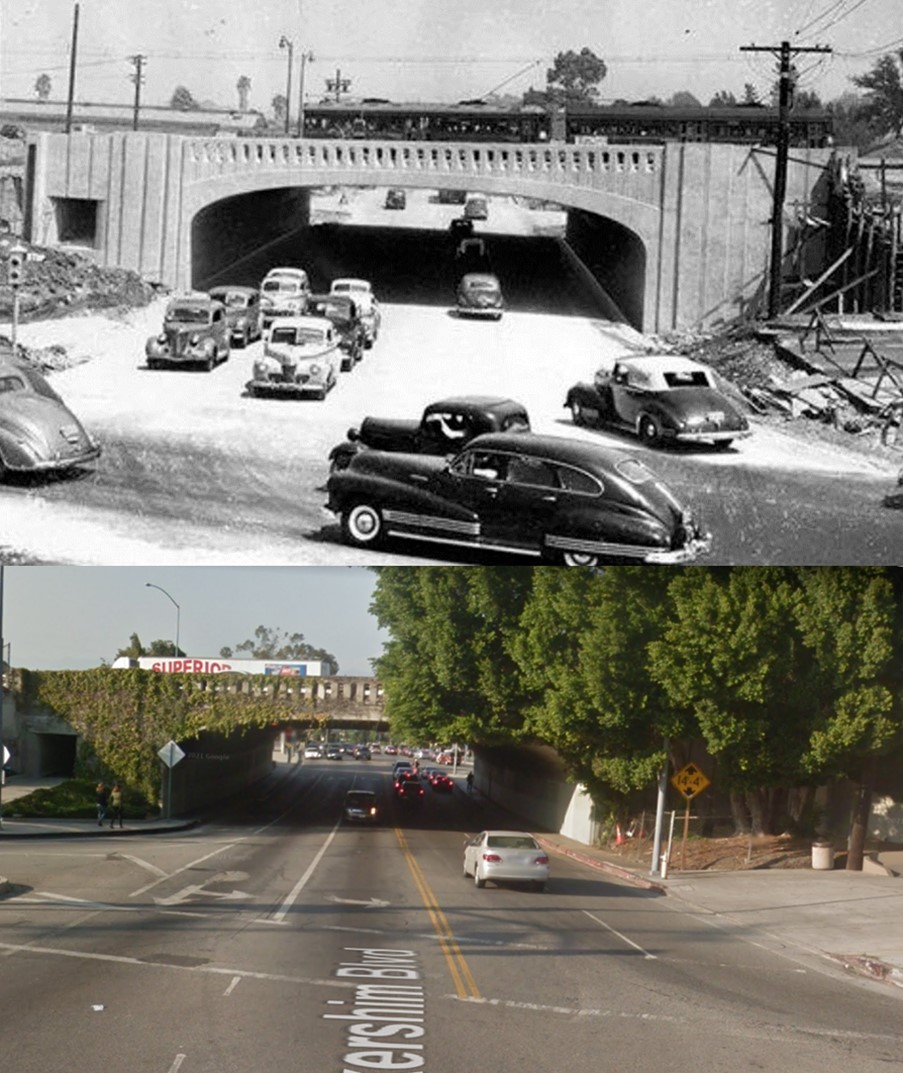 |
|
| (1949 vs. 2014)* – View of the Lankershim Boulevard underpass at the Hollywood Freeway. View is looking North. |
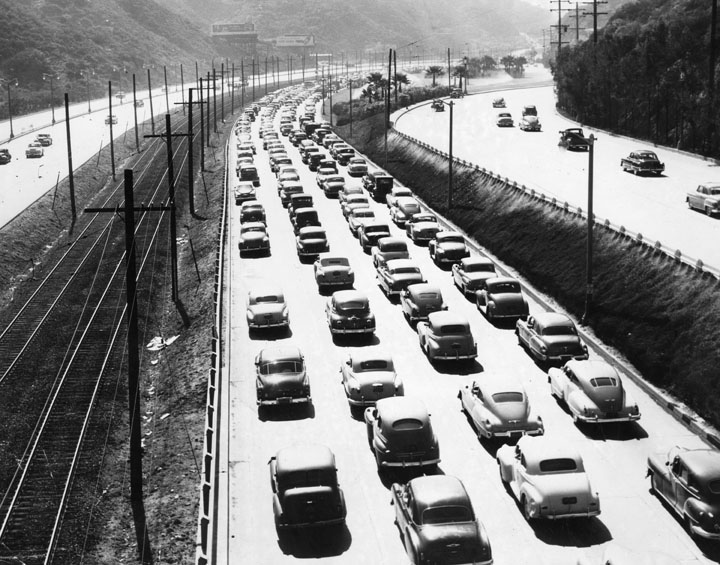 |
|
| (1948)* - View of the Cahuenga Pass in 1948 showing one road of cars end to end with tracks seen on the left. |
Historical Notes Pacific Electric Railway trolleys ran down the center of the Hollywood Freeway through Chauenga Pass until 1952.*^ |
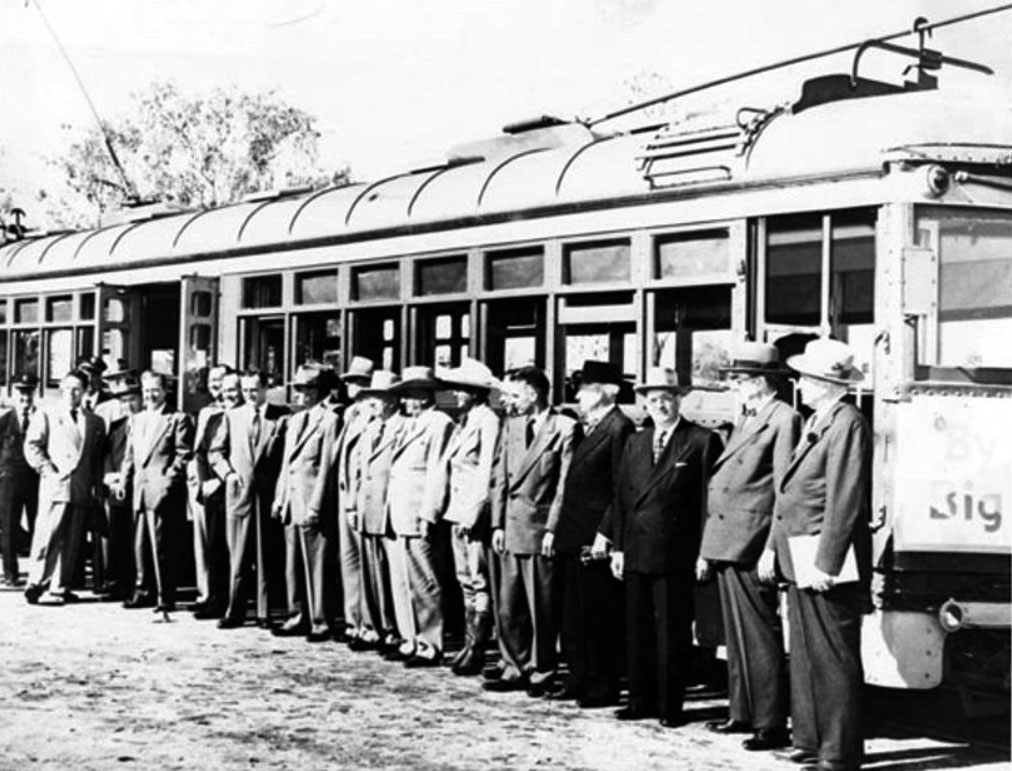 |
|
| (1952)^ - Saying goodbye to "Big Red". View showing a group of men standing in front of the last Red Car in the San Fernando Valley. Right: Fred Weddington, he rode the first and last Red Car. Moses Sherman, President of Pacific Electric Car Line, Martin Pollard, first Fernando Service Award, 1959, Paul Whitsett, Richard Gilbranson, President of North Hollywood Chamber of Commerce, Monty Montanta, cowboy movie star. Far Left: Ferd Mendenhall, owner of Green Sheet Journal (now Daily News). |
* * * * * |
Cahuenga Pass Extension to Vineland
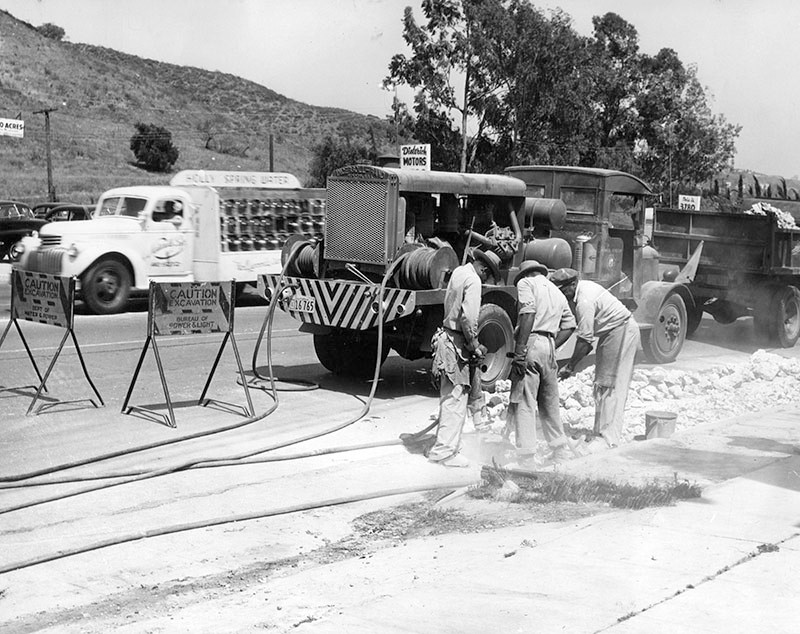 |
|
| (1947)* - Photo caption dated June 14, 1947 reads, "Extension of the Hollywood freeway along Ventura boulevard to Vineland avenue started with the thunder of air-hammers at Universal City, as the last cars to use the intersection of Lankershim and Ventura boulevard whizzed by in back of the workmen. A detour soon will go around the intersection." |
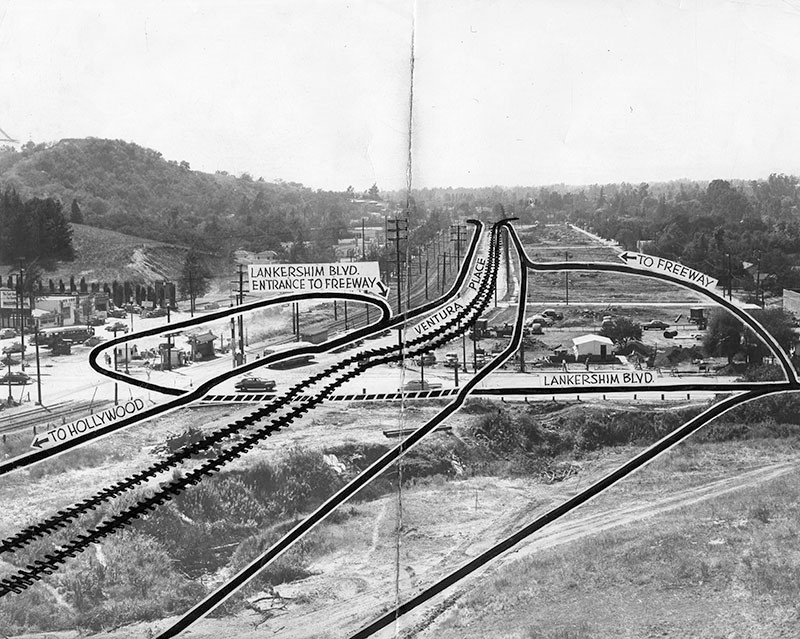 |
|
| (1947)* - Photograph caption dated July 12, 1947 reads, "Most complex part of the new freeway link connecting Vineland avenue and Cahuenga Pass will be at Universal City, above, where a grade separation will be constructed over Lankershim boulevard. |
Historical Notes This Valley Times photo-diagram shows where rail lines will be relocated down the center of the new freeway link. Traffic leading into the Valley will follow the lane on the right of the tracks; that leading to Hollywood will stream down a parkway at the left of the rail lines. Lankershim boulevard traffic onto the freeway's Hollywood-bound lane will go under the freeway and rise on a looped ramp as shown at left. Lankershim traffic into the Valley-bound freeway lane will follow the road at upper right. To get onto Lankershim from the right hand freeway lane, cars will use the road shown in right lower foreground. |
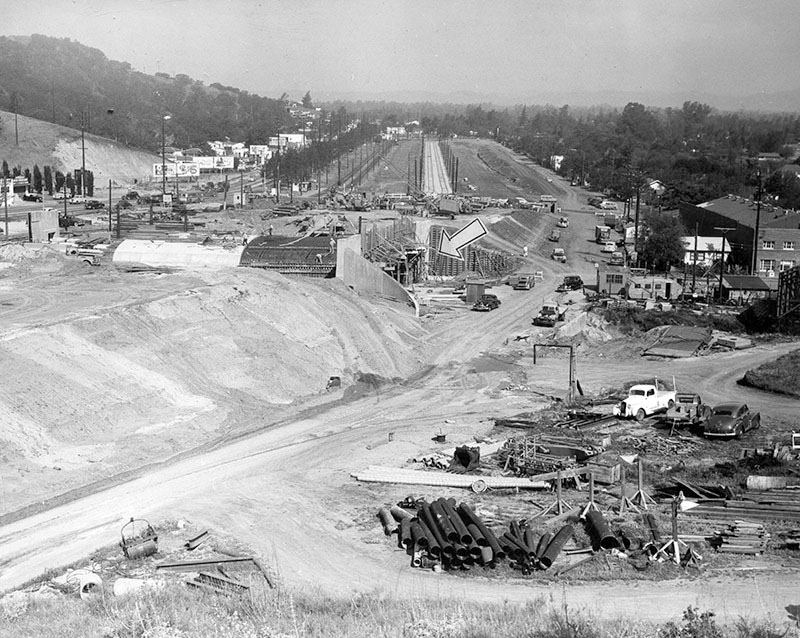 |
|
| (1948)* - Photograph dated May 8, 1948 shows the construction of a freeway underpass at Lankershim and Cahuenga boulevards. The project is part of the extension of the Hollywood Freeway connecting Vineland Avenue and the Cahuenga Pass. |
Historical Notes The bridge/tunnel was built as part of the Cahuenga Freeway; it is now known as the Lankershim/101 Freeway Bridge and Tunnel. |
 |
|
| (1948)* - View showing paving of Hollywood Freeway lanes that extend from the Cahuenga Pass to Vineland Avenue. In between the freeway lanes are electric lines used by Pacific Electric trains. Photo date: November 10, 1948 |
 |
|
| (1948)* - Aerial view of the Hollywood Freeway extension from Barham Boulevard to Vineland Avenue. Universal City is seen to the right of the freeway, and Studio City to the left. Phote date: November 14, 1948 |
* * * * * |
Cahuenga and Lankershim
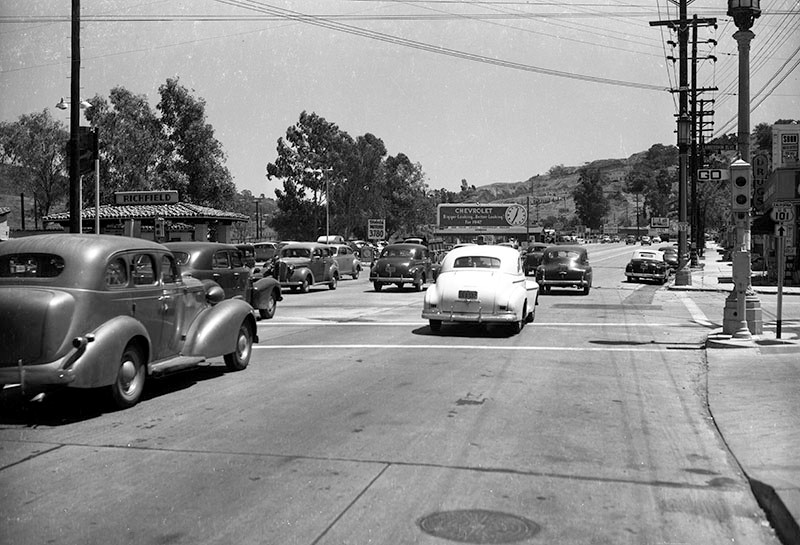 |
|
| (1947)* - Looking southeast down Cahuenga Boulevard, from just west of where it crosses Lankershim Boulevard (center). Seen, from left to right, are a Richfield service station, Dieterich Motors used car lot, a Foster and Kleiser billboard advertising 1947 Chevrolet automobiles, homes up in the hills, the Tasty Nook Cafe, and various other businesses. Photograph dated August 1, 1947. |
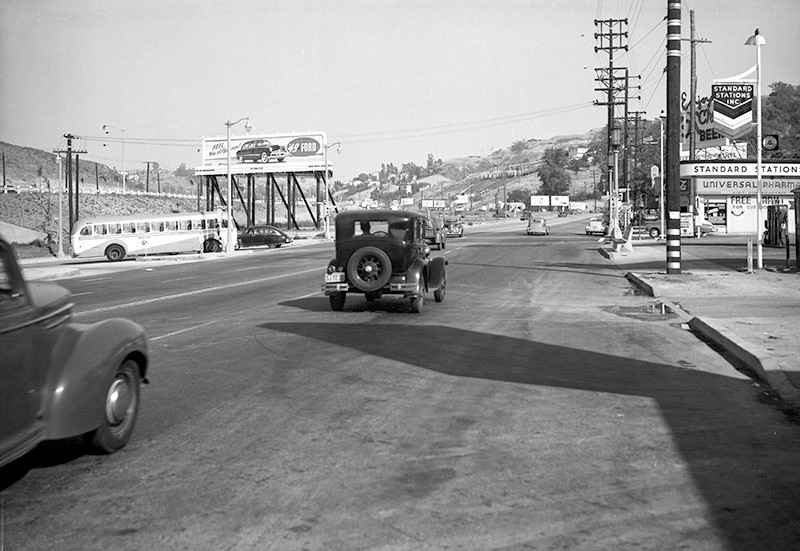 |
|
| (1949)* – View looking southeast down Cahuenga Boulevard, from just west of where it crosses Lankershim Boulevard (center). Seen, from left to right are the Lankershim Bridge and Tunnel (only partially visible), a Foster and Kleiser billboard advertising the 1949 Ford automobile (left), homes up in the hills, a Rexall drugstore and a Standard oil service station. Photograph dated June 23, 1949. |
Historical Notes The bridge/tunnel was built in 1948 as part of the Cahuenga Freeway; it is now known as the Lankershim/101 Freeway Bridge and Tunnel. The corner where the billboard is seen (left of center) was named Yitzhak Rabin Square in 1995 in honor of the slain Israeli Prime Minister.* |
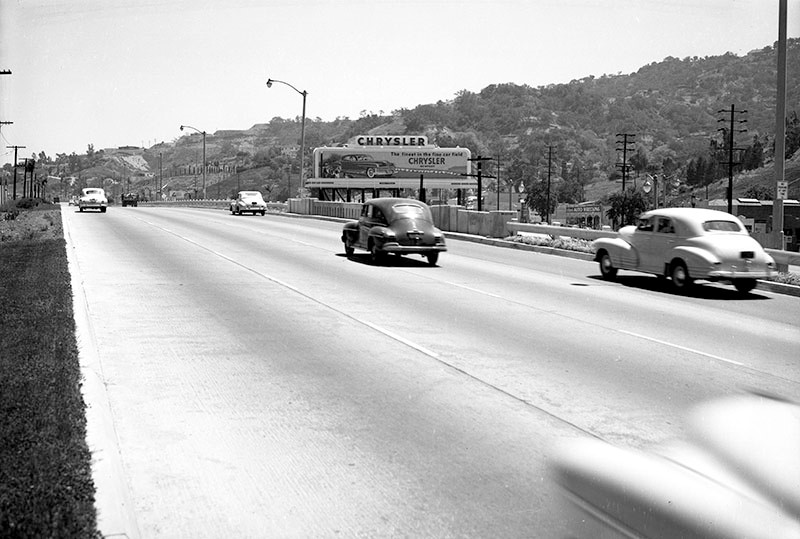 |
|
| (1950)* - Cars travel south down the Cahuenga Pass Freeway over the Lankershim Bridge and Tunnel, just north of where Cahuenga and Ventura boulevards meet in Studio City. |
* * * * * |
Van Nuys
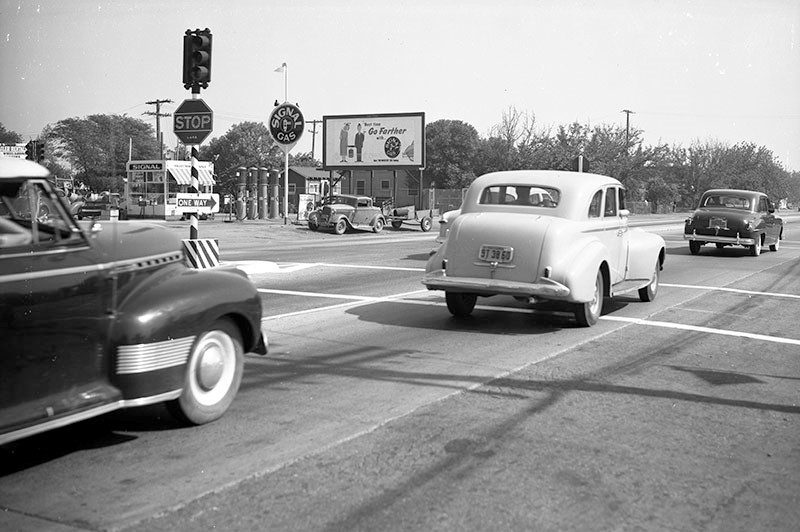 |
|
| (ca. 1946)* - Automobiles travel in both directions on Sepulveda Boulevard where it crosses Saticoy Street in Van Nuys. A billboard advertises Signal Gas, pumped next door at the service station (left). |
Historical Notes Signal Gasoline company was founded by Samuel B. Mosher in 1922. It renamed itself to Signal Gas & Oil in 1928 to reflect its expanding businesses; by the 1950s, Signal was the largest independent oil company on the West Coast of the United States and Mosher held large stakes in American President Lines and Flying Tiger Line. In 1964, Signal merged with the Garrett Corporation, an aerospace company, and the combined company adopted "The Signal Companies" as its corporate name in 1968. The merger of Allied and Signal made aerospace the new company's largest business sector. The combined company adopted the name Allied-Signal in 1985. It dropped the hyphen to become AlliedSignal in 1993 to reinforce a one-company image and signify the full integration of all of its businesses. In 1999, AlliedSignal acquired Honeywell for $15 billion and took its more-recognizable name.*^ |
Builders Emporium (Van Nuys)
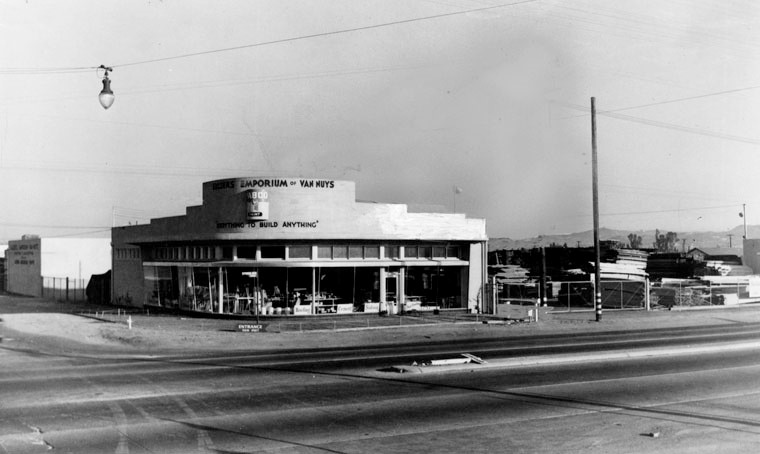 |
|
| (1948)* – View showing Builders Emporium located at 17643 Sherman Way in Van Nuys, before expansion. Store then had only 600 square feet of space. |
Historical Notes Builders Emporium was started in the San Fernando Valley in 1946. Victor M. Carter bought the ailing Van Nuys hardware store in 1949. He introduced the concept of a self-service hardware store with a "do it yourself" training component that became the model for The Home Depot. Carter built Builder’s Emporium into a leading self-serve retail operation and the largest hardware store in the United States, selling it in 1956, to acquire controlling interest in Republic Pictures just a few years later. The chain was later acquired by Wickes which dismantled its operation in 1989. Builders Emporium was forced to close in 1993 after its former parent had a number of financial problems during the previous decade.*^ |
 |
|
| (1957)* – View showing Builders Emporium home improvement store after its expansion. |
Anheuser-Busch Brewery
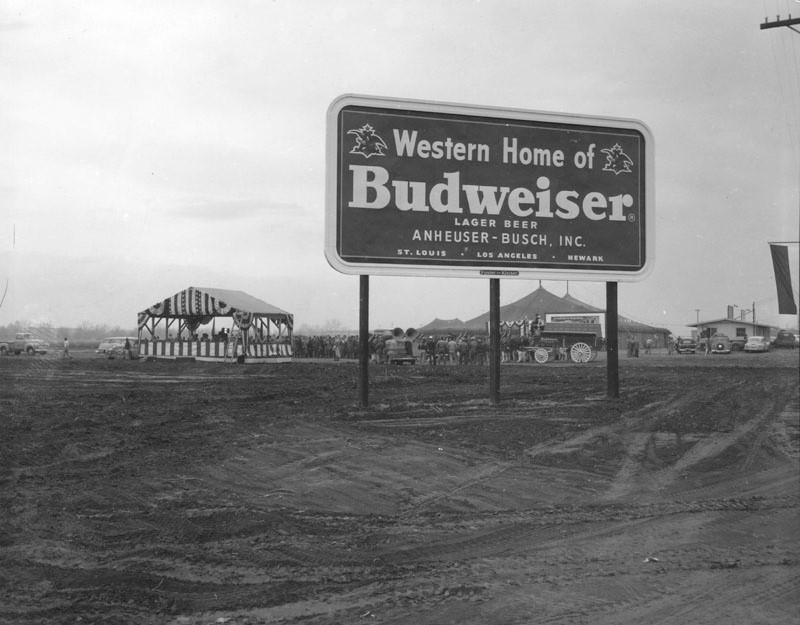 |
|
| (1953)* - Photo of the future home of Anheuser-Busch, Inc. in Van Nuys, taken during the ground-breaking ceremony. A billboard reads: "Western Home of Budweiser - Lager Beer - Anheuser-Busch, Inc. - St. Louis. Los Angeles. Newark". A crowd of people can be seen standing next to a 'grand stand' in the background. |
Historical Notes During the 1870s, Adolphus Busch toured Europe and studied the changes in brewing methods which were taking place at the time, particularly the success of pilsner beer, which included a locally popular example brewed in Budweis (largest city in the South Bohemian Region of what is now Czech Republic). In 1876, Busch introduced Budweiser, with the ambition of transcending regional tastes. The ability to transport bottles made Budweiser America's first national beer brand, and it was marketed as a "premium" beer.*^ |
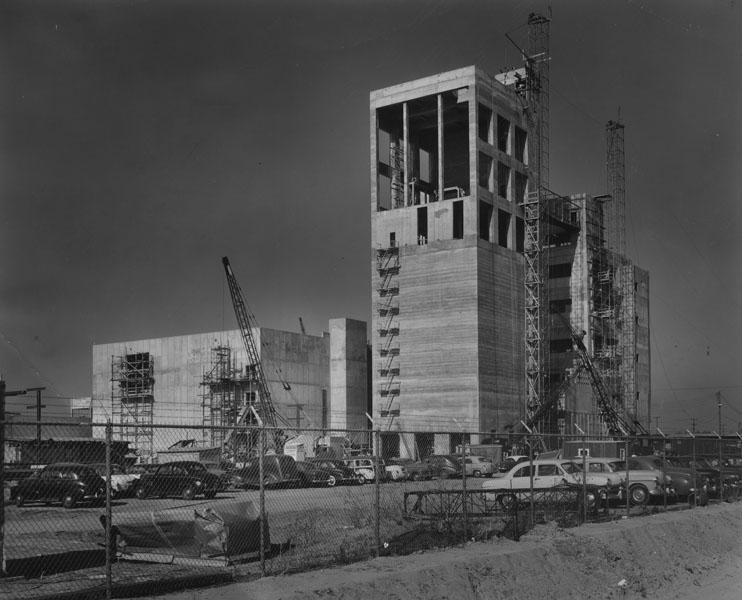 |
|
| (1953)* - Nearing completion is the huge brew house of Anheuser-Busch's $50,000,000 brewery at Roscoe Boulevard and Woodley Avenue in San Fernando Valley, where Budweiser beer will be produced. The brewery will have a capacity of 920,000 barrels. Photo dated: December 17, 1953. |
Historical Notes Woodley Avenue was named for Frank A. Woodley, a county supervisor and state legislator. Laid out as Alvarado Avenue north of Roscoe Boulevard in 1916. Roscoe Boulevard derives from the town of Roscoe, now Sun Valley. The thoroughfare originated as a plowed furrow that extended the length of the Valley and marked the boundary between the Lankershim Ranch on the south and the Maclay-Porter ranches on the north.^* Click HERE to see more SFV Street Name Origins. |
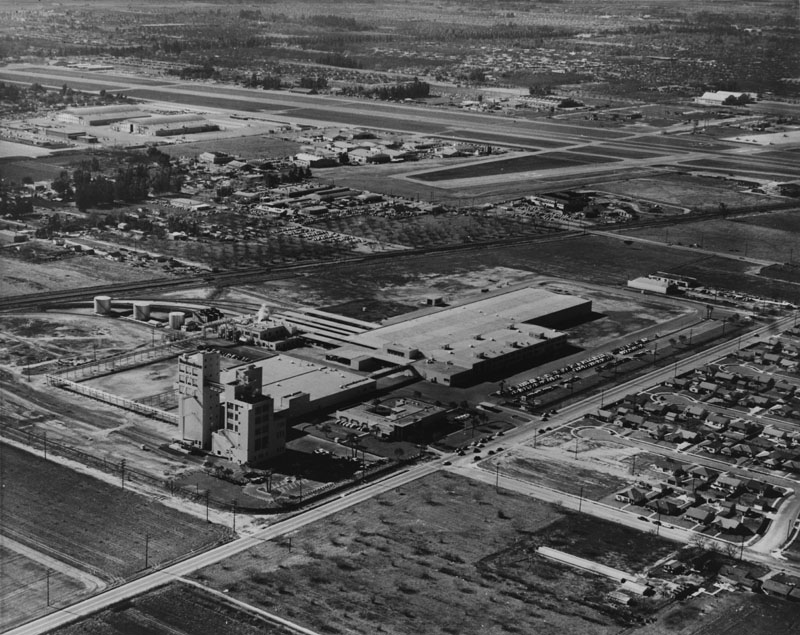 |
|
| (ca. 1955)* - Aerial view looking southwest at the Anheuser-Busch Brewery in Sepulveda shortly after it was completed. The Van Nuys Airport (then known as the San Fernando Valley Airport) can be seen in the background. |
Historical Notes Founded in 1852, and incorporated in 1875, Anheuser-Busch Companies, Inc. is the largest brewing company in the United States, and the world's largest brewing company based on revenue. The then-small St. Louis, Missouri brewery was owned and operated by Eberhard Anheuser, who brought in his son-in-law Adolphus Busch as a partner in 1869. In 1876, Busch introduced America's first national beer brand: Budweiser, followed (years later) by several other brands, such as Busch, Michelob, and Bud Light to name a few. With the death of Anheuser in 1880, Busch became president of the company, subsequently becoming the first U.S. brewer to use pasteurization to keep beer fresh, the first to use artificial refrigeration and refrigerated railroad cars, and the first to bottle beer extensively.* In 1955 the airport was still known as the San Fernando Valley Airport. It would be renamed Van Nuys Airport in 1957.*^# |
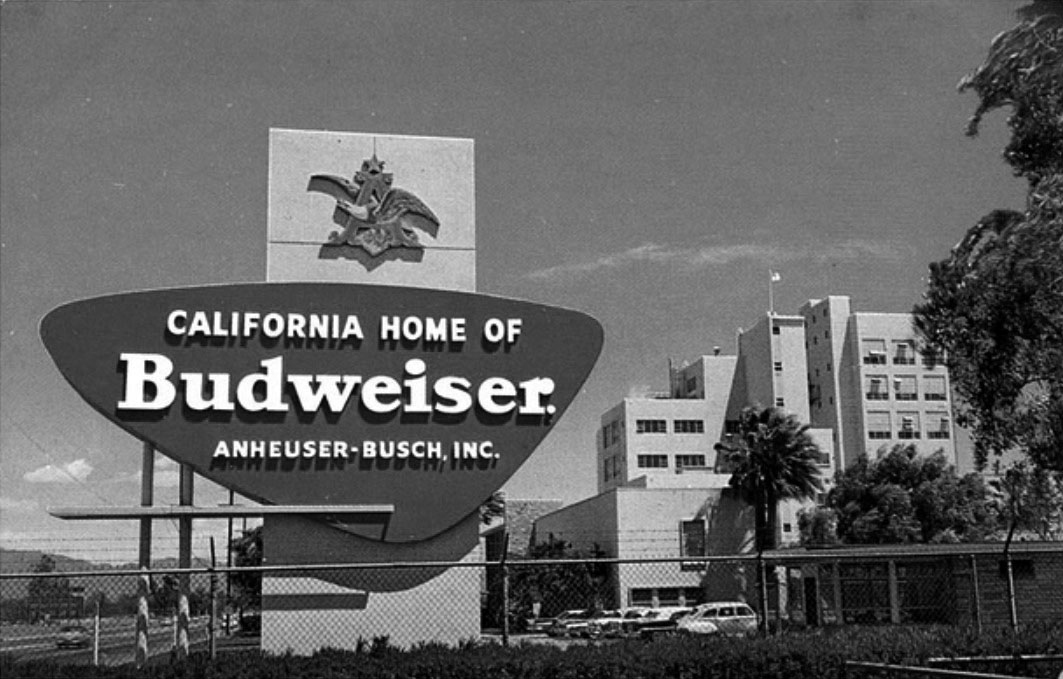 |
|
| (ca. 1950s)^^^* – View looking east showing the large Anheuser-Busch Sign in front of the brewery on Roscoe Blvd. Sign reads: California Home of Budweiser |
Historical Notes By 1957, Anheuser-Busch had become the largest brewer in the United States.* In 1966, Anheuser-Busch transformed a cabbage patch adjacent to the Van Nuys brewery into a tropical beer garden and bird sanctuary. Click HERE to see more on Busch Gardens. |
City of San Fernando
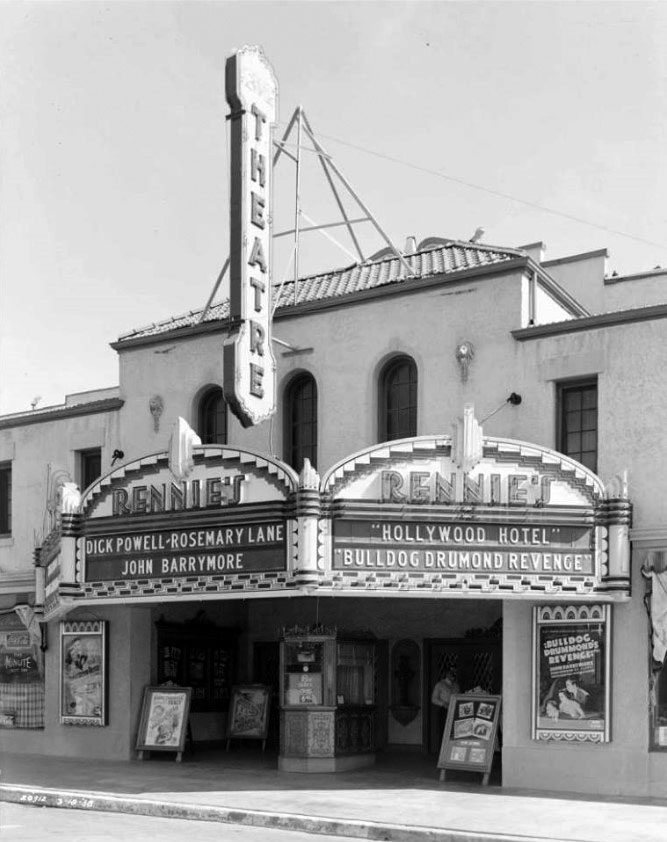 |
|
| (1938)#* – View showing Rennie's Theater, located at 214 N. Maclay Avenue in San Fernando. Now showing: "Hotel Hollywood" starring Dick Powell and Rosemary Lane; and "Bulldog Drummond's Revenge" starring John Barrymore. |
Historical Notes Rennie’s Theatre was opened in 1925. In the early-1960’s it was operating as the Crest Theatre. It was still open as a movie theatre in the San Fernando Valley as of January 20, 1980, showing Spanish language films and re-named Azteca Theatre. It is now operating as the Living Hope Community Church. Click HERE to see current (2016) view. |
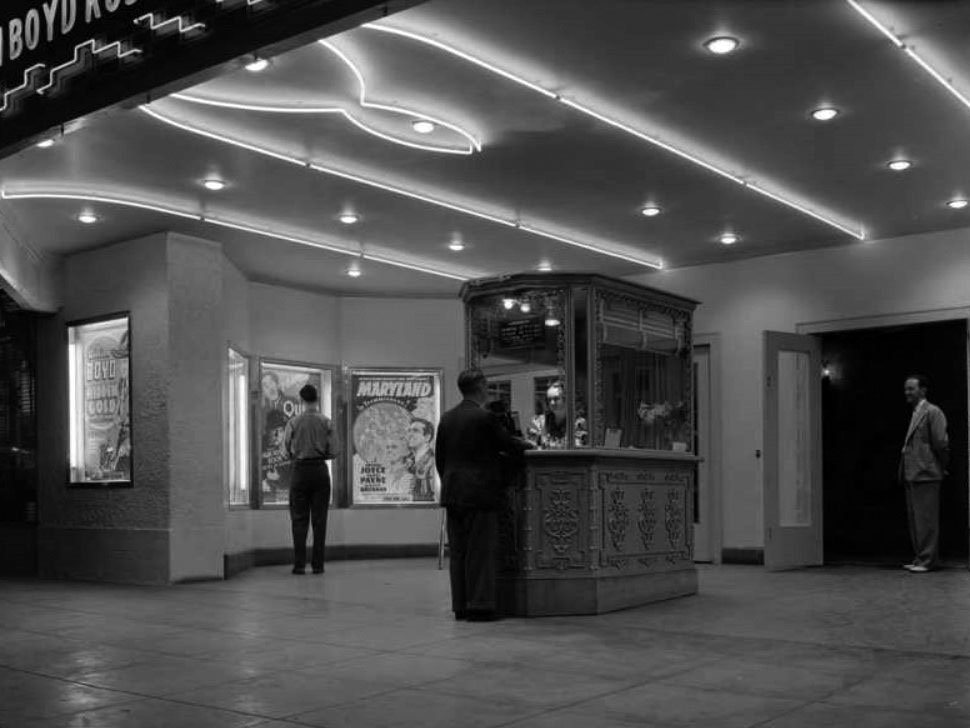 |
|
| (1940)#* – Night view showing a man purchasing tickets at Rennie’s Theatre in San Fernando. Mr. Rennie is seen standing at the front entry door on the right. |
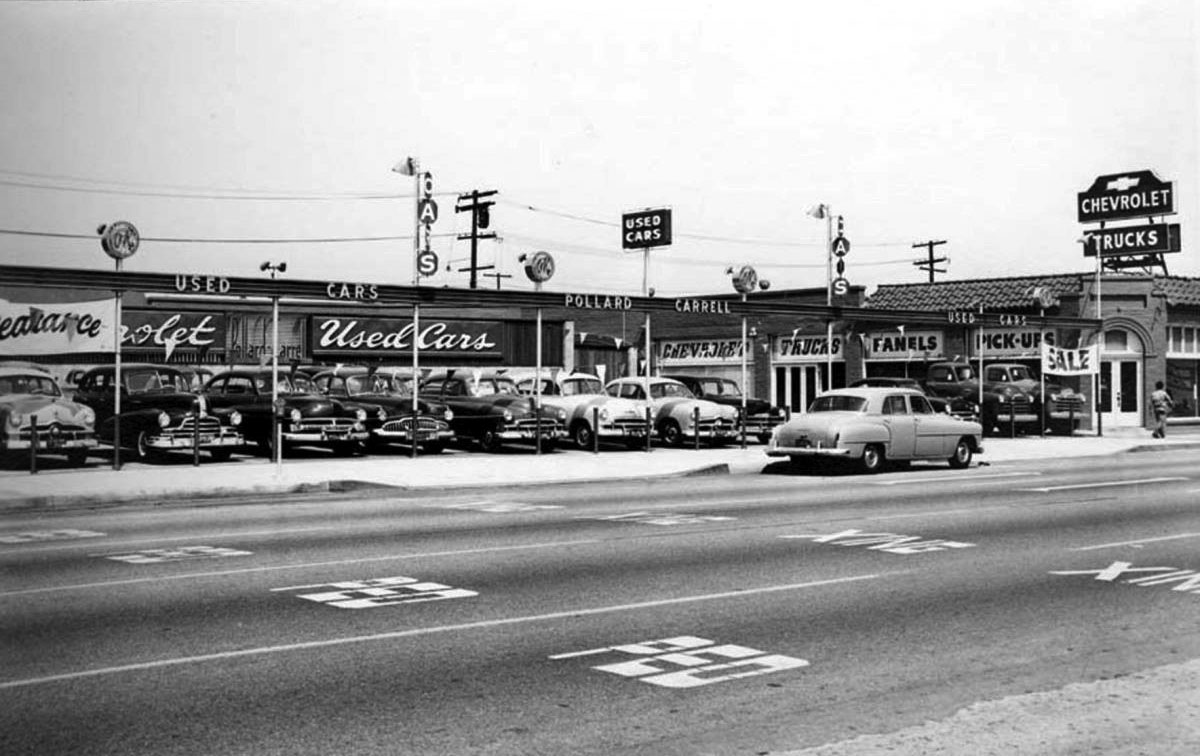 |
|
| (ca. 1950)#^*^ – View showing Pollard-Carrell Chevrolet dealership located at 753 San Fernando Rd. |
Historical Notes One of the valley’s first Chevrolet dealerships was opened Dec 1, 1937 by partners Martin Pollard and Thomas C Carrell. Pollard, with various partners, went on to own seven car dealerships in the valley. Both Pollard and Carrell got heavily involved in politics; Carrell served as an assemblyman and state senator in the 60’s and 70’s. In the 1960’s, Carrell bought out Pollard, renaming the San Fernando dealership Tom Carrell Chevrolet. The dealership changed hands a few more times, including: Dan Hedrick Chevrolet (1983), Bill Murphy Chevrolet (1991) and Rydell Chevrolet. |
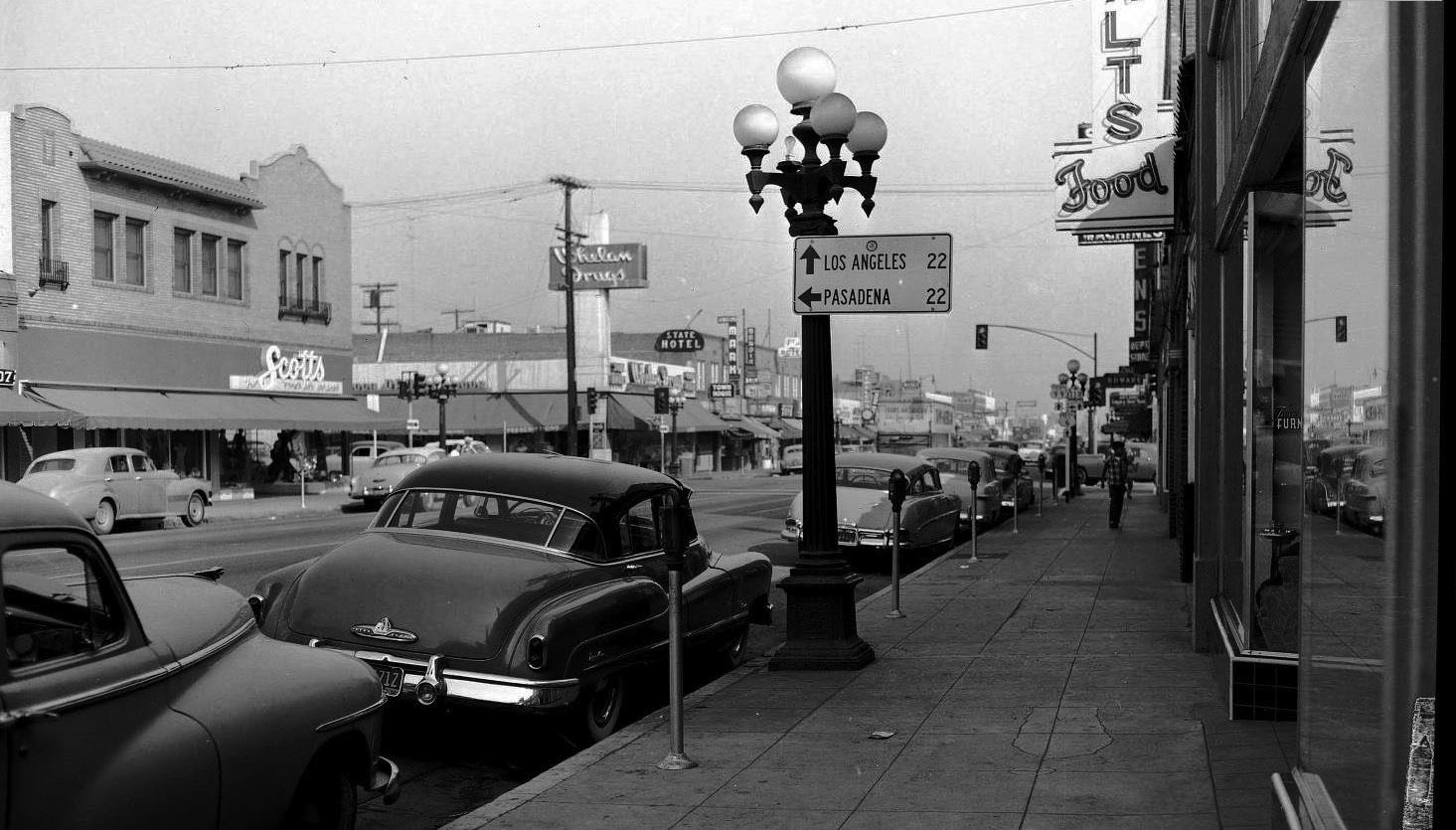 |
|
| (ca. 1950)#* - View looking southeast from the south side of San Fernando Road just west of Maclay Avenue. |
Historical Notes The junction of State Route 118 with State Routes 99 and 6 was at Maclay and San Fernando. The 118 proceeded north on Maclay to Foothill and then to the La Crescenta Valley and Pasadena. The City of San Fernando was founded in 1874. Click HERE to see San Fernando in the 1800s. |
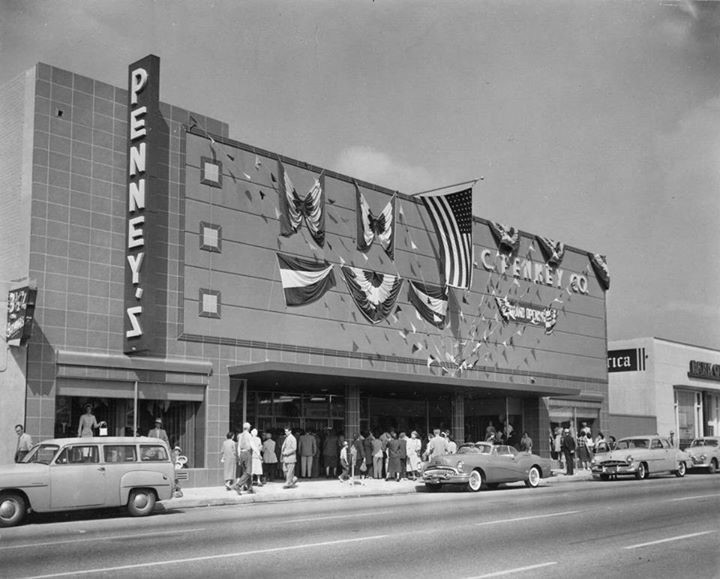 |
|
| (1953)*^^^ - San Fernando J.C. Penney Grand Opening, located at 1140 San Fernando Road. People are seen waiting in line to see the new store. A 1953 Buick Skylark convertible is parked in front. |
Historical Notes The store closed its doors in July 2012 despite having historical significance to the San Fernando community. J.C. Penney has had a store open in San Fernando since 1920.*^^^ |
Reseda
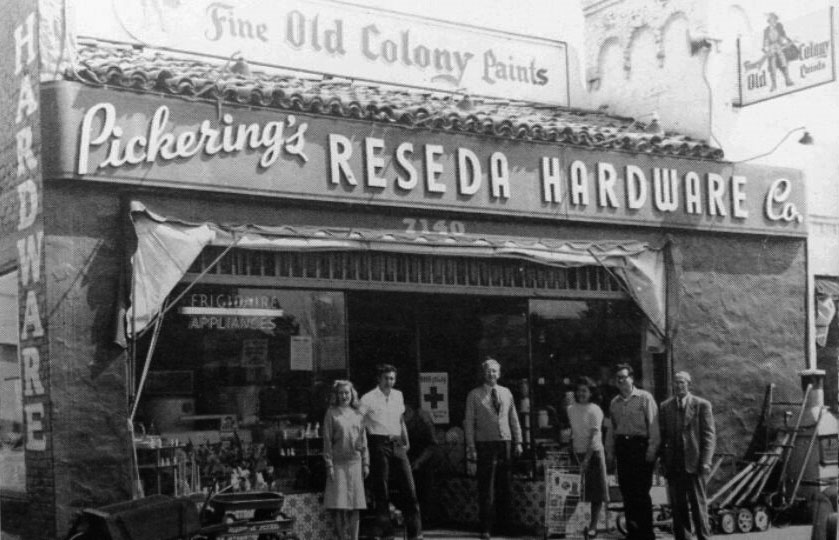 |
|
| (1948)#^*^ – View showing a group of people posing for the camera in front of Pickering's Reseda Hardware Co. located on the east side of Reseda Boulevard south of Sherman Way (7140 Reseda Blvd). |
Historical Notes By 1950, Reseda had over 16,000 residents and in the early 1950s, a population explosion took place, making Reseda one of the most popular and populated of all Valley communities. Because of this, Reseda's merchants provided bus service to transport shoppers throughout the busy downtown Reseda areas.*^ |
 |
|
| (ca. 1953)+## - View looking south on Reseda Boulevard from Sherman Way. Pickering's Reseda Hardware is seen on the left. |
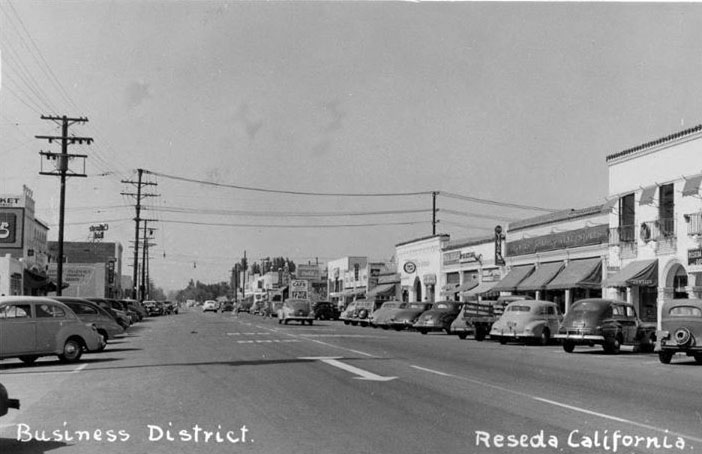 |
|
| (ca. 1950)^^^* - View looking north on Reseda Boulevard toward Sherman Way. |
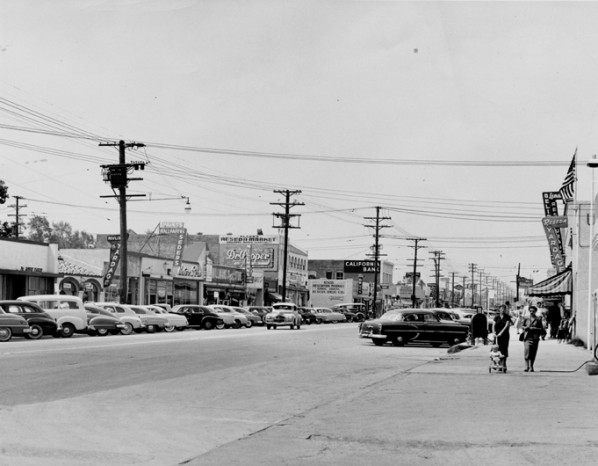 |
|
| (ca. 1954)^ - Reseda Boulevard looking north, one block south of Sherman Way, circa 1954. California Bank building is on southwest corner of Reseda Boulevard and Sherman Way and is still standing today. American flag on right is above Reseda Post Office. Gas pumps in lower right belong to Atlantic Richfield gas station. |
.jpg) |
|
| (ca. 1957)* – View showing Reseda Boulevard - the main business center of the San Fernando Valley. The two-tone car at center is a 1957 Ford Fairlane. Photo courtesy of Valley Relics Museum |
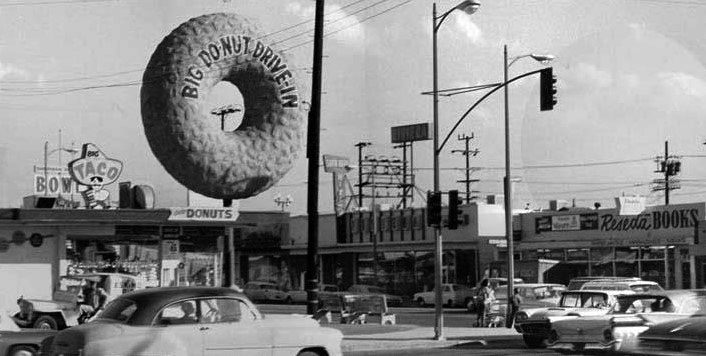 |
|
| (ca. 1960)^.^ – View showing Big Do-Nut Drive-in located at 7208 Reseda Boulevard on the NE corner of Reseda and Sherman Way. |
Historical Notes Russell C. Wendell, a doughnut machine salesman, created the Big Donut Drive-in. There were 10 locations, built over the course of the 1950s. At least five Big Donuts survive: they are Kindle's Donuts in unincorporated Westmont (this is the original location, built in 1950), (2) Randy's Donuts in Inglewood near LAX, the Donut King II in Gardena (3), Dale's Donuts in Compton (5), and Bellflower Bagels in Bellflower (8). Each features the distinctive giant doughnut constructed of rolled steel bars covered with gunite, a material used in swimming pools. Five Big Donuts have been demolished. They were located in Culver City (4), North Hollywood (6), Inglewood (on Imperial Hwy, 7), Van Nuys (9) and Reseda (10). The building style dates to a period in the early 20th century that saw a proliferation of Programmatic Architecture throughout Southern California. This style had its heyday from the mid-1920s to the mid-1930s. By the 1950s however, the trend of designing structures in the shape of the product sold there had changed to focus on signs rather than architecture itself.*^ Click HERE to see more examples of Programmatic Architecture. |
Sherman Way (Reseda)
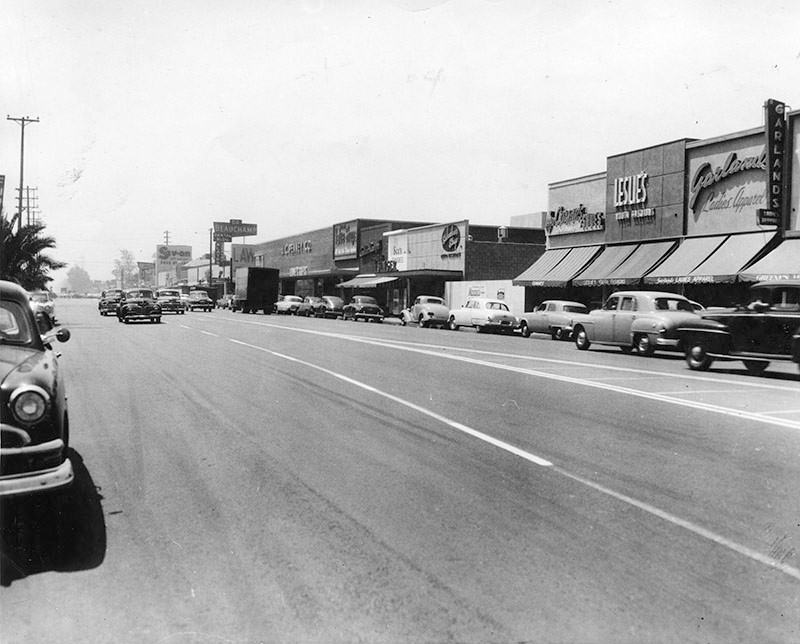 |
|
| (1954)* - Photograph caption dated August 12, 1954 reads, "Reseda, 'Hub of the West Valley,' surprises even the old timers who settled in the area when it boasted of bumper wheat crops. Today, the community is a beehive of merchandising activity with thousands of new residents and many new merchants. This view looking west on Sherman Way from Etiwanda avenue reveals some of the stores that will participate in the big Dollar Day week end sale tomorrow and Saturday. Thousands of items at reduced prices go on sale." - Valley Times |
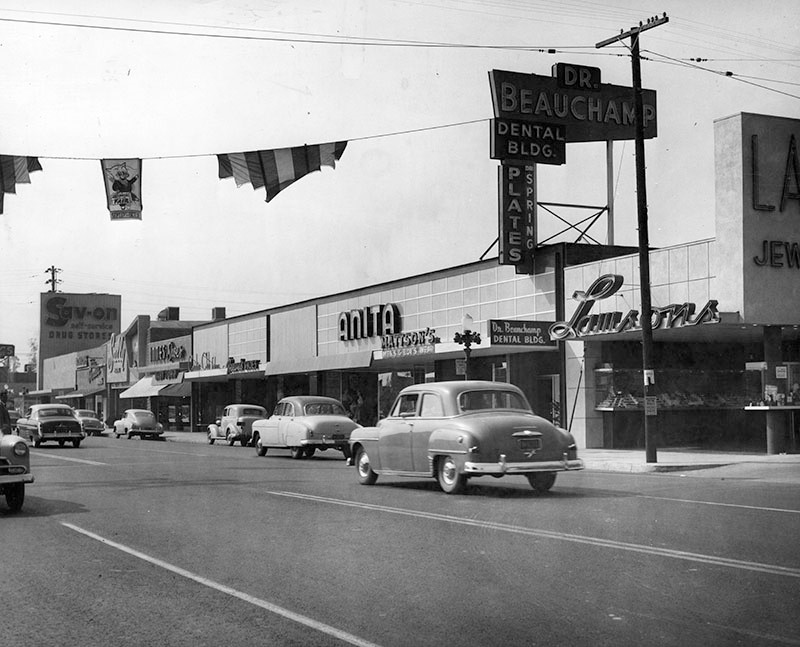 |
|
| (1954)* - Valley Times photo caption dated October 7, 1954 reads, "Attractive new shopping district along Sherman Way in Reseda will offer special merchandise and low prices during Reseda Harvest Days tomorrow and Saturday. Modern shops are designed with ample shopping areas. Special buses will bring West Valley shoppers to business center." View is looking west on Sherman Way towards Reseda Boulevard. |
 |
|
| (ca. 1955)^^^* - View from right to left is a 1953 Oldsmobile, 1954 Ford, and a 1952 Chevy on Sherman Way across from the Reseda Theater. The building with the striped awning is Traders Pawnshop, on the northwest corner of Reseda and Sherman Way. |
Reseda Theater
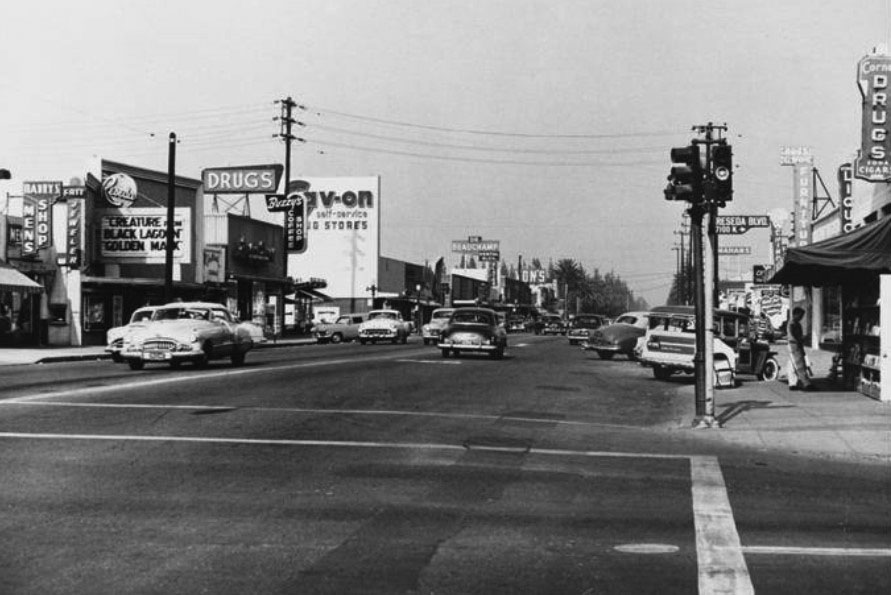 |
|
| (1955)##^ – View looking east on Sherman Way from Reseda Boulevard with Sav-On Drug Store seen at center-left and the Reseda Theater at left. |
Historical Notes The Reseda Theatre carries the original design of famed architect S. Charles Lee, 1948. The upper facade was a picture frame, a design element found in a couple of Lee’s post-WW II designs. In lieu of a marquee, the Reseda carried a sign board, placed for reading by passing cars. Lee’s works included the Los Angeles & Tower Theatres in downtown LA, the Inglewood Academy Theatre, the Beverly Hills Fox Wilshire Theatre (today, Saban Theatre) and the stunningly beautiful San Luis Obispo Fremont. Lee’s born name was Simeon Charles Levi. Levi/Lee’s parents bought a furniture store from a Mr. Lee. Rather than change the store’s name, the family changed their name. - Shel Weisbach, author of Pathways of the San Fernando Valley |
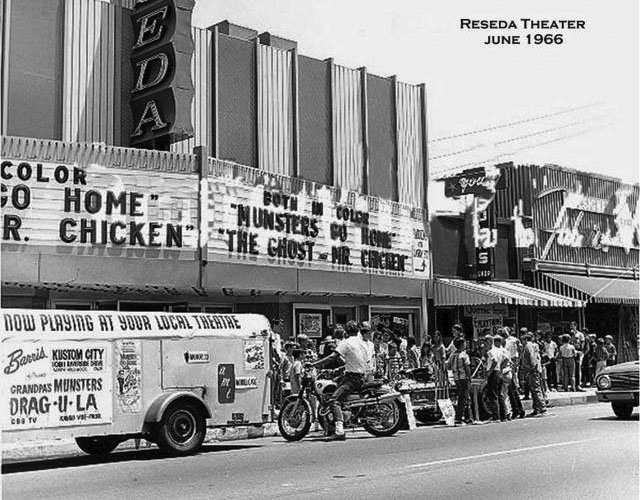 |
|
| (1966)^**^ – View showing a crowd of people in front of the Reseda Theater located at 18443 Sherman Way. Now playing: "Munsters Go Home" and "The Ghost and Mr. Chicken". |
Historical Notes The Reseda Theatre was opened in 1948 and closed in 1988. The marquee of the Reseda Theatre was seen in the 1997 film “Boogie Nights”. In June 2016 plans were announced to convert the theatre into a multiscreen cinema which will be operated by Laemmle.^**^ |
Reseda High School
 |
|
| (1955)* – View of Reseda High School located at 18230 Kittridge Street, just after it was constructed. |
Historical Notes Photo title reads, "Aerial view shows new $5,000,000 Reseda High School, the first complete high school plant constructed in Los Angeles since before World War II. It will open to 1,500 sophomores and juniors Monday at 18230 Kittridge St. Dr. Lowell McGinnis, former principal of John H. Francis Polytechnic High School, will head school. Plant eventually will house 2,500 students. Athletic field with seating for 3,000 spectators and night lighting system is included in facilities." On the right is the Los Angeles River. Photo Date: September 10, 1955 – Valley Times* |
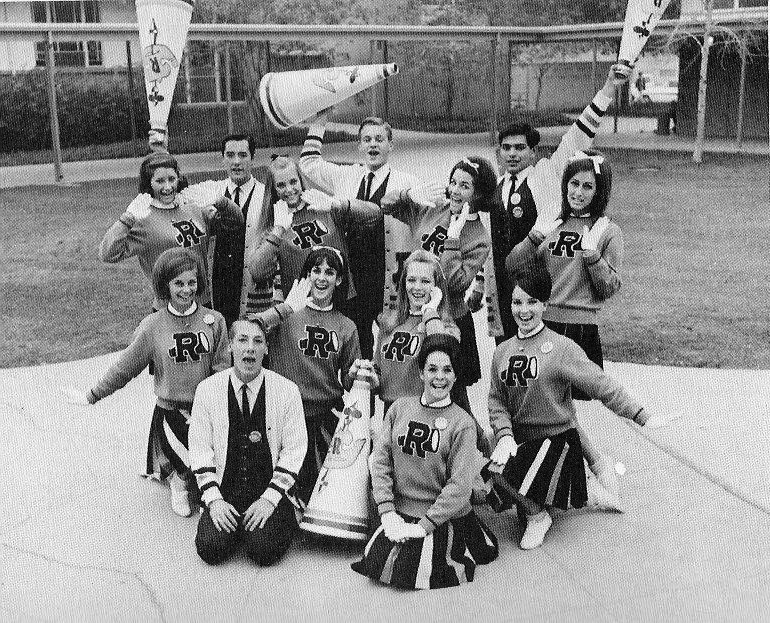 |
|
| (1968)+## – Reseda High School Cheerleaders - 1968 |
* * * * * |
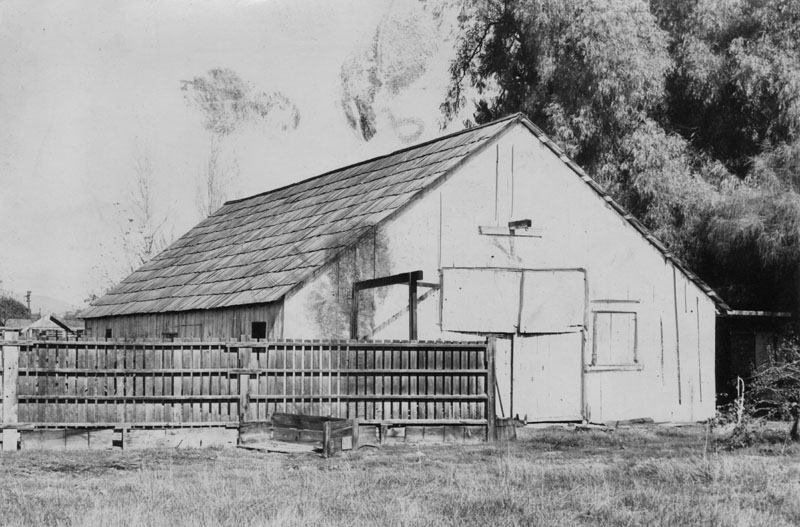 |
|
| (1950)* - A wooden fence encloses the barnyard next to the shingle-roofed Zelzah barn at 8369 Reseda Boulevard. Photo caption reads: "Still standing. Believed to be a hundred years old is the original Zelzah barn in Northridge. Thousands of fertile acres surrounding it were once sown to beans and wheat". Photo dated: Dec. 4, 1950. |
* * * * * |
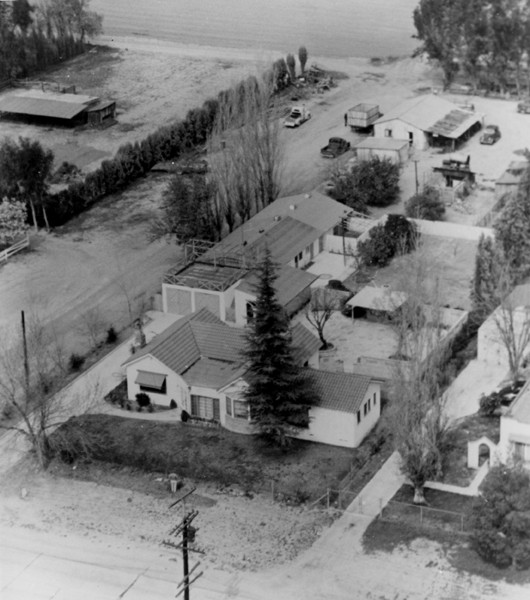 |
|
| (ca. 1955)^ - Aerial photograph taken circa 1955 of the home and farm of brothers Louie and Albert Beltramo, who were among the earliest farmers in the San Fernando Valley. The Beltramos began farming in 1919. Their operation grew until eventually it fed and housed over 100 Mexican nationals, who worked on the farm. The farm was located on Owensmouth and Roscoe Blvd. and remained in the area even after being completely surrounded by urban development. |
Sodium Reactor Experiement
 |
|
| (1956)* - Photograph caption dated May 10, 1956 reads, "Fission housing lowered into place. Container to house core, or component in which nuclear fission takes place to produce 20,000 kilowatts of heat, is lowered into position at Sodium Reactor Experiment site in Santa Susana Mountains near Canoga Park. Reactor is part of program to develop commercial power from atomic energy." |
Historical Notes This reactor was part of the Sodium Reactor Experiment, a nuclear power plant built by Atomics International of North American Aviation at the Santa Susana Field Laboratory, in the Santa Susana Mountains. The reactor was active from 1957 to 1964. * |
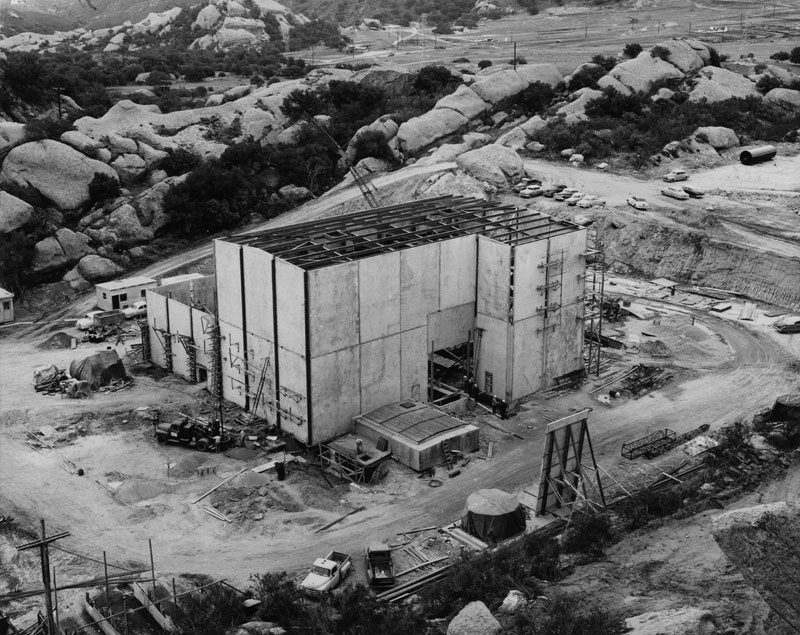 |
|
| (1956)* - Photograph caption reads: "Atomic reactor to generate power. San Fernando Valley's atomic reactor, above, first non-military reactor in the nation to be operated by private firm to produce electricity is nearing completion stage in Santa Susana Mountains. It is being built by Atomics International of North American Aviation. It will be capable of producing 7,5000 kilowatts. Negotiations are under way between the group and Southern California Edison Co. for sale of surplus heat." |
Historical Notes The Sodium Reactor Experiment-SRE was an experimental nuclear reactor which operated from 1957 to 1964 and was the first commercial power plant in the world to experience a core meltdown.*^ |
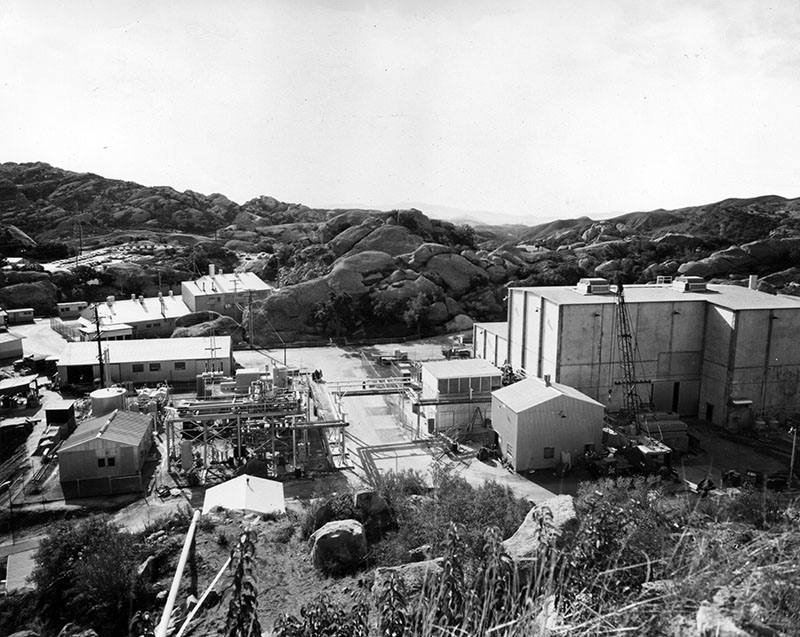 |
|
| (1957)* - View showing the newly completed atomic reactor building and power station. Photograph caption dated July 16, 1957 reads, "New plant opened by Atomics International, division of North American Aviation, Inc., for Atomic Energy Commission, rests in Santa Susana Mountains. Plant is combination of atomic reactor building at right, and Southern California Edison Co. power station, left. Project is attempting to develop economical power from nuclear energy." |
Historical Notes This was the first commercial power plant in the world to experience a core meltdown. There was a decades-long cover-up by the US Department of Energy. The operation predated environmental regulation, so early disposal techniques are not recorded in detail. Thousands of pounds of sodium coolant from the time of the meltdown are not yet accounted for. The reactor and support systems were removed in 1981 and the building torn down in 1999.*^ |
* * * * * |
Ventura Boulevard
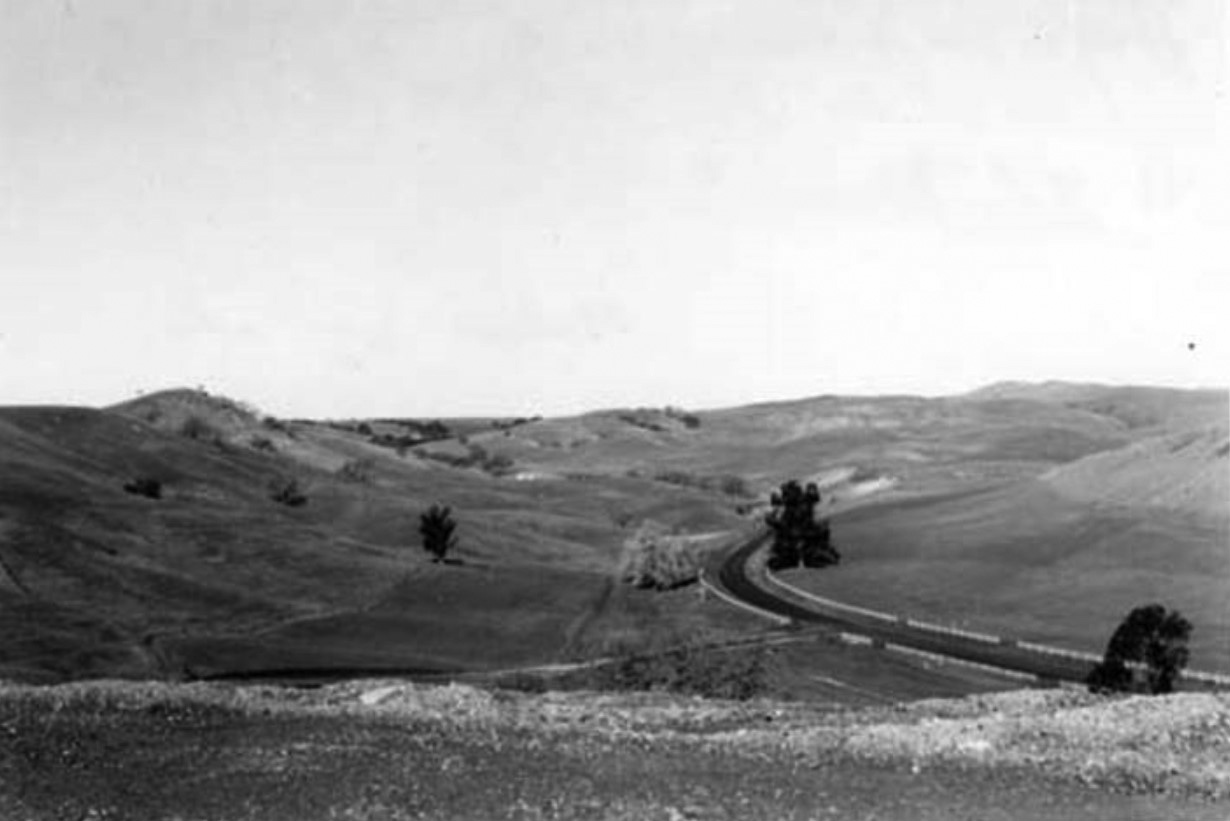 |
|
| (ca. 1950s)^ - View of Ventura Boulevard facing west from Hidden Hills. The flat hill in the center is called "the Mesa." To the west of the Mesa was the Agoure Ranch. The area was later named Agoura Hills. |
Historical Notes In its earliest days, Agoura Hills was nothing more than a stagecoach stop and was referred to as "Vejar Junction." In the early 1920s, after Paramount Studios purchased a ranch in the neighborhood, the community became known briefly as "Picture City." But neither name stuck. In 1928, a group of residents formed a Chamber of Commerce which, as one of its first actions, asked to have a permanent post office established in the community. The Postal Department informed the chamber that it would need to submit a list of ten potential names for the town. One of the area's more colorful early landowners had been a man by the name of Pierre Agoure. Though French by birth and a shepherd in his youth, he favored Spanish costumes and adopted the moniker Don Pedro Agoure. In compiling a list of possible names, the townspeople inserted "Agoure" in the tenth spot. Bob Boyd, the town's first postmaster, later recalled that the tenth name was selected because it was the shortest. How the "e" became an "a" remains an unsettled issue. Some say it was done intentionally for ease of spelling, others lay blame at the door of the post office, arguing that the modification was simply an error. |
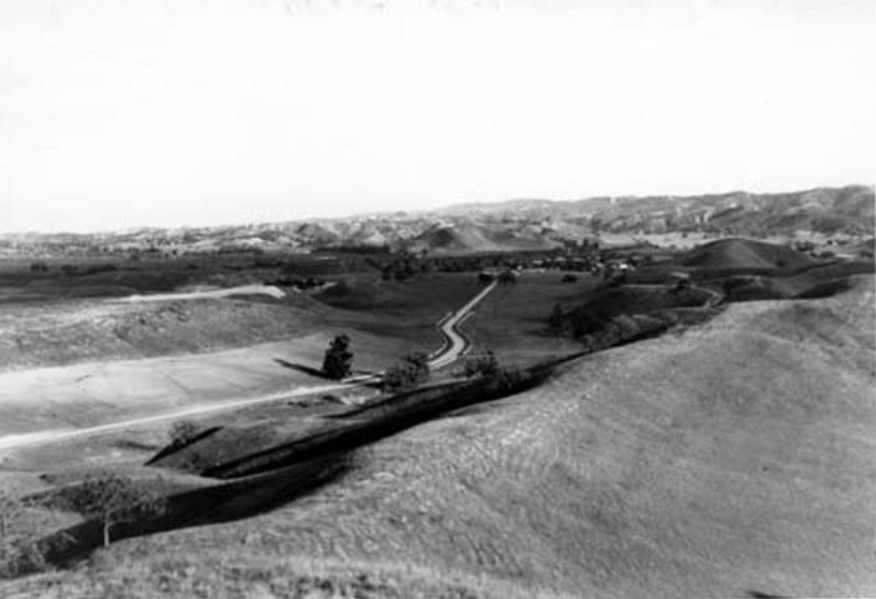 |
|
| (ca. 1950s)* - View looking east on Ventura Bouelvard from Calabasas. |
Historical Notes Ventura Boulevard was originally part of El Camino Real. It now continues as Calabasas Road (running parallel to the 101 Freeway). A stage line, run by Flint, Bixby and Butterfield, operated during the 19th century along it. |
* * * * * |
Hidden Hills
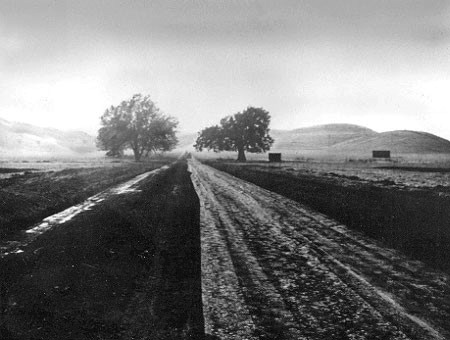 |
|
| (1950)* - Looking from the main gateway along Long Valley Road in Hidden Hills. The oak at the left is between 23704 and 23726 Long Valley Road. The oak on the right is at the northeast corner of Twin Oaks Road and Long Valley Road. |
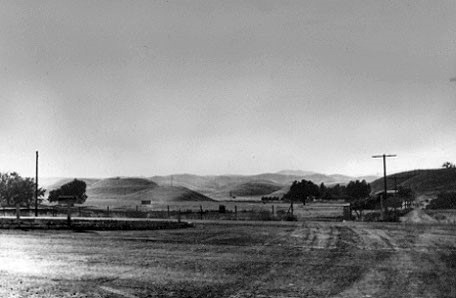 |
|
| (1950)* - Corner of the intersection of Long Valley Road and 101 before it was a freeway. The Old Miguel Leonis Adobe home is at the photographer's back. |
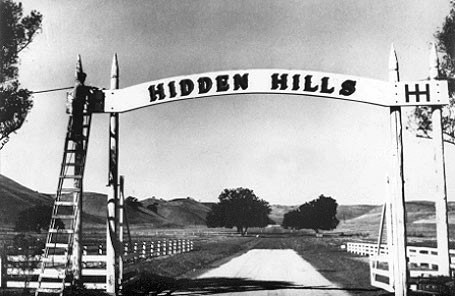 |
|
| (1950)* - Putting the finishing touches on the main entrance gate. The first sections of the three rail, white fences have just been erected. |
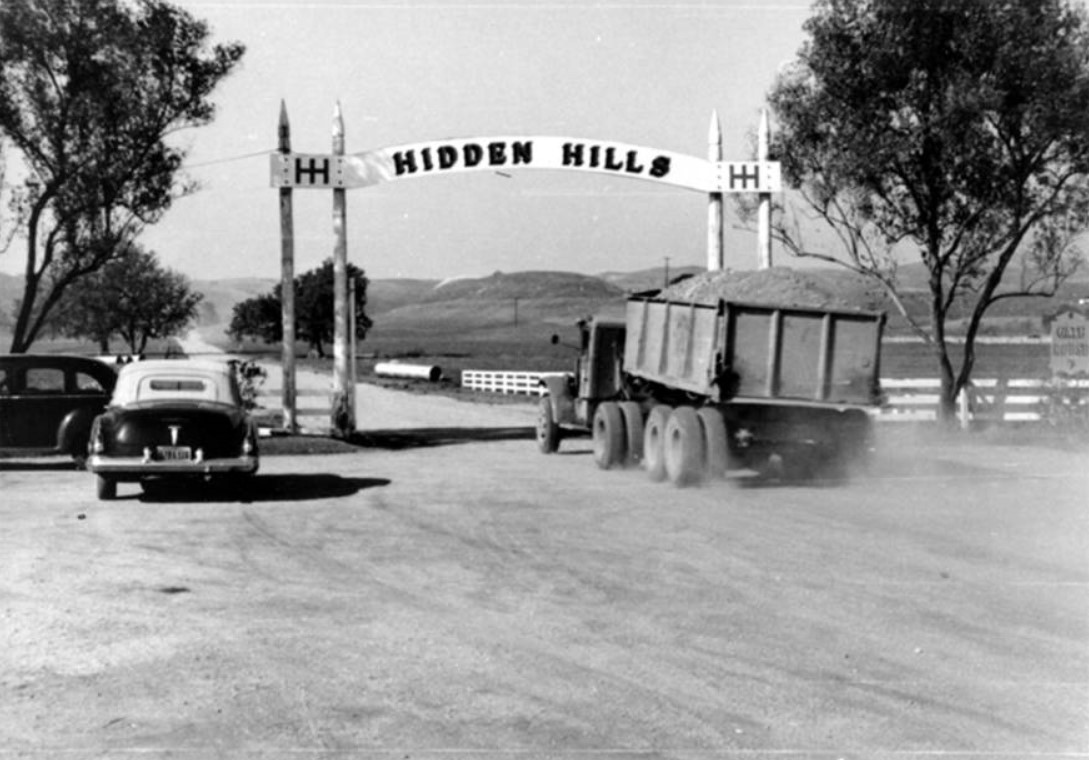 |
|
| (ca. 1950)^ – View showing the front gate in the new development of Hidden Hills. A truck with fill dirt is seen entering the subdivision at Long Valley Road. |
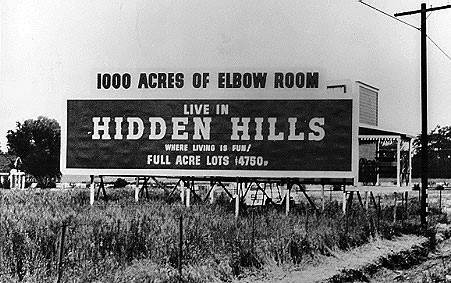 |
|
| (1950)* – View showing a large sign on Ventura Boulevard at the intersection of Long Valley Road. |
Historical Notes Sing reads: 1000 Acres of Elbow Room - Live in HIDDEN HILLS where Living is Fun! Full Acre Lots $4750. The "1000 acres" were composed of the following purchases: 1) in 1949, 700 acres acquired from E.E. Hurlbutt; 2) in 1950, 160 acres purchased from Nace, et al; 20 acres from Mrs. Lasher; 119 acres from the Straubinger family; and 5.6 acres from Spinks — a total of 1004.6 acres. |
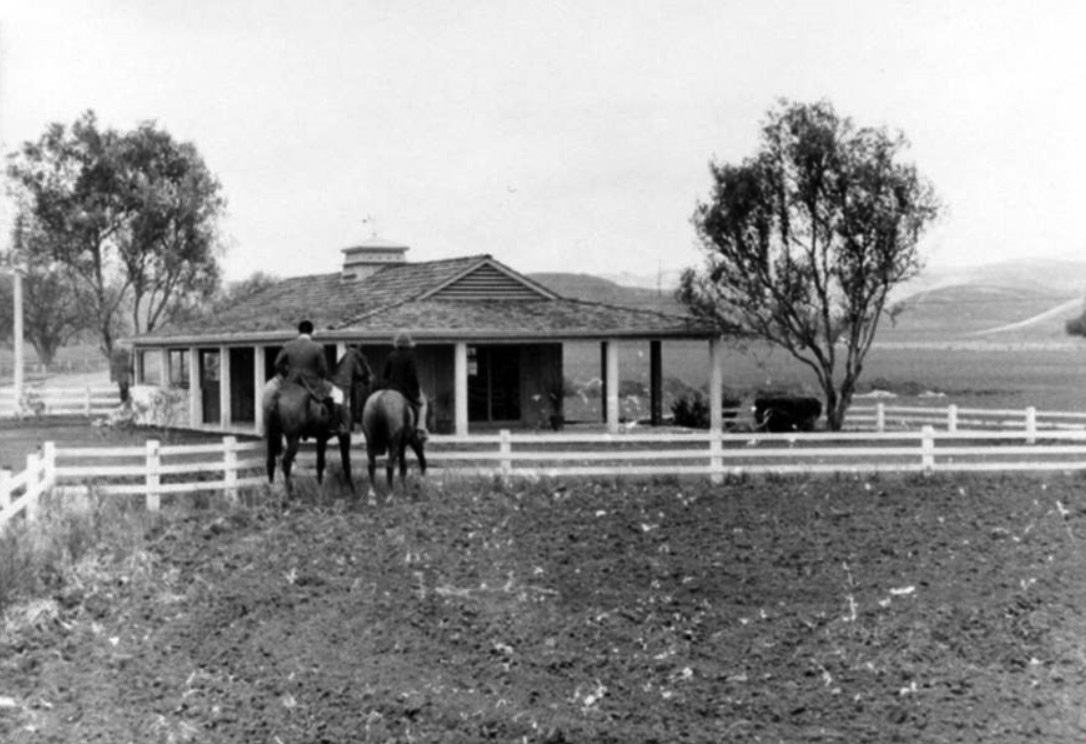 |
|
| (1950s)^ – A man and woman ride horseback near the real estate office at the front gate of the new Hidden Hills development. |
Historical Notes By 1957, the cost of a three- or four-bedroom home on a one-acre site was $27,500 – $47,500. One- to five-acre home sites were selling for $7,950 – $12,500. |
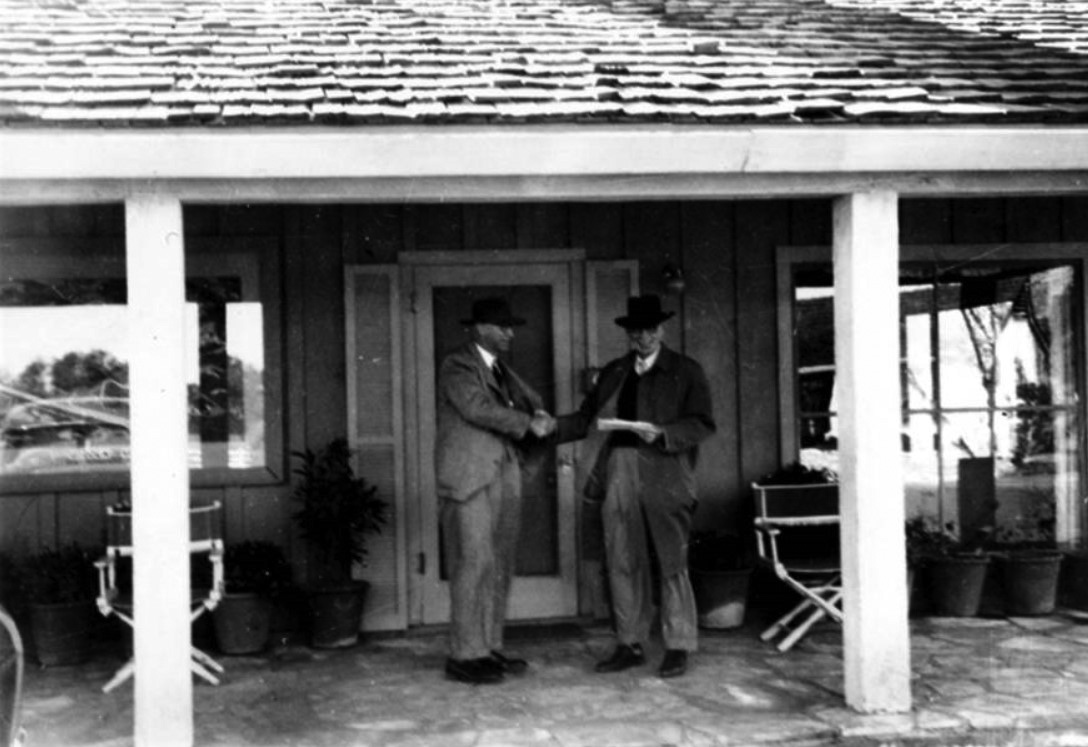 |
|
| (1950s)^ - Developer A. E. Hanson and salesman Pat Murphy shaking hands on the porch of the Hidden Hills real estate office. |
Historical Notes The Hidden Hills Community was designed and developed in the 1950s by A.E. Hanson, a renowned Southern California landscape architect and planned community developer. His earlier projects included Rolling Hills and Palos Verdes Estates, and the 1920s Beverly Hills Harold Lloyd Estate 'Greenacres'. |
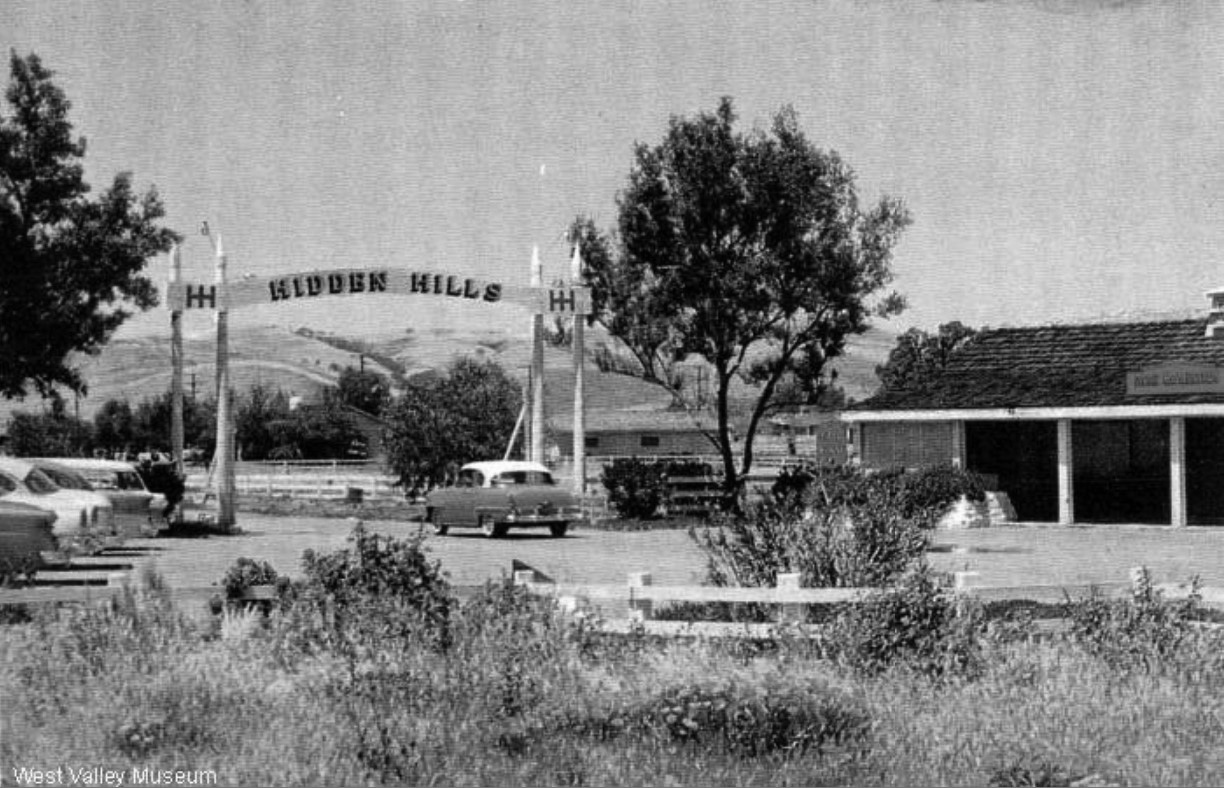 |
|
| (ca. 1953)^ - Postcard view showing the entrance to Hidden Hills. |
Historical Notes Hidden Hills is bordered on the north by the nature reserve and greenbelt of the Upper Las Virgenes Canyon Open Space Preserve, a park with miles of equestrian, hiking, and mountain biking trails. Nearby to the south is the pioneer Leonis Adobe National Historic Landmark, with gardens and a historical Museum. It's across the historic El Camino Real of the Spanish Las Californias and Mexican Alta California eras, now U.S. Route 101. |
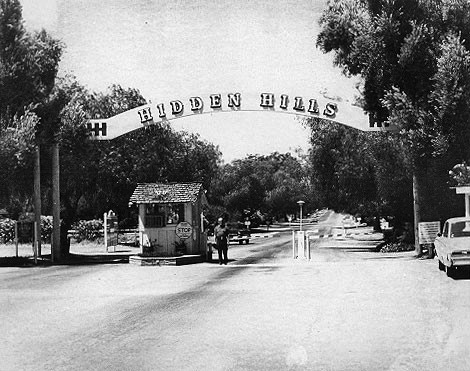 |
|
| (ca. 1960)* - View of entrance to Hidden Hills with Gatehouse. |
Historical Notes In the spring of 1961, civic leaders in the tiny community of Hidden Hills launched a drive to form a city. They were faced with the prospect of being annexed to the City of Los Angeles and having Burbank Boulevard extended through the community. The petition for cityhood was signed by 79% of the voters, and in spite of the fact that the Los Angeles City Council's Planning Committee opposed the incorporation, it was approved by the Board of Supervisors. September 19, 1961 was designated as election day, when a total of 358 votes were cast for incorporation (83% of registered voters), with 71 votes against. The area of the new city was approximately 1.3 square miles, with a population of a little over 1,000 and an assessed valuation of $2,681,910. On October 19, 1961, Hidden Hills became the 73rd city in the County. |
* * * * * |
Calabasas
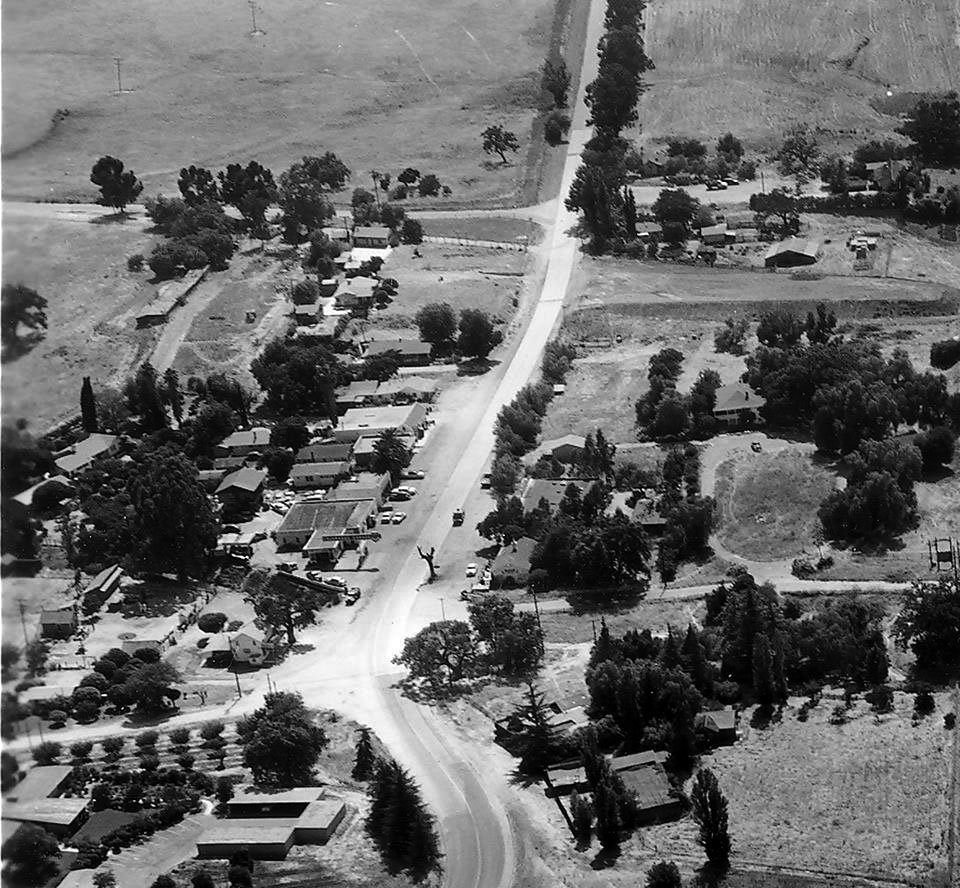 |
|
| (1958)* – Aerial view of Calabasas Road showing the Leonis Adobe (center-right). The old Hanging Tree as well as the Calabasas Garage can also be seen (lower center-left). Photo courtesy of Leonis Adobe Museum |
Historical Notes In the 1950s, Old Town Calabasas was a small, rural community with a rich history rooted in its days as a stagecoach town in the Wild West. Known for its rustic charm, the area featured several historic structures, most notably the Leonis Adobe, built in the 1840s as part of Rancho El Escorpion and associated with Basque settler Miguel Leonis. This adobe, now a living history museum, was central to preservation efforts during the 1950s, narrowly avoiding demolition for new developments. Calabasas had been a significant stop on the Flint, Bixby, and Butterfield stage line in the mid-19th century, connecting Los Angeles and Monterey and serving as a hub for travelers. Despite the broader growth in California, Calabasas retained its rugged, frontier spirit, with its small population and limited interaction with outsiders. The town's cultural fabric was further enriched by the establishment of Park Moderne, an artists' colony from the 1920s. Community life also featured landmarks like the "Hangman's Tree," a white oak tied to local folklore, which was eventually removed to accommodate infrastructure development. Overall, Old Town Calabasas in the 1950s was a place where history and rural charm coexisted amidst the pressures of modernization. |
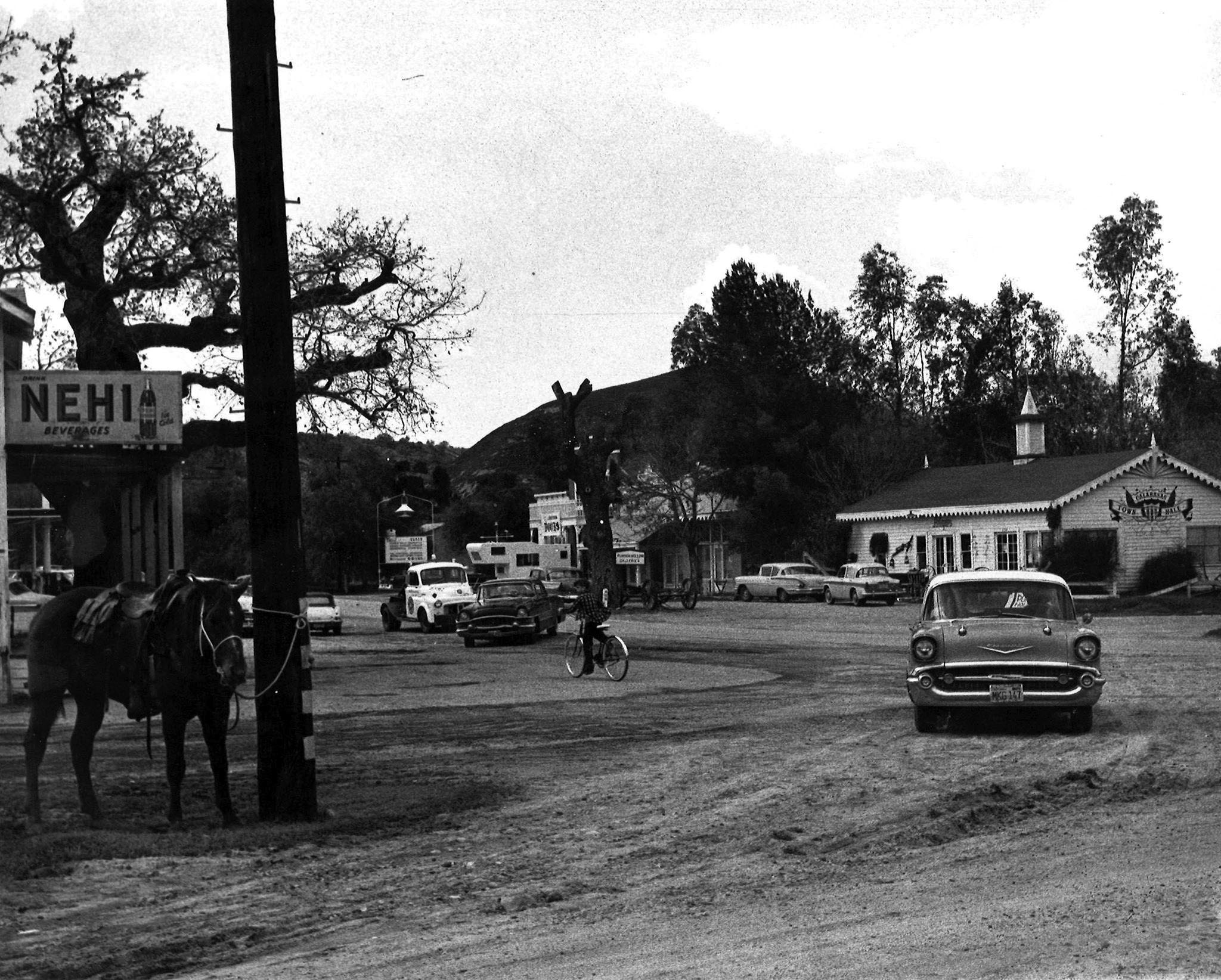 |
|
| (ca. 1958)* - View showing a 1957 Chevrolet making a right turn unto El Canon Avenue from Calabasas Road. On the left is a horse tied to a power pole. Behind the horse can be seen the Calabasas "Hanging Tree". Photo courtesy of Leonis Adobe Museum |
Historical Notes This ca. 1958 photo shows a 1957 Chevrolet turning right onto El Canon Avenue from Calabasas Road. On the left, a horse is tied to a power pole, recalling the area’s rural charm. Just behind the horse stands what many believed to be the Calabasas Hanging Tree, a large oak once thought to be the site of frontier justice. While no documented hangings are known, the tree became a local icon, especially after being featured in city logos and local events. After it died in the 1960s and fell in 1995, its remains were preserved and displayed nearby. However, some residents believe the real hanging tree was a different oak in front of a nearby store, sparking ongoing local debate. |
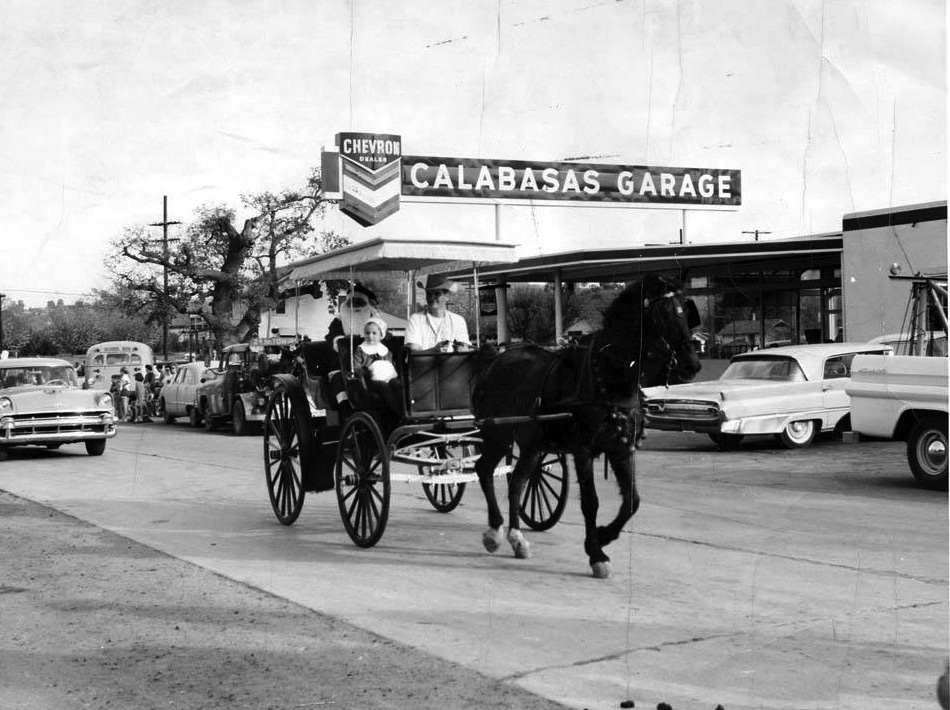 |
|
| (1960)* - Photo showing Archie E. Hanson, Jr. and his daughter in a horse-drawn buggy in the Calabasas Christmas Parade with the Calabasas "Hanging Tree" in the distance. |
Historical Notes Archie Hanson, Jr. developed Hidden Hills as well as Rolling Hills, CA. Mr. Hanson renovated the Leonis Adobe and lived there with his family for a few years. He also designed the gardens at the Getty House in Los Angeles and the gardens of the Harold Lloyd Estate among other projects. The photo is part of the Leonis Adobe Museum and Plummer House Collection. Courtesy of CSUN Oviatt Digital Library. |
Then and Now
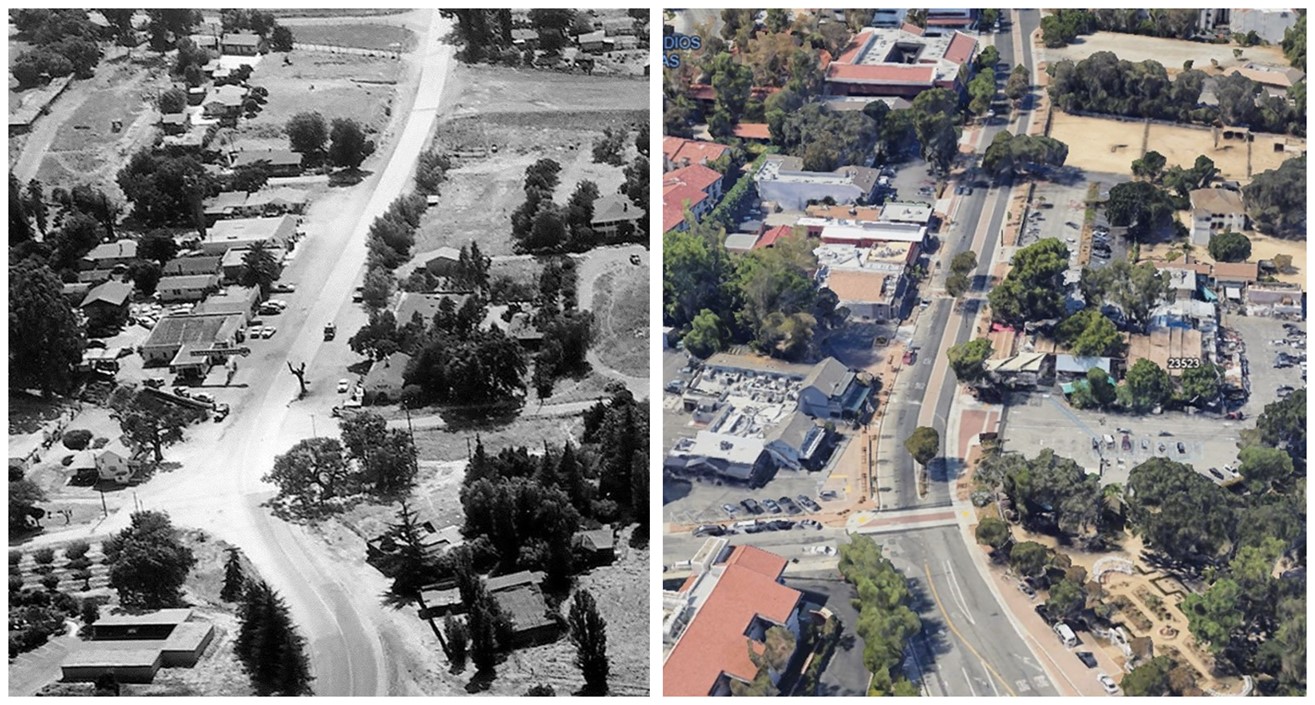 |
|
| (1958 vs. 2024)* - Aerial view of Old Town Calabasas with the intersection of Calaabsas Road and El Canon Ave seen at lower-left. Photo comparison by Jack Feldman. |
Historical Notes Today, Old Town Calabasas is a charming area that blends historical sites with modern attractions. A key feature is the Leonis Adobe Museum, a historic site dating back to 1844, offering a glimpse into 19th-century ranch life. Nearby, Calabasas Creek Park provides a picturesque setting with antique ironwork, gardens, and a creek, perfect for leisurely strolls and picnics. The area is also known for its dining and shopping options, including popular spots like Sagebrush Cantina, Pedalers Fork, and The Six Restaurant. Additionally, the Old Town Calabasas Farmers Market, held every Saturday, is a vibrant local hub for fresh produce and baked goods, making it a popular social and shopping destination. |
Then and Now
 |
|
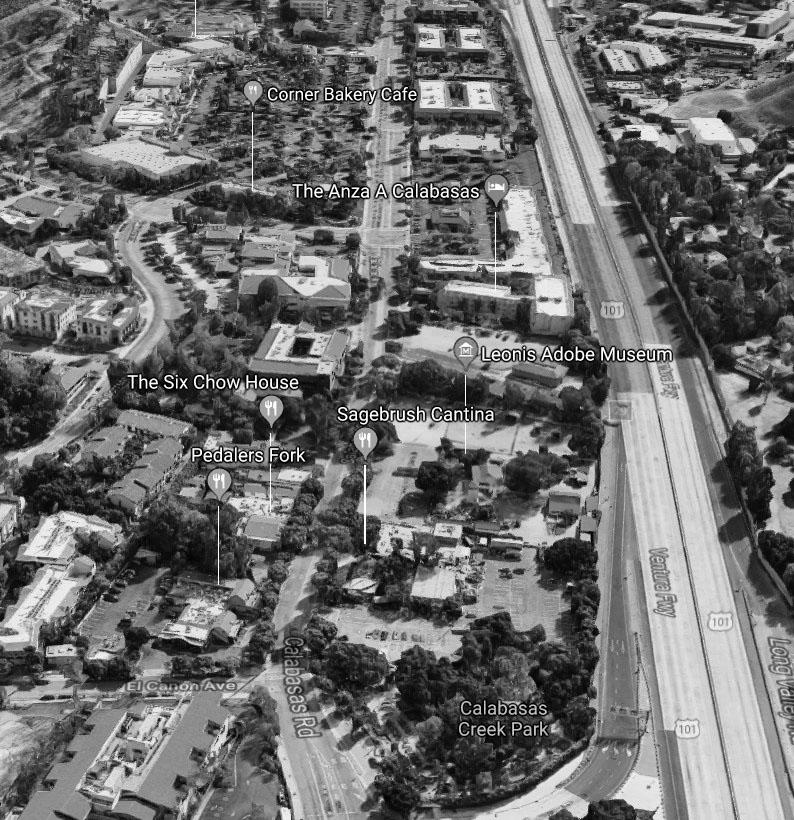 |
|
| (1958 vs. 2019)* - Calabasas Road |
Historical Notes This side-by-side look at Calabasas Road shows how the area changed over 60 years. Once a dusty two-lane road through a ranching town, it’s now a central part of a vibrant shopping and dining area. Still, reminders of the past remain. The Leonis Adobe continues to anchor the area, and stories of the Hanging Tree live on. Though the original tree—on the north side of Calabasas Road—fell in the 1990s, the legend persists, with some claiming the real tree was across |
* * * * * |
Jim's Fallbrook Market (originally Fallbrook Market)
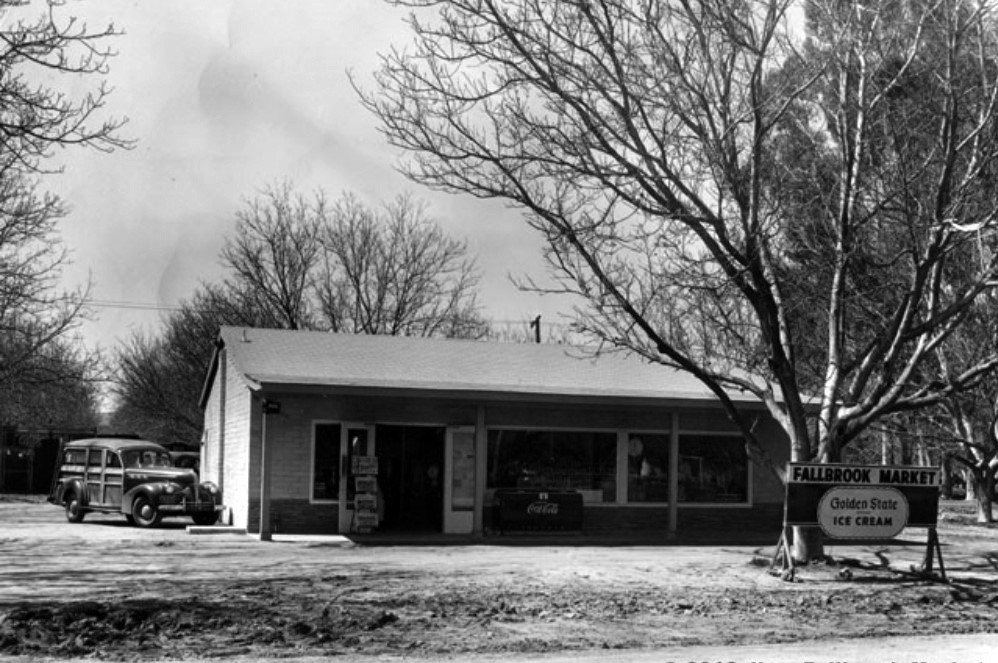 |
|
| (1940s)* – View showing Fallbrook Market located at 5947 Fallbrook Avenue in Woodland Hills. Note: Fallbrook Avenue is still a dirt road. |
Historical Notes Fallbrook Market was initially built and opened by the Lookabaugh Family in 1946, when Fallbrook Avenue was nothing but a rough-hewn dirt road, and the area was home to more nuts than people. It is one of the oldest businesses and certainly the longest continuously running market in the West San Fernando Valley. |
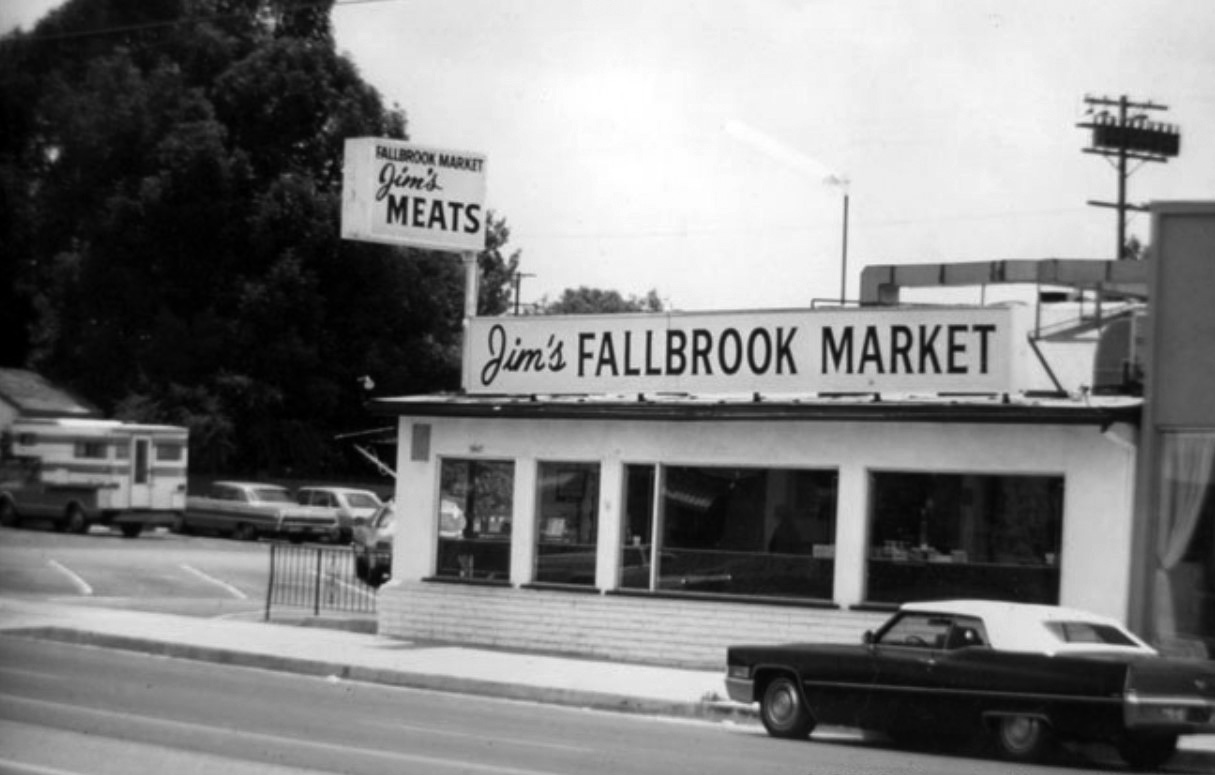 |
|
| (ca. 1965)* - View showing front of Jim’s Fallbrook Market with new sign. |
Historical Notes It operated as small grocery until 1951, when Jim McQuaid rented space in what was then a 40’x40’ building. He immediately installed a meat counter and became the store’s first butcher until 1958, when he purchased the market outright. Over the next 20 years, Jim renamed, remodeled and reconfigured the store to what it is today. |
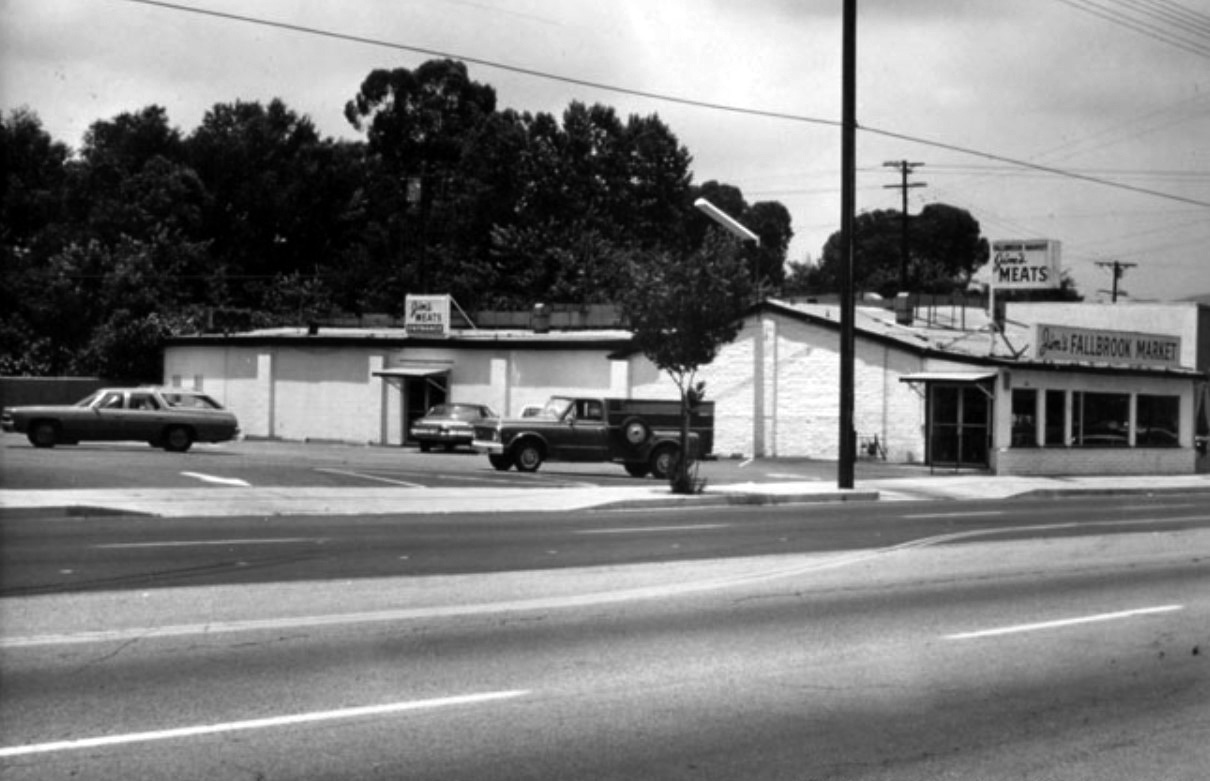 |
|
| (1960s)^ – View showing the parking lot and front of Jim’s Fallbrook Market in the early 60's. Click HERE to see contemporary view. |
Historical Notes After Jim McQuaid retired in 1978, sons Mike and Pat took over the store, splitting the meat-cutting/grocery duties. Pat retired in 2010 and Mike’s son, Cory, would soon join the operation. Jim’s Fallbrook Market, with over 50 years of a McQuaid at the helm, is the longest continuously running market in the West San Fernando Valley. |
* * * * * |
Fallbrook Square (today Fallbrook Center)
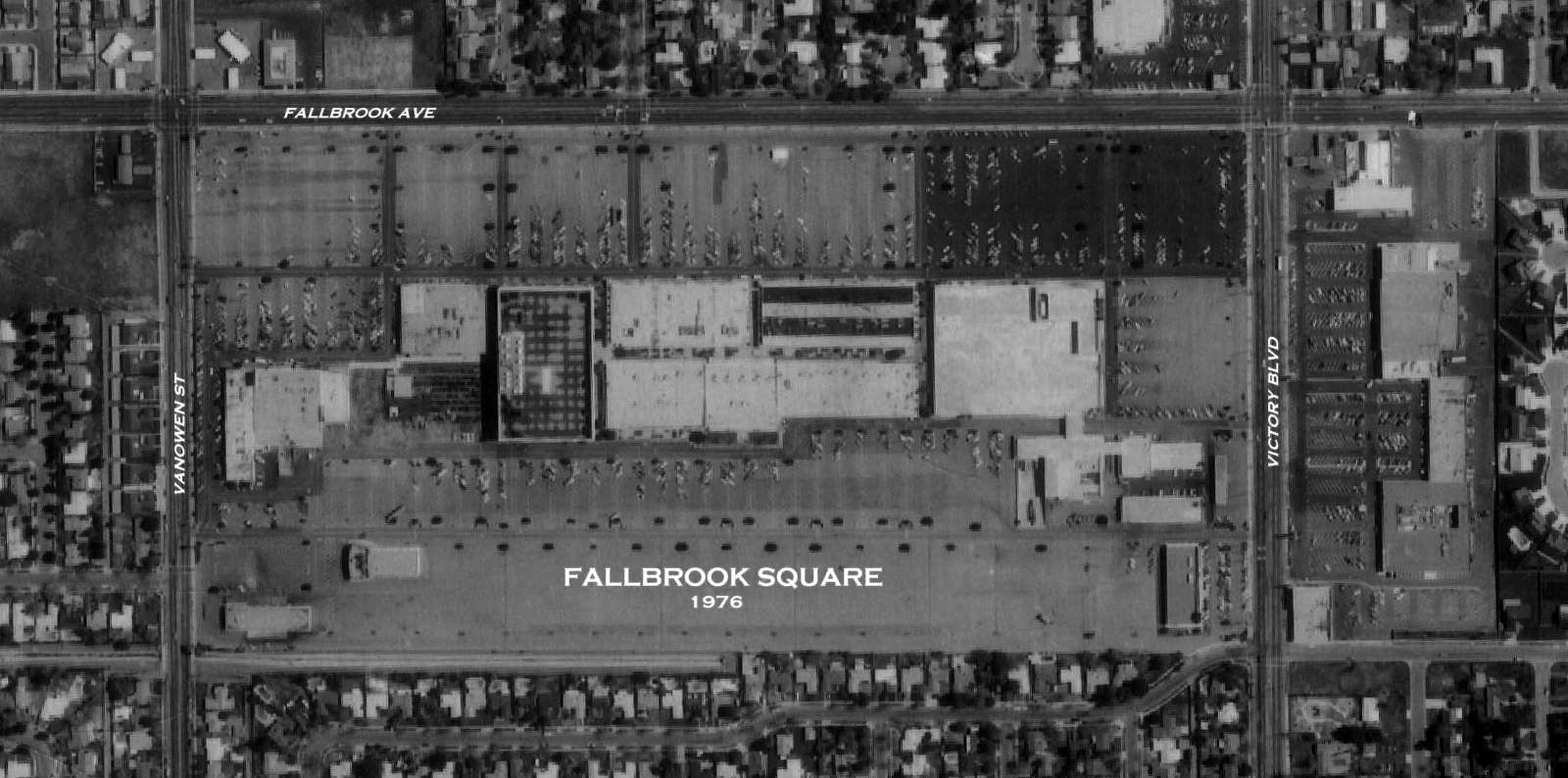 |
|
| (1976)* – Aerial view showing Fallbrook Square located at 6633 Fallbrook Avenue (Top is East, Left is North). Photo courtesy of Rich Krugel |
Historical Notes The complex, originally known as Fallbrook Square, opened between November 1963 and November 1966. Housing eighty stores and services in an open-air format, it was anchored by large Sears and J.C. Penney locations and included F.W. Woolworth, Ontra Cafeteria, House of Sight and Sound, Karl's Toys, Nibblers Restaurant, and a Market Basket supermarket. An enclosing renovation was done between April 1984 and July 1986. Target and Mervyn's anchors were added and the complex was renamed Fallbrook Mall. Damaged by the 1994 Northridge earthquake, and in decline by the late 1990s, the shopping venue was redeveloped between August 2001 and November 2003, emerging as the 1,200,000-square-foot Fallbrook Center of today. |
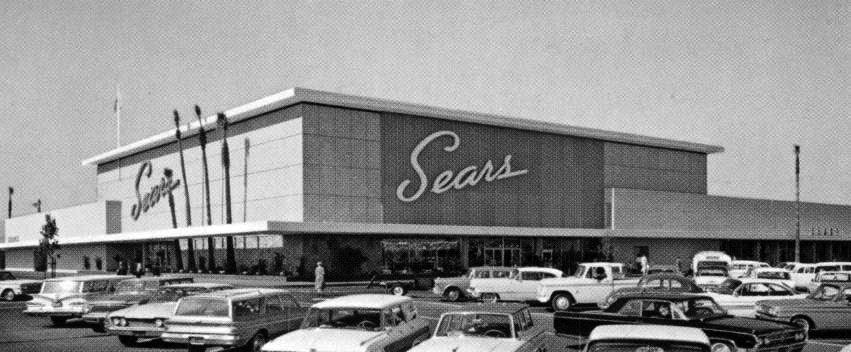 |
|
| (1960s)* - View showing Sears, one of the two anchor stores at the Fallbrook Mall. It was located at the southeast corner of the mall, near Victory and Fallbrook. |
Historical Notes The Fallbrook Square Sears, at 330,000 square feet, was said to be the largest store in the Chicago-based chain when it was built. The Sears, which had re-opened at the nearby Westfield Topanga in 1996, was divided between Big Kmart (upper level) and Burlington Coat Factory (lower level). These opened in 1997. The Big Kmart closed and re-opened, as a Wal-Mart (currently branded as Walmart), in January 2004. |
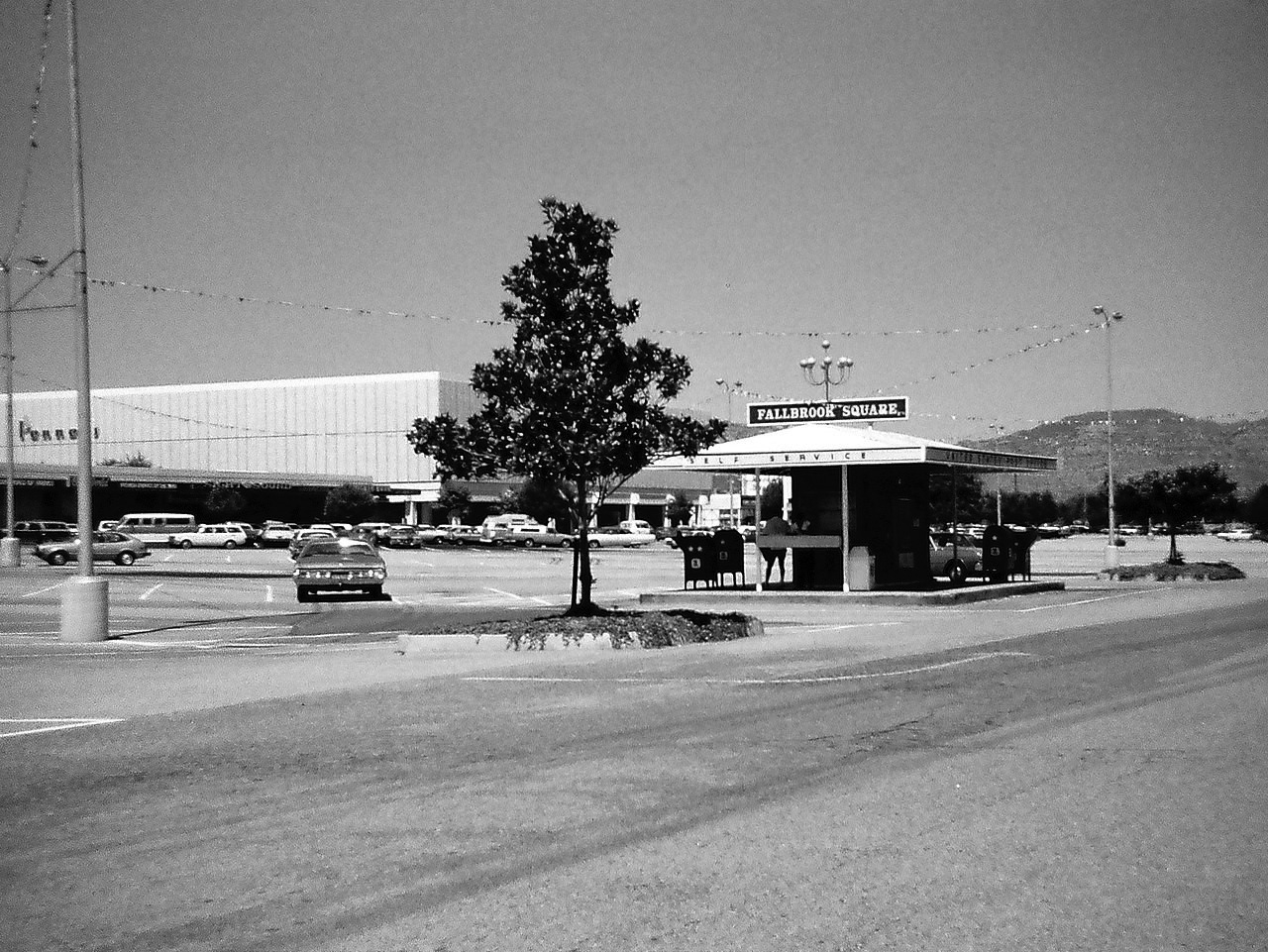 |
|
| (1978)* - View looking northwest showing the Fallbrook Square shopping center with former drive-up self-service post office in parking lot. J.C. Penney can be seen in the background. Photo by 'Antartic96' / Wikipedia |
Historical Notes The existing Penney's structure, vacated in April 2001, was retenanted by Kohl's. Today, the 75-acre Fallbrook Center is an open-air, 880,000-square-foot shopping center with retailers including Wal-Mart, Trader Joe's, Home Depot, Target, Ross Dress for Less, 24 Hour Fitness, Michael's, and Petco. |
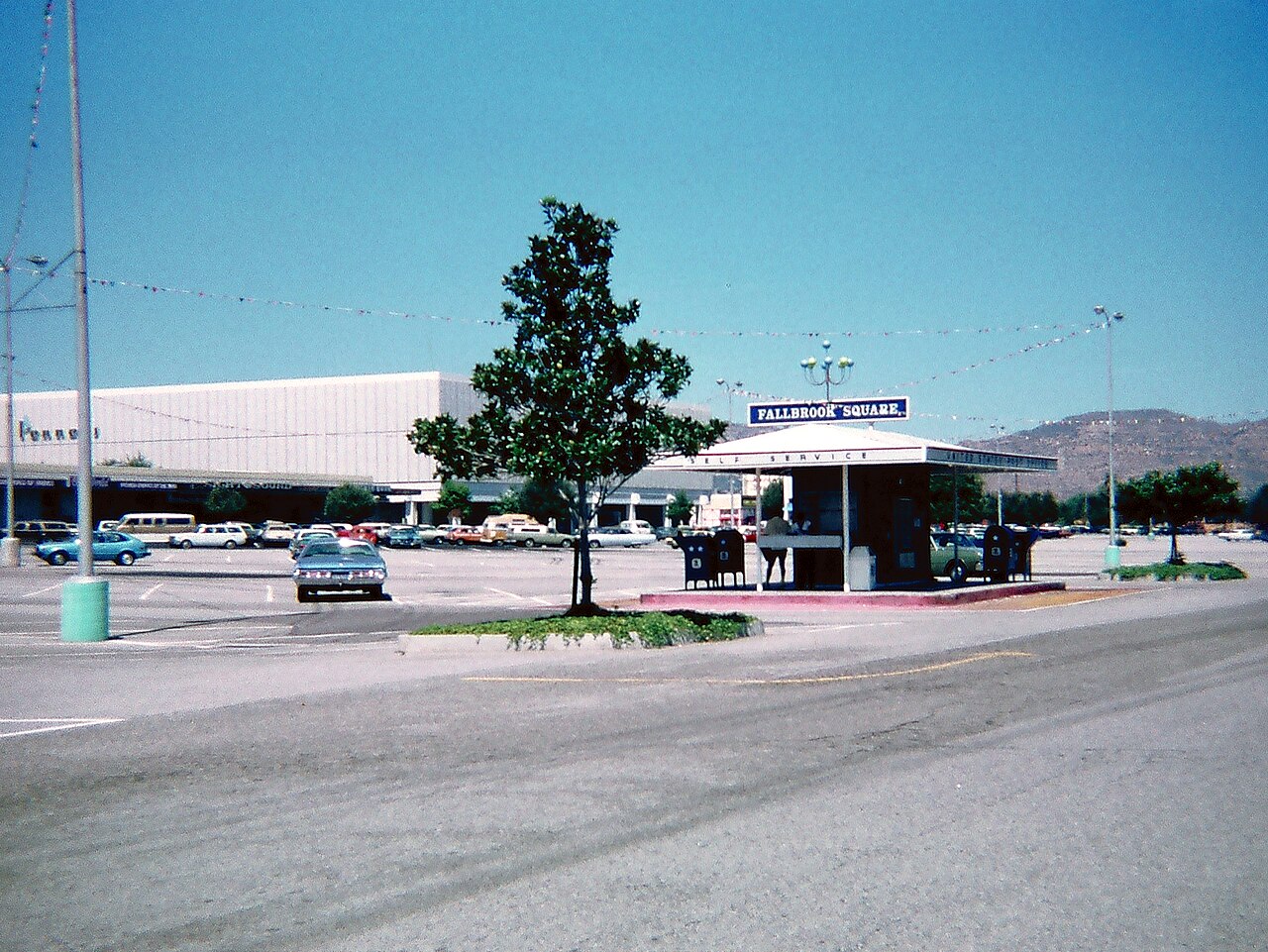 |
|
| (1978)* - View looking northwest showing the Fallbrook Square shopping center with former drive-up self-service post office in parking lot. J.C. Penney can be seen in the background. Photo by 'Antartic96' / Wikipedia |
Then and Now
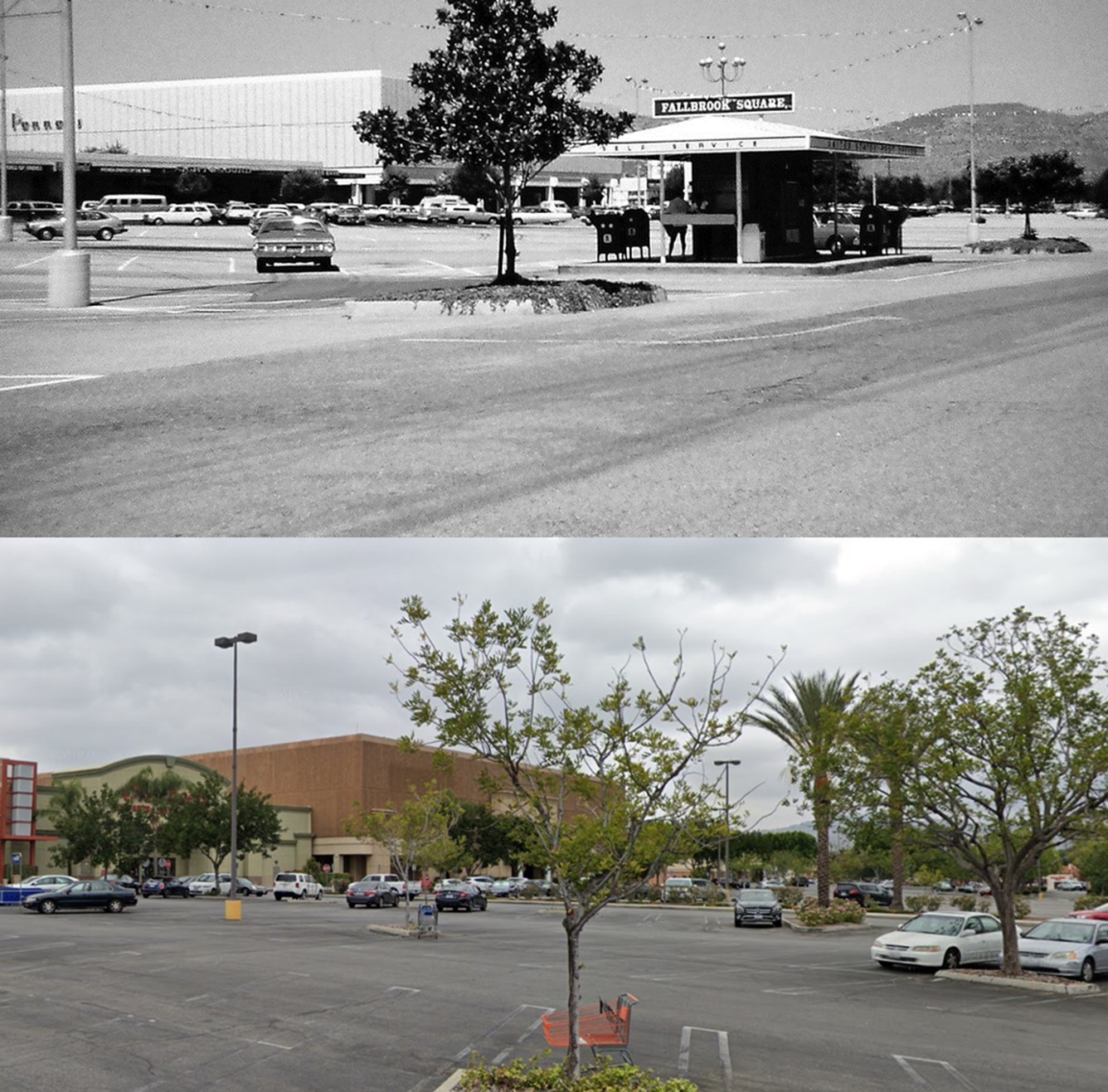 |
|
| (1978 vs 2018)* - Looking northwest showing the Fallbrook Square (today Falbrook Center) shopping center with former drive-up self-service post office in parking lot with J.C. Penney (today a furniture store) seen in the background. Photo comparison by Jack Feldman. |
* * * * * |
Fox Fallbrook Theatre
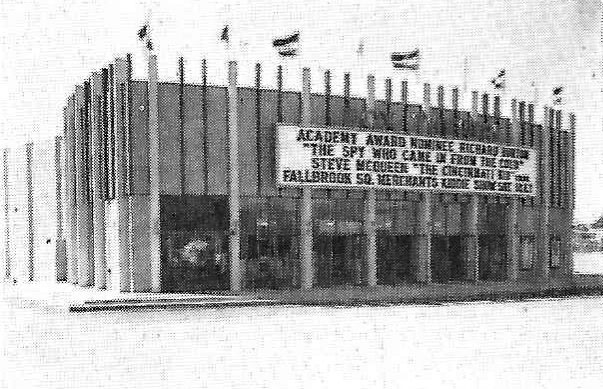 |
|
| (1966)* – View showing the Fox Fallbrook Theatre located at 22940 Vanowen Street on the Fallbrook Square property. |
Historical Notes The Fox Fallbrook Theatre was opened March 16, 1966 by National General Theatres with Richard Burton in “The Spy Who Came in from the Cold”. The Fallbrook was like the smaller single story neighborhood version of the National Theatre in Westwood. The theater was designed by J. Arthur Driellma, built by Ernest W Hahn Inc, and seated 874 persons. It would later get twinned, with Mann Theaters operating there in its final years. The last film shown here was November 1987, and the theater sat vacant for a couple of years, before being razed for a Chuck E Cheese. |
* * * * * |
Giacopuzzi Drive-thru Dairy (Saticoy and Fallbrook)
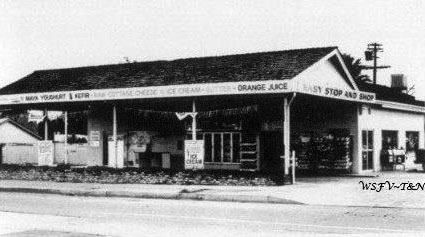 |
|
| (ca. 1960)* - View showing the Giacopuzzi Drive-thru Dairy on the SE corner of Saticoy Street and Fallbrook Avenue. Sign reads: Easy Stop And Shop. Photo courtesy of Keith Hart |
Historical Notes This building still exists today and is now called Altadena Express Market. Click HERE for contemporary view. |
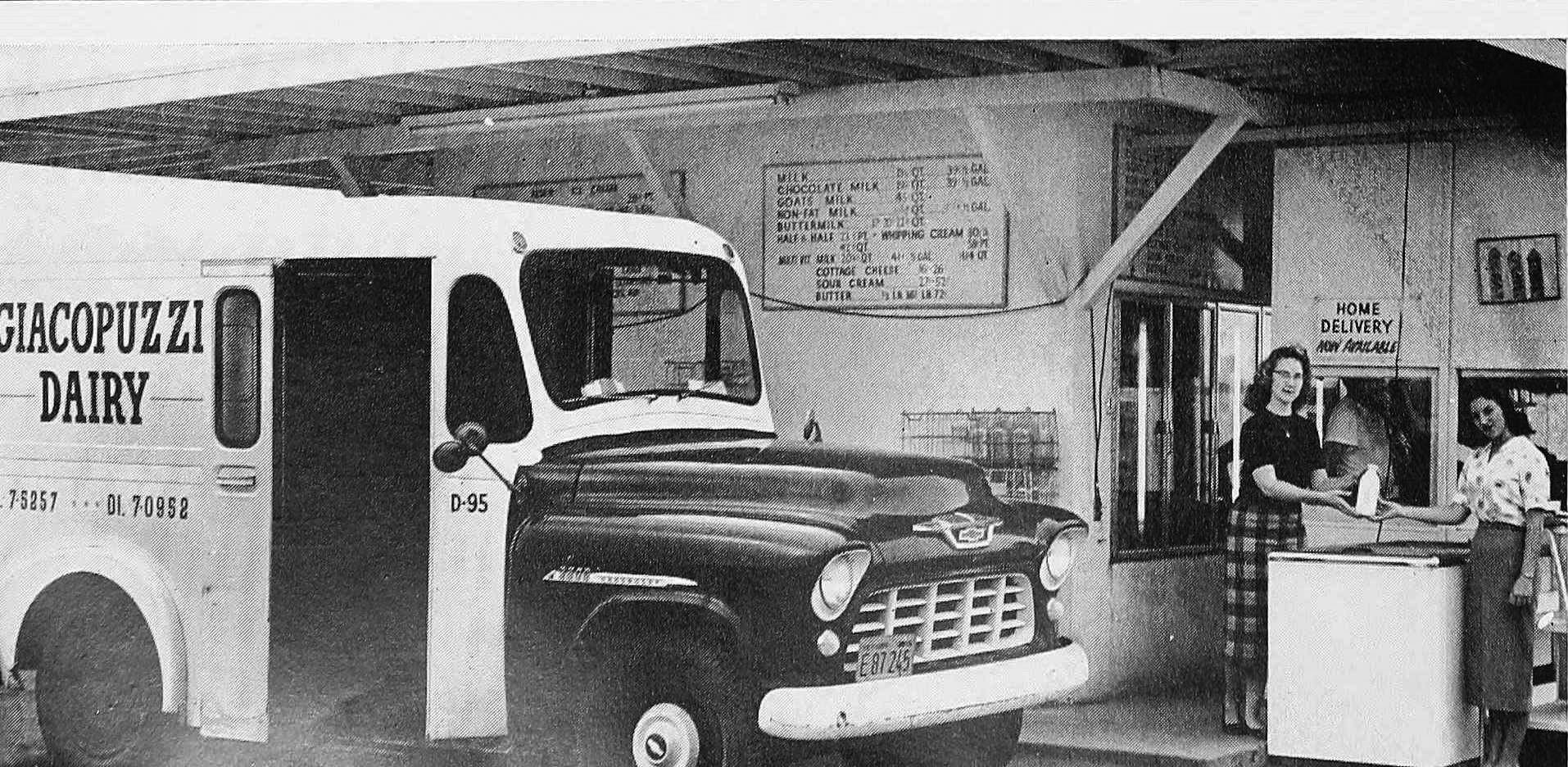 |
|
| (ca. 1958)* - Terry Marable and Sandy Blank hold a bottle of milk as they pose for the camera at Giacopuzzi Drive-thru Dairy. Photo courtesy of Keith Hart |
Historical Notes The Giacopuzzi family was one of the founding families of Owensmouth, which would later become Canoga Park. Brothers Mario and Guido Giacopuzzi ran the dairy farm from the 1950s with over 500 cows. Over the years the dairy farm received numerous awards from both the Los Angeles and Ventura County Fairs Boards for its quality production and award winning milk. The dairy herd was sold in 1983. |
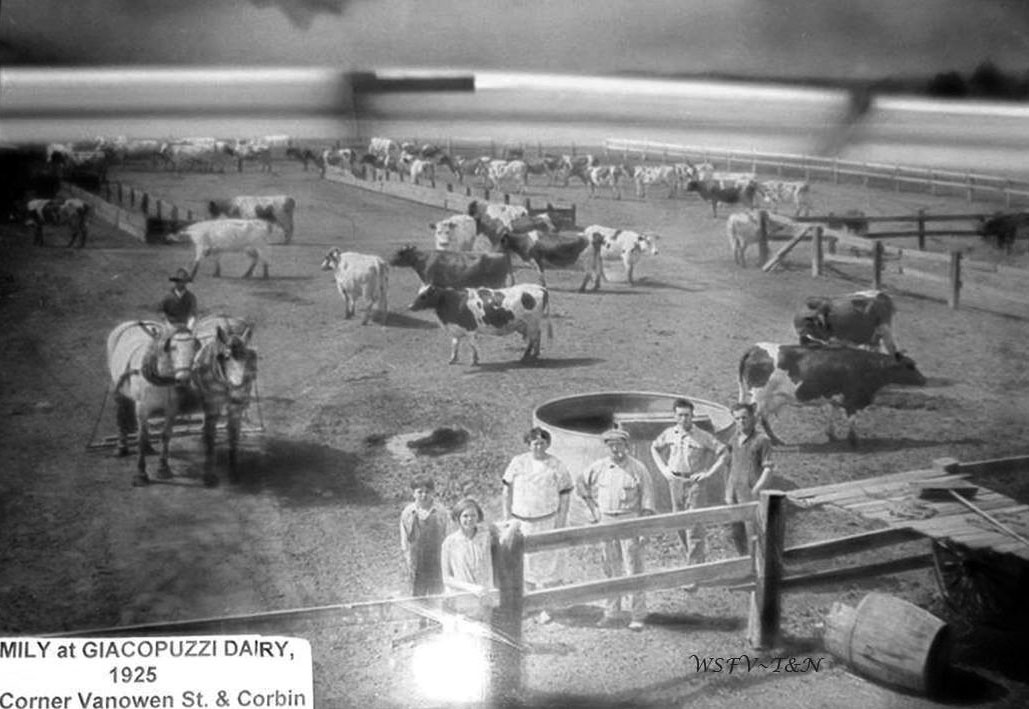 |
|
| (1925)* - This photo was taken at the NW corner of Corbin and Vanowen, and includes John & Rosie, two of their children, Irma and Lindo, and a few farm hands. The photo hangs in the Canoga-Owensmouth Museum, courtesy of Keith Hart. |
Historical Notes John Giacopuzzi, along wife Rosie and daughter Marie, immigrated from Italy in the very early 1900’s, and set up dairy farming in Los Angeles City, where more children were born. During this time, Antonio Giacopuzzi (aka Tony, and unrelated – Giacopuzzi was a common name in that part of Italy) also immigrated from the same area of Italy, and married Marie. Both families moved to the SFV, settling on two 10-acre plots of land at Vanowen and Corbin in Canoga Park in the early 1920’s, with a dairy farm, and some of the acreage devoted to other crops. Houses were built at 6841 Corbin Ave (John & Rosie) and at 19801 Vanowen (Tony & Marie). Tony’s sons Guido and Mario continued the family business for decades. In 1927, John purchased another ten acres along Sherman Way, farming this acreage as well. Eventually another 10 acres was acquired at the SE corner of Fallbrook and Strathern for dairy farming. Over time, the families opened up a couple more drive-thru dairies in the West Valley, as well as Thousand Oaks and Simi to sell their products. In the early 1950’s, the 10 acres at the corner of Corbin and Vanowen was leased to Canoga Dairy Farms, which eventually became Lindo Giacopuzzi's Corbin Dairy until 1967, when zoning on the property changed, and a shopping center was built. Circa 1967, the cows from both the Vanowen and Fallbrook Giacopuzzi locations were moved to a 48 acre dairy in El Rio, where the operation continued. |
Then and Now
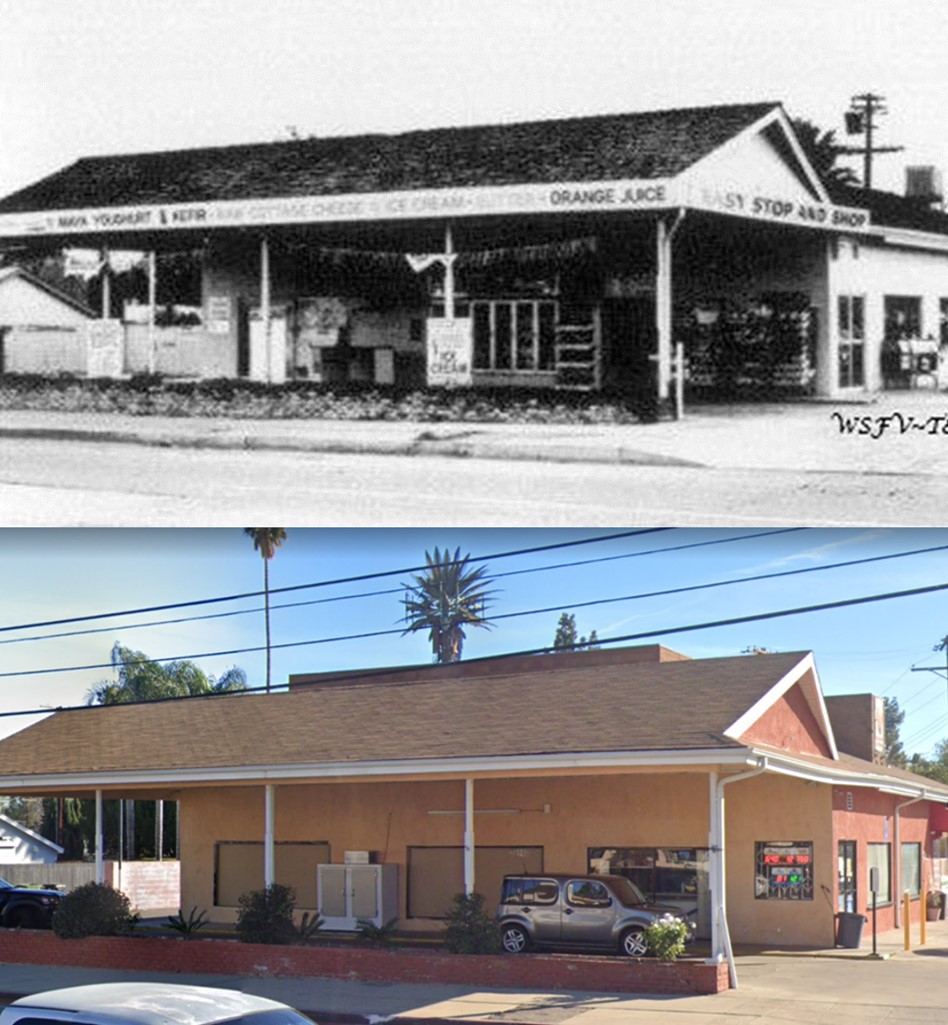 |
|
| (1960 vs 2021)* - Giacopuzzi Drive-thru Dairy (today Altadena Express Market) located on the SE corner of Saticoy Street and Fallbrook Avenue in West Hills. Photo comparison by Jack Feldman. |
* * * * * |
Circle S Ranch
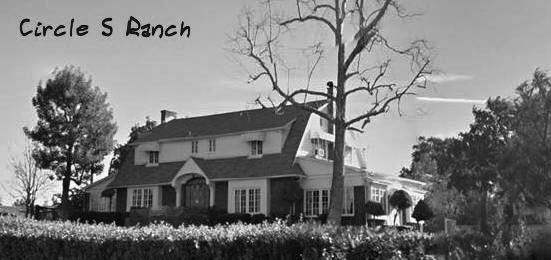 |
|
| (n.d.)* - View looking northeast showing the 1927-built home at Circle S Ranch, located on the southeast corner of Woodlake Avenue and Saticoy Steet. |
Historical Notes Around the time the Syndicate was selling lots in the town of Owensmouth, they also sold larger lots in the adjoining area. The property at Tenth Street (Saticoy) and Santa Ana Avenue (Woodlake), was purchased by a John T Hadley in 1911. He built a barn on the property, but no house. After his passing, his wife sold the property to a Virgil W Deaver; he also did not build a house. Frank S Howard, founder of the Howard Automobile Company, purchased the property in 1926. The house above was built for him in 1927. |
 |
|
| (2014)* – View looking at the main residence on the Circle S Ranch located at 7566 Woodlake Avenue. |
Historical Notes The two-story Dutch Colonial Revival Home was built for Frank Stewart Howard, a Buick distributer, in 1927 at the cost of $8,500.00. Frank founded The Howard Motor Company and had dealerships in Pasadena and Hollywood. He hired J.H. Hillard to build the house, a garage and 14 chicken coops of varying sizes to house exotic birds, and other animals including thoroughbred horses. The largest coop was 108 feet long. Unfortunately, Frank was a drinker and during a family argument in which he was choking his wife, his 12 year old son shot him and Frank died before he reached the hospital. The Howard Estate deeded the property to George Chambers on October 18, 1930. George and his wife, Mary retired to the ranch until George passed away in 1940. Mary sold the ranch to May Carreaud, who leased it to Grenville Stratton, a Douglas Aircraft executive who was well known for breeding horses, in 1944. Grenville built a guest house and turned the largest chicken coop into a barn. Grenville W. Stratton purchased the property (38.5 acres) from May in 1947. As the new owner, he changed the name of the property to Circle S Stables to suit the needs of his thriving horse racing and breeding business. * |
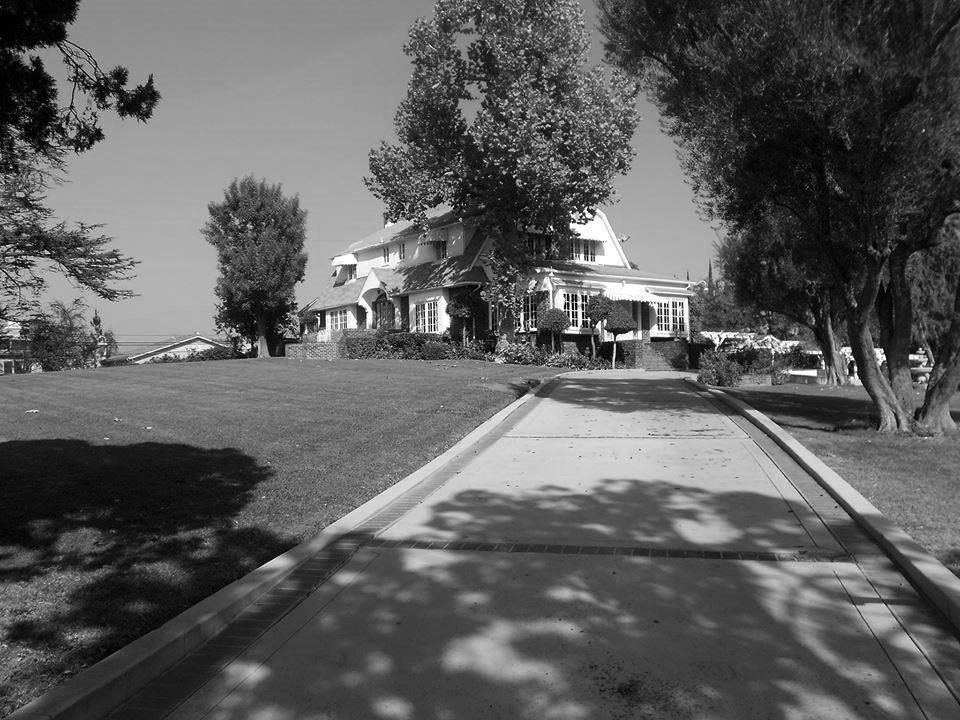 |
|
| (ca. 2017)* – View looking up the driveway toward the large ranch estate located on the SE corner of Woodlake Ave and Saticoy Street. Click HERE for a more contemporary view. |
Historical Notes The Circle S Ranch became widely recognized as a landmark on the southeast corner of Tenth Street and Santa Ana Avenue, later changed to Saticoy Street and Woodlake Avenue. Under Grenville's ownership, the Circle S Ranch made a name for itself in the horse racing industry. When Grenville's wife passed away, his stepdaughter sued him for half of the estate. In 1954, the cost of the long, drawn out lawsuit and Greenville’s bad health forced him to close the ranch. In 1956 the ranch was subdivided into 207 home site lots and one 3.46 acre lot for the remaining ranch buildings. The 100 foot horse barn was removed from the property and later razed when its new location was subdivided. The original barn was moved to a location on Zelzah but was also demolished to make way for an apartment building. Greenville’s second wife, Janice, sold the remaining property to William & Joy Ross in 1972. In 1990 it was put in a family trust in which it still remains today. |
* * * * * |
Shoup and Vanowen
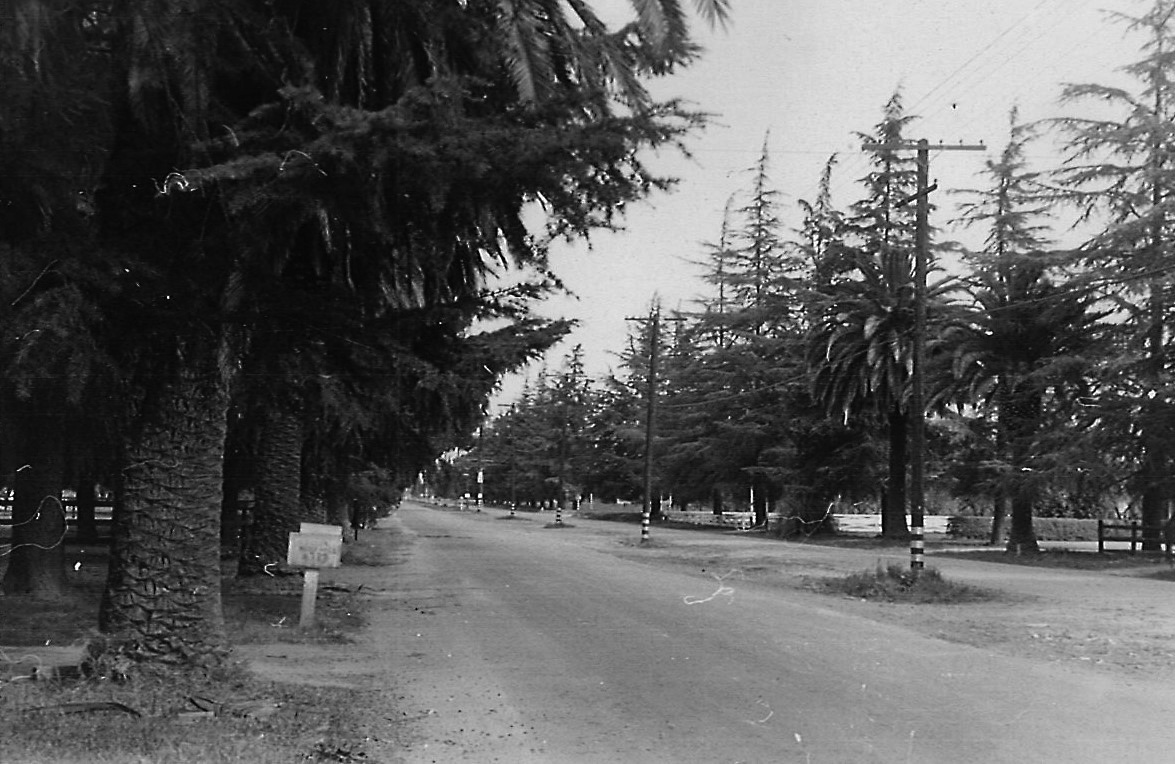 |
|
| (1940s)* - View looking north on Shoup Ave towards Vanowen Street. Trees line both sides of Shoup Ave with an overhead power pole line seemingly running down the center of the street. Photo courtesy of Martin Martindale |
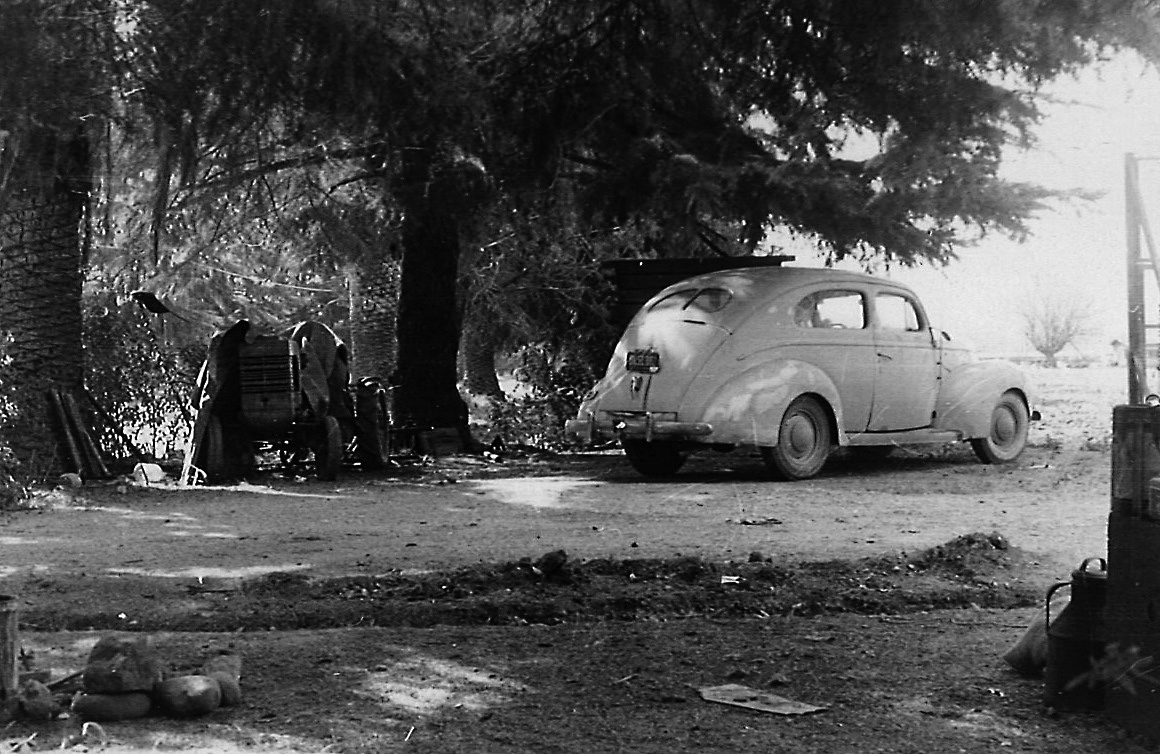 |
|
| (1940s)* – View showing a 1939 Ford Deluxe 2-Door Sedan next to a covered tractor in the driveway of a lot located on the 6700 block of Shoup Avenue. |
.jpg) |
|
| (1956)*- Aerial view over Shoup Ave and Vanowen Street showing several open fields. The pole line in the center median can clearly be seen. Photo courtesy Dean Fields. Click HERE to see contemporary view. |
Historical Notes Shoup Avenue was named after Paul Shoup, a vice president of the Southern Pacific Railroad and president of the Pacific Electric Railway Co. Vanowen Street was coined because it was the direct route across the Valley between the towns of Van Nuys and Owensmouth. Click HERE to see more SFV Street Name Origins. |
Then and Now
 |
|
| (1940s vs 2021)* - View looking north on Shoup Ave towards Vanowen Street in West Hills. |
* * * * * |
Woodland Hills
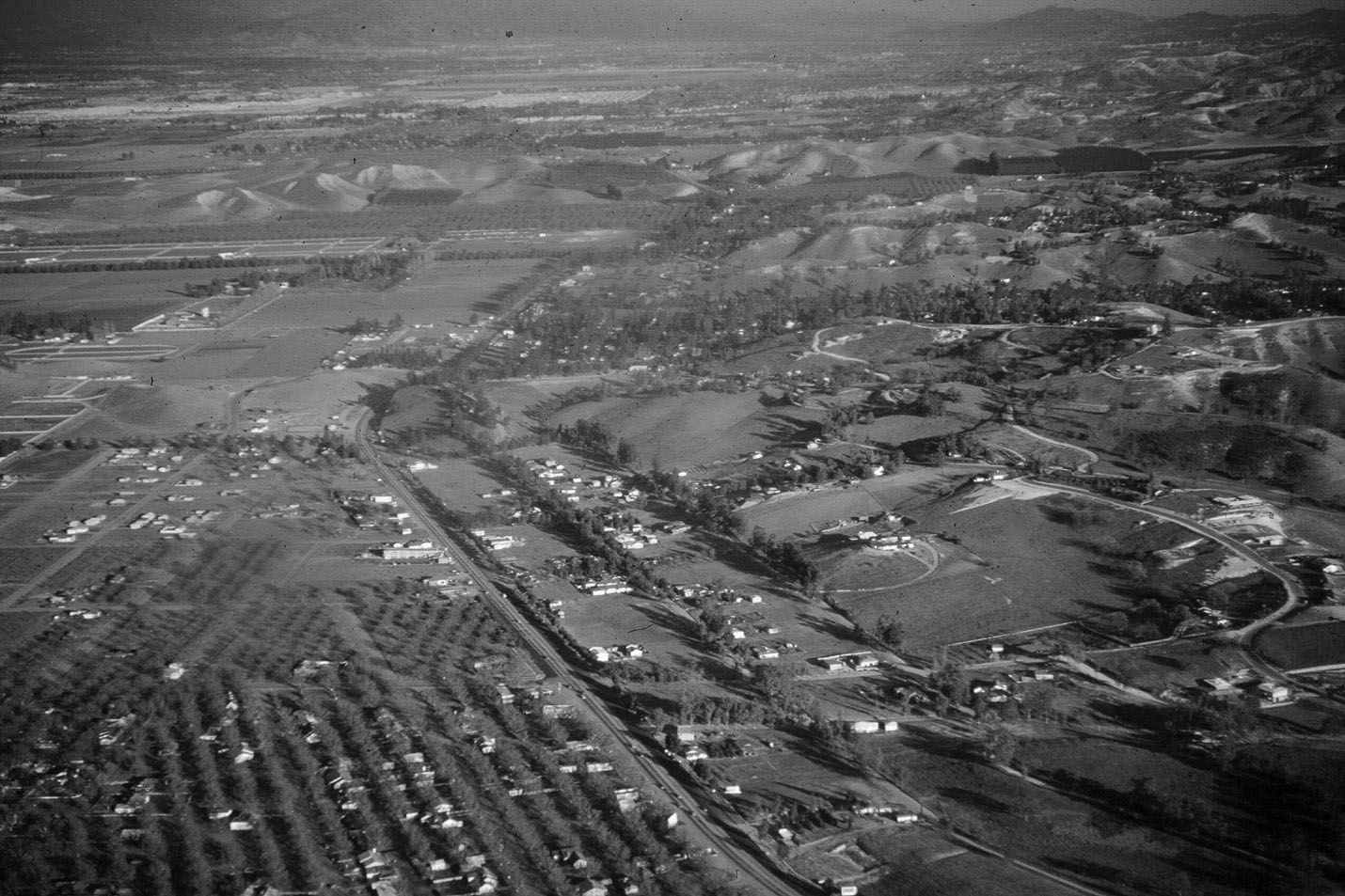 |
|
| (ca. 1952)* – Aerial view of Woodland Hills looking east. The large road running away at bottom-center is Ventura Boulevard. It makes a slight turn just past Shoup Avenue (center-left). The freeway was built on top of the second block over to the right with Avenue San Luis paralleling it, next street over. |
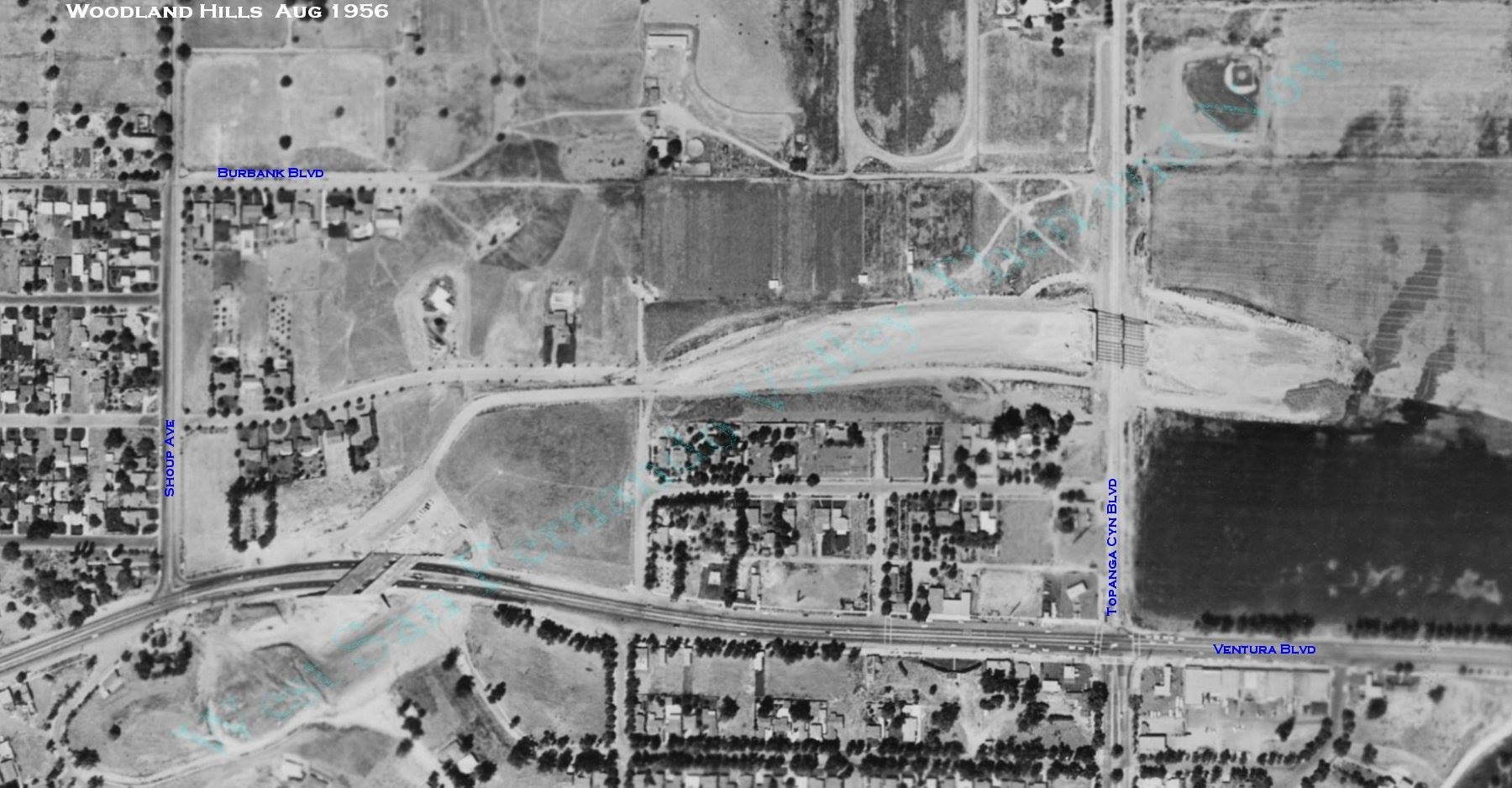 |
|
| (1956)#^*^ - Aerial view showing overpass construction on the 101 Freeway (Ventura Freeway) at Topanga Cyn Blvd (center-right) and further west at Ventura Blvd, east of Shoup Ave (lower center-left). Annotated by Rich Krugel |
Historical Notes Shoup Avenue was named after Paul Shoup, a vice president of the Southern Pacific Railroad and president of the Pacific Electric Railway Co. Topanga Canyon Boulevard - The name 'Topanga' evidently means 'above' with reference to the village site being above the high water of Topanga Creek. The 'nga' with which the name ends means 'place' and the entire name apparently means 'above place' or, as we would say in current English, merely 'above'. The name is an old Shoshonean word and can also be used in reference to the sky or heaven. Click HERE to see more SFV Street Name Origins. |
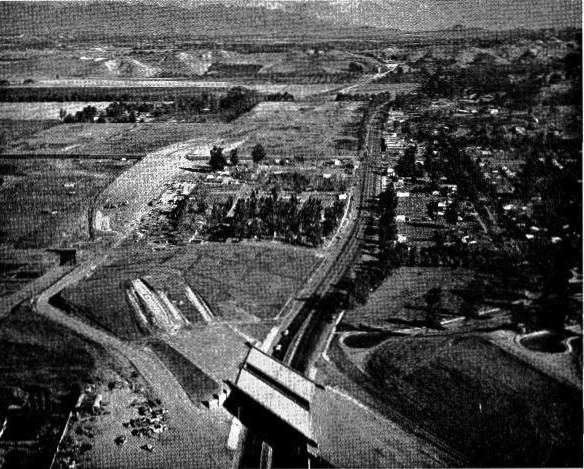 |
|
| (1956)* – Aerial view looking east showing the construction of the Ventura Freeway Bridge over Ventura Boulevard, east of Shoup Avenue. |
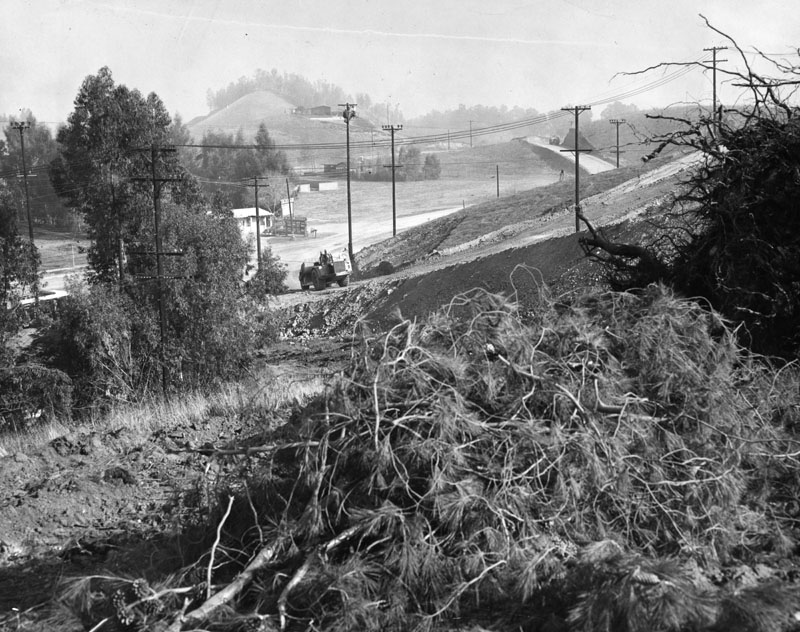 |
|
| (1956)* - Construction across Ventura Bouelvard in Woodland Hills, before freeway construction, near Shoup Avenue, about a mile west of Topanga Canyon. Photo dated: Jan. 11, 1956. |
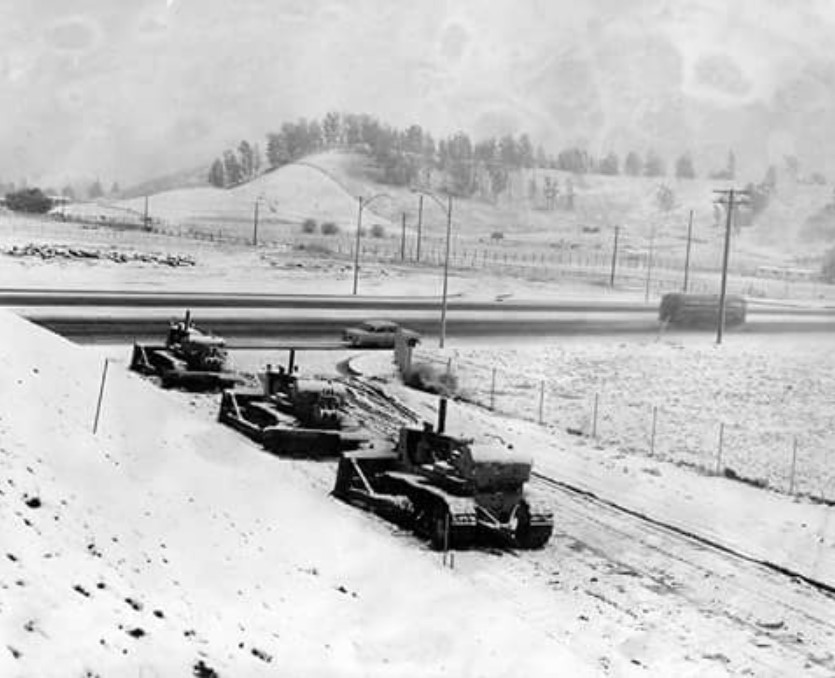 |
|
| (1957)*- January SNOW FALL has tractors stalled on the Ventura Freeway exit at Topanga Canyon Boulevard during freeway construction. Photo Date: January 29, 1957 |
Historical Notes The bulldozers are parked on the Topanga North off-ramp of the westbound 101. Across the street the cut for the Topanga South off-ramp can be seen. The hill in background is still there and is topped by the private homes on Como Circle. The bus is driving north on Topanga approaching Burbank Boulevard. |
 |
|
| (1950s)* - View looking west of street construction on Ventura Boulevard in Woodland Hills (near where the Ventura Freeway crosses Ventura Boulevard today). Cranes and other construction equipment sit along the left side of the street, while to its right sits the single-story Woodland Realty office. A sign to the right of the building advertises "Woodland Realty - Real Estate Service - 22233 Ventura Blvd - Drive in - Homes - Lots – Acreage." Another street (possibly Shoup), lined by parked automobiles, intersects the main street in the upper portion of the image. |
* * * * * |
Ventura and Canoga
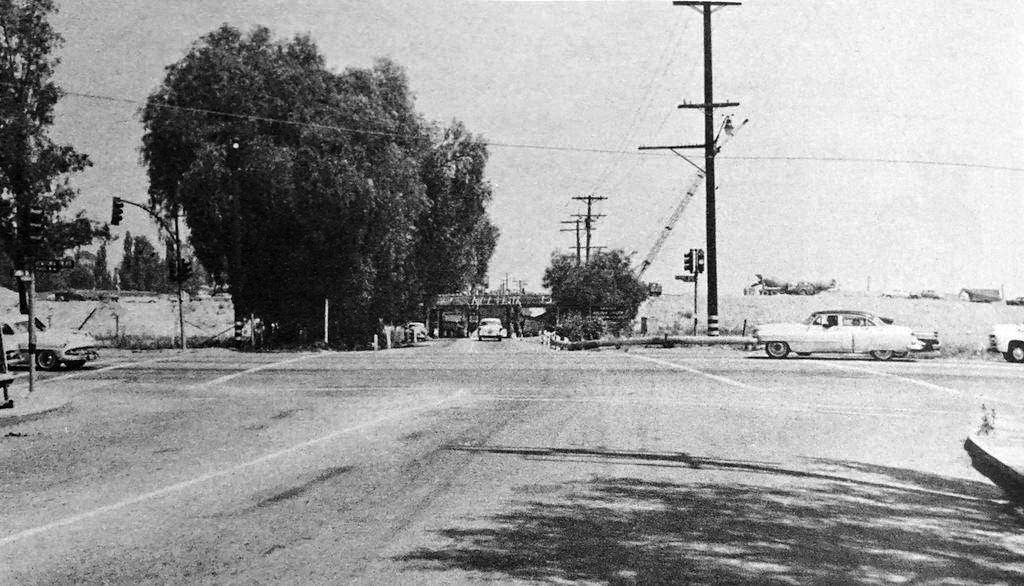 |
|
| (1957)^ – View looking north on Canoga Ave at Ventura Boulevard. In the background can be seen the construction of the Ventura Freeway. Today, Whole Foods is on the NE corner and Vista Ford is across the street on the NW corner. Click HERE for contemporary view. |
Then and Now
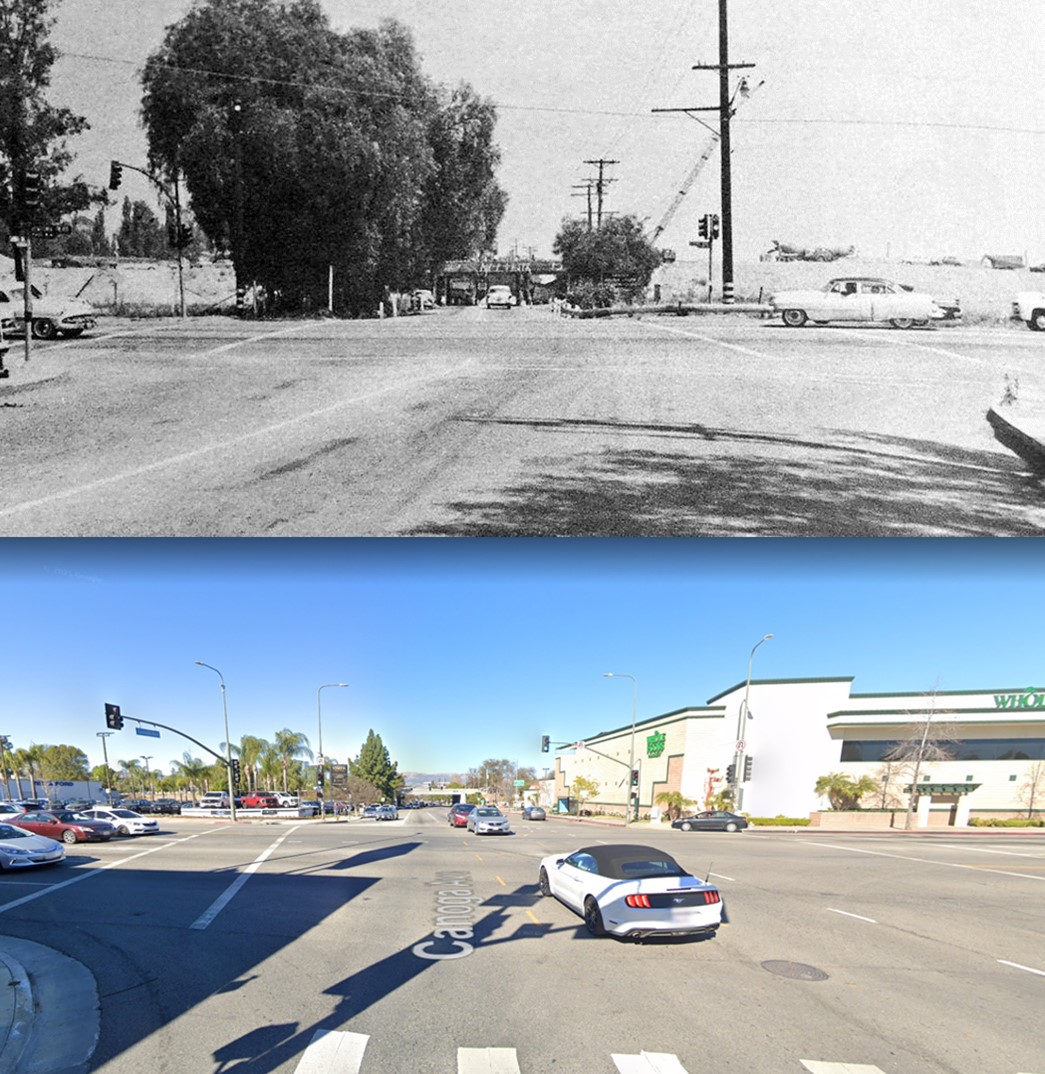 |
|
| (1957 vs 2021)* - Looking north on Canoga Avenue at Ventura Boulevard. |
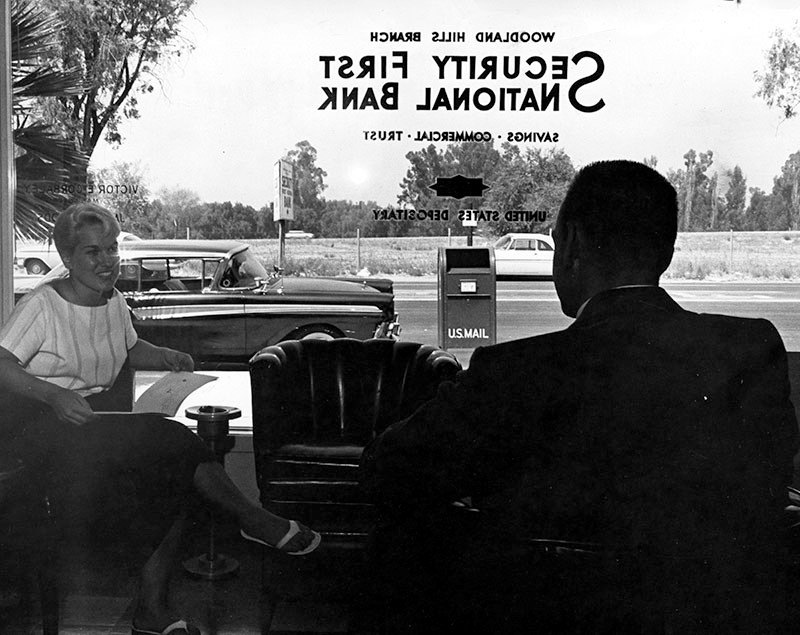 |
|
| (1961)* - Pictured is the Woodland Hills branch of the Security First National Bank, located at 21620 Ventura Blvd., Woodland Hills. A woman and man can be seen sitting in the lobby of the bank, and beyond the large glass 'wall', several automobiles are parked along the street, with a U.S. mailbox front and center. In the distance can be seen a car on the Ventura Freeway. Vista Lexus now occupies the empty lot across the street. |
* * * * * |
Sheep Along Ventura: Woodland Hills in the 1950s
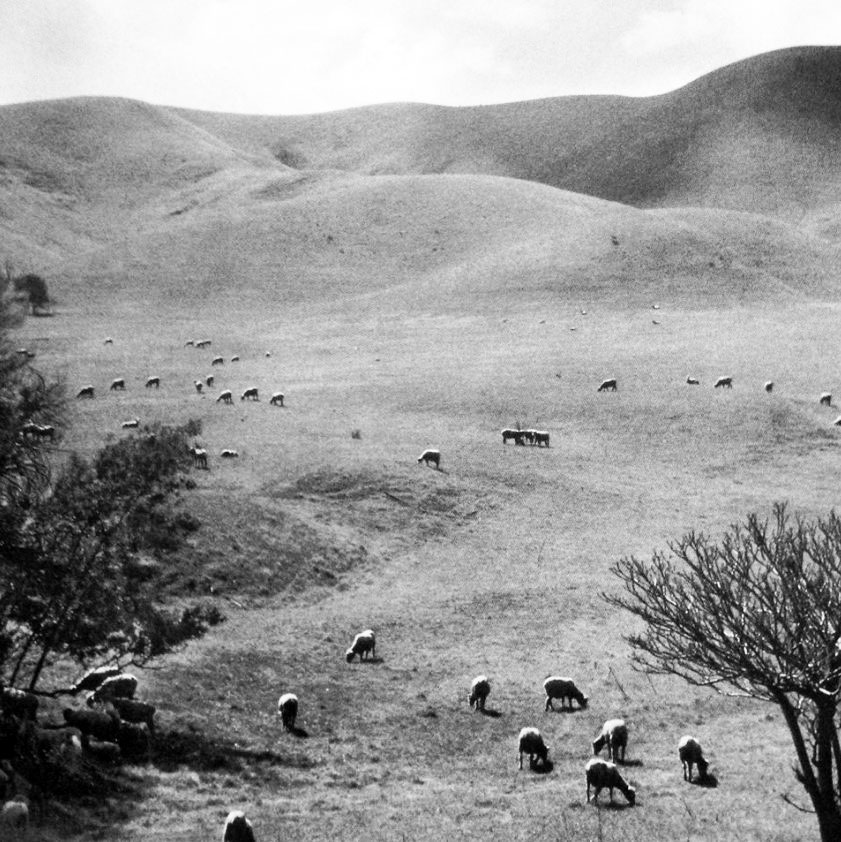 |
|
| (1950s) - Sheep grazing on the hills along Ventura Boulevard in Woodland Hills. |
Historical Notes In the 1950s, flocks of sheep were a familiar sight across the San Fernando Valley. Ranchers routinely moved their herds from one hillside to another, allowing them to feed on open grasslands before the land was developed. At that time, Woodland Hills was still largely rural, with wide stretches of farmland and ranch property. Over the next few decades, as Los Angeles’ population grew and housing demand soared, these open spaces were transformed into neighborhoods and commercial centers. The agricultural era faded—and with it, the pastoral scenes that once defined life along Ventura Boulevard. |
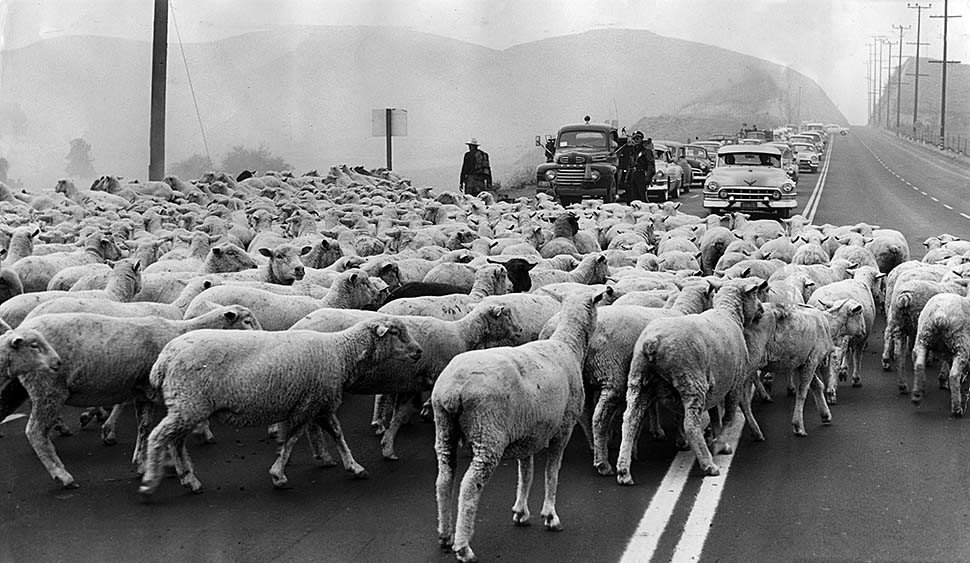 |
|
| (1955)* - With the help of policemen, sheep are moved across Ventura Blvd in Woodland Hills. View is looking west on Ventura Blvd toward Chalk Hill from near Winnetka Ave. Taft High School, would open on the left in 1960. |
Historical Notes A Los Angeles Times article dated October 18, 1955, described the unusual scene:
During this period, much of the San Fernando Valley still reflected its ranching roots. But within a few short decades, urbanization would overtake agriculture, and Ventura Boulevard—once lined with grazing hills—would become a major commercial corridor. These glimpses remind us that before shopping centers, gas stations, and traffic lights, Woodland Hills was part of a quieter, rural landscape where livestock still roamed freely. |
Then and Now
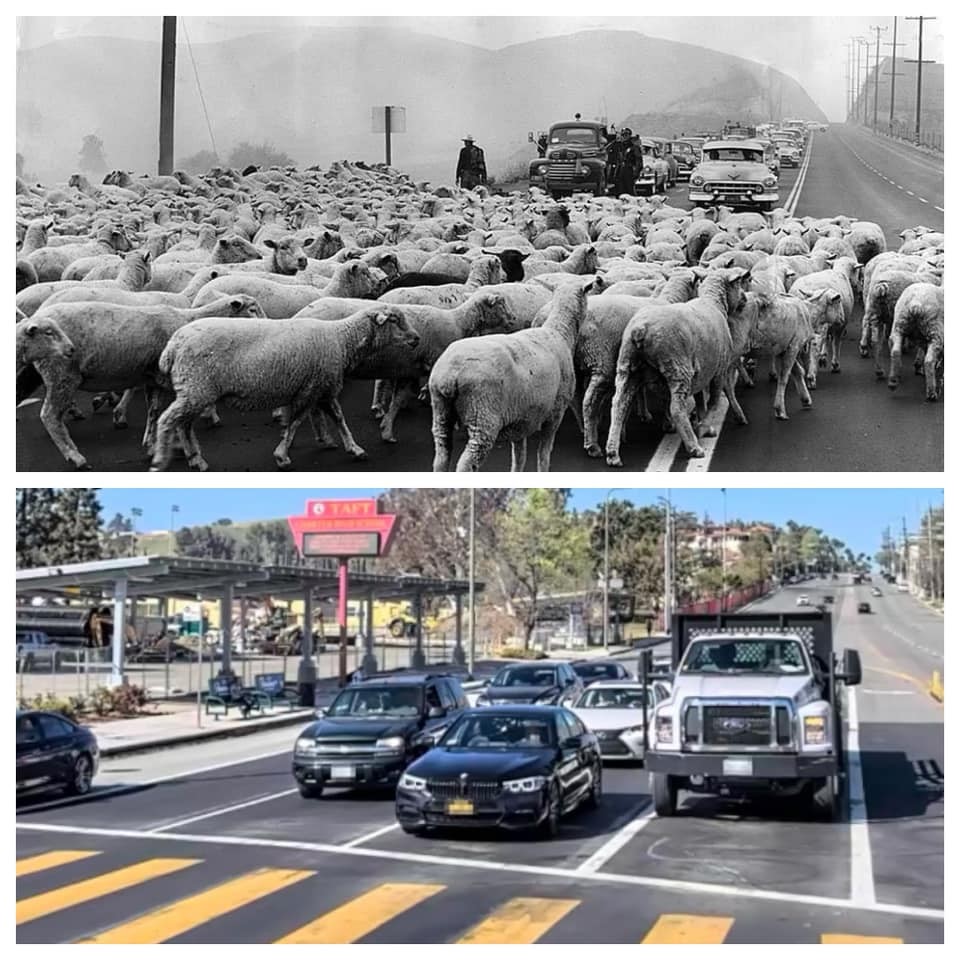 |
|
| (1955 vs. 2020s)* - Looking west on Ventura Blvd toward Chalk Hill from near Winnetka Ave. Taft High School seen on the left, would open in 1960. Comparison photo by Trey Callaway. |
Historical Notes This “Then and Now” comparison shows just how dramatically Woodland Hills has changed. In the 1955 view, the hills were still mostly undeveloped, with open slopes and a few scattered structures. In the modern 2020s photo, the same stretch of Ventura Boulevard is now lined with trees, cars, and commercial buildings. The transformation mirrors the story of the entire San Fernando Valley — a region that evolved from rural farmland into a suburban cityscape. By the 1960s, sheep grazing had disappeared entirely, replaced by schools, homes, and busy streets. Scenes like these capture a fleeting moment in time — when Woodland Hills was still a bridge between Los Angeles’ agricultural past and its suburban future. |
* * * * * |
Lindley Bothwell Ranch (Woodland Hills)
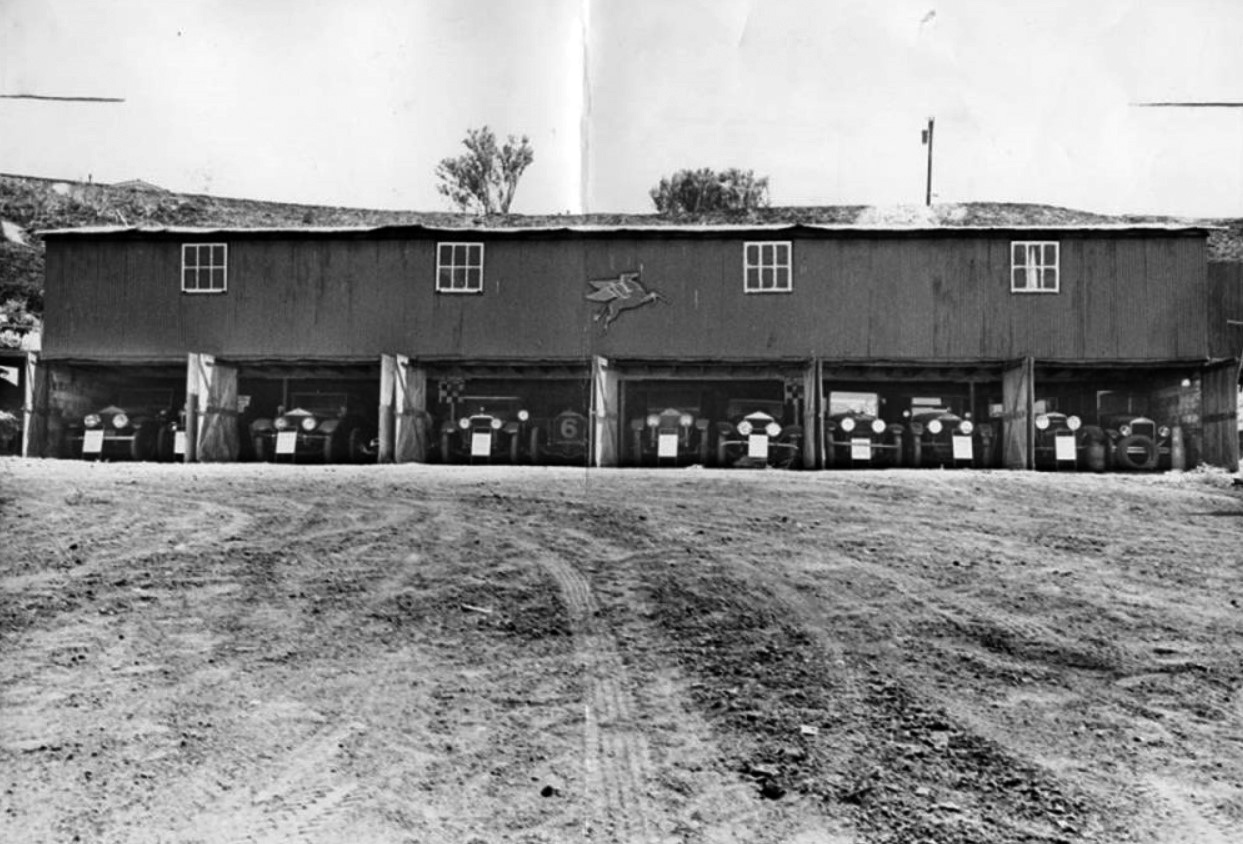 |
|
| (1963)* - Valley Times photo caption reads "Small part of Lindley Bothwell's huge car collection stares out of barn." - August 1, 1963 |
Historical Notes Lindley Bothwell was born in L.A. in 1901. He was a USC graduate, prosperous Southern California orange grower, a citrus agriculturalist from his Lindley Bothwell Ranch located at 5300 Oakdale Avenue in Woodland Hills, and an antique automobile collector and racer.^ |
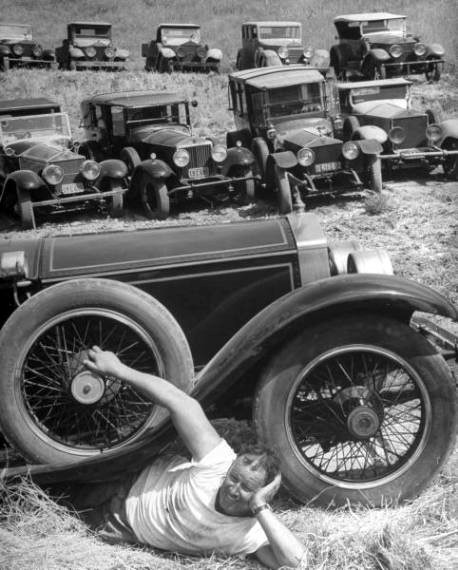 |
|
| (ca. 1960s)^.^ - View showing Lindley Bothwell posing for the camera as he relaxes under a 1948 Rolls Royce with the rest of his Rollers “collection” seen in the background. |
Historical Notes Bothwell collected antique cars and created vintage racing in the US in the 40s & 50s. By 1954, he was the owner of the largest private antique automobiles collection in the country. His impressive collection included the 1911 Rolls-Royce of the last tzar of Russia. At its peak the Bothwell collection numbered 88 cars. He served as the Los Angeles regional executive of the Sports Car Club of America.^ |
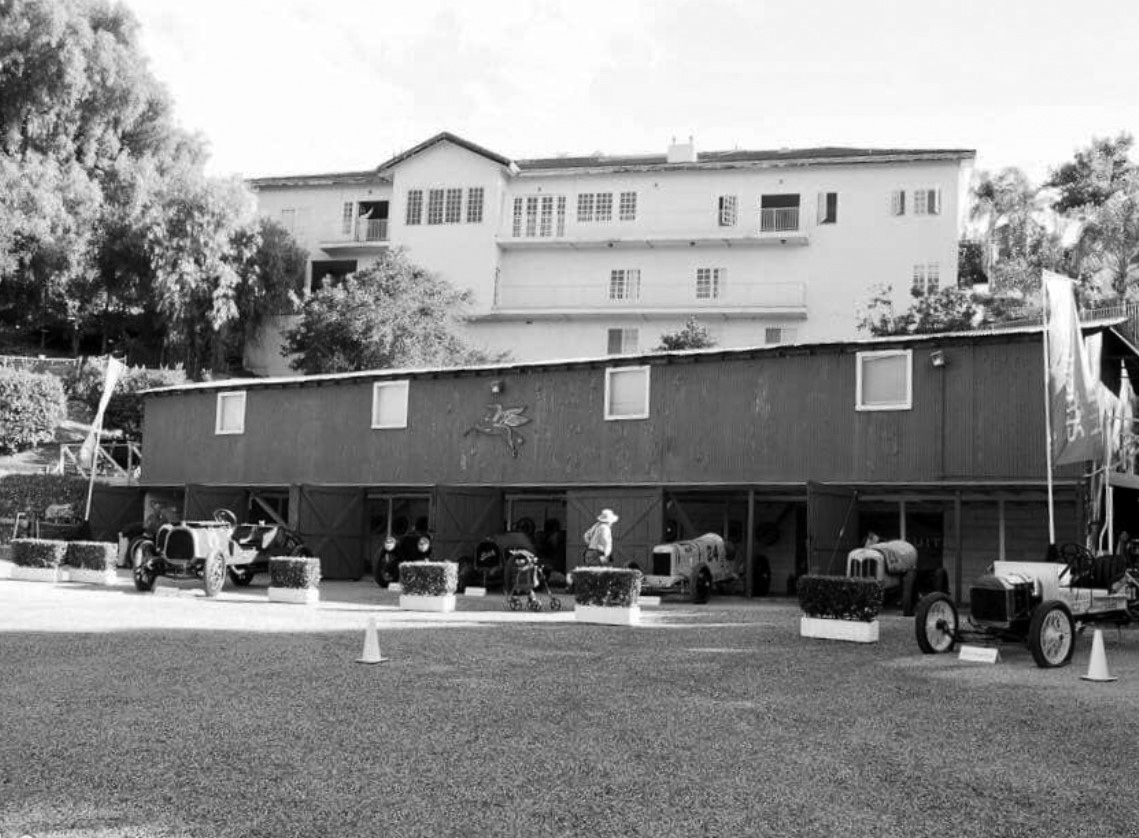 |
|
| (2017)^* - View showing the Bothwell Barn with vintage model cars on display as it appears today. |
Historical Notes On November 11, 2017 An auction of the Bothwell collection brought in over $13 million in sales, including the significant 1914 Peugeot grand prix race car that topped the charts at $7.26 million.^ |
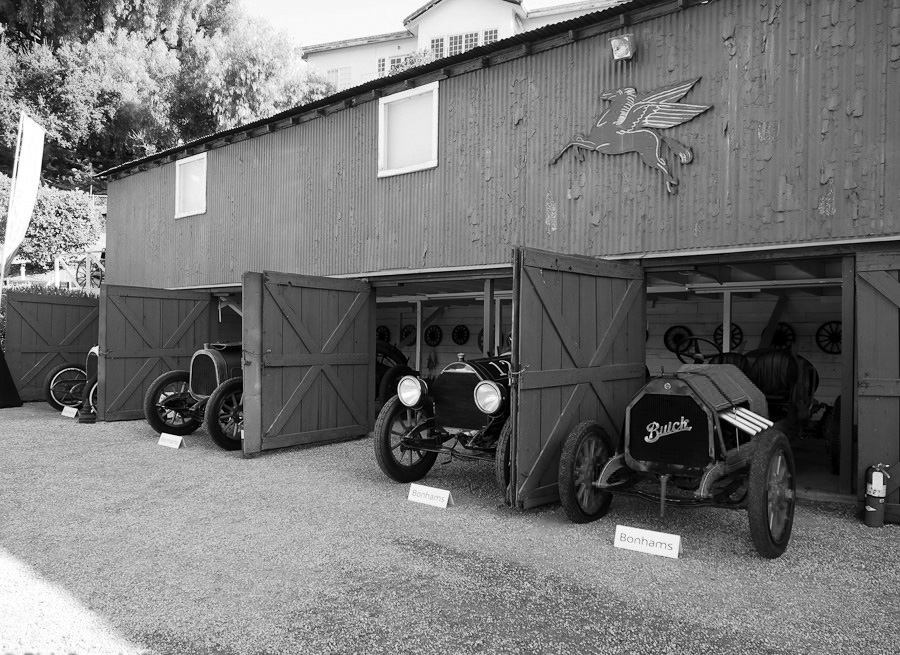 |
|
| (2017)^* - Close-up view of Bothwell’s Barn with more antique cars on display during an auction. |
Historical Notes In addition to the antique cars, Brothwell also collected, trains, horse-drawn streetcars and had the only private collection in the world at the time. Bothwell built a rail line and a tram barn on his ranch, to keep them in working order and entertain guests. |
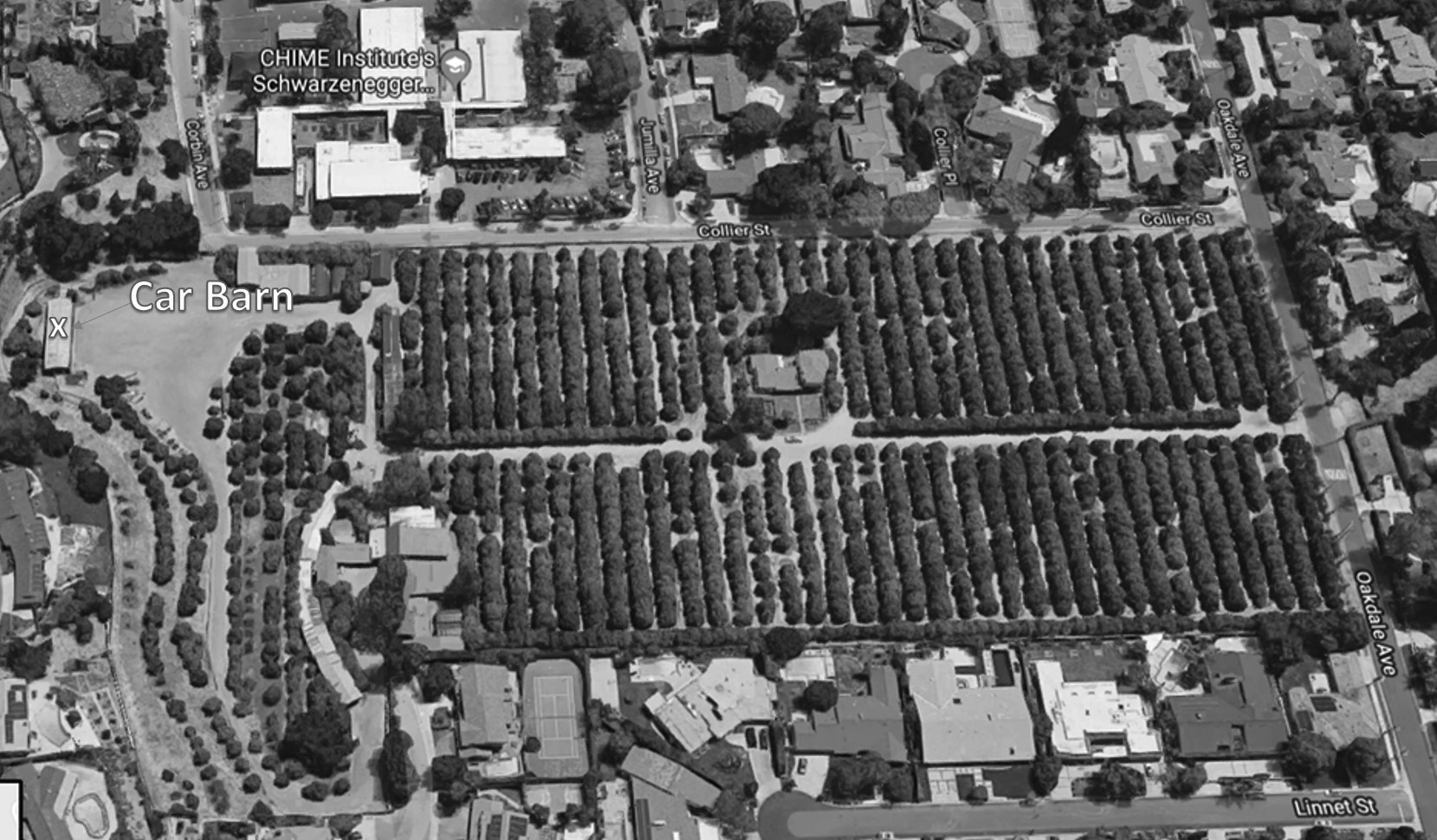 |
|
| (2019)*^ - Aerial view looking down at the 14-acre Lindley Bothwell Ranch located at 5300 Oakdale Avenue in Woodland Hills showing the last commercial orange grove in the Valley. Bothwell’s Car Barn is seen on the left. |
Historical Notes The 14-acre orange ranch is the last commercial orange grove in the Valley. Brothwell died in 1986 and his widow, Ann, looked after the ranch and his collections until her death in 2016. The ranch has been passed down to their grandchildren as she outlived her children.^ |
Chalk Hill
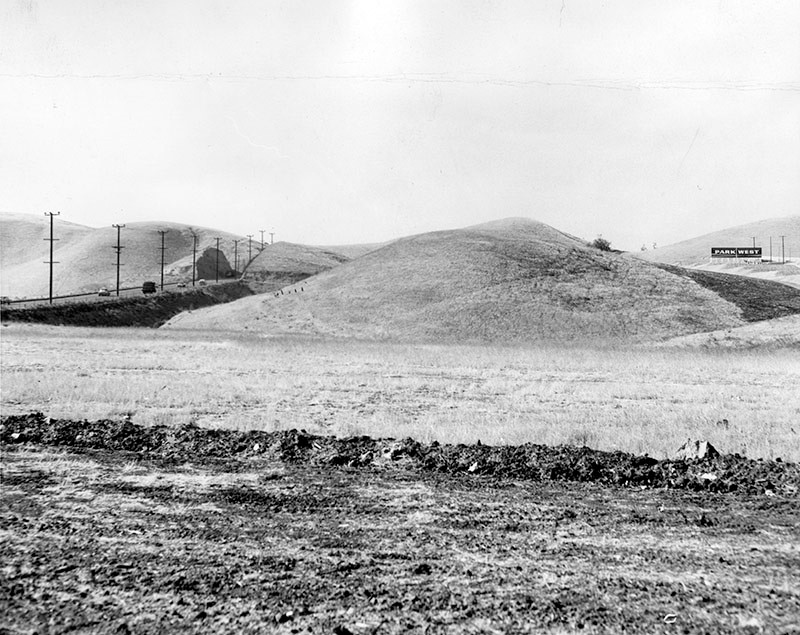 |
|
| (1956)* – View showing Ventura Boulevard as it cuts through ‘Chalk Hill’ in Woodland Hills. |
Historical Notes Photograph caption dated December 26, 1956 reads "Ventura boulevard cuts through famous hills that divide East Woodland Hills from Woodland Hills. Area to south of cut is earmarked for $6 million high school in future. Plans call for a facility similar to Reseda High School with room for some 2,500 students, modern buildings and athletic fields. Southeast of this location is remainder of large estates which once made up much of residential area. Beautiful home and spacious grounds of Lindley Bothwell on Oakdale avenue are example of 'what used to be.' Other sections of area fell under 'urban yoke' and modern structures are addin every day to medern look of community." |
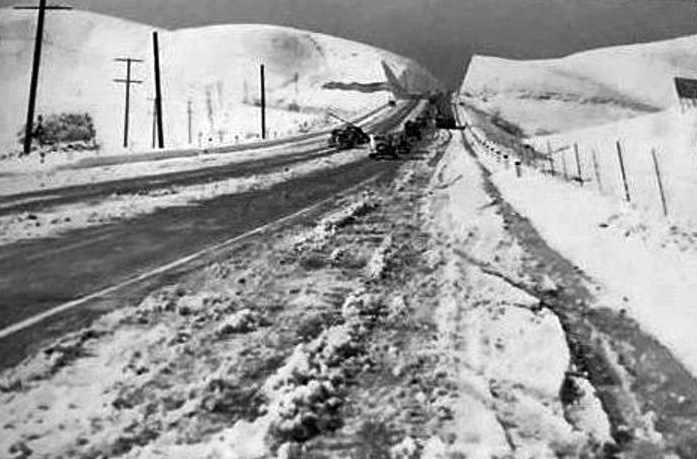 |
|
| (1949)^.^ – View showing the aftermath of a snowstorm at Chalk Hill along Ventura Blvd. Courtesy of Drew Watson from a Canoga Park High School yearbook. |
Historical Notes The CPHS website mentions snows in 1915, 1923, 1932, 1941, 1949, 1957 and 1989. |
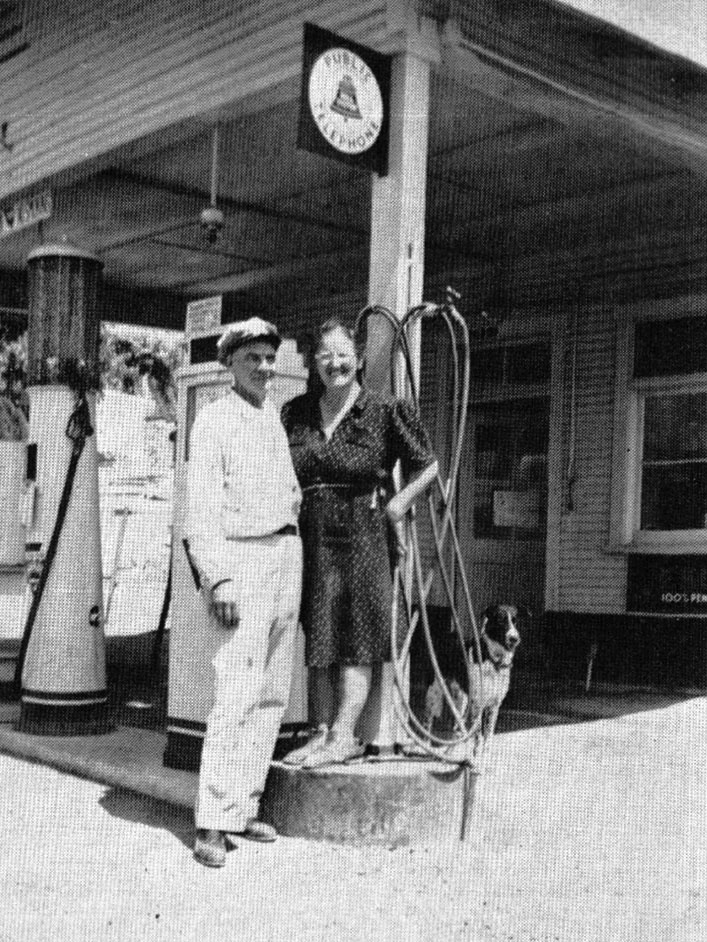 |
|
| (1944)#^*^ – View showing Rudolph and Marie Langraf posing with dog in front of their gas station on Chalk Hill. Photo Credit: ‘The History of Woodland Hills and Girard’, Richard K Cacioppo |
Historical Notes In 1922, Austrian Rudolph Francis Langraf purchased twelve acres on Chalk Hill, and soon after earned his nickname ‘The Kaiser of Chalk Hill’. He and his wife, operated a Chalk Hill rest stop and gas station for three decades. Known as the “Drinking Post,” it became the eastern gate for what would eventually be called Woodland Hills.#^*^ |
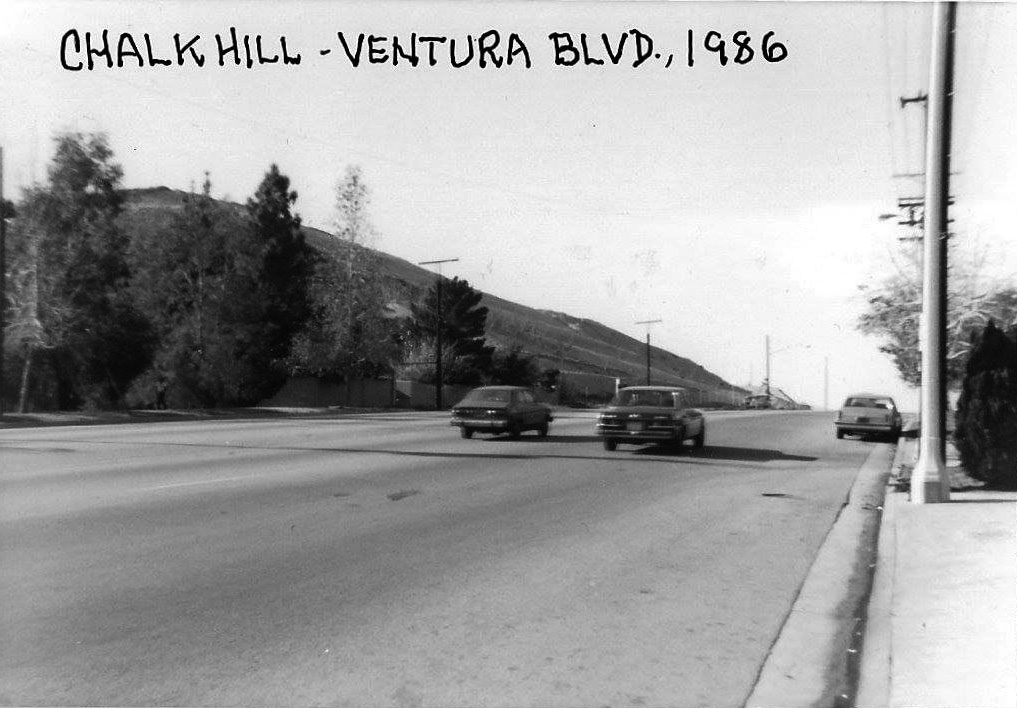 |
|
| (1986)#^*^ – View looking west on Ventura Boulevard from the front of Charley Brown’s Restaurant (later Victoria Station) with 'Chalk Hill' seen on the left. |
Historical Notes Click HERE to see more early views of Chalk Hill. |
Pierce College
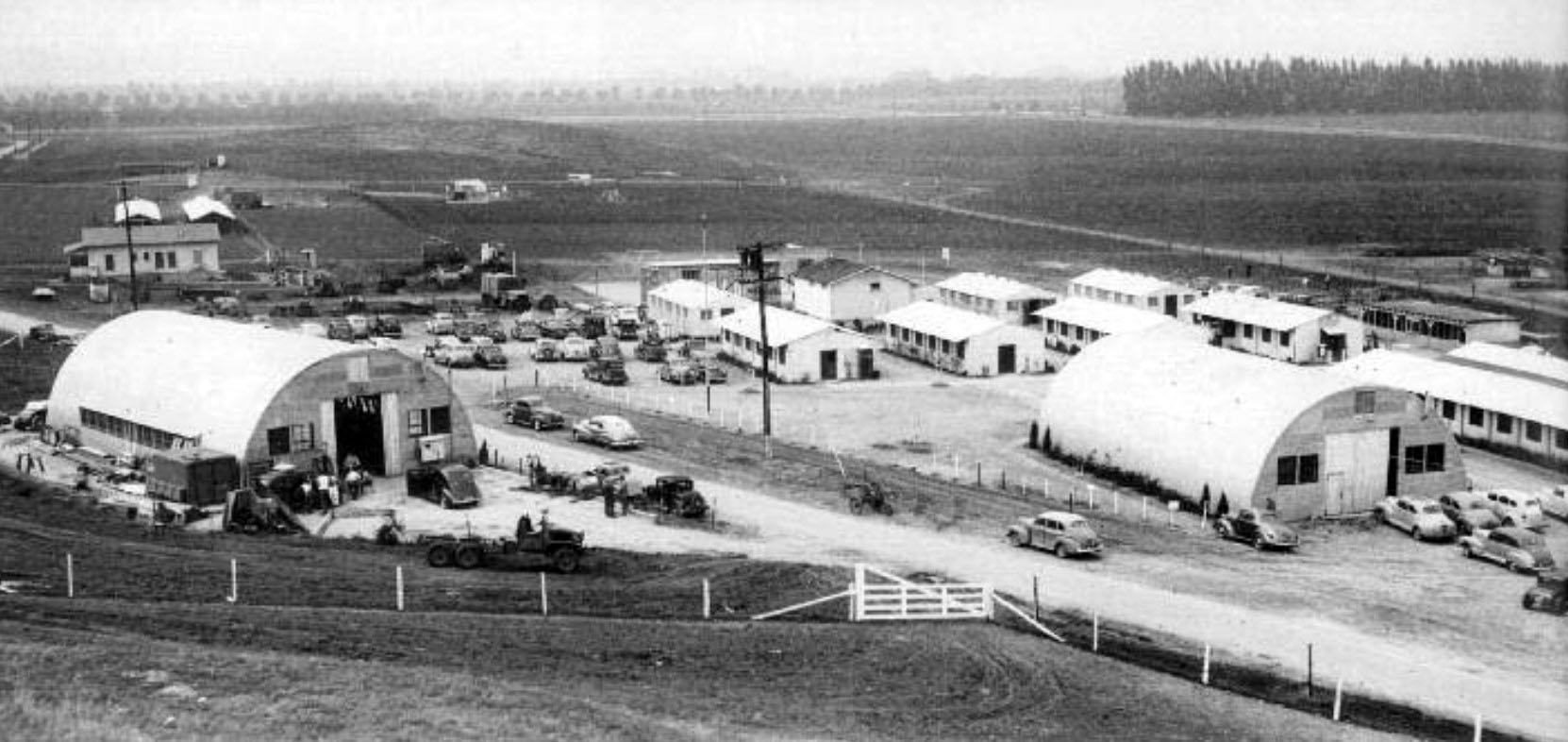 |
|
| (1947)#*^* – Panoramic view of Pierce School of Agriculture (now Pierce College) the year it was formed. |
Historical Notes Pierce College was founded in 1947 through the efforts of Clarence W. Pierce, M.D. The land for the college was purchased by the L.A. City School District (now the L.A. Unified School District). The original name of the college was the Clarence W. Pierce School of Agriculture. Two hundred and twelve WWII veterans entered the first classes. |
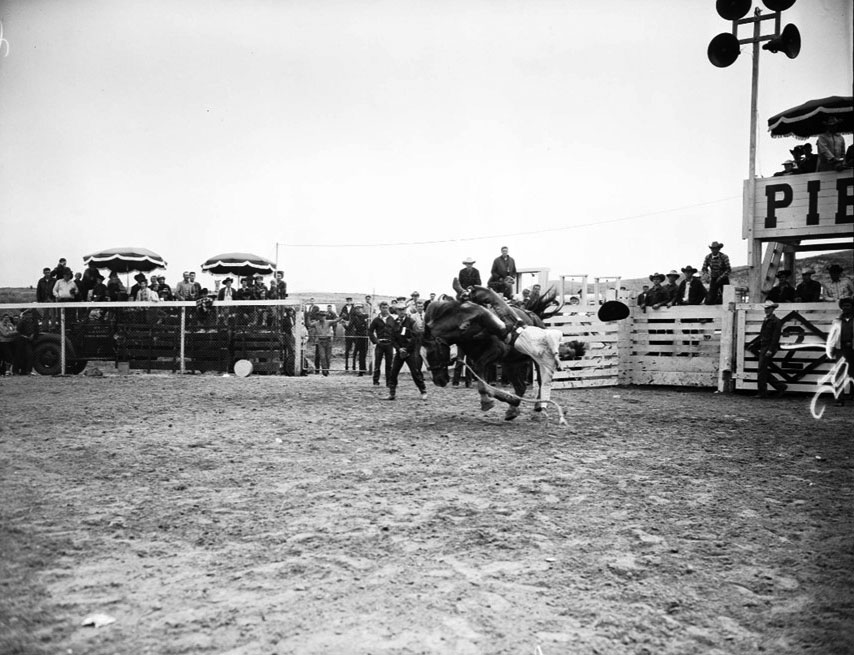 |
|
| (1954)* - Pierce Junior College open house, 9 May 1954. Los Angeles Examiner Collection |
Historical Notes By the early 1970's the college had 2,000 students taking classes in agriculture. Four hundred and fifty head of cattle (114 dairy cattle), 250 head of sheep, 250 of swine and 6,000 poultry made up the livestock portion of the college farm. A fifteen acre orchard, green houses and fields of alfalfa, oats, pumpkins, melons and various other field crops were used to educate our students. In 1947, Los Angeles County was the leading agriculture county in the United States.* |
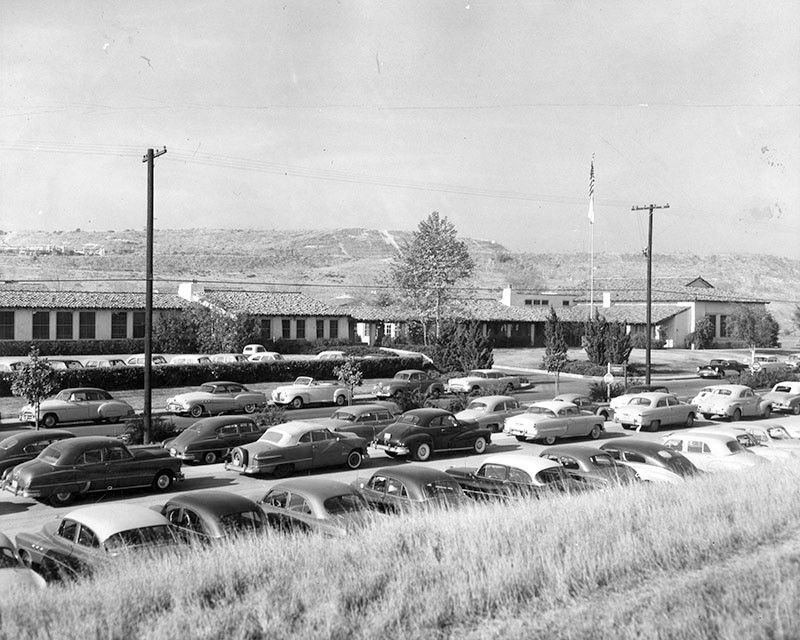 |
|
| (1956)* – Valley Times photograph caption dated December 26, 1956 reads "A close-up of Pierce Junior College administration and education buildings show architectural style well suited to valley tradition. School which started as primarily an agricultural college now has major enrollment in liberal arts and technical education. Newly finished Calvert street grammar school located due east of college already is operating to capacity in growing, progress-minded East Woodland Hills." |
Historical Notes As the San Fernando Valley grew, the need for a comprehensive community college to serve the region was apparent. The college changed its name and its mission when it became Pierce College. The college’s core buildings were constructed and enrollment grew from a hundred or so in 1947 to more than 25,000 at its peak in the early 1980s.* |
Candy Cane Lane (Woodland Hills)
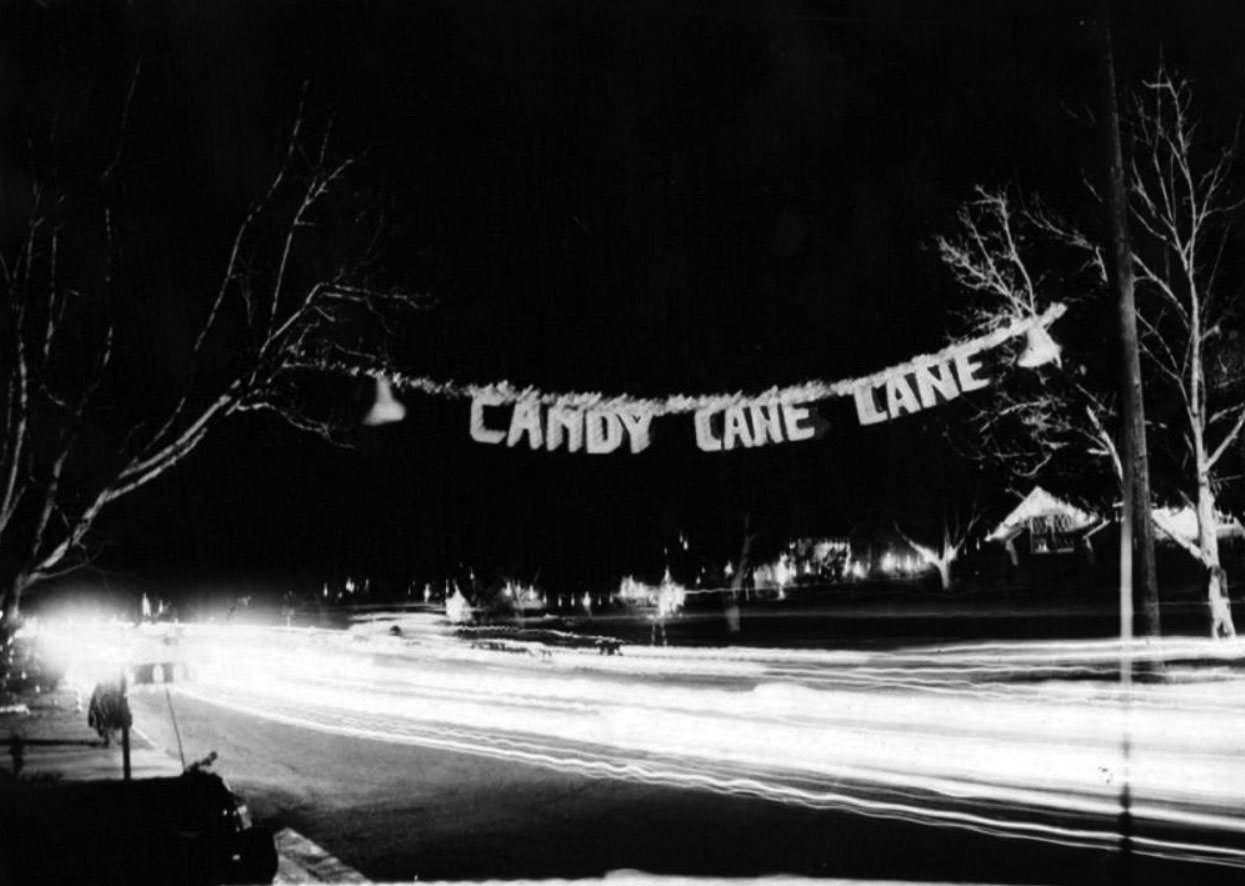 |
|
| (1953)* - Photograph caption dated December 23, 1953 reads, "At night Lubao avenue, East Woodland Hills, is a fairyland of Christmas lights. Neighbors along three blocks each use crossed candy canes, decorated mailboxes and tinkle bells, then add what their imagination dictates." |
Historical Notes The Christmas spirit on Candy Cane Lane dates back to 1951, according to Daily News archives, when the newly built neighborhood was surrounded by walnut groves and the 101 Freeway didn’t stretch farther west than Sepulveda Boulevard. More contemporary accounts date the tradition to 1952. The Valley News & Green Sheet, predecessor to the Daily News, credits the themed decorations up and down Lubao Avenue to a Helen Couzens in December 1953. A neighbor asked everyone to meet and to bring their own coffee cups. During the kaffeeklatsch, residents decided they would decorate their homes for Christmas, planting stovepipe candy canes along the curb. Themes developed for local streets. Lubao Avenue came to be dubbed Candy Cane Lane. Jumilla Avenue came to be called Avenue of the Bells. Oakdale Avenue became Candlelight Lane. And nearby Penfield Avenue turned into Caroler’s Way. Homes further afield followed suit. Neighborhood celebrities from actor Mickey Rooney to Chuck Connors supported it, residents say. Actor Sean Penn grew up on Lubao Avenue.^ |
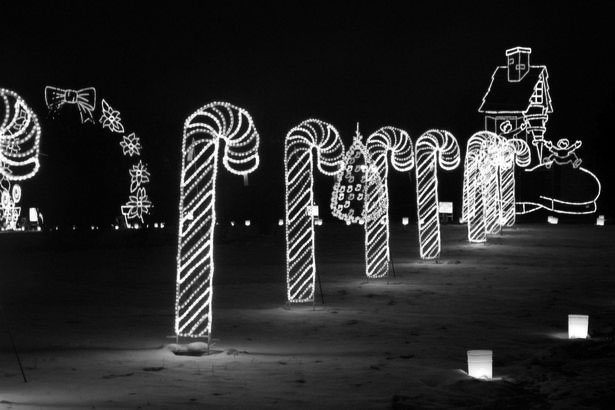 |
|
| (n.d.)^.^ - Christmas decorations at Candy Cane Lane. |
Bob Burns Ranch (aka 'Bazooka Berk' Ranch)
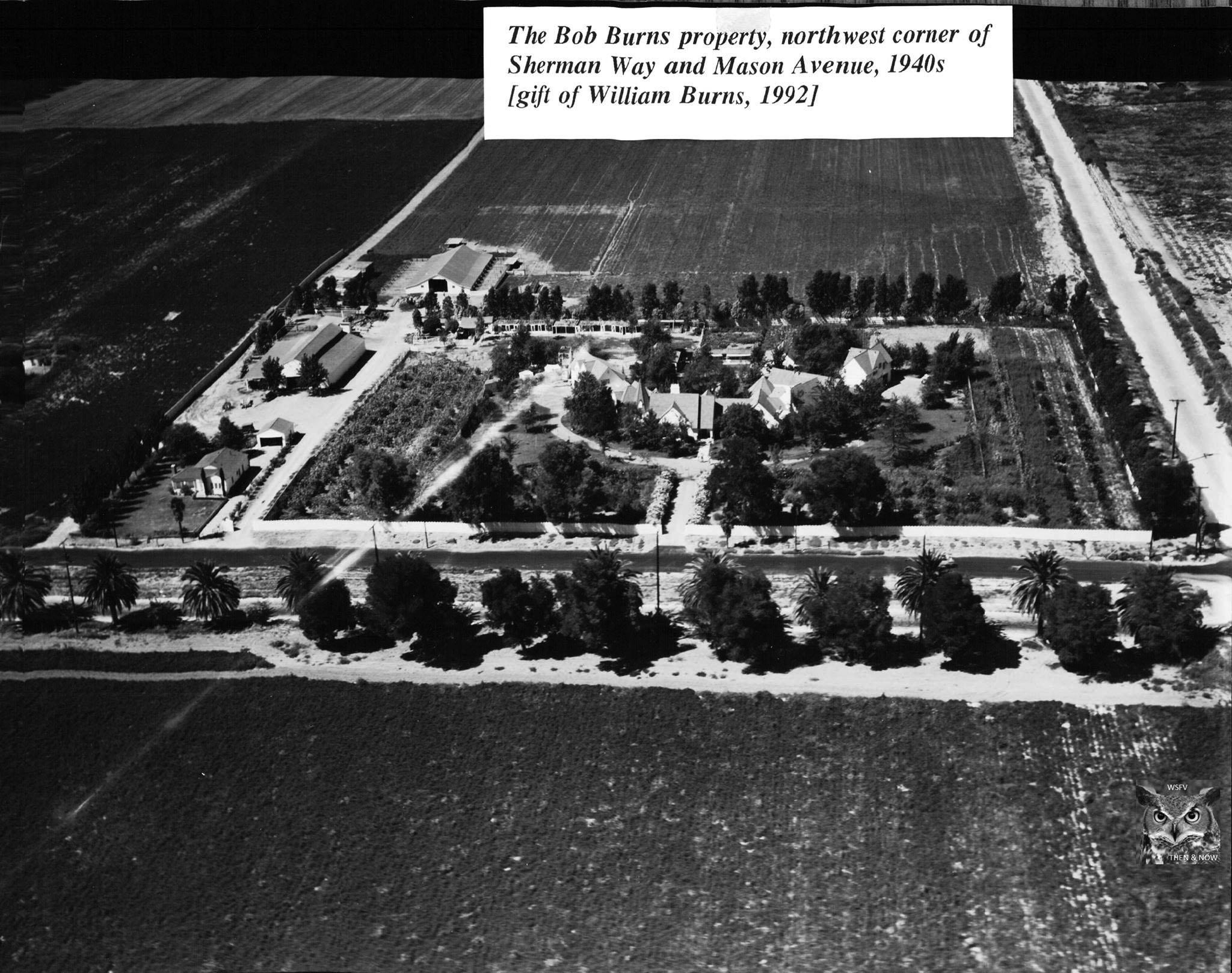 |
|
| (1940s)#^*^ – View showing the Bob Burns property at the northwest corner of Sherman Way and Mason Avenue. Photo courtesy of the Canoga-Owensmouth Historical Society. |
Historical Notes “Bazooka" Bob Burns was a radio personality from the 1930’s – early 1950’s who made Canoga Park his home. He owned quite the acreage of property at the NW corner of Sherman Way and Mason. He named this ranch “Bazooka Berk” and raised prize-winning Berkshire swine here, as well as many agricultural crops. The ranch he called home included anywhere from 60-200 acres, according to various sources, which dwindled to 10 acres at the time of his death in 1956. He owned additional acreage in the valley; as much as 500-600 acres according to some sources. He was well-liked in the town, serving as its honorary mayor for a number of years in the late 1940’s – early 1950’s. After his death in February 1956, the estate traded a piece of the property to First Baptist Church for another parcel just west of Cozycroft, for which to build their church. Another note about the property. In an interview, Bob Burns said that he designed the whole site all by himself, without the aid of an archictect or contractor. |
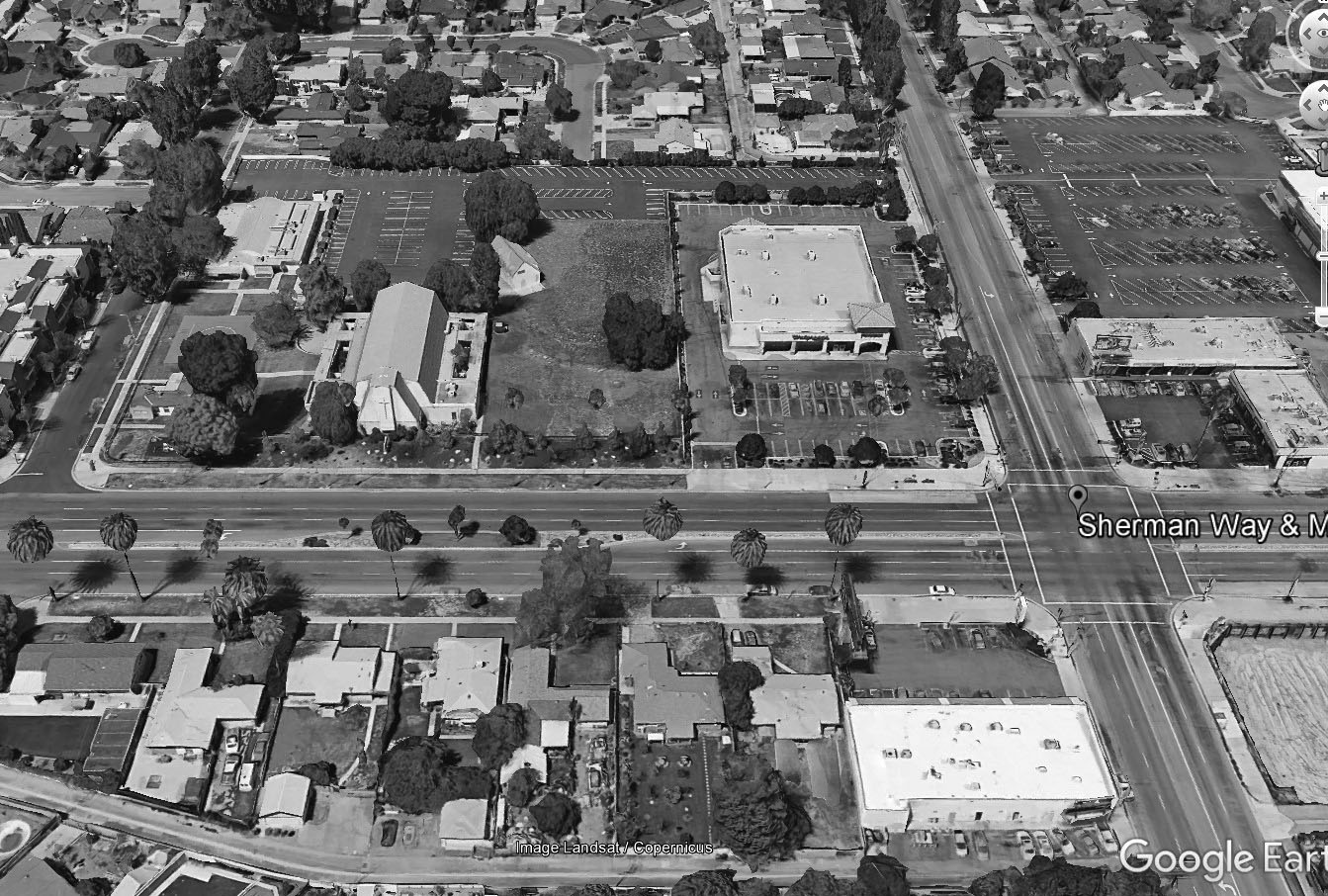 |
|
| (2017)#*^# – Google Earth View showing where the Bob Burns Ranch once stood as it appears today. First Baptist Church is seen at center-left (NE corner of Sherman Way and Cozycroft Ave) and a Walgreens stands at center-right (NW corner of Sherman Way and Mason Ave). |
Hancock Service Station (Canoga Park)
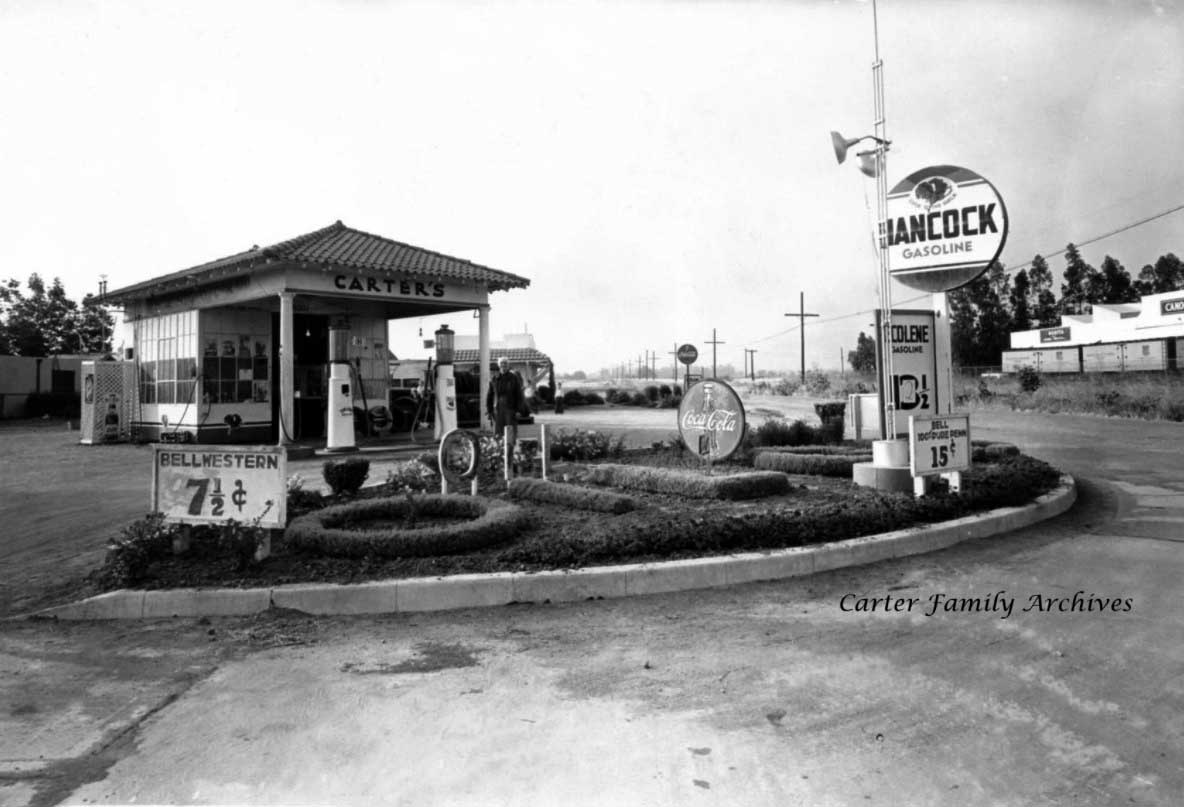 |
|
| (ca. 1930s)* – View looking at the NW corner of Roscoe and Canoga Ave showing Carter’s Hancock Gas Station. Across the street, East side of Canoga, can be seen the Canoga Citrus Association Building (today occupied by the Salvation Army. Photo Courtesy of the Carter Family |
Historical Notes Mr & Mrs Carter lived on Chase St in Canoga Park, as seen in city directories in 1937 & 1939, as well as the US Census in 1940. Today, a Chevron station is located on the NW corner of Roscoe and Canoga. Click HERE to see Contemporary View. |
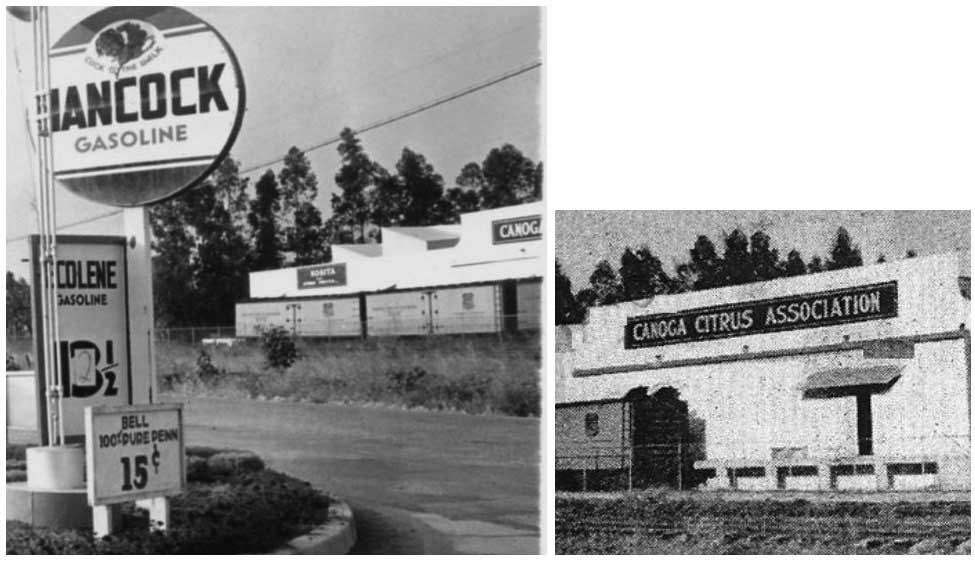 |
|
| (ca. 1930s)* – Close-up view showing the Canoga Citrus Plant across the street from Hancock Gas Station. Note the gas price has been modified from 13 ½ to 12 ½ Cents. Photo Courtesy of Keith Hart |
Historical Notes HANCOCK Oil Company was headquartered in Los Angeles. In the 1850’s, lawyer Henry Hancock helped the Rocha family establish their legal claim to Rancho La Brea, but they ended up owing him so much in fees that they gave him part of the rancho in payment. In 1860 Hancock and his brother bought the rest of the rancho. Hancock began to sell asphalt produced from the famous tar pits that gave the rancho its name. This was the beginning of the Hancock Oil Company. In 1885 Hancock’s widow leased part of the rancho to eastern oil men who went bust by 1888. But in 1902, Mrs. Hancock leased part of the rancho to the Salt Lake Oil Company, which proved a great success. Henry Hancock’s son, George A. Hancock, who had learned the oil business working for Salt Lake, established his own company in 1906. By February 1907, he had over 70 wells producing nearly 300 barrels a day, making the Hancock's one of California’s wealthiest families. The Hancock family built Hancock Park, a large upscale apartment community. The Hancock Oil Company was sold to Signal Oil in 1958. In 1965 Signal was sold to Humble, and both the Hancock and Signal brands vanished.* Click HERE to see more Early LA Gas Stations. |
* * * * * |
Owensmouth and the Canoga Citrus Association
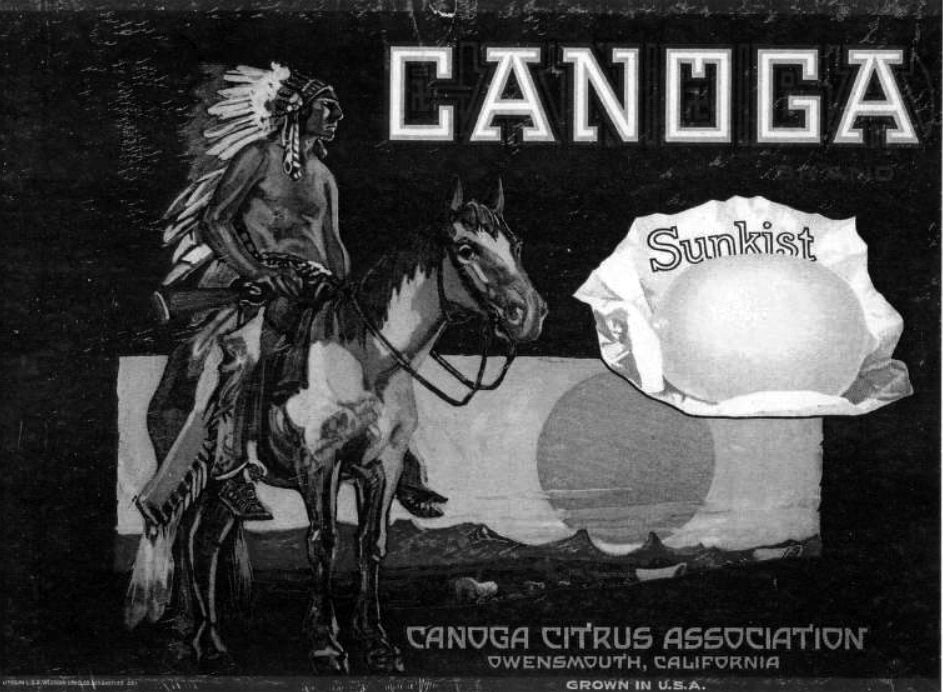 |
|
| (ca. 1928)^^ – Facsimile of Sunkist & Canoga Citrus Association crate label, Owensmouth (later known as Canoga Park). |
Historical Notes Only after Los Angeles annexed Owensmouth in 1917 did aqueduct water flow into town. The arrival of Owens Valley water made citrus groves and other forms of intensive agriculture possible. Sunkist used the Canoga name, which previously referred to a watering hole at the site of the town. The town was located on the site of an old well used by stagecoaches and local settlers. When the Southern Pacific built a branch line through the area, it designated the spot Canoga, after the town of Canoga, New York, which in turn took its name from the Indian village of Ganogeh ("place of floating oil").**^^ |
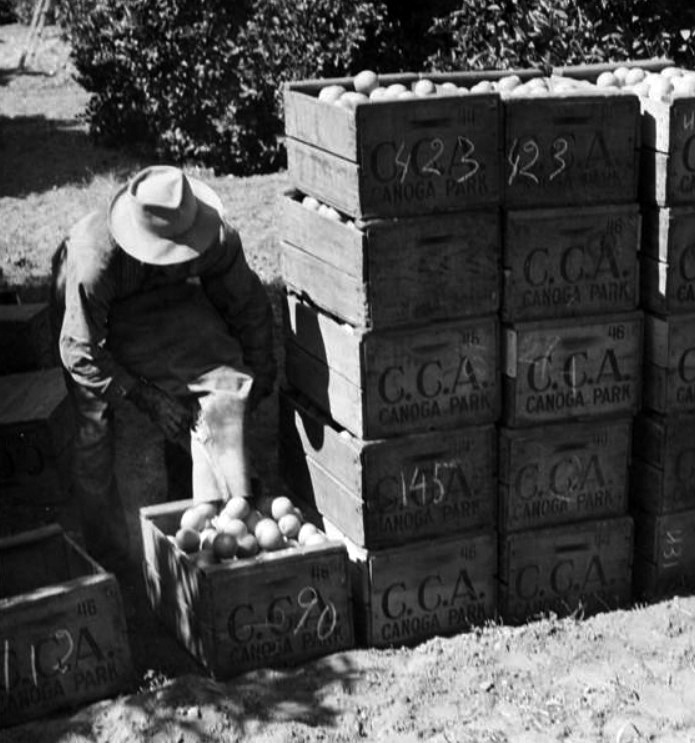 |
|
| (ca. 1940s)#^*^ – View showing a laborer loading oranges into crates to be brought to the Canoga Citrus Association packing house for processing. The crates are stamped "CCA" which is the abbreviation for the Canoga Citrus Association. |
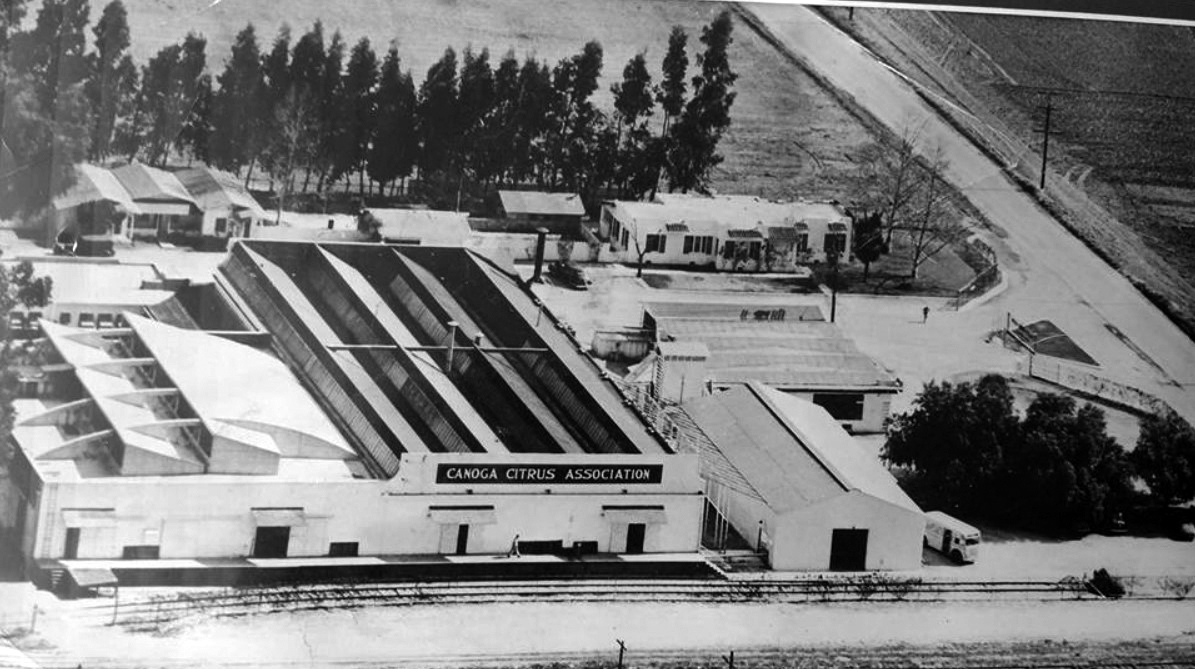 |
|
| (ca. 1950)#^*^ – Aerial view looking east showing the Canoga Citrus Association processing plant located on Roscoe and Canoga. Today it’s the Salvation Army building. |
Historical Notes The Canoga Citrus Association plant was located near the northeast corner of Roscoe & Canoga. It began packing oranges in 1927, with at least 25 brands packaged at this site.*^^^ |
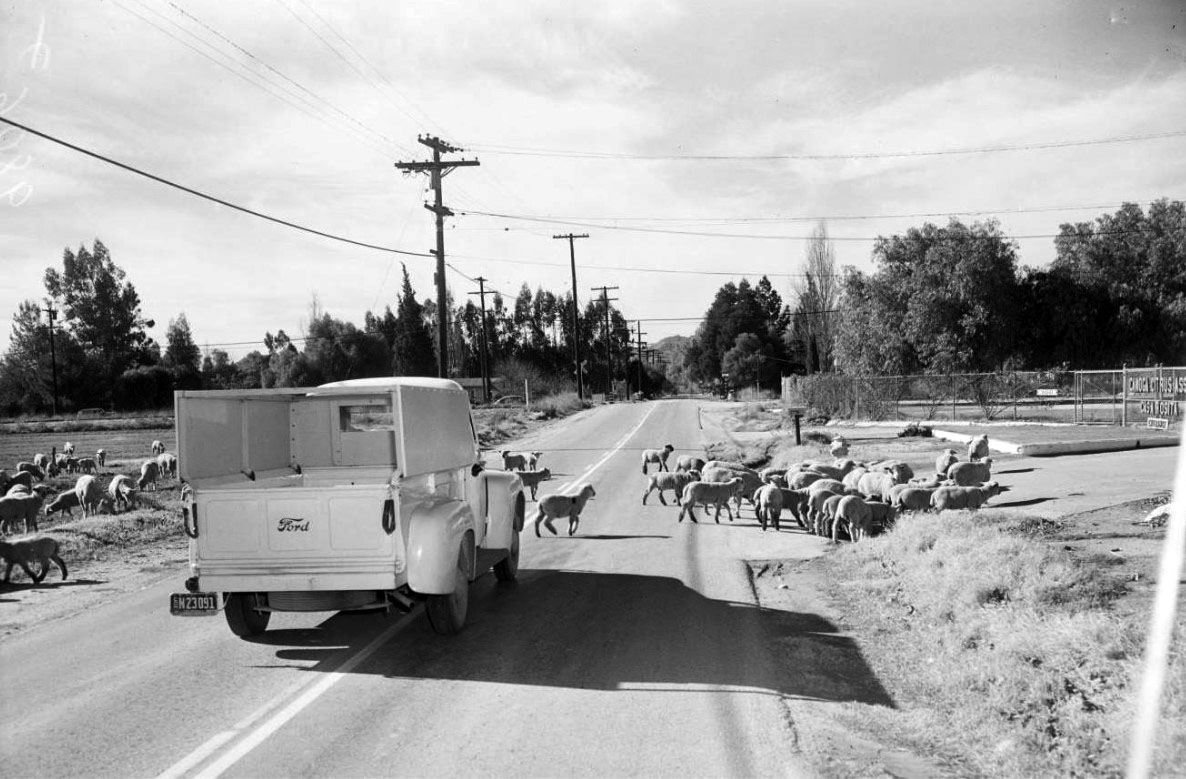 |
|
| (1953)*^^^ – View looking west showing sheep crossing Roscoe Boulevard near Canoga Avenue in Canoga Park. The entrance to the Canoga Citrus Association processing plant can be seen on the right. |
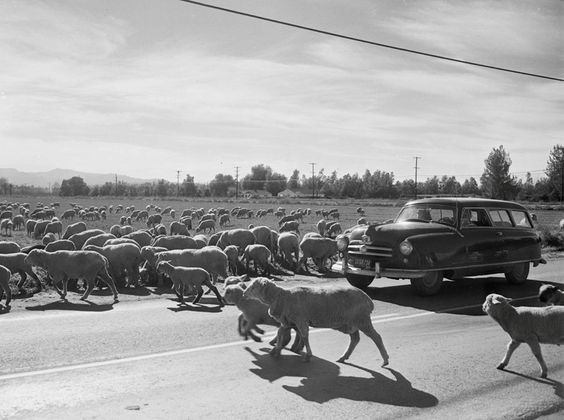 |
|
| (ca. 1950s)##* - View looking northeast showing sheep crossing Roscoe Boulevard in Canoga Park* while a 1951 Nash Rambler Station Wagon waits. |
Historical Notes *In the late 1920s, residents and business leaders suggested that their town's name revert back to Canoga, complaining that Owensmouth suggested a location hundreds of miles away in the Owens Valley. Concerns about the community's image may have inspired the campaign, too; the older suburbs of East Los Angeles and Sherman had recently changed their names to Lincoln Heights and West Hollywood, respectively. In 1931, Owensmouth became Canoga Park. (The Post Office insisted on adding "Park" to avoid confusion with Canoga, New York.)**^^ |
Thriftimart
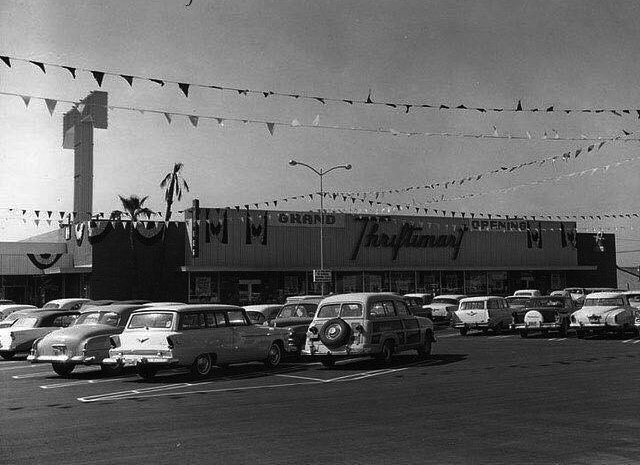 |
|
| (1950s)^.^ - View showing the Grand Opening of Thriftimart located at 20934 Roscoe Boulevard, SW corner of Roscoe and DeSoto. Although the big “T” is gone, the building still exists with a Sam Ash Music Store and a Dollar Tree Store taking up the space. Click HERE for contemporary view. |
Historical Notes Burning bright above the San Fernando Valley and L.A. Basin at dusk were the red, 40-foot tall "T's" - the iconic logo of the late, great Thriftimart supermarket chain. These gigantic signs emerged on the local landscape through the 50's and 60's. The company that would eventually be named Thriftimart, Inc. was created in 1930 when a group of former A&P managers headed by Roger Laverty, Sr. purchased a company called Fitzsimmons Stores, Ltd. (the name the company would bear until well into the 1950's). In its earlier years, the company grew through acquisitions, including the 9-store "Thriftimart" and the 17-store Roberts Markets chains in the 1940's. In 1955, the company purchased the Smart & Final Iris Company, which at the time was strictly a wholesale operation. By 1961, the company had over 60 stores and had renamed itself after its famous trademark.* |
Green Thumb Nursery
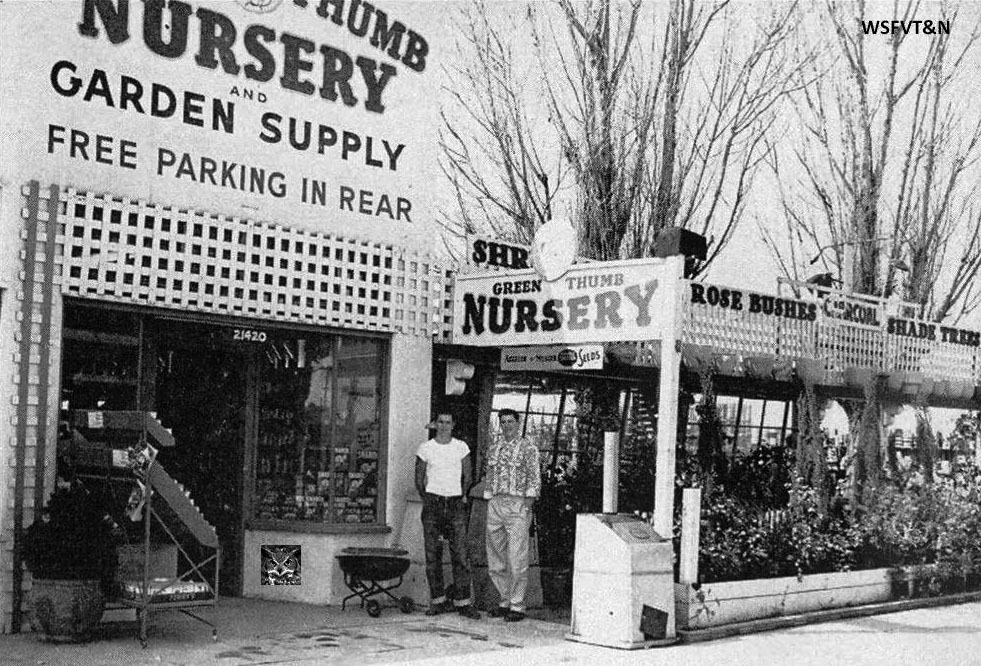 |
|
| (1951)#^*^ - View showing two young men posing in front of the entrance to Green Thumb Nursery, located at 21420 Sherman Way in Canoga Park. |
Historical Notes This iconic Canoga Park business was opened in October 1946 at 21420 Sherman Way by partners Dale Bergquist and Errol Newton, when Canoga Park was little more than 100 homes. The town grew, and in 1953, Green Thumb moved a few blocks west to the SW corner of Sherman Way and Jordan., where it continues to this day. In interviews, Bergquist credited his company's success to the growth of Canoga Park and the west San Fernando Valley and the demand for landscaping materials. Green Thumb eventually added stores in other communities, including Santa Clarita and Ventura, while Dale’s brothers Bob and Max later started and operated the Green Arrow Nursery, also in the Valley. This 1951 photo of the original location came by way of Canoga Park High School yearbook. #^*^ |
Arcade Block (originally Syndicate Block)
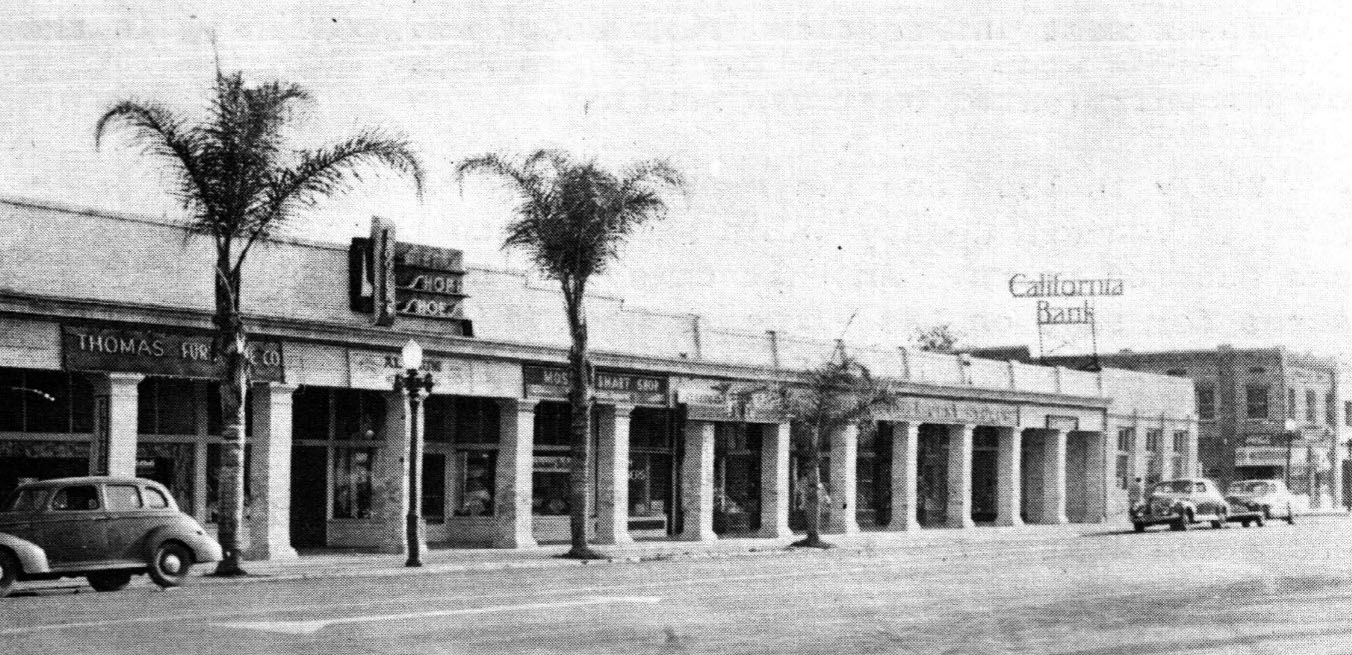 |
|
| (1940s)#^*^ – Panoramic view showing the Arcade Block on the 21500 block of Sherman Way with California Bank at the end of the long building. |
Historical Notes The Arcade Block (originally called Syndicate Block) was built circa 1912. It was the first commercial building constructed in the town of Owensmouth after the Owensmouth Station. The California Bank was originally occupied by Owensmouth Bank. Click HERE to see more early views of the Syndicate Block. |
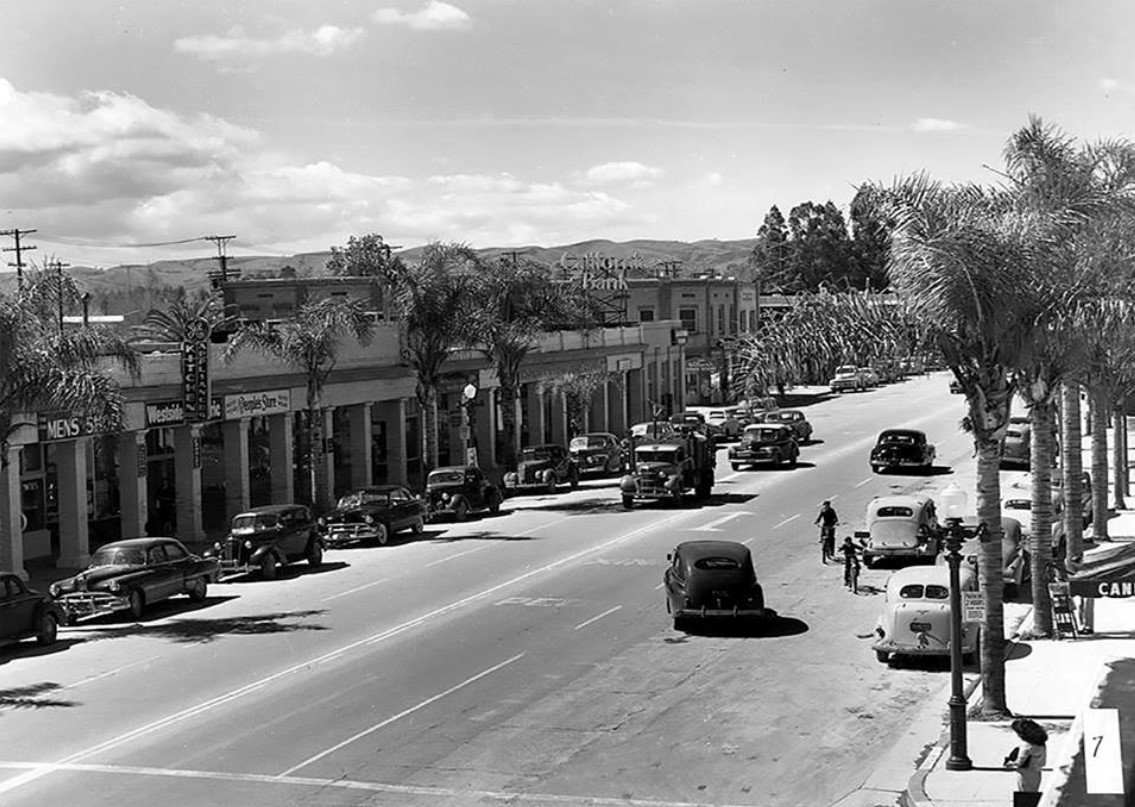 |
|
| (Early 1950s)#^*^ - View looking west on Sherman Way in Canoga Park. The California Bank, at center of photo, is on the southeast corner of Sherman Way and Remmet Avenue. |
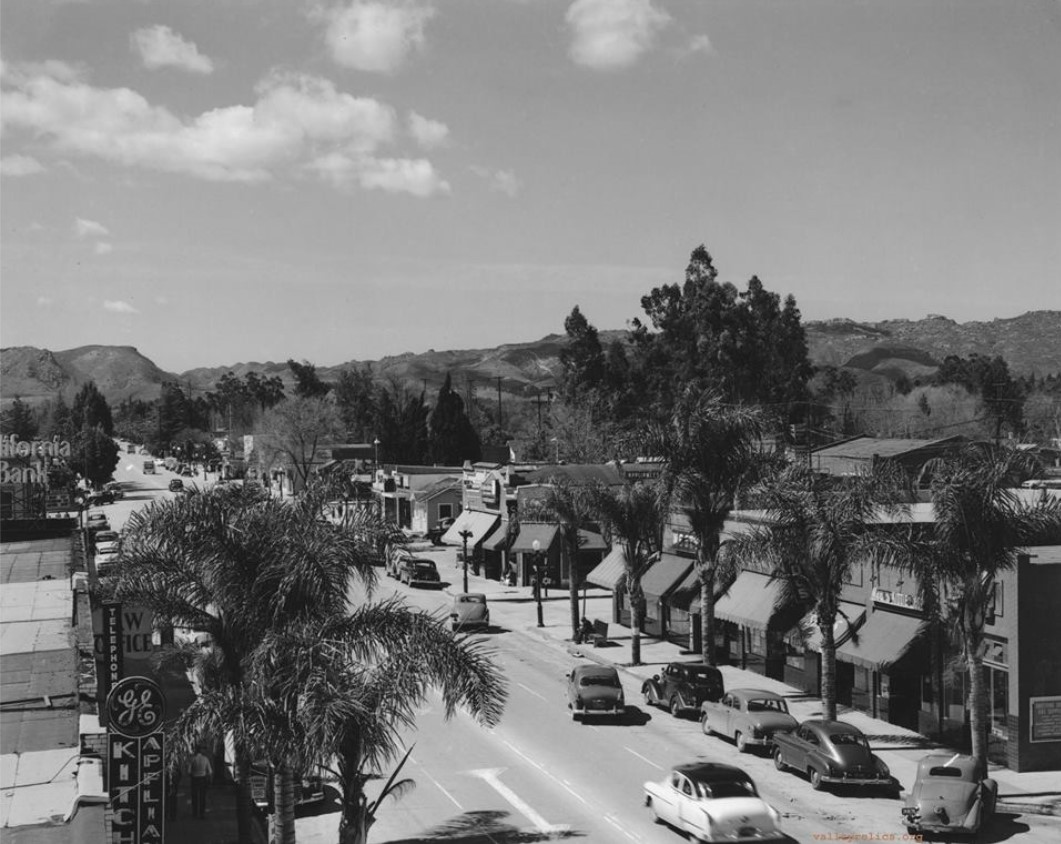 |
|
| (1950s)^^^* - View showing Sherman Way heading towards Topanga Canyon Boulevard as seen from near Alabama Avenue. California Bank is seen on the left. |
Canoga Park Post Office (Then and Now)
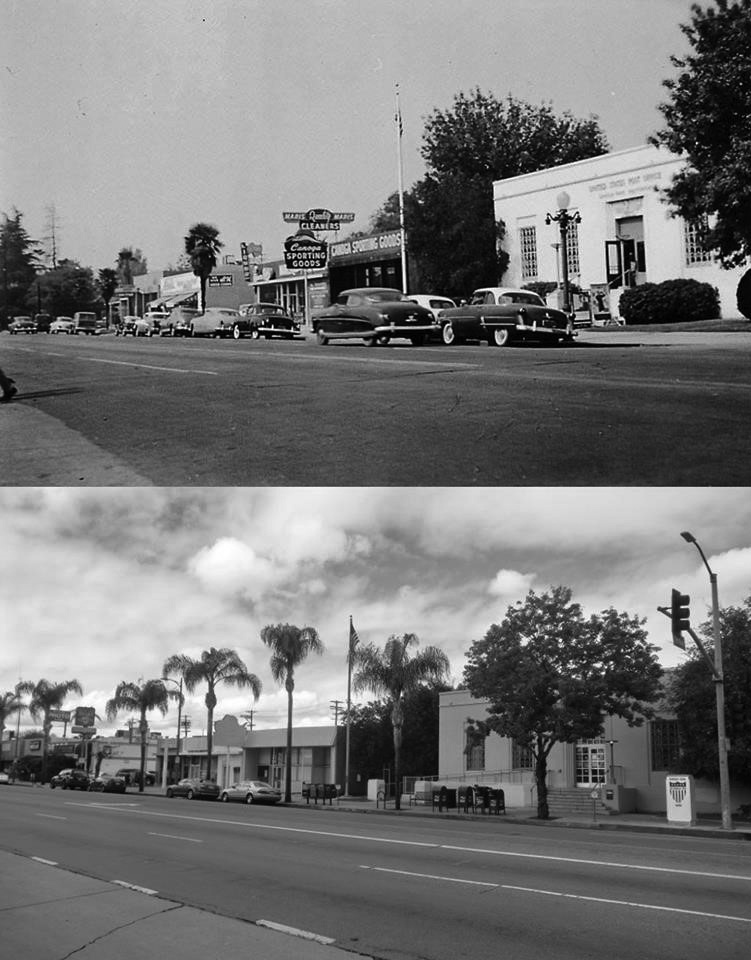 |
|
| (1955 vs. 2018)#^*^ – View looking northwest on Sherman Way from Jordan Avenue in front of Green Thumb Nursery showing the Post Office across the street at 21801 Sherman Way. |
Historical Notes In top photo, Canoga Sporting Goods is just west of the Post Office. Further west can be seen the Mar-Wick Food Mart. In bottom photo, Follow Your Heart is at the far left where Mar-Wick Food Mart was once located. |
Mar-Wick Food Mart (Today, Follow Your Heart)
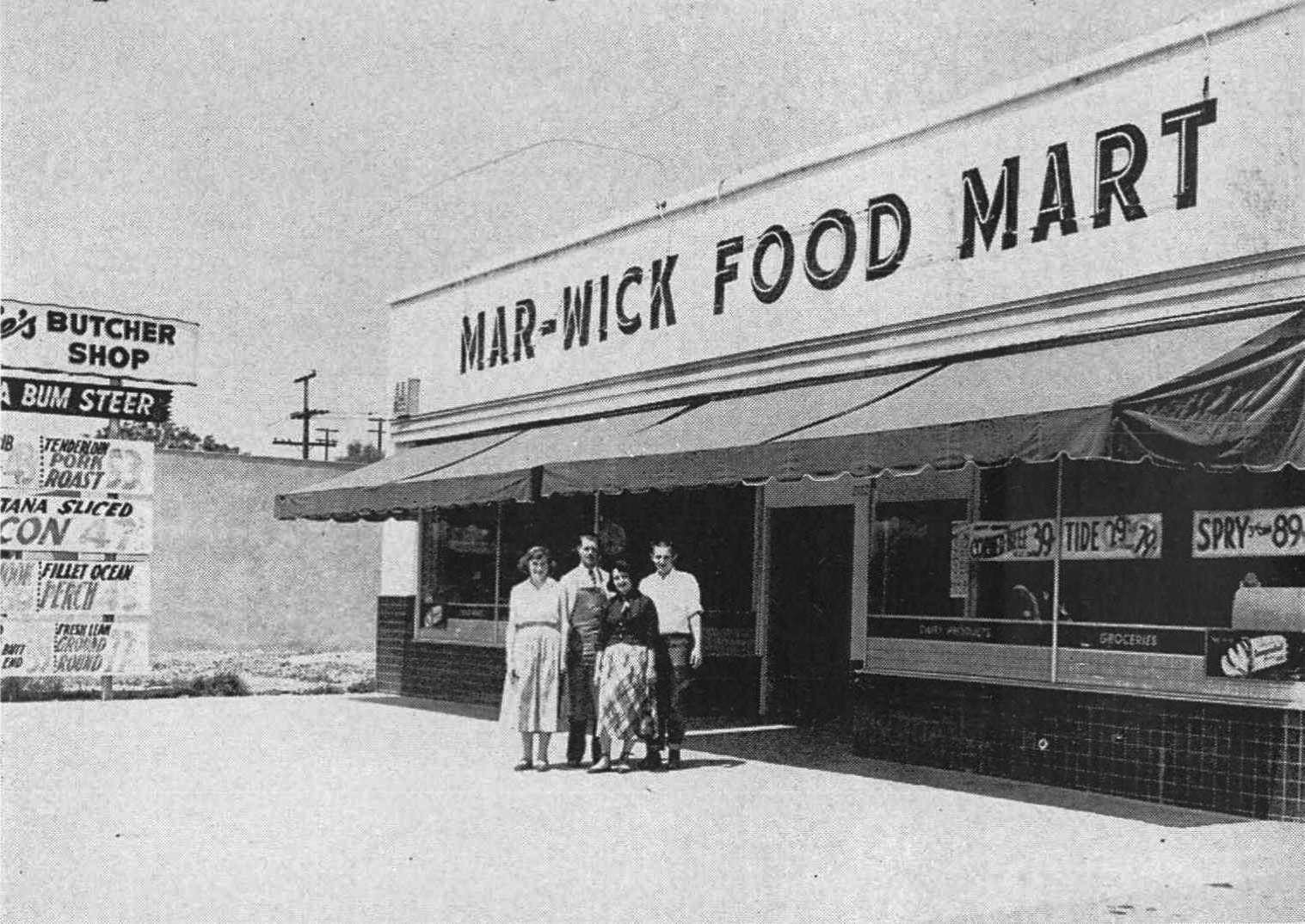 |
|
| (1951)#^*^ – View showing four people (employees/owners?) posing in front of Mar-Wick Food Market located at 21825 Sherman Way. Partial view of the sign on the left indicates that Larrie's Butcher Shop is inside. |
Historical Notes Before Follow Your Heart, there was Larrie's Butcher Shop. Chef's Pastry Shop opened in May 1949. Mar-wick Food Mart was in business by fall of 1950, and Larrie's opened up inside of Mar-Wick in January 1951. Larrie's soon expanded to include the entire building, and in 1958, enlarged the building by adding 50 feet to its depth. Follow Your Heart moved in in the mid 1970's. #^*^ Click HERE to see contemporary view. |
Valley Refrigeration Co. (Today, Work Boot Warehouse)
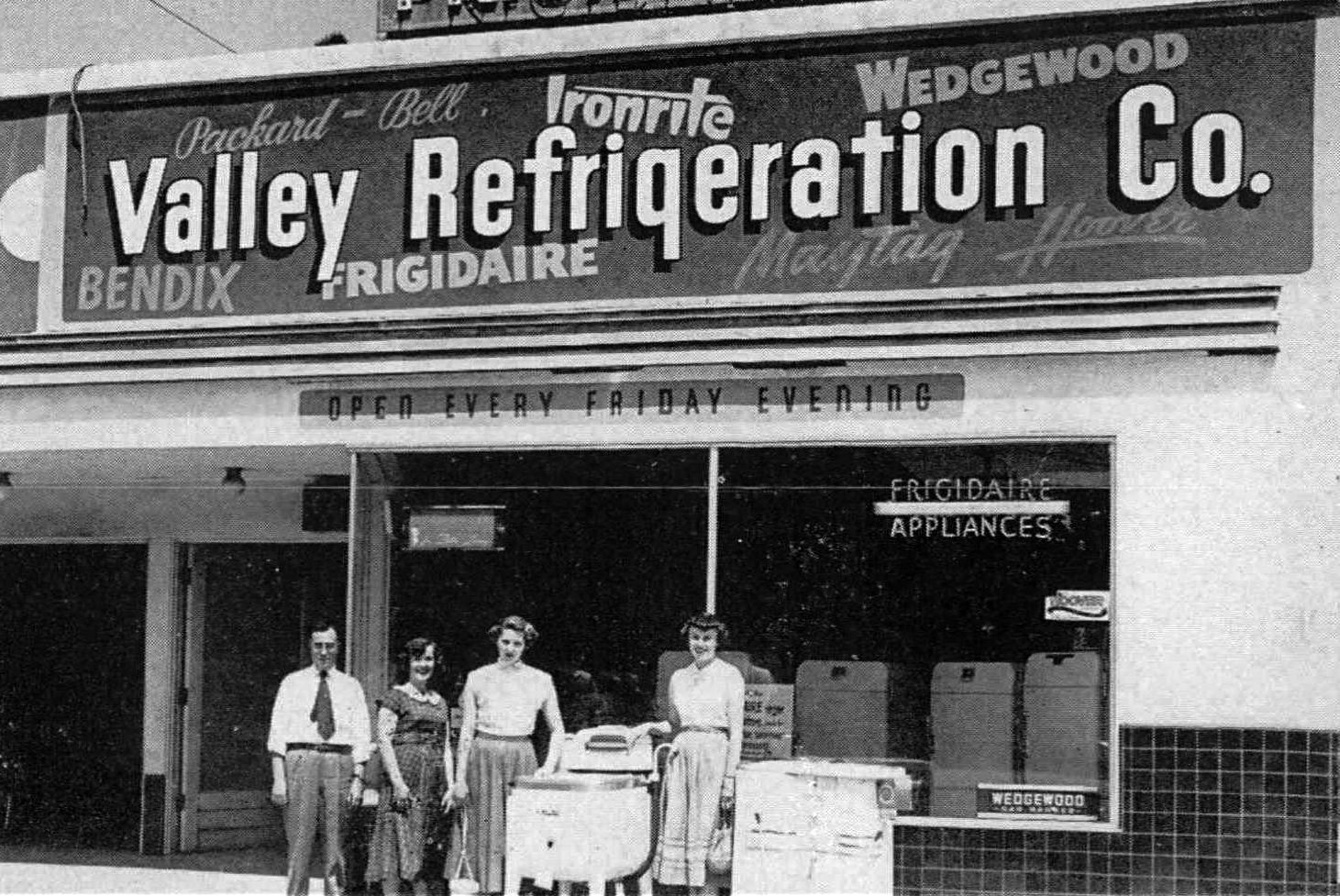 |
|
| (1951)#^*^ – Hayward Garlow, Katherine Gathers, Sally Curruthers, and Betty Babcock are standing next to a Maytag washer in front of the Valley Refrigeration Co. Store located at 21715 Sherman Way. |
Historical Notes The Valley Refrigeration Co. Store opened in the mid 1940’s. Today, the building is occupied by Work Boot Warehouse. Click HERE for contemporary view. |
Canoga Park (Red Line)
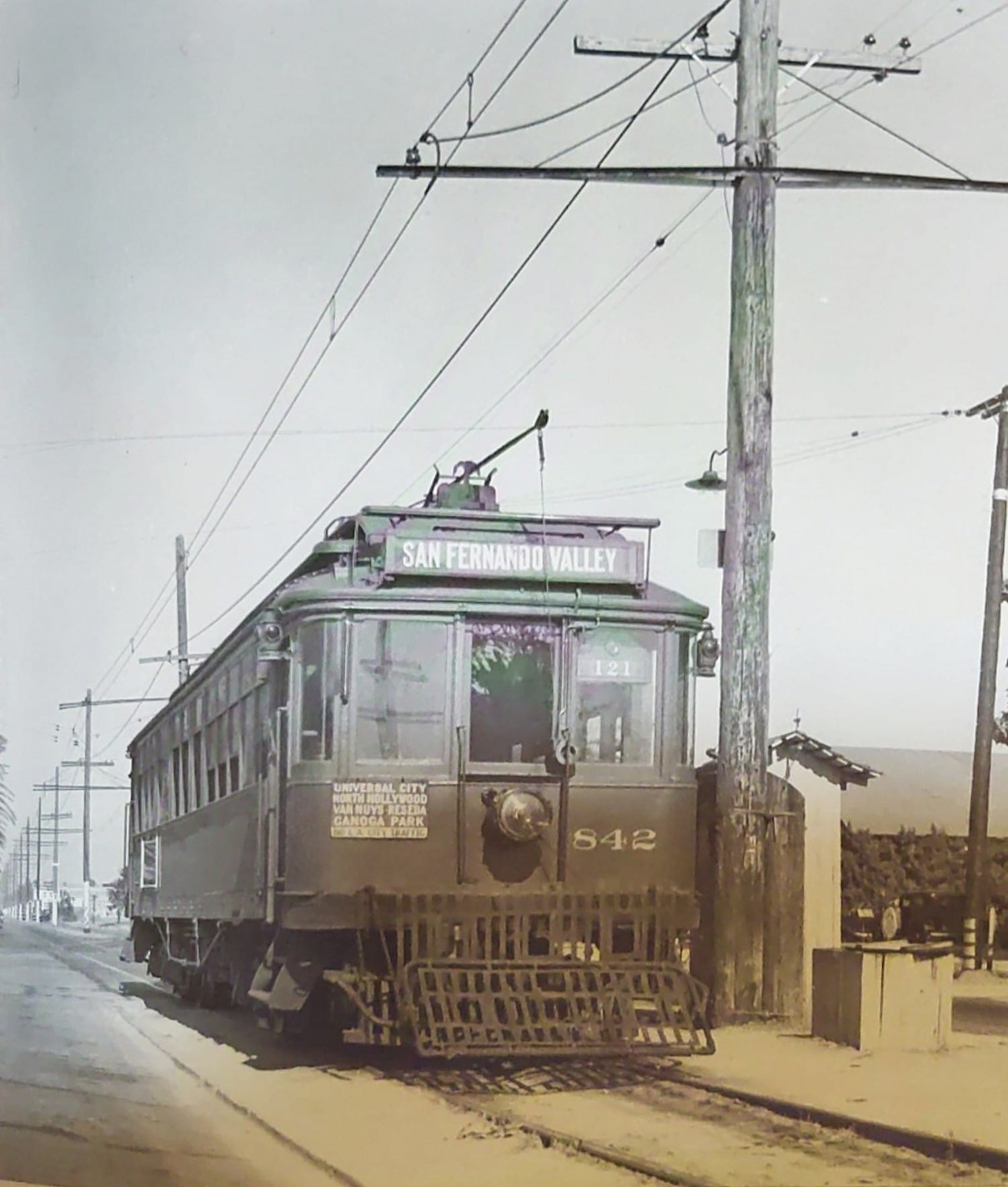 |
|
| (1937)* – Topanga Canyon Road (now Boulevard) at the end of the Canoga Park Line (Ernie M. Le Rasmussen Collection). |
Historical Notes "PE 842 has arrived at Topanga Canyon Road, now Boulevard, at the end of the Canoga Park line. Both trolley poles are down, so they will test out of service for a while. The number 121 in the right corner of the streetcar is its train number. Per PE employee timetable 13 effective 3:30 am of July 21, 1937, train 121 departed Daily except Sunday from Los Angeles (Subway Terminal) at 2-20 pm and arrived at Topanga Canyon Road at 3.48 pm. The trip was 29.10 miles in length. The image is dated July 1937." |
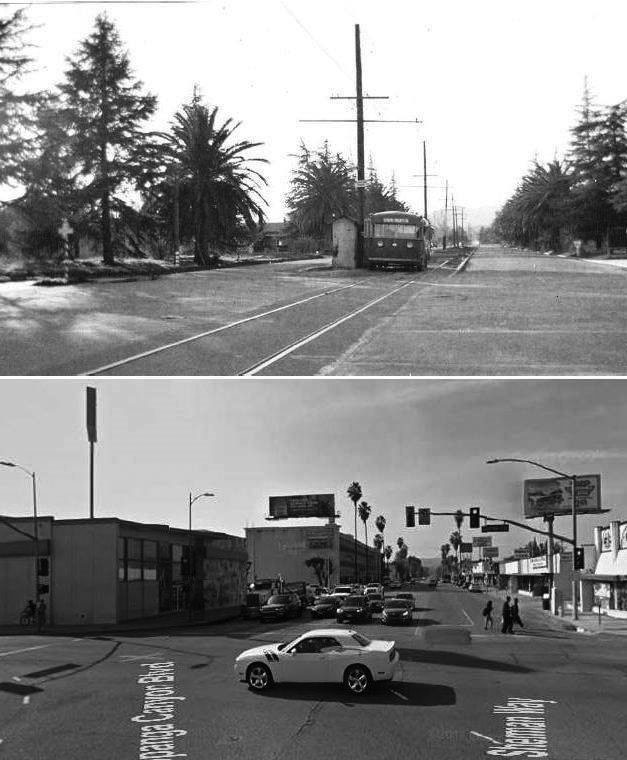 |
|
| (1941 vs. 2017)#^*^ – View looking west on Sherman Way at Topanga Cyn Blvd. |
Historical Notes In the 1941 photo (top), the Pacific Electric Cars had already been discontinued; replaced by motorized buses, which evidently utilized the center of the street, with the tracks still in the ground. |
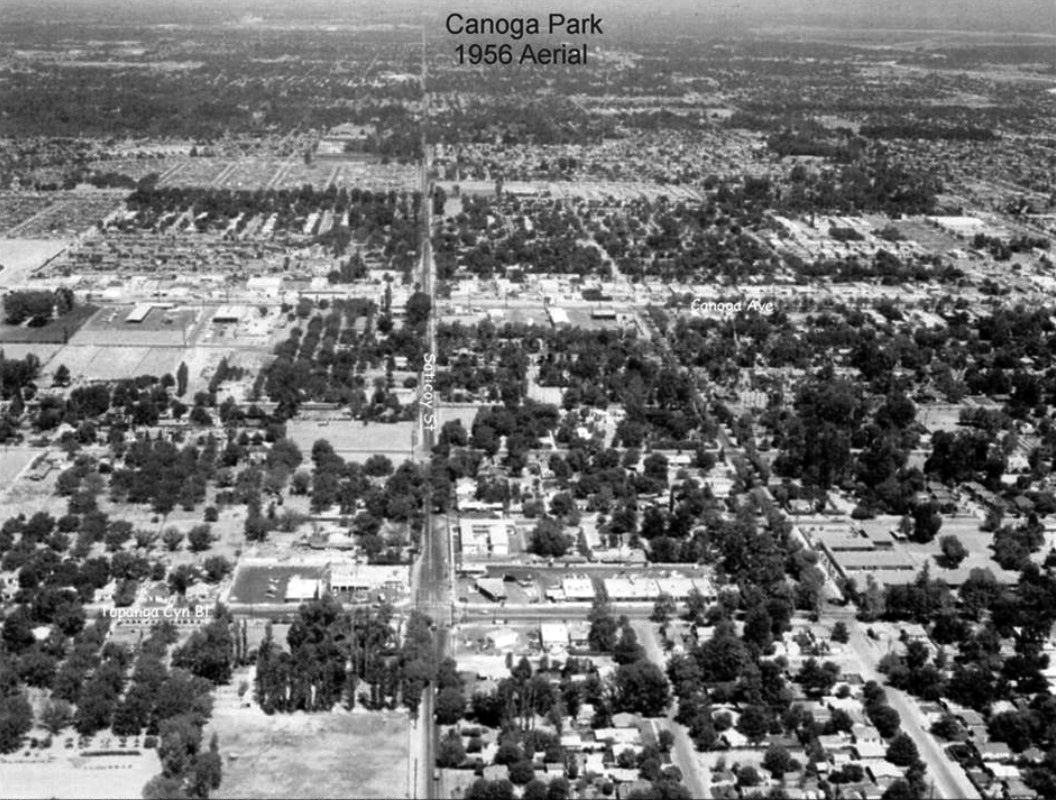 |
|
| (1956)#^*^ – Aerial view looking east over Canoga Park from just west of Topanga Canyon Blvd. Baskin-Robbins can be seen on Topanga just north of Saticoy (lower center-left). |
Historical Notes Baskin-Robbins was founded in 1945 by brothers-in-law Burt Baskin and Irv Robbins from the merging of their respective ice cream parlors, in Glendale, California. Burt Baskin owned Burton's Ice Cream Shop (opened in 1945) and Irv Robbins owned Snowbird Ice Cream (opened in 1946). Snowbird Ice Cream offered 21 flavors, a novel concept at that time. When the separate companies merged in 1953, the number of flavors was expanded to 31 flavors. By 1948, Burt and Irv had opened six stores. Today, Baskin-Robbins has more than 7,300 shop locations in nearly 50 countries.*^ |
De Young Service Station
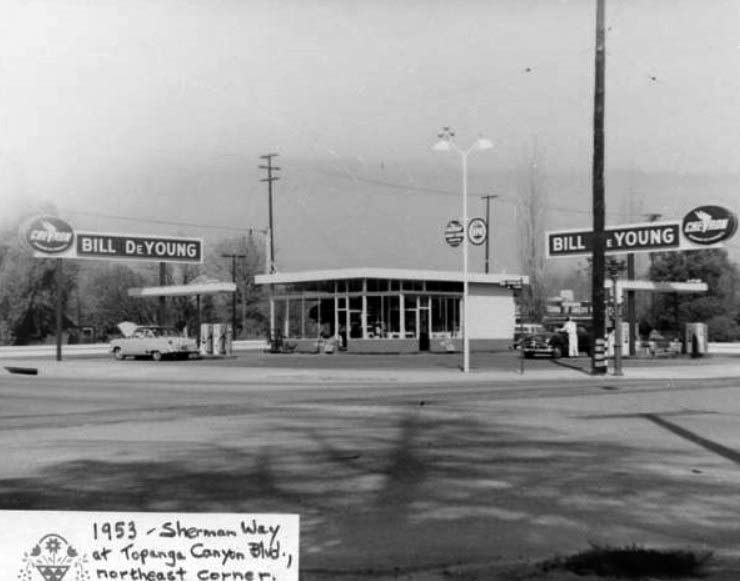 |
|
| (1953)#^*^ – View showing Bill De Young Service Station on the northeast corner Sherman Way and Topanga Canyon Boulevard. |
Then and Now
 |
.jpg) |
|
| (1953)#^*^ - N/E Corner of Sherman Way and Topanga Canyon Boulevard | (2014)#*^# - N/E Corner of Sherman Way and Topanga Canyon Boulevard |
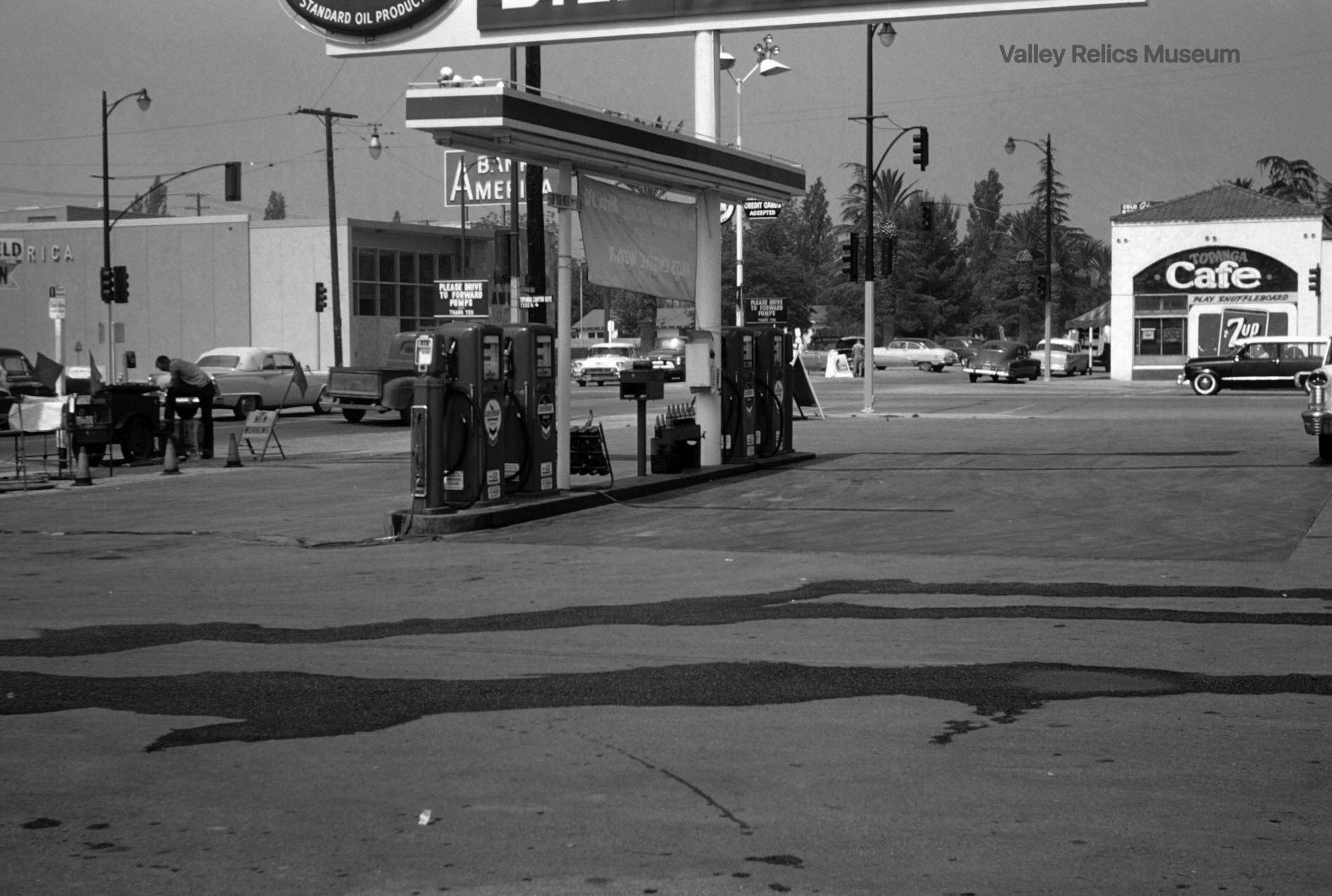 |
|
| (1957)^^^* – View looking northeast toward the intersection of Topanga Canyon Boulevard and Sherman Way from DeYoung gas station. Topanga Café is seen on the northwest corner. |
Historical Notes Today, Bank of America is still located on the southwest corner of Topanga and Sherman Way, while Conroy’s Flowers occupies the building where Topanga Café used to be. Click HERE for contemporary view. |
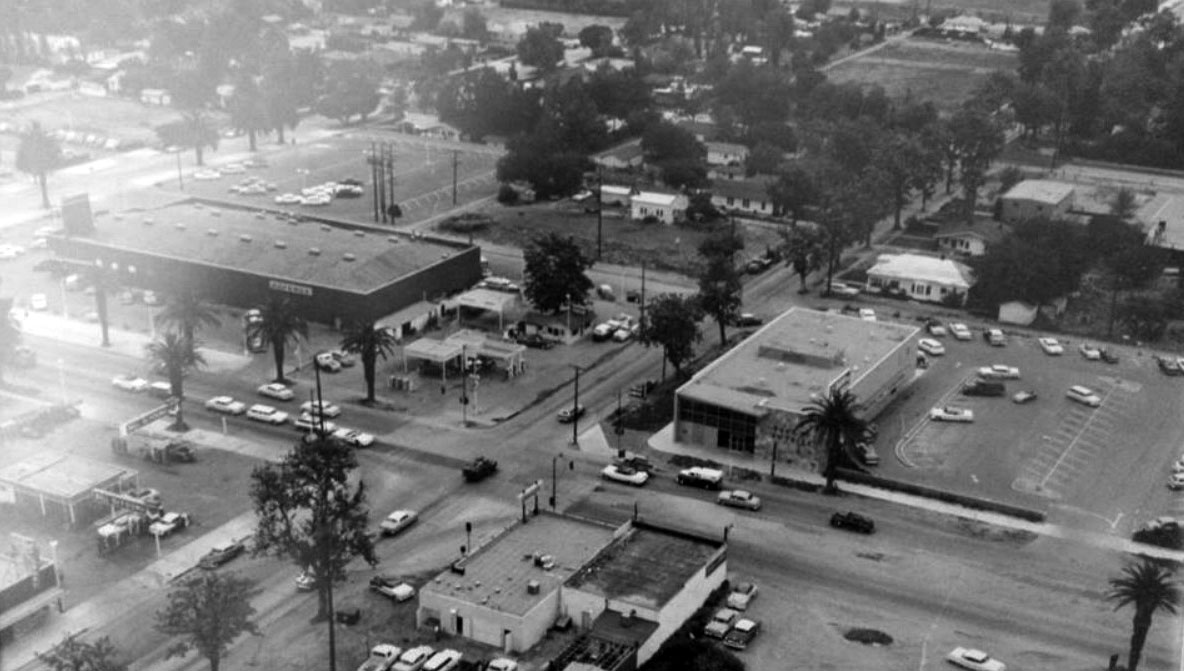 |
|
| (1960s)#^*^ – Panoramic aerial view of the intersection of Sherman Way and Topanga Boulevard, looking southeast. De Young Service Station can be seen at lower left (N/E corner). This is before Our Lady of the Valley Church was built (1968) on the corner of Gault Street and Topanga Blvd (upper-right). |
Shadow Ranch
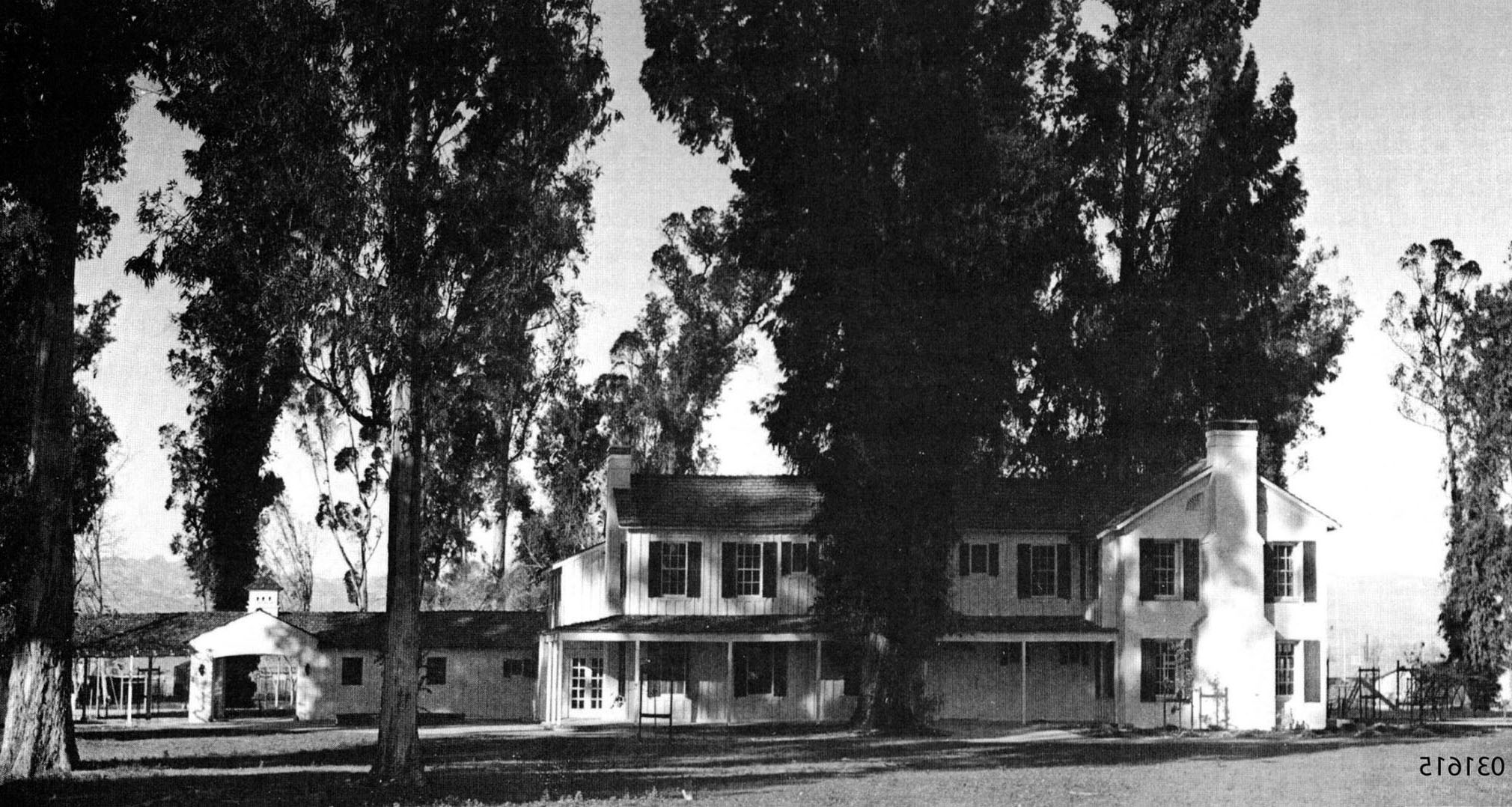 |
|
| (n.d.)#^*^ – View showing Shadow Ranch located at located at 22633 Vanowen Street in Canoga Park. (Note: Original image was inadvertantly flipped.) |
Historical Notes The ranch began as a dry-land wheat farm owned by the San Fernando Homestead Association led by Isaac Lankershim and Isaac Van Nuys. Albert Workman, an Australian immigrant, began as the superintendent of Van Nuys' Los Angeles Farm and Milling Company. After 1869 Workman purchased the 9,000-acre ranch, and cultivated it with another 4,000 acres nearby. The ranch also had a thousand head of cattle at one time. Workman imported Australian Blue Gum eucalyptus tree seeds from his homeland and planted them on the ranch. Some claim the numerous eucalyptus trees in California of that species, Eucalyptus globulus, originate from the Workman Ranch groves.*^ |
 |
|
| (1958)#^ - Close-up side view of Shadow Ranch showing large eucalyptus trees surrounding the main house. |
Historical Notes The site has multiple Hollywood connections. In the 1930s the Workman Ranch was acquired by Colin Clements and Florence Ryerson, a couple who were screenwriters for the film studio. Ryerson co-wrote the screenplay for the 1939 film 'The Wizard of Oz' while living there. She renamed the estate Shadow Ranch for the amount of shade provided by the numerous large eucalyptus trees, originally planted during the Workman era. It was acquired in 1948 by another screenwriter, Ranald MacDougall, whose credits include "Mildred Pierce" and "Cleopatra." In 1961 movie director William Wyler used the ranch house as a filming location for 'The Children’s Hour', based on the play by Lillian Hellman.*^ |
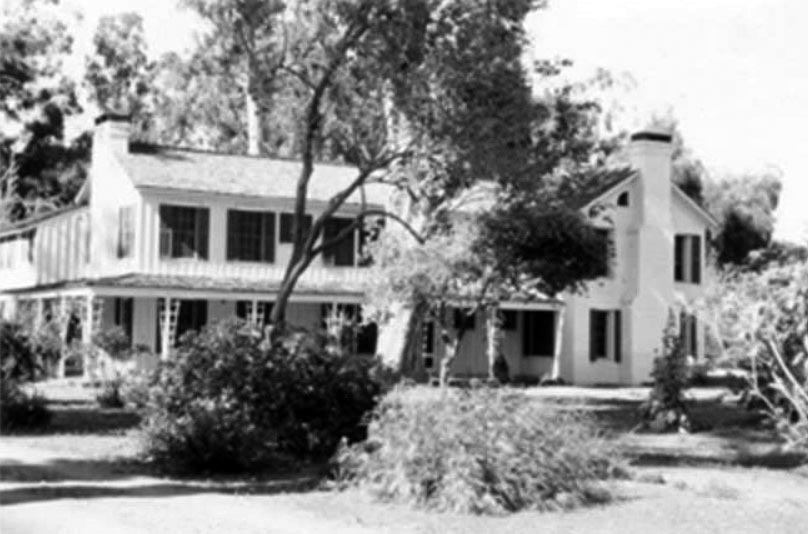 |
|
| (1958)#^ - Another view of the Shadow Ranch House on Vanowen Street in Canoga Park. |
Historical Notes In the 1950's, Shadow Ranch served as a private girls school called Robinnaire. Today, it is part of the Los Angeles City Recreation and Parks Department. #^ |
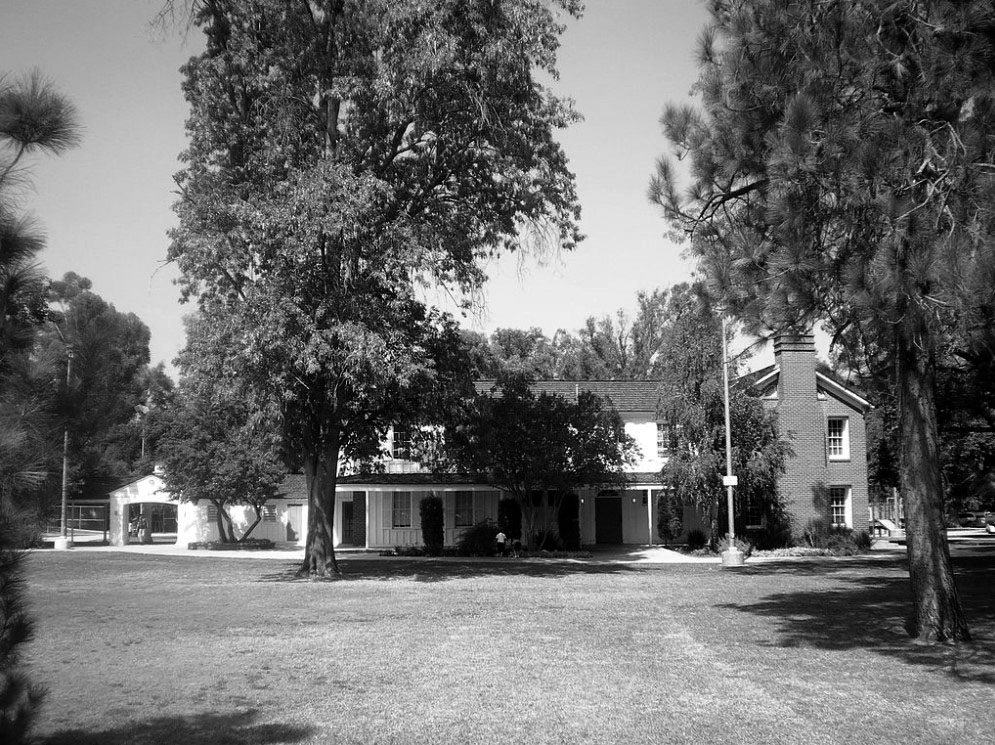 |
|
| (2008)*^ - View of Shadow Ranch House as it appears today. Location 22633 Vanowen Street |
Historical Notes Today, the historic Shadow Ranch residence stands on a 13 acres parcel, the remaining undeveloped land of the original ranch that is an L.A. city park. The structure is used as a recreational facility and events venue. When the Los Angeles Cultural Heritage Commission was formed in 1962, Shadow Ranch was one of the first ten properties to be designated as a city Historic-Cultural Monument No. 9 (Click HERE to see complete listing).*^ |
Chatsworth Reservoir
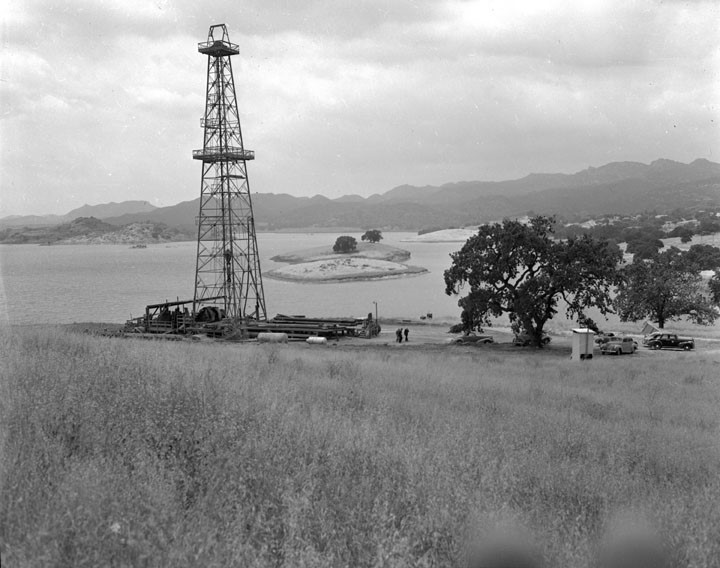 |
|
| (1943)** - View showing an oil derrick at the edge of the Chatsworth Reservoir. Photo title reads: Well #1 on Chatsworth Reservoir. Source - DWP Photo Collection |
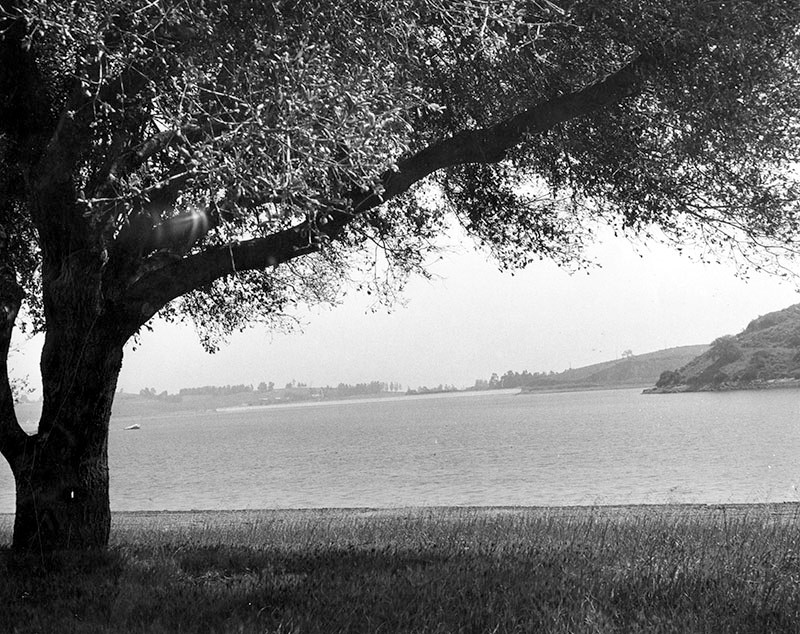 |
|
| (1956)* - Photograph caption dated May 25, 1956 reads, "Southwest of Chatsworth, quiet, silver waters of Chatsworth Lake dissect green hills and reflect centuries-old Oak trees dotting beautiful countryside. Site once had adobe settlement of early Spaniards but years have gradually crumbled it out of existence. Old sulphur springs still flow in area. Chamber of Commerce, women's club, American Legion and school buildings are now located near hub of present-day community at intersection of Devonshire Boulevard and Topanga Canyon." |
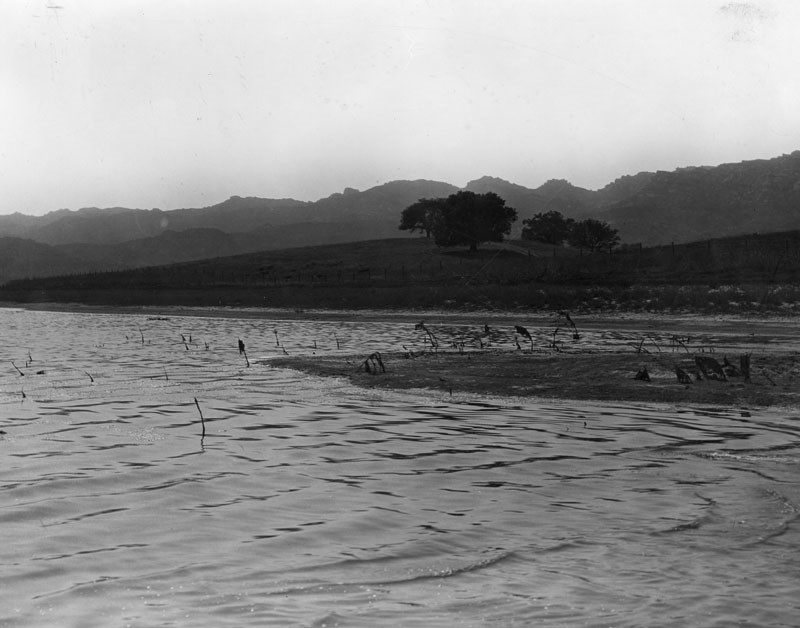 |
|
| (n.d.)*– Close-up view of the Chatsworth Reservoir looking northwest. |
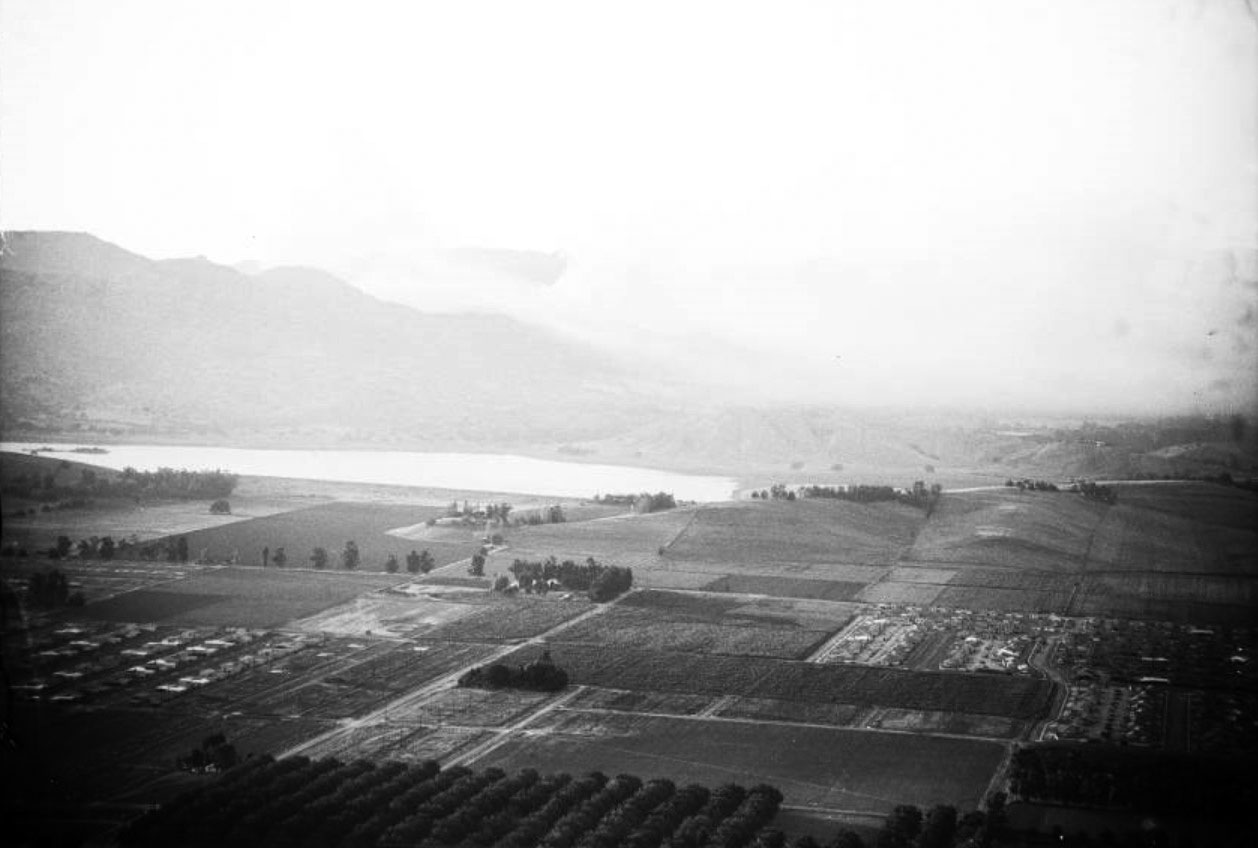 |
|
| (1957)^^ – Aerial view looking northwest over Canoga Park with the Chatsworth Reservoir at center-left. At center of photo is the T-intersection of Roscoe Boulevard and Shoup Avenue. A brush fire can be seen in Chatsworth (upper-right). Photo date July 3, 1957. |
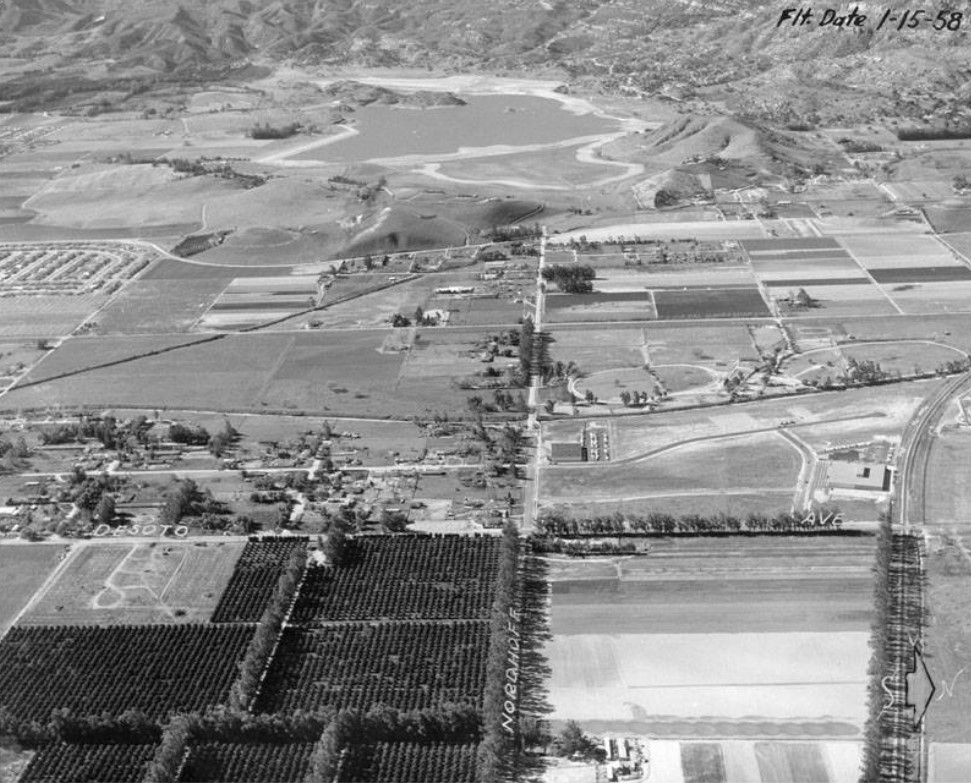 |
|
| (1958)* - Aerial view looking west on Nordhoff Street toward its intersection with Topanga Canyon Boulevard. The Southern Pacific tracks are on the right. The Chatsworth Reservoir, filled with water, is seen in the background. |
Historical Notes The Chatsworth Reservoir was completed in 1919 and used to store water for the West San Fernando Valley for over 52 years. After the 1971 Sylmar Earthquake it was placed out-of-service and pemanently retired.* Click HERE to see more in Early Los Angeles Water Reservoirs. |
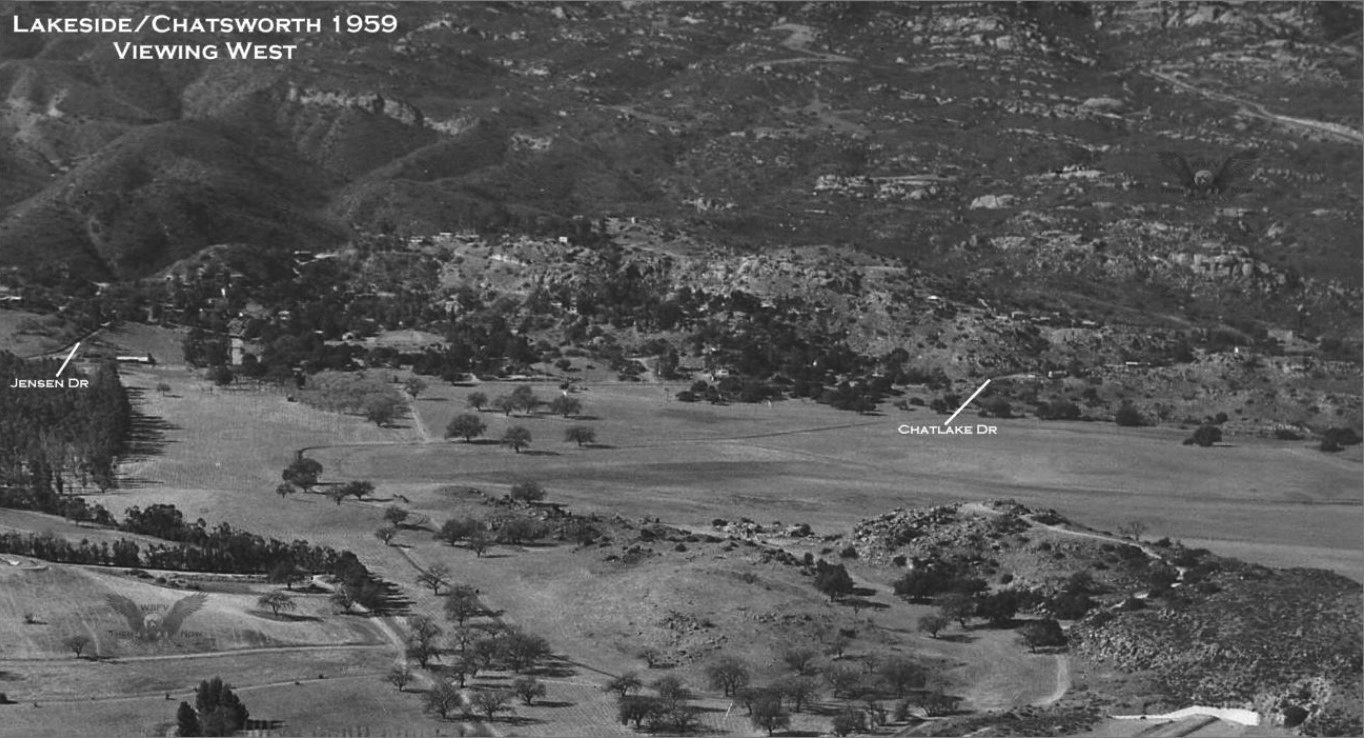 |
|
| (1959)#^*^ - View looking west across the southwestern portion of Chatsworth Reservoir showing the Lakeside Community, now a part of West Hills. No water appears in this section of the reservoir at the time. |
Historical Notes Lakeside came into existence in 1928/1929 and was comprised of 2 major subdivisions ~ Tract #'s 9889 & 9683. At its eastern base, along Valley Circle was a Park, seen in the center of the image. #^*^ |
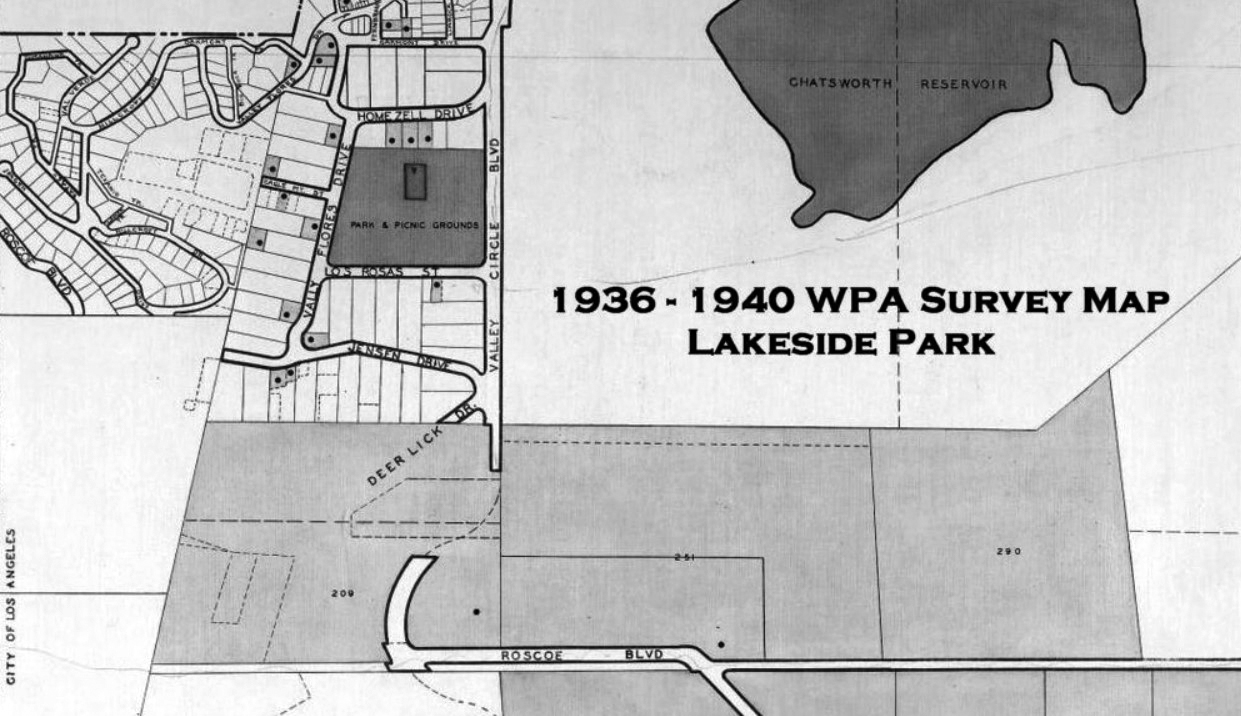 |
|
| (1930s)#^*^ – WPA Cultural Survey Map showing the community of Lakeside Park. Note the Park & Picnic Grounds in upper center-left. |
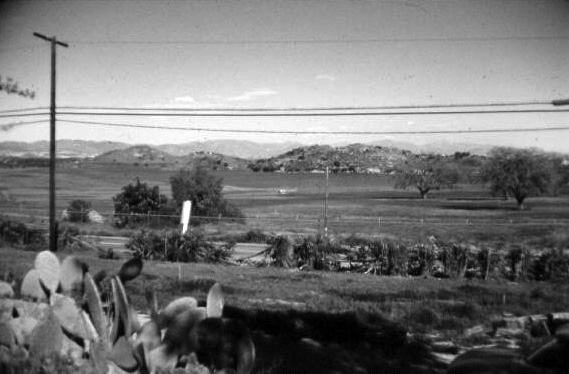 |
|
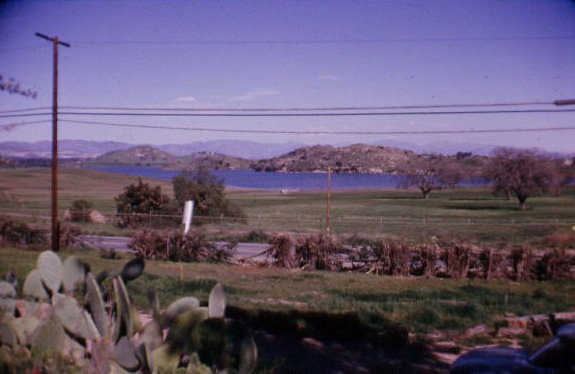 |
|
| (1960s)*^^^# - View looking northeast from near the intersection of Homezell Drive and Valley Circle Boulevard showing the Chatsworth Reservoir filled with water. Photo courtesy of Bert Emert |
Notes Color photos were included for better contrast. |
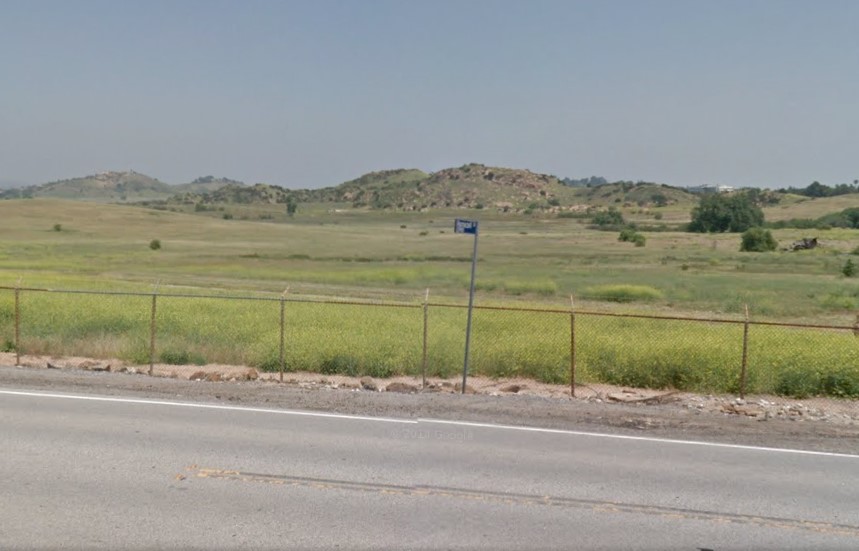 |
|
| (2012)#*^# - Google Street View showing an empty Chatsworth Reservoir from about the same location as previous photo, intersection of Homezell Drive and Valley Circle Boulevard. |
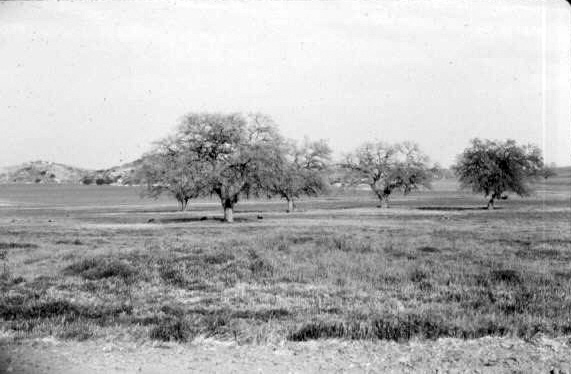 |
|
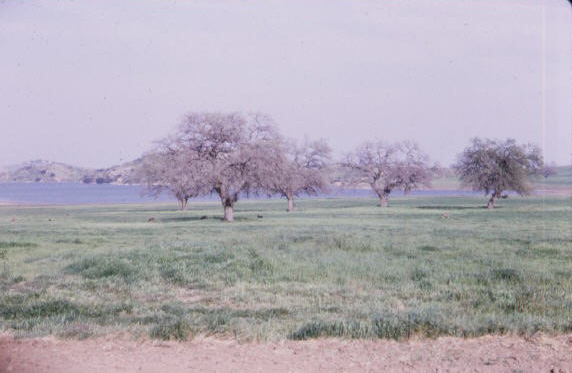 |
|
| (1960s)*^^^# – Closer view of the Chatsworth Reservoir from near Homezell Drive and Valley Circle Boulevard. If you look closely you can see several deer under the large oak tree at center-left. Photo courtesy of Bert Emert |
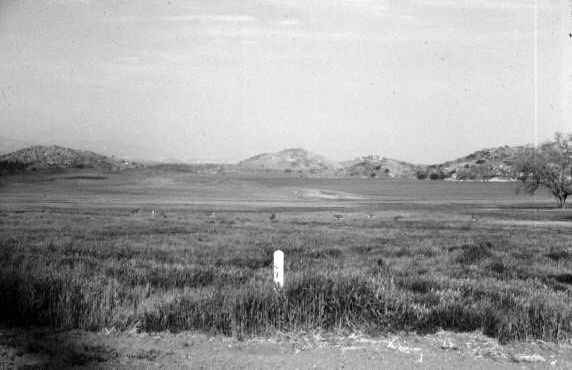 |
|
.jpg) |
|
| (1960s)*^^^# – View showing deer making their way to open space with the Chatsworth Reservoir in the background. Photo courtesy of Bert Emert |
Notes Click HERE to see more Early Views of the Chatsworth Reservoir. |
* * * * * |
Chatsworth Aerial Views (1950s)
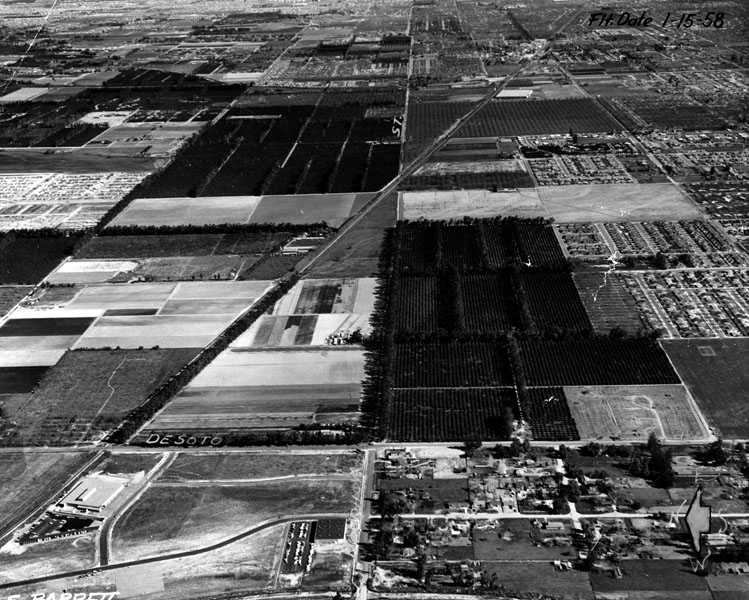 |
|
| (1958)* - Aerial view of Chatsworth looking east down Nordhoff Street. DeSoto Avenue is seen at the bottom running from north to south (left to right). The Southern Pacific tracks run diagonally across the photo (lower-left to upper-right). |
Historical Notes Nordhoff Street was named for famed 19th-century health seeker and writer Charles Nordhoff. Hired by Southern Pacific rail baron Henry Huntington in 1873, journalist Charles Nordhoff wrote the book California for Health, Pleasure and Residence. Click HERE to see more SFV Street Name Origins. |
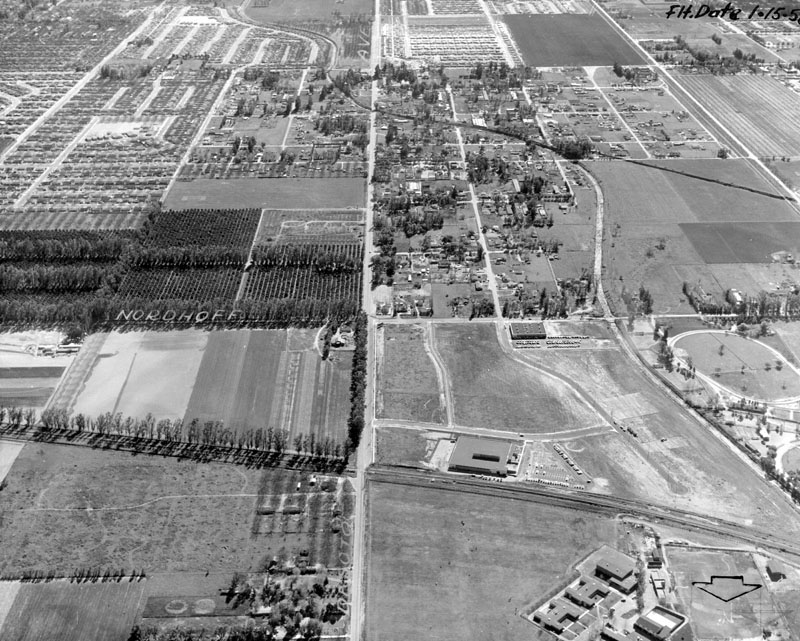 |
|
| (1958)* - Aerial view of DeSoto Avenue looking south. Nordhoff Street runs east-west at the center of the photo. The open area with a few buildings on it in the upper left area is Limerick Elementary. Aerojet Rocketdyne is currently where the walnut groves are in the center. |
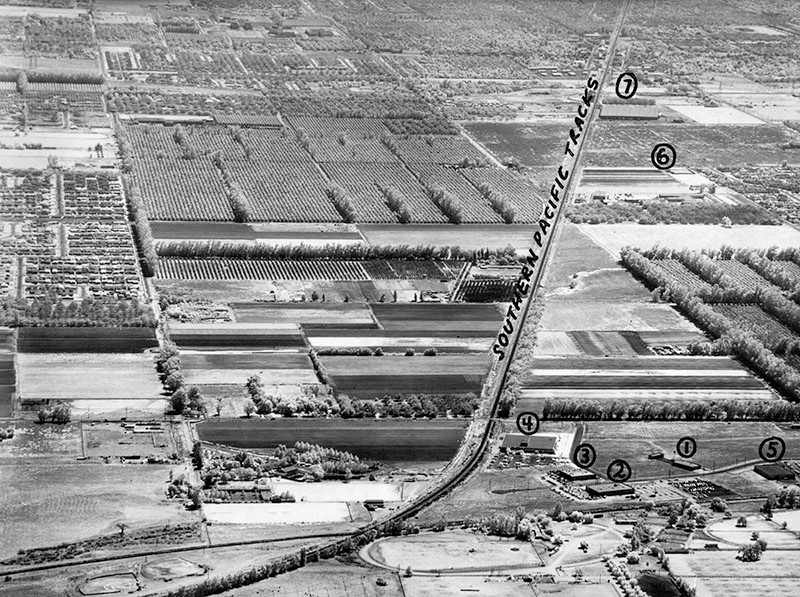 |
|
| (1960)* - Photograph caption dated September 27, 1960 reads, "Pilot's view of Chatsworth, looking east from Canoga Avenue, shows area which is expected to one day be a major Valley industrial section. Artist's keyed locations are: (1) Canoga Park Processing, Inc., (2) Amphenol-Western Division, (3) Metal Bellows Corp., (4) Deluxe Check Printers, Inc. (5) Azar Manufacturing Co., Inc., Chatsworth, and (6) Riker Laboratories, Inc., and (7) Orange Empire Co-Op, both in Northridge. Take a good look at the spacious fields--they won't be there long." |
Nike Missile Site (Oat Mountain, Chatsworth)
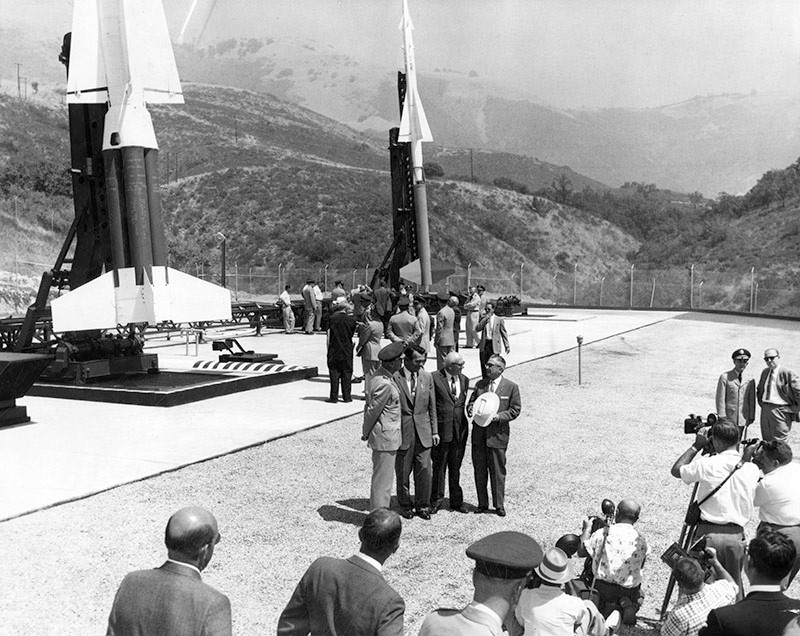 |
|
| (1958)* - Valley Times photograph caption dated August 30, 1958 reads, "Dignitaries attending ceremony which marked first Nike-Hercules base to go operational in nation are dwarfed by huge weapon which can destroy entire enemy squadron of bombers with atomic warhead. In foreground at Oat Mountain Base in Chatsworth are, left to right, Maj. Gen W. A. Perry, Donald Douglas Jr., Don Belding and Sheriff Eugene Biscailuz." |
Historical Notes In 1958, at top of Browns Canyon at the end of De Soto Avenue there existed an Army base with Nike Hercules missiles armed with nuclear warheads. The Nike Missile Base LA-88 located in Chatsworth on Oat Mountain was part of the “Ring of Steel” that protected Los Angeles from 1958 to 1974. The Cold War, between the Communist World (the Soviet Union and its allies) and the Western World (the United States and its allies), lasted from 1946 to 1991. During this time of political, military and economic conflict, various strategies were undertaken by the United States to defend against a nuclear attack. Nike Missile bases provided that defense. They were initially equipped with anti-aircraft missiles (Nike-Ajax in 1953), followed by the Nike-Hercules in 1958, which was armed with nuclear warheads and could intercept ballistic missiles.^# |
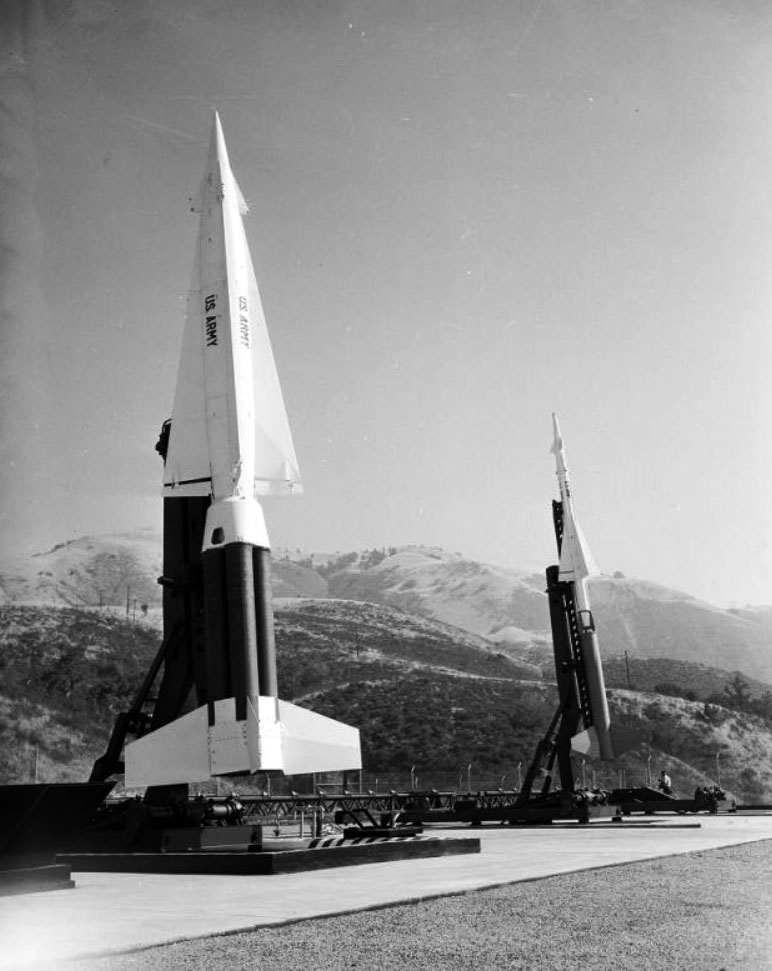 |
|
| (1958)^^ – Close-up view at the Oat Mountain Base in Chatsworth showing a launch pad with two missiles on it (a Nike-Hercules and a Nike-Ajax). |
Historical Notes By 1958, the Army had established over 200 Nike missile bases within the United States (including Alaska and Hawaii). Los Angeles was defended by a ring of 16 Nike sites, referred to as a “Ring of Steel”. To protect its aerospace industries, Los Angeles received extensive air defenses. Oat Mountain towers over the San Fernando Valley and provides visibility in all four directions and far out into the Pacific Ocean. LA-88 was the last of the scheduled 16 Los Angeles Nike sites to be completed due to the rugged terrain and only one usable road through Browns Canyon. Construction difficulties leveling a mountain peak and also digging deep into the ground for the three underground launchers caused delays. The site was completed and operational as of August 26, 1956.^# |
Chatsworth Park (renamed Chatsworth Park North in 1978)
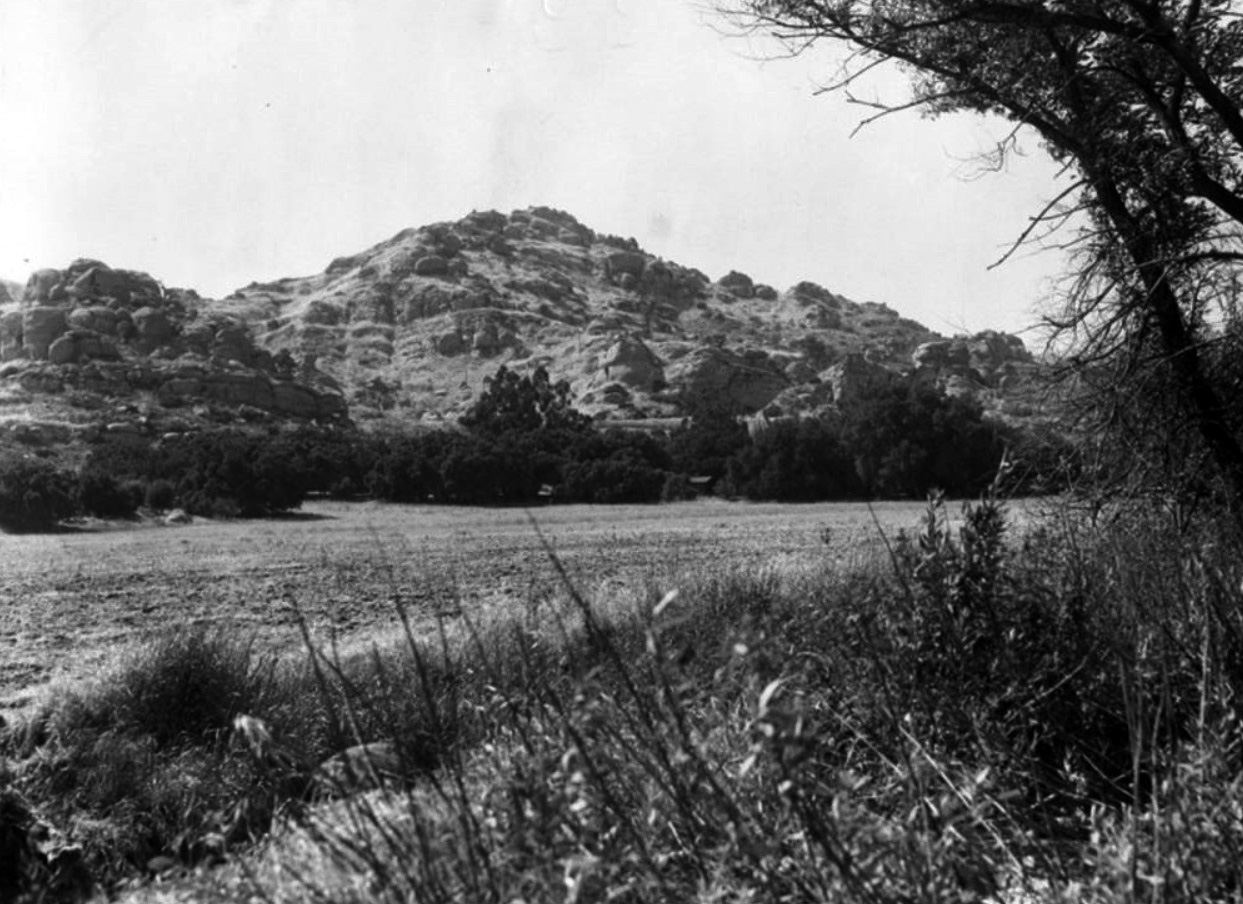 |
|
| (1960)* - Photograph caption dated January 21, 1960 reads, "Park site shown - This recently acquired 24.4-acre site in Chatsworth is to be developed as park under provisions of 1957 park and recreation bond fund." Valley Times Collection |
Historical Notes Originally called Chatsworth Park, the facility was one of several parks and recreation centers that were financed under a bond measure approved by Los Angeles voters in 1957. Plans to develop a new park in Chatsworth, which was experiencing rapid residential growth at the time and was poorly served by park facilities, were approved by the Recreation and Parks Commission in 1960. The Commission also approved the annexation of 7.4 acres of county-owned land located adjacent to the proposed park, which were subsequently acquired and incorporated into the facility.^ |
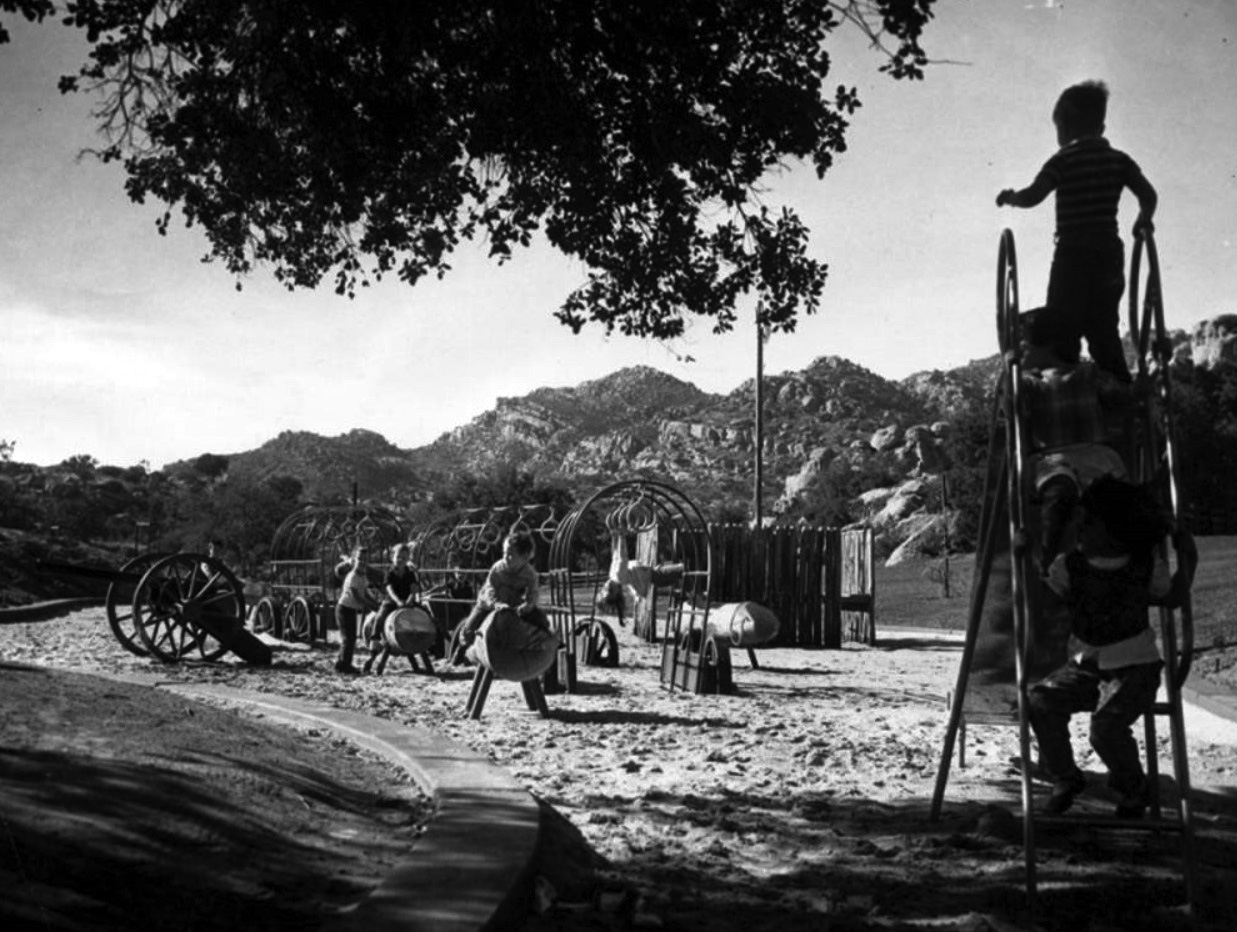 |
|
| (1963)* - Photo of Chatsworth Park playground, taken June 30, 1963, shortly after it opened. |
Historical Notes Conceptual plans for the park were developed by the Los Angeles-based landscape architectural firm of Cornell, Bridgers and Troller. Partner Ralph Cornell had a well-established reputation and was known for designing landscapes that thoughtfully incorporated indigenous plantings. Accordingly, the area’s abundant sandstone outcroppings and existing oak trees were integrated into the park’s design, which was approved by the city in 1961. Contractor P.J. Robert and Co. was retained to develop the park in 1962, and the site was formally dedicated and incorporated into the city’s park system in 1963.^ |
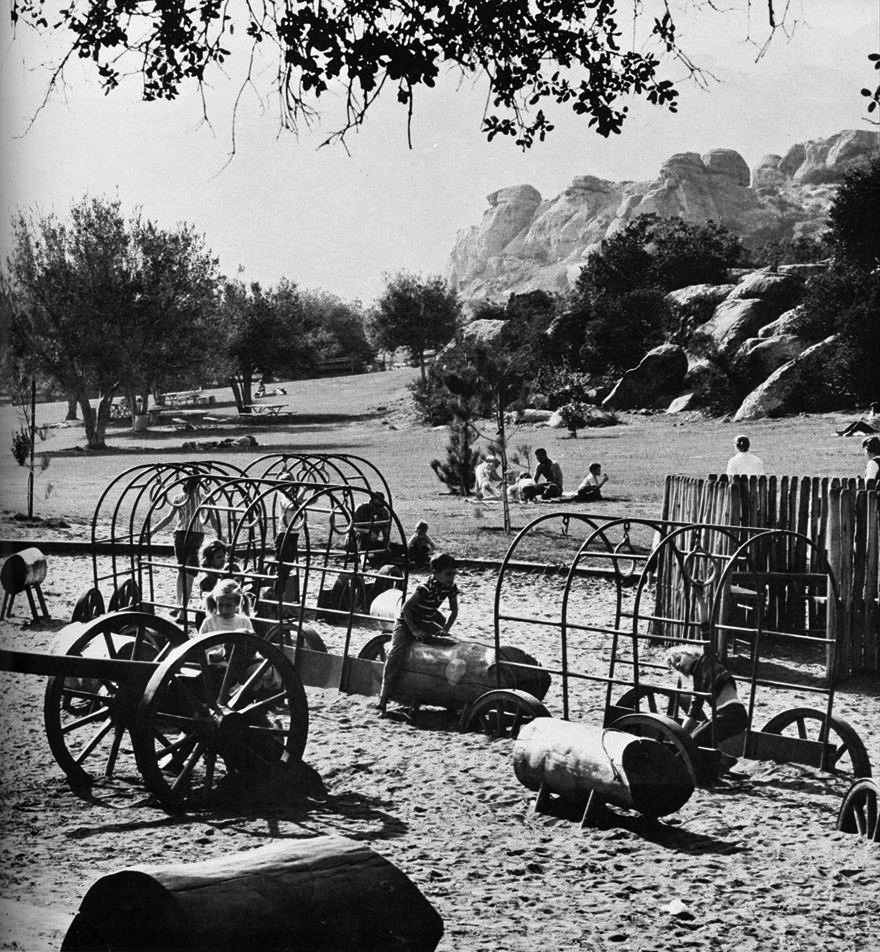 |
|
| (1960s)^.^ – View showing Chatsworth Park (North), with playground and picnic area. |
Historical Notes Chatsworth Park was expanded in 1978, when an additional 72 acres to the south of the original site were acquired by the city and subsequently developed as parkland. The expansion, which had been used as a skeet shooting range prior to its development, is the site of Homestead Acre (HCM #92) and the Old Stagecoach Trail (HCM #133). However, since the two sections of the park were separated by private property that was never successfully acquired, they remained noncontiguous and were treated as two separate entities: Chatsworth Park North and Chatsworth Park South.^ |
* * * * * |
Sun Valley
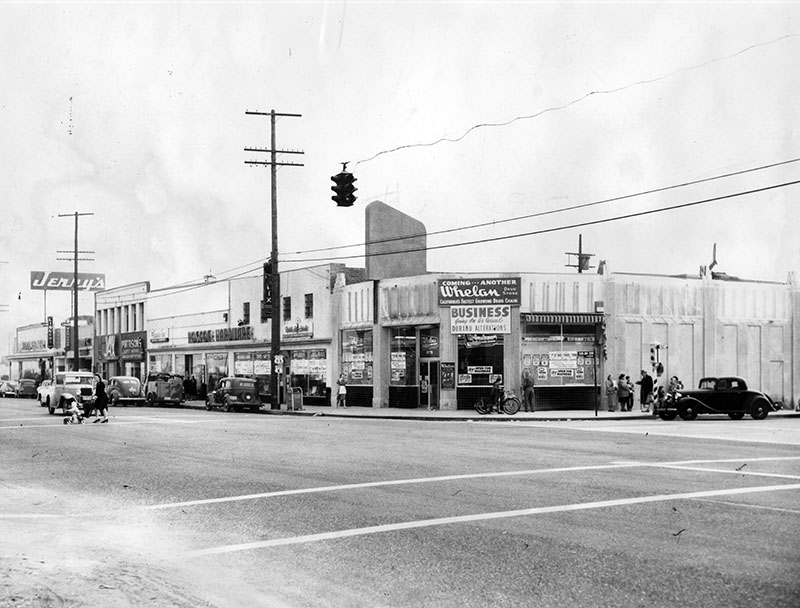 |
|
| (1948)* - View showing the intersection of Sunland Blvd. and San Fernando Rd. on eve of change in name of the community from Roscoe to Sun Valley. A modern drug store has replaced gas station, another story has been added to building that housed Roscoe Public Market. Roscoe Hardware, which will retain name, is in same location as 31 years ago. Source: Valley Times - December 31, 1948 |
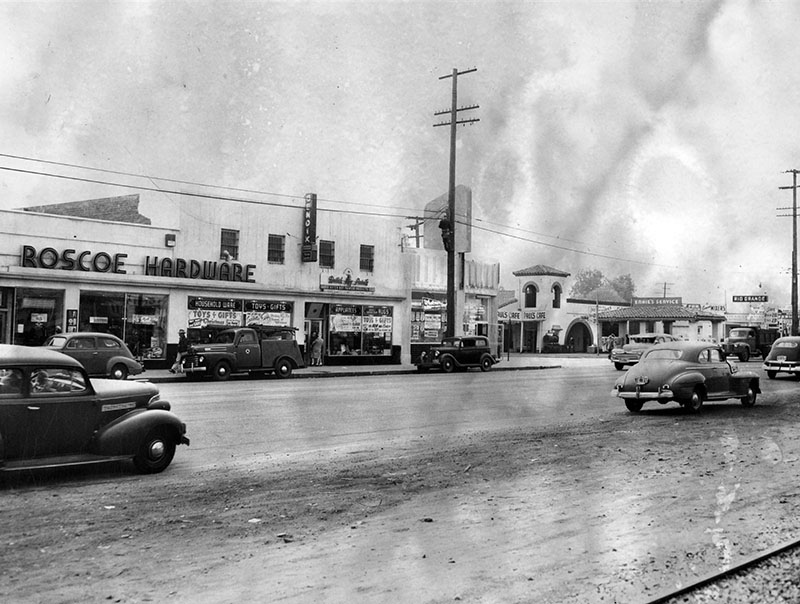 |
|
| (1949)* - Pictured is a view of Roscoe Hardware and other shops on San Fernando Road near Sunland Boulevard in Sun Valley. Picture was taken on eve of change in name of community from Roscoe to Sun Valley. Valley Times: Photograph dated January 22, 1949. |
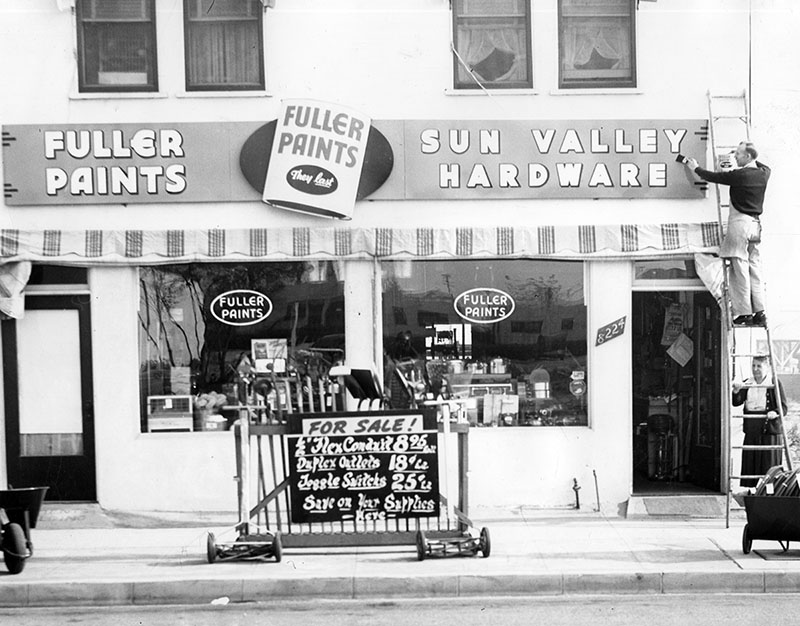 |
|
| (1949)* - Pictured on ladder, painting sign, is William Willmott, of Sun Valley Hardware, 8224 Sunland Boulevard. Photograph dated January 22, 1949. |
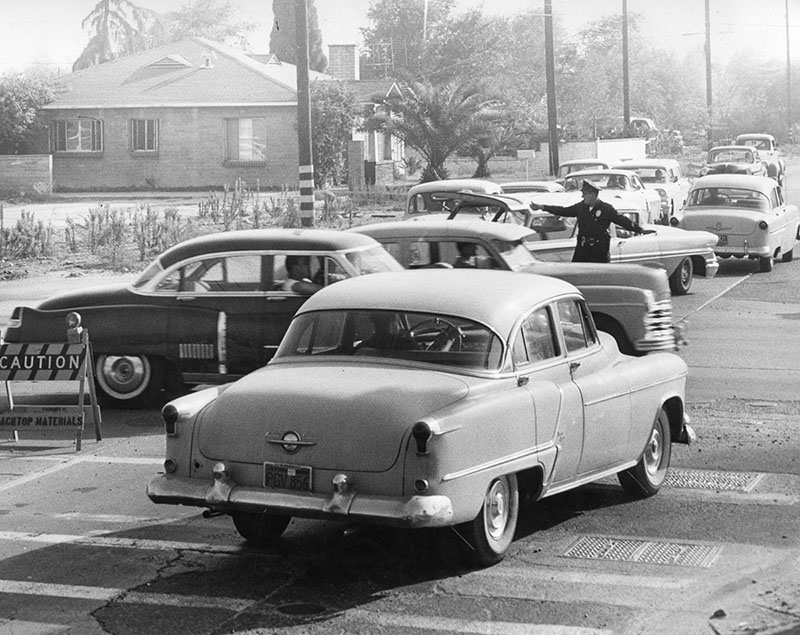 |
|
| (1959)* - Photograph caption dated September 2, 1959 reads, "Policeman diverts cars from Tuxford street entrance to Sunland boulevard at Glenoaks boulevard as second traffic jam in two days snarls traffic with closing of Sunland boulevard route from Sun Valley to Sunland to permit widening of thoroughfare. Cars are being rerouted over Sheldon-Wentworth street route just opened last Friday. Sunland boulevard will be closed for next nine months." |
Valley Steam Plant
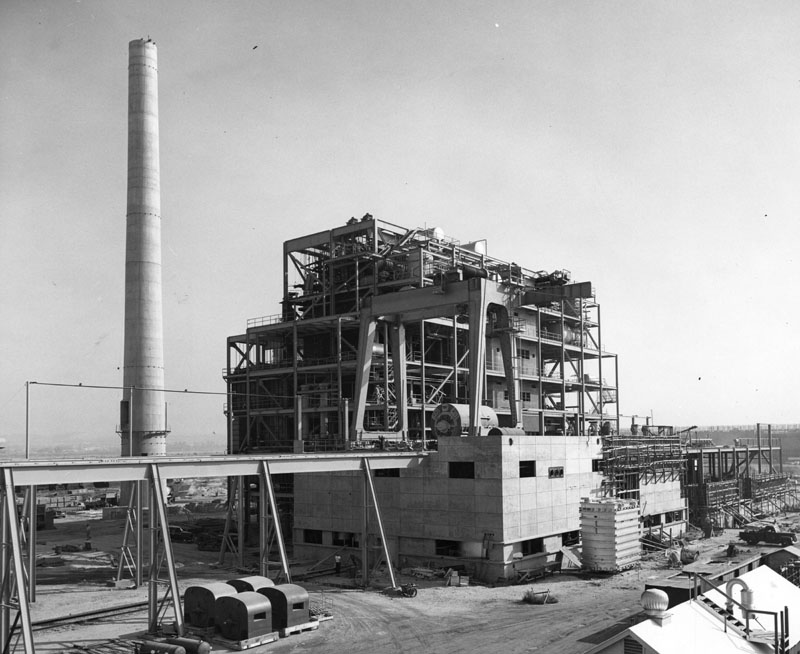 |
|
| (1953)** - View showing the Valley Steam Electric Generating Plant under construction in Sun Valley. |
Historical Notes The 1950s saw such a rapid growth in the San Fernando Valley that it forced the Department of Water and Power to construct one of the largest steam plants in the country in Sun Valley. |
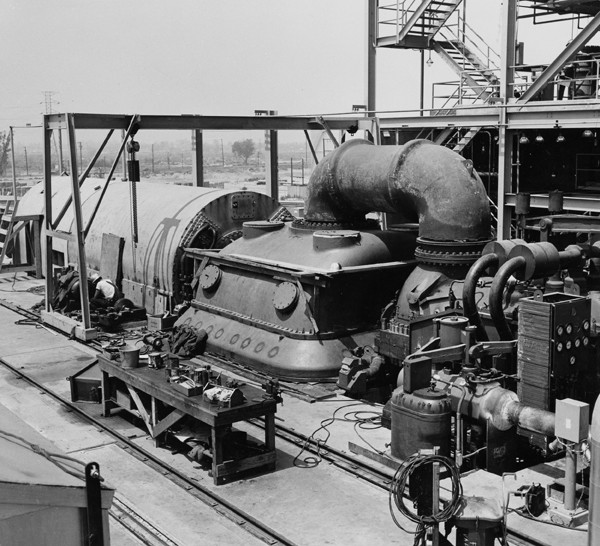 |
|
| (1954)^ - View showing a General Electric F2 type turbine with a hydrogen cooled generator (Unit No. 1) at Valley Steam Plant. |
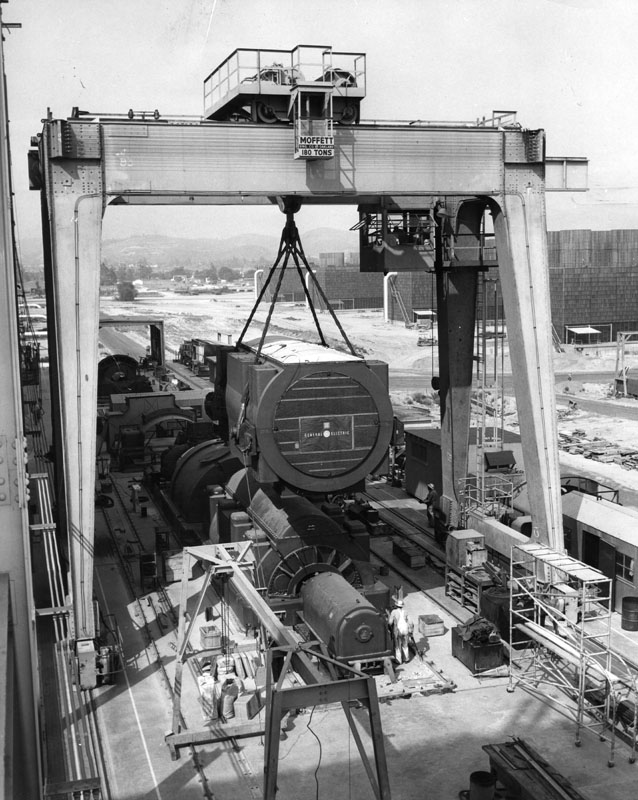 |
|
| (1955)** - Workmen haul the last of four electric generators into position at the $80,000,000 Valley Steam Plant. |
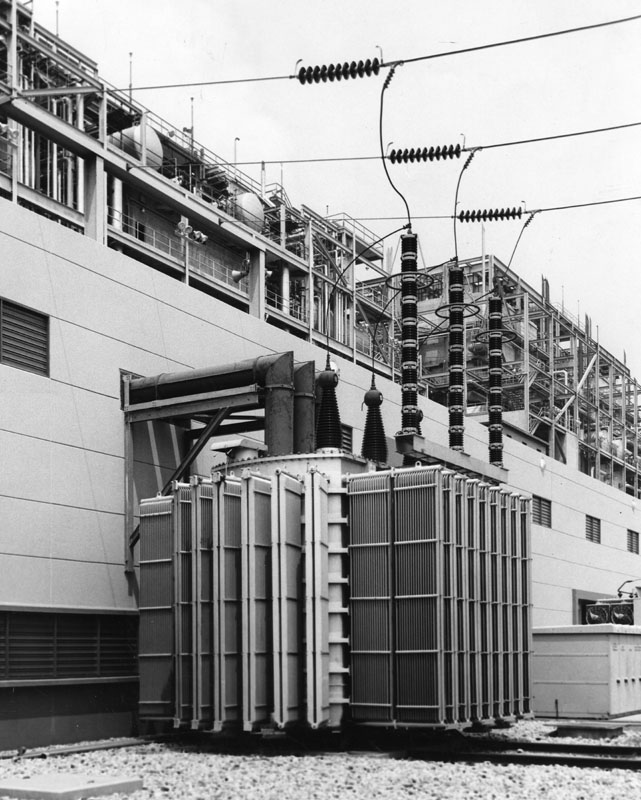 |
|
| (1957)** - This huge 25-foot three-phase transformer at the Valley Steam Plant steps up voltage from 18,000 to 138,000 volts for transmission to the distribution system. The plant has about 1700 control switches, instruments and relays. |
 |
|
| (1956)** - View showing the newly completed Department of Water and Power's Valley Steam Plant located in Sun Valley (N/E San Fernando Valley). |
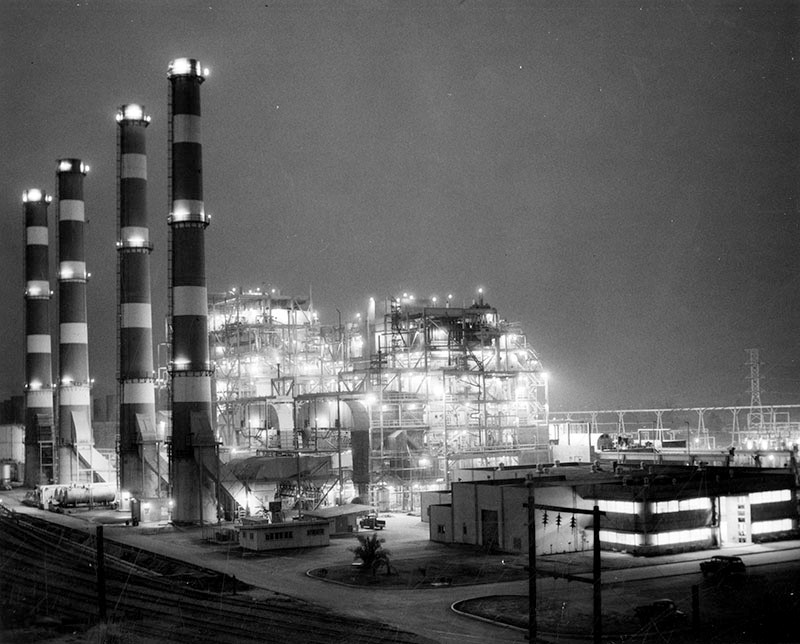 |
|
| (1956)* - Photograph caption dated July 13, 1956 reads "Power for million lights up sky. Fabulous growth of the San Fernando Valley forced the Department of Water and Power to construct one of the largest steam plants in the country in Sun Valley. The four unit project costing $89,000,000 is virtually completed and will provide power for million Valley residents." - Valley Times |
 |
|
| (1956)* - Close-up nighttime view showing a well lit Valley Steam Plant. |
Historical Notes Photo caption reads, "Valley Steam Plant glows with thousands of lights during nighttime operation. Pipes and valves in foreground are part of fuel lines leading to plant. Built on 150-acre site in Sun Valley at cost of $80,000,000, Valley Steam Plant has total generating capacity of 512,000 kilowatts of electricity. Because of mild climate, plant is virtually open to the air with complete housing only for operating personnel and most delicate equipment. Electricity is generated by means of turbines which are powered by super-heated steam, heated in boilers using either gas or oil as fuel." Valley Times - August 1, 1956* |
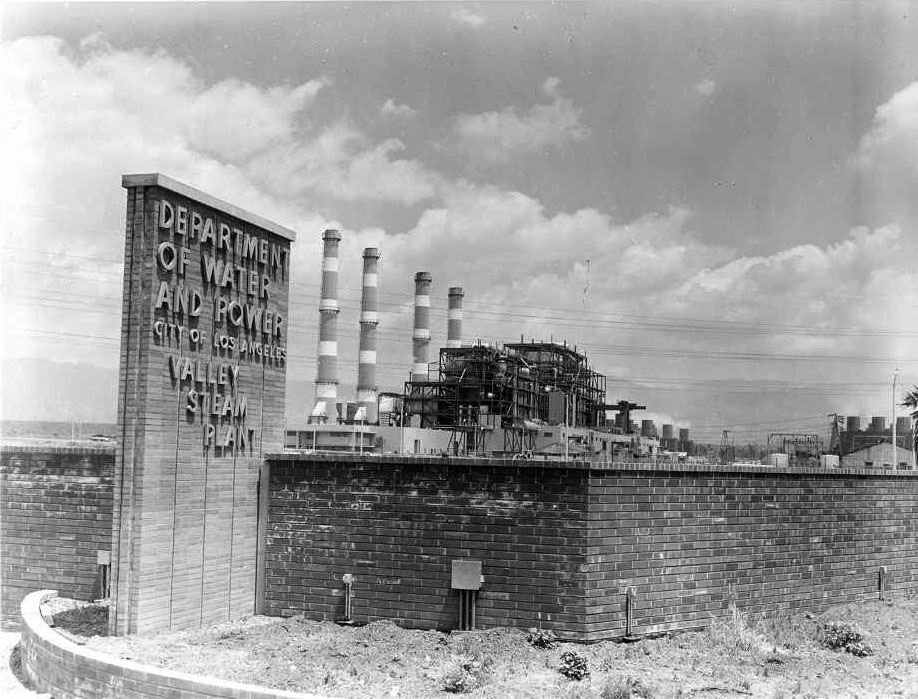 |
|
| (ca. 1957)*^^^# - View showing the front entrance to Valley Steam Plant located at 11805 Sheldon Street in Sun Valley. |
Historical Notes Click HERE to see more Early Power Generation. |
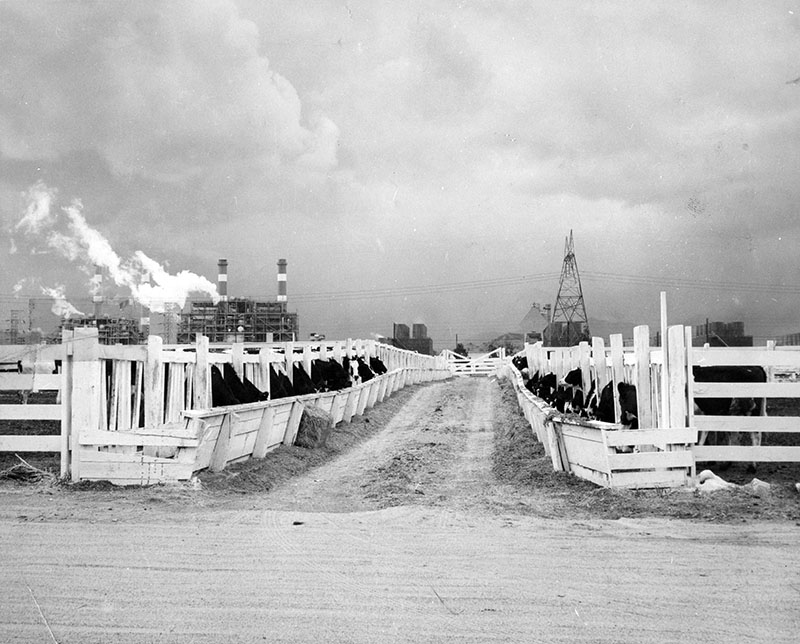 |
|
| (1956)* – View showing a herd of Holstein cattle feeding at Silver Shield Dairy on Wicks Street in Sun Valley. In the left background are the familiar towers of the Valley Steam Plant. |
Reseda Boulevard
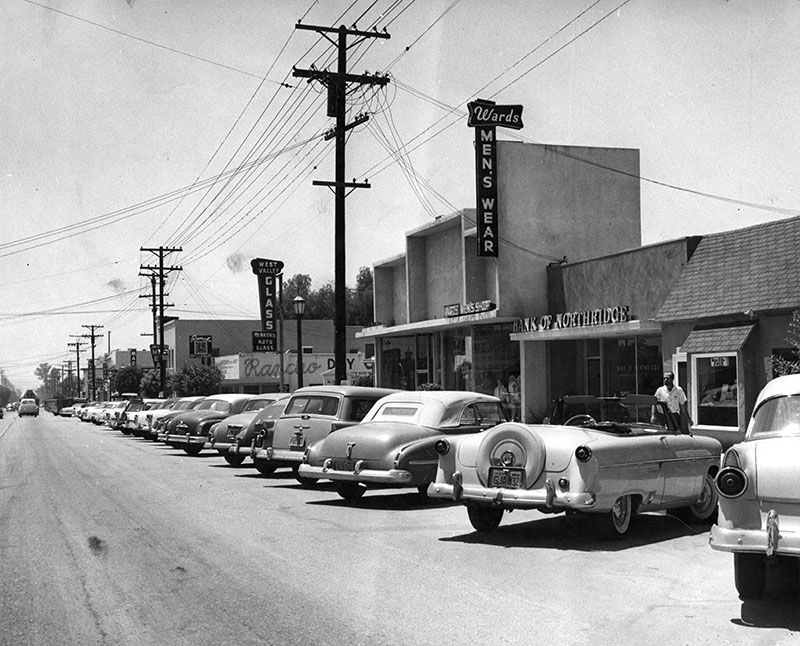 |
|
| (1956)* - Photo caption dated July 26, 1956 reads, "Thriving shopping center - Autos line busy Reseda Boulevard shopping center of Northridge. Despite motorized majority, some Northridgers still ride to town on horseback. Town expects to encounter parking problem when diagonal parking is prohibited this fall and parallel parking required by city. Business area still retains friendly, small town flavor." |
 |
|
| (ca. 1950)##^ – View looking south on Reseda Boulevard from Sherman Way showing commercial business on the west side of the street including: Reseda Bakery, Donut Hut, and a shoe repair shop. The large 2-story building in the background is the West Valley LAPD Headquarters. Note the stop sign at left (S/E corner). |
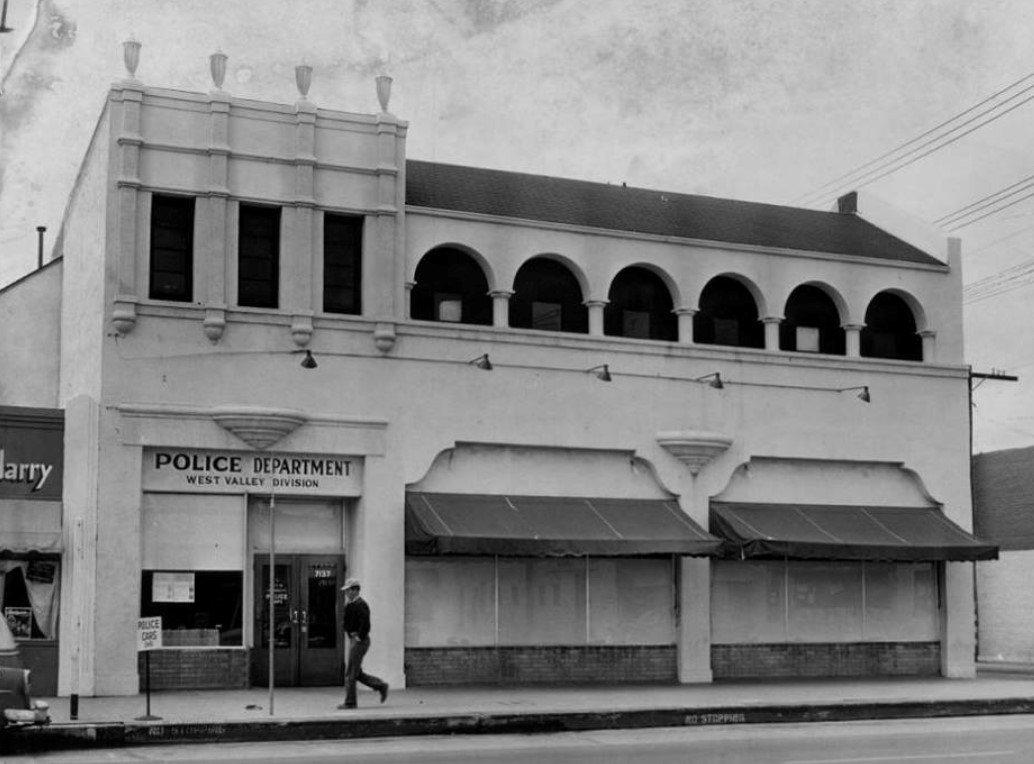 |
|
| (ca. 1958)^^ – View showing a man walking by the front entrance to the West Valley Division of the LAPD located at 7137 Reseda Boulevard (West side of Reseda just s/o Sherman Way). |
_ca1958.jpg) |
|
| (ca. 1958)#^*^ – Wider view of the West Valley Police Station showing a police car parked in the alley on the right. Reseda Drug Store is seen next door to the right across the alley. |
Historical Notes Today, BMW Clinic is at the LAPD site and the Reseda Drug Store has been replaced by Alan’s Flowers and a side parking lot. #^*^ |
* * * * * |
Please Support Our CauseWater and Power Associates, Inc. is a non-profit, public service organization dedicated to preserving historical records and photos. Your generosity allows us to continue to disseminate knowledge of the rich and diverse multicultural history of the greater Los Angeles area; to serve as a resource of historical information; and to assist in the preservation of the city's historic records.
|
More Historical Early Views
Newest Additions
Early LA Buildings and City Views
History of Water and Electricity in Los Angeles
* * * * * |
References and Credits
* LA Public Library Image Archive
^ CSUN Oviatt Library Digital Archives
#^San Fernando Valley History Digital Library - CSUN Oviatt
**DWP - LA Public Library Image Archive
^*The Valley Observied: Street Name Origins; Timeline of Valley History
^#Chatsworth Historical Society; Chatsworth Nike Site; Munch Box
*#Mojave Desert.net: Remi Nadeau
***Los Angeles Historic - Cultural Monuments Listing
*^*California Historical Landmarks Listing (Los Angeles)
*^^Nuestra Señora la Reina de los Ángeles - losangelespast.com
^^^LA Times: Adohr Spelled Succes for the Adamsons; Mulholland Bridge; Panorama City; Getting the Skinny on a Tall Valley Landmark; Valley Newspapers of the Past; Schlitz Closure
^^*LA Times: Stanley Norris Petit
*##LA Times: Dig Into History You'll Find Snake Oil..Victor Girard Kleinberger
+#^Facebook.com: Encino Velodrome; American Rails
+**Valley Presbyterian Hospital History and Milestones
+^^Panorama City - Commercial Area Concept Plan
++#Facebook.com: Photos of Los Angeles
##*Pinterest - California; Roscoe Sheep Crossing
#^#San Fernando Valley Blog: LA Federal Savings Building, North Hollywood; Van Nuys Blvd. Postcard, Valley Music Theatre
*#*Project Restore: Van Nuys City Hall
^*^Topanga Canyon History - LA Magazine
*#^LA World Airports - History of Van Nuys Airport
^^#The Museum of the San Fernando Valley
**#Tumblr.com: LA History - Leonis Adobe
^#*Photo of the Northeast San Fernando Valley ca.1950 - Laurie Burns
^*#North Hollywood-Toluca Lake Patch: History of the Laurel Canyon and Valley Plaza Mall; N. Hollywood Train Depot
*##*BellCanyon.com: Bell Canyon History
#^#^Granada Hills North Neighborhood Council: Granada Hills History
^*^*Metro.net: Mulholland Drive Bridge
*^*#Facebook.com: Classic Hollywood-Los Angeles-SFV
*^^^San Fernando Valley Historic Society/Facebook.com: JC Penney; California Bank; Devonshire Downs; Topanga Plaza Founain; Devonshire and Owensmouth; Sheep Crossing Roscoe; Log Ride / Busch Gardens
^**^Cinema Treasures: Rivoli-Capri Theatre; Reseda Drive-In Theatre; Van Nuys Driv-In Theater; Winnetka Drive-In; Topanga Theatre; Victory Drive-in; Holiday Theatre
***^Los Angeles Movie Palaces: Studio City Theater
**^^KCET: LA Flood of 1938: Cement the River's Future; Canoga Park at 100: A Brief History of the Birth of Owensmouth; When Cahuenga Pass Was Rustic; Before the 'Carmageddon': A Photographic Look at the Construction of 5 SoCal Freeways; Thematic Cartography and Mapping Los Angeles
**^#LA Times Framework: Busch Gardens Monorail; Woodland Hills Sheep
*^^#Flickr.com: Kaiser Panorama City
**#*EntertainmentDesigner.com: Busch Gardens
**#^San Fernando Valley Historical Society: Van Nuys Drive-in Theater
*^#^Northridge Fashion Mall Jobs
^^##Encino-Tarzana Patch: Valley Ice Skating Center
^##*Pinterest: Drive-in Speakers
^##^Pinterest: San Fernando Valley
*#^#Forum.skyscraperpage.com: Coffee Dan's
*##^City-Data.com: Ventura Boulevard
*#^*Los Angeles County Library: Agoura Hills
*#^^Big Orange Landmarks: Drive-ins Roared into LA Country
*#**Facebook.com: Museum of the San Fernando Valley; Busch Monorail
^***LosAngelesPast.com: Cahuenga Pass
^**#The Friends of Oakridge; theoakridgeestate.com
#**^Flickr.com: Bibiop – Northridge Fashion Center
#^*^Facebook.com: West San Fernando Valley Then And Now
#*^*The First 100 Years: umccp.org
#*^#Google Maps
#^*#Worldwide Drive-Ins: Winnetka 6
#*#^Pierce College - piercecollege.edu
#*##Daily News: Rocketdyne Canoga Park; Proposed $3B Project at Rocketdyne Site
##^^California State University Northridge History: csun.edu
^###Northridge Fashion Mall History
^^***Water and Power Associates
^^^^*Mbcinfo.com: Joseph Schlitz Brewing Company
**^^^LA Movie Palaces: San Fernando Valley
*^^^^Pinterest: San Fernando Valley - My Home Sweet Home
*^^^#DWP - Water and Power Associates Historical Archives - Courtesy of Rex Atwell
^***^Pacific Electric San Fernando Valley Line - ERHA.org
^^^*San Fernando Valley Relics: Facebook.com; Leonis Ranch; Ventura and Woodman; Busch Gardens; Reseda Blvd; Victory Blvd in Woodland Hills; Van De Kamp's; Valley Plaza; Nordhoff St. and Topanga Cyn; Ventura and Van Nuys Blvd; Van Nuys and Oxnard; Van Nuys Aerial; Van Nuys Blvd, ca. 1940; I-5 and I-14 Interchange; Van Nuys Drive-in; Mobil Gas Station; Canoga Drive-In; Victory and Whitsett; Van Nuys Aerial; Budweiser/Anheiseur-Busch Sign; Ventura Blvd 1950s
*^ Wikipedia: Sherman Oaks; Isaac Van Nuys; Encino; Tarzana; Campo_de_Cahuenga; Cahuenga Pass; Chatsworth; Panorama City; Santa Susana Field Laboratory; North Hollywood; Canoga Park; Woodland Hills; Reseda; Orcutt Ranch; Granada Hills; Andrés Pico; Moses Sherman; Van Nuys; Henry Kaiser; Charles Maclay; San Fernando Valley; Mission Point; Hughes Aircraft; Domonique Amestoy; Winnetka, Los Angeles; City of San Fernando; Canoga Park High School; Ventura Freeway; Hollywood Freeway; Los Angeles Valley College; Kaiser Permanente; Van Nuys Assembly; Rancho El Escorpión; Topanga Plaza; Simi Valley Freeway (118); Newhall Pass Interchange; Litton Industries; West HIls; Devonshire Downs; CSUN; Television Set History; Shadow Ranch; Atlas Missile; Thrifty Drugs; Coast Daylight; Longs Drugs; Du-Par's Restaurant; Joseph Schlitz Brewing Company; Annheiseur Busch; Fotomat; Baskin-Robbins; Valley Presbyterian Hospital; Warner Center; Gemco; Valley Music Theatre; Westfield Fashion Square; Paxton Park (Ritchie Valens Park); Big Donut Drive-in; Randy's Donuts; Builders Emporium; AlliedSignal; North Hills; Pacoima; 1960 Presidential Election
< Back
Menu
- Home
- Mission
- Museum
- Major Efforts
- Recent Newsletters
- Historical Op Ed Pieces
- Board Officers and Directors
- Mulholland/McCarthy Service Awards
- Positions on Owens Valley and the City of Los Angeles Issues
- Legislative Positions on
Water Issues
- Legislative Positions on
Energy Issues
- Membership
- Contact Us
- Search Index